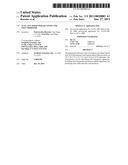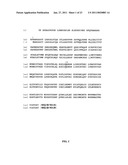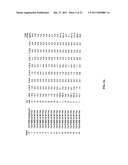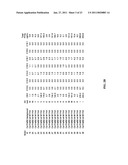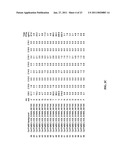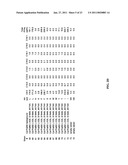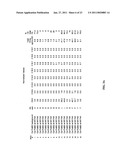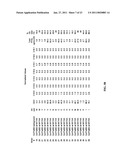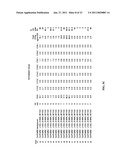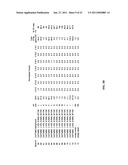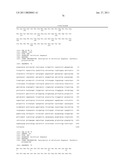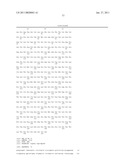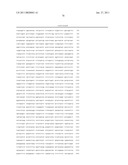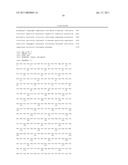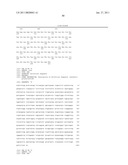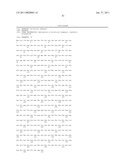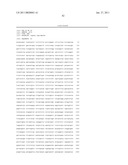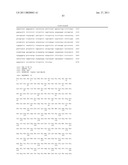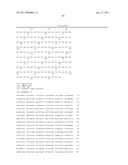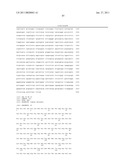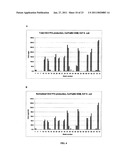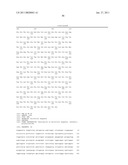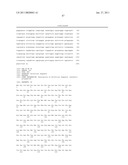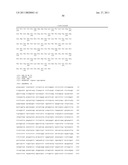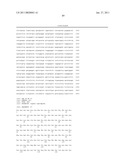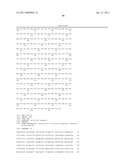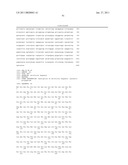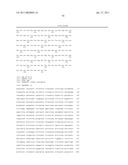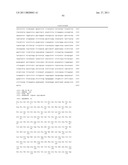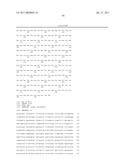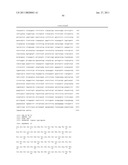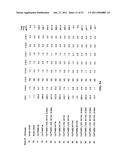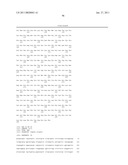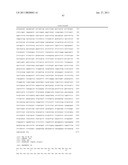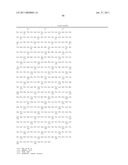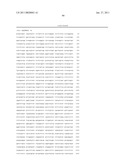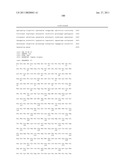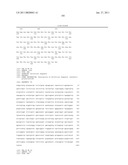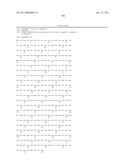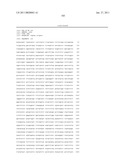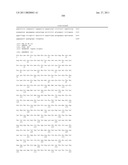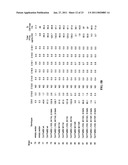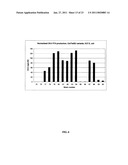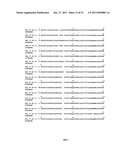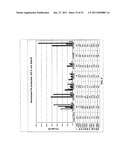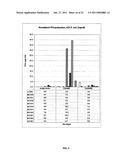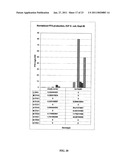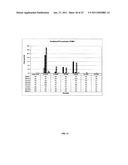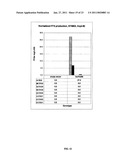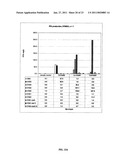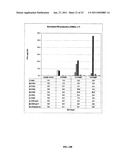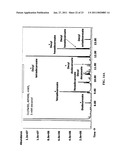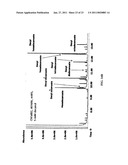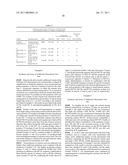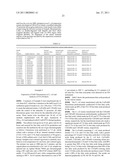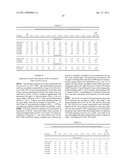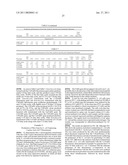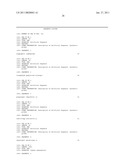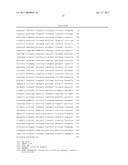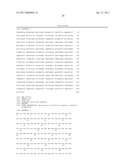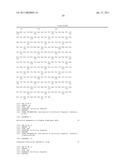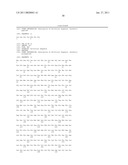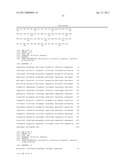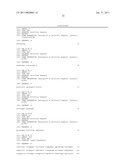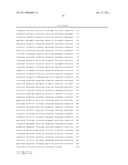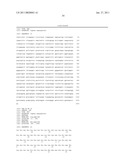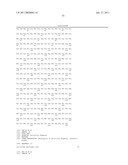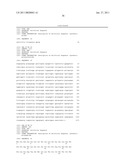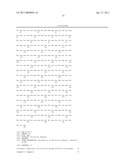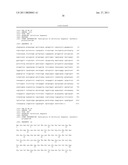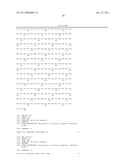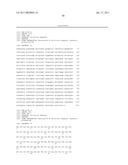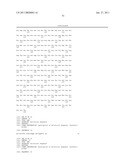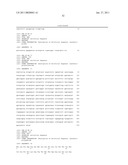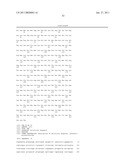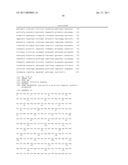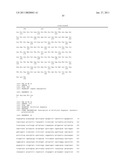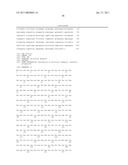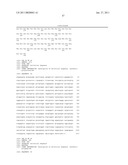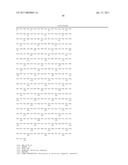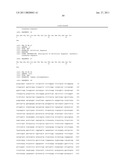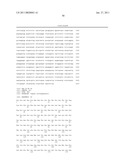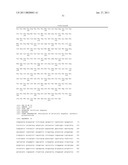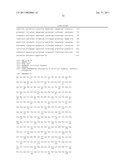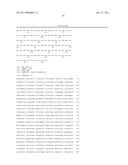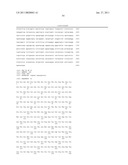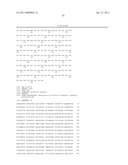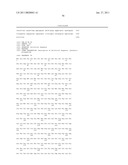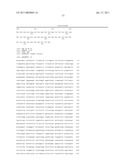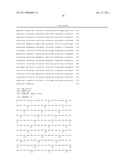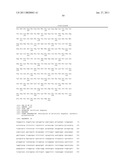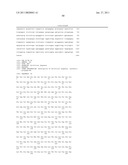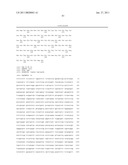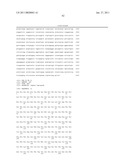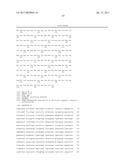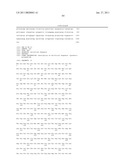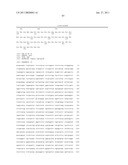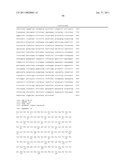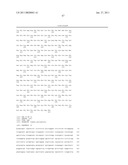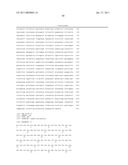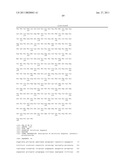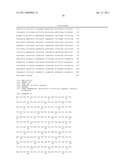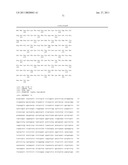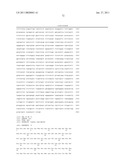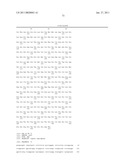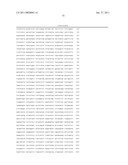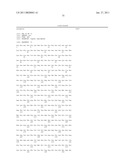Patent application title: ACYL-ACP THIOESTERASE GENES AND USES THEREFOR
Inventors:
Paul Gordon Roessler (San Diego, CA, US)
Gena Roy (San Diego, CA, US)
Assignees:
Synthetic Genomics, Inc.
IPC8 Class: AC12P764FI
USPC Class:
435134
Class name: Micro-organism, tissue cell culture or enzyme using process to synthesize a desired chemical compound or composition preparing oxygen-containing organic compound fat; fatty oil; ester-type wax; higher fatty acid (i.e., having at least seven carbon atoms in an unbroken chain bound to a carboxyl group); oxidized oil or fat
Publication date: 2011-01-27
Patent application number: 20110020883
Claims:
1. A mutant acyl-ACP thioesterase gene comprising a M174 mutation with
respect to a native acyl-ACP thioesterase gene, wherein the mutant
acyl-ACP thioesterase gene encodes an acyl-ACP thioesterase variant that
has a higher activity than the native acyl-ACP thioesterase gene, while
retaining the acyl chain length substrate preference of the native
thioesterase gene.
2. The mutant acyl-ACP thioesterase gene of claim 1, wherein the M174 mutation is selected from the group consisting of M174I, M174V, M174F, and M174L.
3. The mutant acyl-ACP thioesterase gene of claim 2, further comprising a L103I mutation.
4. The mutant acyl-ACP thioesterase gene of claim 1, wherein the native thioesterase is a C8-preferring thioesterase, and the variant has a higher activity on a C8 acyl-ACP substrate than the native thioesterase gene.
5. The mutant acyl-ACP thioesterase gene of claim 4, wherein the thioesterase gene is selected from the group consisting of SEQ ID NO:39, SEQ ID NO:42, or SEQ ID NO:44.
6. A method of making a fatty acid product, comprising:culturing a microorganism that comprises an exogenous mutant acyl-ACP thioesterase gene of claim 1 and isolating a fatty acid product from the organism or culture medium, wherein at least 70% of the fatty acid products isolated from the cells and/or culture media are fatty acid products of a single chain length.
7. The method of claim 6, wherein the fatty acid products are free fatty acids, fatty alcohols, fatty aldehydes, or fatty esters.
8. The method of claim 7, wherein the fatty acid products are free fatty acids.
9. The method of claim 6, wherein the fatty acid product is isolated from the culture medium.
10. The method of claim 9, wherein at least 70% of the free fatty acids isolated from the culture medium are C8 fatty acids.
11-14. (canceled)
15. The method of claim 6, wherein the sequence encoding the Class II acyl-ACP thioesterase is codon-optimized for expression in the microorganism.
16. The method of claim 6, wherein the microorganism is a photosynthetic microorganism.
17. The method of claim 16, wherein the microorganism is cultured phototrophically.
18. The method of claim 16, wherein the microorganism is cultured mixotrophically.
19. The method of claim 6, wherein the fatty acid product is isolated from the culture medium.
20. The method of claims 6, wherein the fatty acid product is isolated from whole culture or cells.
21. The method of claim 16, wherein the photosynthetic organism is an Achnanthes, Amphiprora, Amphora, Ankistrodesmus, Asteromonas, Boekelovia, Borodinella, Botryococcus, Bracteococcus, Chaetoceros, Carteria, Chlamydomonas, Chlorococcum, Chlorogonium, Chlorella, Chroomonas, Chrysosphaera, Cricosphaera, Crypthecodinium, Cryptomonas, Cyclotella, Dunaliella, Ellipsoidon, Emiliania, Eremosphaera, Ernodesmius, Euglena, Franceia, Fragilaria, Gloeothamnion, Haematococcus, Halocafeteria, Hymenomonas, Isochrysis, Lepocinclis, Micractinium, Monoraphidium, Nannochloris, Nannochloropsis, Navicula, Neochloris, Nephrochloris, Nephroselmis, Nitzschia, Ochromonas, Oedogonium, Oocystis, Ostreococcus, Pavlova, Parachlorella, Pascheria, Phaeodactylum, Phagus, Platymonas, Pleurochrysis, Pleurococcus, Prototheca, Pseudochlorella, Pyramimonas, Pyrobotrys, Scenedesmus, Schizochytrium, Skeletonema, Spyrogyra, Stichococcus, Tetraselmis, Thalassiosira, Viridiella, or Volvox species.
22. The method of claim 16, wherein the photosynthetic organism is a cyanobacterium.
23. The method of claim 22, wherein the photosynthetic organism is an Agmenellum, Anabaena, Anabaenopsis, Anacystis, Aphanizomenon, Arthrospira, Asterocapsa, Borzia, Calothrix, Chamaesiphon, Chlorogloeopsis, Chroococcidiopsis, Chroococcus, Crinalium, Cyanobacterium, Cyanobium, Cyanocystis, Cyanospira, Cyanothece, Cylindrospermopsis, Cylindrospermum, Dactylococcopsis, Dermocarpella, Fischerella, Fremyella, Geitleria, Geitlerinema, Gloeobacter, Gloeocapsa, Gloeothece, Halospirulina, Iyengariella, Leptolyngbya, Limnothrix, Lyngbya, Microcoleus, Microcystis, Myxosarcina, Nodularia, Nostoc, Nostochopsis, Oscillatoria, Phormidium, Planktothrix, Pleurocapsa, Prochlorococcus, Prochloron, Prochlorothrix, Pseudanabaena, Rivularia, Schizothrix, Scytonema, Spirulina, Stanieria, Starria, Stigonema, Symploca, Synechococcus, Synechocystis, Tolypothrix, Trichodesmium, Tychonema, or Xenococcus species.
24. (canceled)
25. The mutant acyl-ACP thioesterase gene of claim 4, wherein the gene encodes an acyl-ACP thioesterase that comprises an amino acid sequence having at least 99% identity to SEQ ID NO:40, SEQ ID NO:43, or SEQ ID NO:45.
Description:
CROSS-REFERENCES TO RELATED APPLICATIONS
[0001]This application claims benefit of priority to U.S. provisional patent application 61/221,500 filed Jun. 29, 2010 entitled "Acyl-ACP Thioesterases and Uses Therefor", and to U.S. provisional patent application 61/223,328 filed Jul. 6, 2009, entitled "Acyl-ACP Thioesterases and Uses Therefor" each of which is incorporated by reference in its entirety.
REFERENCE TO SEQUENCE LISTING
[0002]The instant application contains a Sequence Listing which has been submitted via EFS-Web and is hereby incorporated by reference in its entirety. Said ASCII copy, created on Jun. 28, 2010, is named SGI1230-2.txt and is 222,892 bytes in size. The aforementioned sequence listing is hereby incorporated by reference in its entirety pursuant to 37 C.F.R. §1.52(e)(5).
BACKGROUND OF THE INVENTION
[0003]The invention relates to the production of fatty acids and fatty acid products in transgenic or genetically modified organisms, such as microorganisms and photosynthetic organisms. The invention also relates to genes encoding enzymes that function in the biosynthesis of fatty acids and related products, and in particular to acyl-ACP thioesterases.
[0004]Plants supply most of the oils used in food products, and plant-derived lipids are also used in the manufacture of many non-dietary products, such as lubricants, soaps, detergents, cosmetics, and thickeners. In higher plants, fatty acids are synthesized in plastids and incorporated into triacylglycerols (triglycerides) in the endoplasmic reticulum (ER). In cells that store fats, such as the cells of seeds or nuts, fat droplets bud off of the ER to form lipid bodies within the cytoplasm. These reservoirs of lipids in the form of triglycerides provide an energy resource for germinating seeds.
[0005]The diversity of fatty acids produced by plant cells and incorporated into triglycerides can add to the time and cost of purification of fatty acids of particular chain lengths used for particular purposes. Medium chain fatty acids, for example, are used in the manufacture of surface disinfectants, anti-foaming agents, surfactants, lubricants, perfumes, dyes, and flavoring agents, and can be used to produce polymers and fuels. Long chain fatty acids are used in food products as well as detergents, soaps, surfactants, cosmetics, plastics, and lubricants, and can also be used in the production of fuels.
[0006]Acyl-acyl carrier protein (ACP) thioesterases are key enzymes in determining the chain lengths of fatty acids produced by a plant. Two families of acyl-ACP thioesterases are present in higher plants, the "Class I" acyl-ACP thioesterases encoded by FatA genes, and responsible for cleaving long chain (for example, C16 and C18) unsaturated fatty acids from acyl-ACP and the "Class II" acyl-ACP thioesterases encoded by FatB genes, that are active on saturated fatty acyl chains and can be specific for medium chain (C8-C14) acyl-ACPs or can be active on both medium and long chain fatty acyl-ACPs. Different acyl-ACP thioesterases have different degrees of chain length specificity, sometimes referred to as the enzyme's "preference" for cleaving a particular length of fatty acid from ACP, and thioesterases are typically most active in cleaving a particular chain length fatty acid while having lesser activity in cleaving one or more other chain length fatty acids. Some Class II (FatB) acyl-ACP thioesterases have binary activity, having a first peak of activity against a specific medium chain length acyl substrate and a second peak of activity against one or more specific long chain length acyl substrates.
[0007]The isolation of Class II acyl-ACP thioesterase genes from higher plants with medium chain specificity or having activity on both medium and long chain fatty acids has been described previously. Examples include U.S. Pat. No. 5,298,421, entitled "Plant medium-chain-preferring acyl-ACP thioesterases and related methods", which describes the isolation of an acyl-ACP thioesterase and the gene that encodes it from the immature seeds of Umbellularia californica. Other patents of interest include U.S. Pat. No. 5,304,481, entitled "Plant thioesterase having preferential hydrolase activity toward C12 acyl-ACP substrate", U.S. Pat. No. 5,344,771, entitled "Plant thioesterases", U.S. Pat. No. 5,455,167, entitled "Medium-chain thioesterases in plants", U.S. Pat. No. 5,512,482, entitled "Plant thioesterases", U.S. Pat. No. 5,639,790, entitled "Plant medium-chain thioesterases", U.S. Pat. No. 5,667,997, entitled "C8 and C10 medium-chain thioesterases in plants", U.S. Pat. No. 5,807,893, entitled "Plant thioesterases and use for modification of fatty acid composition in plant seed oils", U.S. Pat. No. 5,850,022, entitled "Production of myristate in plant cells", and U.S. Pat. No. 5,910,631, entitled "Middle chain-specific thioesterase genes from Cuphea lanceolata", U.S. Pat. No. 5,955,329, entitled "Engineering plant thioesterases for altered substrate specificity", and U.S. Pat. No. 6,150,512, entitled "Engineering plant thioesterases and disclosure of plant thioesterases having novel substrate specificity", disclose variants of plant thioesterase genes having altered chain length specificities for the encoded thioesterase enzymes.
[0008]Journal articles disclosing Class II chain acyl-ACP thioesterases include Dehesh, K. et al., "Production of high levels of 8:0 and 10:0 fatty acids in transgenic canola by overexpression of Ch FatB2, a thioesterase cDNA from Cuphea hookeriana", The Plant Journal 9:167-172 (1996), Dehesh, K. et al., "Two novel thioesterases are key determinants of the bimodal distribution of acyl chain length of Cuphea palustris seed oil", Plant Physiology 110:203-210 (1996), Dehesh, K., et al., "KAS IV: a 3-ketoacyl-ACP synthase from Cuphea sp. is a medium chain specific condensing enzyme", The Plant Journal 15:383-390 (1998), Dormann, P. et al., "Characterization of two acyl-acyl carrier protein thioesterases from developing Cuphea seeds specific for medium-chain and oleoyl-acyl carrier protein", Planta 189:425-432 (1993), Filichkin, S., et al., "New FATB thioesterases from a high-laurate Cuphea species: Functional and complementation analyses", European Journal of Lipid Science and Technology 108:979-990 (2006), Slabaugh, M., et al., "Condensing enzymes from Cuphea wrightii associated with medium chain fatty acid biosynthesis", The Plant Journal 13:611-620 (1998), Voelker, T., et al., "Fatty acid biosynthesis redirected to medium chains in transgenic oilseed plants", Science 257:72-74 (1992), Voelker, T., and Davies, M., "Alteration of the specificity and regulation of fatty acid synthesis of Escherichia coli by expression of a plant medium-chain acyl-acyl carrier protein thioesterase", Journal of Bacteriology 176:7320-7327 (1994).
[0009]In addition to synthesizing fatty acids for nonfuel products, microorganisms or photosynthetic organisms can be used to produce fatty acids or fatty acid products for the production of fuels and chemicals such as alcohols or hydrocarbons. In synthesizing fatty acids, these organisms can use atmospheric CO2 or plant products such as starch, sugars, or cellulose that are themselves based on fixed atmospheric CO2 as a source of carbon, thereby reducing the net amount of CO2 generated in the production and use of the fuel or chemical. Increasing the yield and recovery of fatty acids and fatty acid products of a particular chain length from cultured microorganisms and photosynthetic organisms can improve the cost effectiveness of providing a renewable source of a variety of products, including fuel products.
SUMMARY OF THE INVENTION
[0010]The invention provides compositions and methods for producing fatty acids and fatty acid products of specific chain lengths for synthesis of a variety of intermediary or final products for various uses, for example, in foods and nutritional products, lubricants, surfactants, chemicals, plastics, soaps, and fuels. Nucleic acid molecules are provided that encode acyl-ACP thioesterases exhibiting a preference for specific acyl chain lengths, such that fatty acid preparations in which a preponderance of the isolated fatty acids are of one or more specific chain lengths can be recovered from cultures of transgenic organisms expressing the exogenous acyl-ACP thioesterase.
[0011]A first aspect of the invention provides recombinant or isolated nucleic acid molecules encoding acyl-ACP thioesterases in which the encoded thioesterases include an amino acid sequence having at least 85%, at least 90%, at least 92%, at least 95%, or at least 99% identity with the amino acid sequence from amino acid position 64 to amino acid position 361 of SEQ ID NO:51; at least 98% identity with the amino acid sequence from amino acid position 66 to amino acid position 362 of SEQ ID NO:55; at least 97% identity with the amino acid sequence from amino acid position 65 to amino acid position 360 of SEQ ID NO:59; at least 90% identity with the amino acid sequence from amino acid position 65 to amino acid position 359 of SEQ ID NO:63; at least 98% identity with the amino acid sequence from amino acid position 115 to amino acid position 410 of SEQ ID NO:65; at least 96% identity with the amino acid sequence from amino acid position 65 to amino acid position 356 of SEQ ID NO:69; at least 98% identity with the amino acid sequence from amino acid position 115 to amino acid position 410 of SEQ ID NO:71; at least 96% identity with the amino acid sequence from amino acid position 64 to amino acid position 361 of SEQ ID NO:75; at least 97% identity with the amino acid sequence from amino acid position 65 to amino acid position 360 of SEQ ID NO:79; at least 96% identity with the amino acid sequence from amino acid position 116 to amino acid position 413 of SEQ ID NO:81; at least 96% identity with the amino acid sequence from amino acid position 65 to amino acid position 362 of SEQ ID NO:85; at least 96% identity with the amino acid sequence from amino acid position 64 to amino acid position 361 of SEQ ID NO:89; at least 97% identity with the amino acid sequence from amino acid position 115 to amino acid position 394 of SEQ ID NO:91; at least 97% identity with the amino acid sequence from amino acid position 115 to amino acid position 394 of SEQ ID NO:93; at least 99% identity with the amino acid sequence from amino acid position 115 to amino acid position 394 of SEQ ID NO:95; at least 92% identity with the amino acid sequence from amino acid position 63 to amino acid position 360 of SEQ ID NO:99; or at least 98% identity with the amino acid sequence from amino acid position 115 to amino acid position 393 of SEQ ID NO:101, in which the thioesterase encoded by the isolated nucleic acid molecule has at least the level of activity as the thioesterase encoded by the reference sequence from which it is derived.
[0012]In some embodiments, the recombinant or isolated nucleic acid molecule encoding an acyl-ACP thioesterase includes an amino acid sequence having at least 85% identity with the amino acid sequence from amino acid position 33 to amino acid position 361 of SEQ ID NO:51; having at least 98% identity with the amino acid sequence from amino acid position 35 to amino acid position 362 of SEQ ID NO:55; having at least 97% identity with the amino acid sequence from amino acid position 34 to amino acid position 360 of SEQ ID NO:59; having at least 90% identity with the amino acid sequence from amino acid position 34 to amino acid position 359 of SEQ ID NO:63; having at least 98% identity with the amino acid sequence from amino acid position 84 to amino acid position 410 of SEQ ID NO:65; having at least 96% identity with the amino acid sequence from amino acid position 34 to amino acid position 356 of SEQ ID NO:69; having at least 98% identity with the amino acid sequence from amino acid position 84 to amino acid position 410 of SEQ ID NO:71; having at least 96% identity with the amino acid sequence from amino acid position 33 to amino acid position 361 of SEQ ID NO:75; having at least 97% identity with the amino acid sequence from amino acid position 34 to amino acid position 360 of SEQ ID NO:79; having at least 96% identity with the amino acid sequence from amino acid position 85 to amino acid position 413 of SEQ ID NO:81; having at least 96% identity with the amino acid sequence from amino acid position 34 to amino acid position 362 of SEQ ID NO:85; having at least 96% identity with the amino acid sequence from amino acid position 33 to amino acid position 361 of SEQ ID NO:89; having at least 97% identity with the amino acid sequence from amino acid position 84 to amino acid position 394 of SEQ ID NO:91; having at least 97% identity with the amino acid sequence from amino acid position 84 to amino acid position 394 of SEQ ID NO:93; having at least 99% identity with the amino acid sequence from amino acid position 84 to amino acid position 394 of SEQ ID NO:95; having at least 92% identity with the amino acid sequence from amino acid position 33 to amino acid position 360 of SEQ ID NO:99; or having at least 98% identity with the amino acid sequence from amino acid position 84 to amino acid position 393 of SEQ ID NO:101, and has at least the level of activity of the reference thioesterase from which the encoded thioesterase sequence is derived. In some embodiments, the encoded thioesterase shares at least 85%, at least 90%, at least 92%, at least 95%, at least 96%, at least 97%, at least 98%, at least 99%, or at least 99.5% identity with the above provided amino acid sequences, and the thioesterase encoded by the isolated nucleic acid molecule has at least the level of activity of the reference thioesterase from which the sequence is derived.
[0013]In some embodiments, the recombinant or isolated nucleic acid molecule encoding an acyl-ACP thioesterase includes an amino acid sequence having at least 85% identity with the amino acid sequence from amino acid position 1 to amino acid position 361 of SEQ ID NO:51; an amino acid sequence having at least 98% identity with the amino acid sequence from amino acid position 1 to amino acid position 362 of SEQ ID NO:55; an amino acid sequence having at least 97% identity with the amino acid sequence from amino acid position 1 to amino acid position 360 of SEQ ID NO:59; an amino acid sequence having at least 90% identity with the amino acid sequence from amino acid position 1 to amino acid position 359 of SEQ ID NO:63; an amino acid sequence having at least 98% identity with the amino acid sequence from amino acid position 53 to amino acid position 410 of SEQ ID NO:65; an amino acid sequence having at least 96% identity with the amino acid sequence from amino acid position 1 to amino acid position 356 of SEQ ID NO:69; an amino acid sequence having at least 98% identity with the amino acid sequence from amino acid position 53 to amino acid position 410 of SEQ ID NO:71; an amino acid sequence having at least 96% identity with the amino acid sequence from amino acid position 1 to amino acid position 361 of SEQ ID NO:75; an amino acid sequence having at least 97% identity with the amino acid sequence from amino acid position 1 to amino acid position 360 of SEQ ID NO:79; an amino acid sequence having at least 96% identity with the amino acid sequence from amino acid position 54 to amino acid position 413 of SEQ ID NO:81; an amino acid sequence having at least 96% identity with the amino acid sequence from amino acid position 1 to amino acid position 362 of SEQ ID NO:85; an amino acid sequence having at least 96% identity with the amino acid sequence from amino acid position 1 to amino acid position 361 of SEQ ID NO:89; an amino acid sequence having at least 97% identity with the amino acid sequence from amino acid position 53 to amino acid position 394 of SEQ ID NO:91; an amino acid sequence having at least 97% identity with the amino acid sequence from amino acid position 53 to amino acid position 394 of SEQ ID NO:93; an amino acid sequence having at least 99% identity with the amino acid sequence from amino acid position 53 to amino acid position 394 of SEQ ID NO:95; an amino acid sequence having at least 92% identity with the amino acid sequence from amino acid position 1 to amino acid position 360 of SEQ ID NO:99; or an amino acid sequence having at least 98% identity with the amino acid sequence from amino acid position 53 to amino acid position 393 of SEQ ID NO:101, and has at least the level of activity of the reference thioesterase from which the encoded thioesterase sequence is derived.
[0014]In additional aspects, the invention includes a transgenic organism that carries a recombinant nucleic acid molecule encoding any of the thioesterases provided herein, such as those having at least 85%, at least 87%, at least 90%, at least 92%, at least 93%, at least 94%, at least 95%, at least 96%, at least 97%, at least 98%, or at least 99% identity with amino acid sequences of SEQ ID NO:49, SEQ ID NO:51, SEQ ID NO:53, SEQ ID NO:55, SEQ ID NO:59, SEQ ID NO:61, SEQ ID NO:63, SEQ ID NO:65, SEQ ID NO:67, SEQ ID NO:69, SEQ ID NO:71, SEQ ID NO:73, SEQ ID NO:75, SEQ ID NO:77, SEQ ID NO:79, SEQ ID NO:81, SEQ ID NO:83, SEQ ID NO:85, SEQ ID NO:87, SEQ ID NO:89, SEQ ID NO:91, SEQ ID NO:93, SEQ ID NO:95, SEQ ID NO:97, SEQ ID NO:99, or SEQ ID NO:101. The transgenic organism can be, for example, a plant, a bacterium, a fungus, a chromist, an alga, or a cyanobacterium.
[0015]Also included in the invention is a recombinant nucleic acid molecule encoding an acyl-ACP thioesterase that includes an amino acid sequence that has at least 99% identity to the amino acid sequence from amino acid position 65 to 355 of SEQ ID NO:29, in which expression of the thioesterase in a microorganism results in at least 60%, at least 70%, at least 80%, at least 85%, at least 90%, or at least 95% of the free fatty acid isolated from the cells or culture media have a single chain length, such as a C8 chain length. In some embodiments, the thioesterase includes an amino acid sequence that has at least 99% identity to the amino acid sequence from amino acid position 65 to 355 or from amino acid position 34 to 355 of SEQ ID NO:29, SEQ ID NO:8, SEQ ID NO:12, SEQ ID NO:26, SEQ ID NO:33, SEQ ID NO:40, SEQ ID NO:43, or SEQ ID NO:45, or from amino acid position 1 to 323 of SEQ ID NO:38. In some embodiments, the thioesterase includes an amino acid sequence that has at least 99% identity to the amino acid sequence from amino acid position 1 to 355 of SEQ ID NO:29, SEQ ID NO:8, SEQ ID NO:12, SEQ ID NO:22, SEQ ID NO:26, SEQ ID NO:33, SEQ ID NO:40, SEQ ID NO:43, or SEQ ID NO:45. In some embodiments, the thioesterase includes the amino acid sequence from amino acid position 1 to position 355 of SEQ ID NO:29.
[0016]In a further aspect, the invention includes an isolated nucleic acid molecule encoding a variant of a plant acyl-ACP thioesterase having increased activity with respect to the native thioesterase it is derived from, in which the variant comprises a mutation of the amino acid corresponding to the amino acid at position 174 of SEQ ID NO:29. In preferred embodiments, expression of the variant acyl-ACP thioesterase encoded by the isolated nucleic acid molecule in a transgenic organism increases the amount of fatty acid product produced by the organism with respect to the amount produced by the organism transformed with the gene encoding the acyl-ACP thioesterase that does not include the mutation at position 174.
[0017]In some embodiments, the acyl-ACP thioesterase gene having a mutation at position 174 encodes a variant that has increased activity toward a preferred fatty acyl substrate. In some embodiments, the acyl-ACP thioesterase gene having a mutation at position 174 encodes a variant that has increased activity toward a C8 fatty acyl substrate. In preferred embodiments, the percentage of a C8 fatty acid product to the total fatty acid product produced by a transgenic organism expressing the variant thioesterase is at least 5%, at least 10%, at least 15%, at least 20%, at least 25%, at least 30%, at least 35%, at least 40%, at least 45%, at least 50%, at least 55%, at least 65%, at least 70%, at least 75%, at least 80%, at least 85%, at least 90%, or at least 95% of the total fatty acid product produced by the organism.
[0018]In some embodiments, a mutation in a variant of a plant acyl-ACP thioesterase changes the amino acid corresponding to position 174 of SEQ ID NO:29 to an uncharged amino acid, which in some embodiments is a branched chain aliphatic amino acid. In some embodiments, the mutation changes the amino acid at position 174 to cysteine, methionine, phenylalanine, valine, leucine, or isoleucine. In some embodiments, the mutation changes a methionine at position 174 to cysteine, phenylalanine, valine, leucine, or isoleucine. In some embodiments, the variant acyl-ACP thioesterase has one, two, three, or more mutations in addition to the mutation at position 174. In an exemplary embodiment, the isolated nucleic acid molecule encodes a variant of a plant acyl-ACP thioesterase that has an isoleucine at position 103 and comprises the mutation M1741. In exemplary embodiments the isolated nucleic acid molecule comprises a sequence encoding the amino acid sequence from position 65 to 355 of SEQ ID NO:40, SEQ ID NO:43, or SEQ ID NO:45, or from position 34 to 355 of SEQ ID NO:40, SEQ ID NO:43, or SEQ ID NO:45. The isolated nucleic acid molecule in some embodiments comprises SEQ ID NO:39, SEQ ID NO:42, or SEQ ID NO:44.
[0019]In additional aspects, the invention includes transgenic organisms that harbor recombinant nucleic acid molecules encoding acyl-ACP thioesterase variants having increased activity as described herein, in which the variants include a mutation at the amino acid position corresponding to amino acid 174 of SEQ ID NO:29. In some preferred embodiments, a transgenic organism includes an exogenous gene encoding a variant acyl-ACP thioesterase having a mutation at position 174 and an isoleucine at position 103, for example, the transgenic organism may have an isoleucine, methionine, phenylalanine, cysteine, leucine, or valine at position 174 and an isoleucine at position 103. In an exemplary embodiment, the variant thioesterase has an isoleucine at amino acid position 103 and an isoleucine at amino acid position 174. The transgenic organism can be, for example, a plant, a bacterium, a fungus, a chromist, an alga, or a cyanobacterium.
[0020]Also included in the invention is a method of producing a fatty acid product (including a fatty acid), in which the method includes culturing cells of an organism having an exogenous nucleic acid molecule encoding any of the Class II acyl-ACP thioesterases disclosed herein, and isolating a fatty acid product from the organism or culture medium. In some embodiments, the organism is a photosynthetic organisms, a prokaryotic organism, a fungal species, or a chromist species (e.g, a member of the Sagenista, Oomycota, Bacillariophyta, Silicoflagellata, Chrysophyta, or Xanthophyta). In some embodiments of the methods, at least 20%, at least 25%, at least 30%, at least 35%, at least 40%, at least 45%, or at least 50% of the isolated fatty acid or fatty acid product is a fatty acid or fatty acid product of a specific chain length. In some embodiments of the methods, at least 5%, at least 10%, at least 15%, at least 20%, at least 25%, at least 30%, at least 35%, at least 40%, at least 45%, or at least 50% of the isolated fatty acids or fatty acid products are fatty acids or fatty acid products of two specific chain lengths or three specific chain lengths.
[0021]The organism carrying the exogenous acyl-ACP thioesterase gene in some embodiments is a photosynthetic organism, and in some embodiments is an alga, such as a microalga, and can be a eukaryotic alga or a cyanobacterium, for example. The sequence encoding the thioesterase is in some embodiments codon-optimized for expression in the host organism.
[0022]The photosynthetic organism can be cultured or grown phototrophically or mixotrophically. The fatty acid or fatty acid product can be isolated from the culture medium, from cells or tissue, or from whole culture, including both the culture medium and cells of the transgenic organism. In some embodiments, the fatty acid or fatty acid product is a triglyceride. The fatty acid or fatty acid product in alternative embodiments is a free fatty acid, a fatty aldehyde, a fatty alcohol, a fatty ester (including a wax ester) or a hydrocarbon, such as an alkane or alkene. In some embodiments, the host organism also includes one or more additional transgenes that encode enzymes used in the biosynthesis of the fatty acid product, such as, for example, an acetyl-CoA carboxylase, a ketoacyl-CoA synthase, a fatty acid elongase, an acyl-CoA synthetase, a fatty acyl-CoA reductase, a fatty aldehyde reductase, an alcohol acetyl transferase, an acyl-CoA alcohol transacylase, an acyltransferase, a wax synthase, an aldehyde decarbonylase, or a fatty acid decarboxylase.
[0023]The method can be used to produce fatty acids or fatty acid products such as triglycerides, fatty aldehydes, fatty alcohols, fatty esters, hydrocarbons, or fatty acids. In some embodiments, at least 5%, at least 10%, at least 15%, at least 20%, at least 25%, at least 30%, at least 35%, or at least 40%, at least 45%, at least 50%, at least 55%, at least 60%, at least 65%, at least 70%, at least 75%, at least 80%, at least 85%, or at least 90% of the isolated fatty acids or fatty acid products are one or more of a C8, a C10, a C12, a C14, a C16, or a C18 fatty acid or fatty acid product, such as a free fatty acid or derivative thereof.
[0024]In some preferred embodiments, the organism is a microorganism, and a fatty acid or fatty acid product is isolated from the culture medium. In some preferred embodiments, at least 10% of the fatty acid product isolated from the cells or medium is a C8 fatty acid or fatty acid product, and in some preferred embodiments, at least 30%, at least 35%, least 40%, at least 45%, at least 50%, at least 55%, at least 60%, or at least 65%, at least 70%, at least 75%, at least 80%, at least 85%, least 90%, or at least 95%, of the fatty acid or fatty acid product isolated from the cells or culture medium is a C8 fatty acid or fatty acid product. In some embodiments, the fatty acid product isolated from the cells or medium of a culture of a transgenic microorganism is octanoic acid.
[0025]Included in the method are embodiments in which the host organism carries an exogenous nucleic acid molecule that encodes a variant of a naturally-occurring medium chain length acyl-ACP thioesterase having a mutation at position 174, in which the variant has enhanced activity towards a C8 acyl substrate with respect to the naturally-occurring thioesterase. In some preferred embodiments, the variant thioesterase having enhanced activity toward a C8 acyl substrate has an isoleucine residue at the amino acid position corresponding to amino acid position 174 of SEQ ID NO:29. In an exemplary embodiment, the variant thioesterase has an isoleucine at amino acid position 103 and an isoleucine at amino acid position 174. In illustrative embodiments, the variant comprises the amino acid sequence from position 65 to amino acid 355 of SEQ ID NO:40, SEQ ID NO:43, or SEQ ID NO:45.
[0026]The method can be used to produce fatty acids or fatty acid products such as triglycerides, fatty aldehydes, fatty alcohols, fatty esters, hydrocarbons, or fatty acids. In some embodiments, fatty acids are isolated, and at least 5%, at least 10%, at least 15%, at least 20%, at least 25%, at least 30%, at least 35%, or at least 40%, at least 45%, at least 50%, at least 55%, at least 60%, at least 65%, at least 70%, at least 75%, at least 80%, at least 85%, or at least 90% of the isolated fatty acid products are a C8 fatty acid or fatty acid product, such as a C8 fatty acid or derivative thereof.
BRIEF DESCRIPTION OF THE DRAWINGS
[0027]FIG. 1 provides an alignment of the deduced amino acid sequence of the wild-type C. aequipetala FatB2 acyl-ACP thioesterase (Ca1FatB2) from a gene assembled by PCR of genomic DNA with the removal of intron sequences (SEQ ID NO:29) and the wild-type gene in which the N-terminal sequence was extended (SEQ ID NO:22). The methionine at position 174 is underlined.
[0028]FIG. 2A-2D are tables showing the amount of C8, C10, C12, C14, C16, and C18 fatty acids produced by bacterial isolates which had been transformed with genes encoding variants of the Ca1FatB2 gene.
[0029]FIG. 3A-3D are tables showing the amount of C8, C10, C12, C14, C16, and C18 fatty acids produced by strains, of bacterial isolates which had been transformed with genes encoding variants of the Ca1FatB2 gene, normalized for cell density.
[0030]FIG. 4A depicts graphically the C8 fatty acid production of the isolates of FIG. 2 that harbor the acyl-ACP thioesterase gene mutated at position 174 (isolates 1-38) or positions 103, 184, and 174 (isolates 39-72), and FIG. 4B depicts graphically the data from FIG. 3 of C8 fatty acid production normalized to cell density of the same isolates overnight growth.
[0031]FIG. 5A is a table showing the amount of C8, C10, C12, C14, C16, and C18 fatty acids produced by bacterial isolates encoding variants of the Ca1FatB2 gene mutated at position 174 (isolates 81, 82, 85, and 86); at positions 174 and 103 (isolates 83 and 84), or at positions 103, 184, and 174 (isolates 79, 80, 87, 88, 89, and 90); FIG. 5B is a table of the bacterial isolates of FIG. 5A in which the amount of C8, C10, C12, C14, C16, and C18 fatty acids produced by the strains has been normalized for cell density.
[0032]FIG. 6 depicts graphically the C8 fatty acid production, normalized for cell density, of the isolates of FIG. 5.
[0033]FIG. 7 is an alignment of the translated sequence of the 5' portion of the Ca1FatB2 thioesterase genes cloned in expression constructs. Amino acid positions in the aligned thioesterases corresponding to position 33/34 and position 63/64 are shown in bold.
[0034]FIG. 8 provides a graph showing the amount of C8:0, C10:0, C10:1, C12:0, C12:1, C14:0, C14:1, C16:0, C16:1, C18:0, and C18:1 free fatty acids, normalized to cell density, isolated from cultures of E. coli transformed with various Cuphea FatB thioesterase genes.
[0035]FIG. 9 provides a graph showing the amount of C8:0, C10:0, C10:1, C12:0, C12:1, C14:0, C14:1, C16:0, C16:1, C18:0, and C18:1 free fatty acids, normalized to cell density, isolated from cultures of E. coli transformed with various Cuphea FatB thioesterase genes.
[0036]FIG. 10 provides a graph showing the amount of C8:0, C10:0, C12:0, C14:0, C16:0, C16:1, C18:0, and C18:1 free fatty acids, normalized to cell density, isolated from cultures of E. coli transformed with the Ca1FatB1 thioesterase gene.
[0037]FIG. 11 provides a graph showing the amount of C8:0, C10:0, C12:0, C14:0, C16:0, C16:1, C18:0, and C18:1 free fatty acids, normalized to cell density, isolated from cultures of Synechocystis transformed with various Cuphea FatB thioesterase genes.
[0038]FIG. 11 provides a graph showing the amount of C8:0, C10:0, C12:0, C14:0, C16:0, C16:1, C18:0, and C18:1 free fatty acids, normalized to cell density, isolated from cultures of Synechocystis transformed with various Cuphea FatB thioesterase genes.
[0039]FIG. 12 provides a graph showing the amount of C8:0, C10:0, C12:0, C14:0, C16:0, C16:1, C18:0, and C18:1 free fatty acids, normalized to cell density, isolated from a culture of Synechocystis transformed with the Ca2FatB2 thioesterase gene.
[0040]FIG. 13A provides a graph showing the amount of C8:0, C10:0, C12:0, C14:0, C16:0, C16:1, C18:0, and C18:1 free fatty acids isolated from cultures of Synechocystis transformed with various Cuphea FatB thioesterase genes. FIG. 13B provides a graph of the same data, in which the production values were normalized for cell density.
[0041]FIG. 14A depicts the results of gas chromatography analysis of wax ester products extracted from E. coli cells transformed with the Mus musculus wax synthase gene and the Cc1FatB1 thioesterase gene and supplied with decanol FIG. 14B depicts the results of gas chromatography analysis of wax ester products extracted from E. coli cells transformed with the Mus musculus wax synthase gene and C. hookeriana thioesterase ChFatB2.
DETAILED DESCRIPTION OF THE INVENTION
[0042]Disclosed in the present application are nucleic acid molecules encoding novel plant acyl-ACP thioesterases. Such nucleic acid molecules can be used to transform organisms, such as photosynthetic organisms and prokaryotic organisms, for synthesizing fatty acids and fatty acid products such as fatty aldehydes, fatty alcohols, fatty esters, including wax esters, and hydrocarbons. Also included in the invention are organisms transformed with the nucleic acid molecules provided herein, and methods of making fatty acid products using the organisms transformed with nucleic acid molecules encoding novel acyl-ACP thioesterases.
[0043]Elements of the embodiments described herein can be combined to make additional embodiments not specifically described that are also within the scope of the invention. Headings within the application are solely for the convenience of the reader, and do not limit in any way the scope of the invention or its embodiments.
[0044]All publications and patent applications mentioned in this specification are herein incorporated by reference to the same extent as if each individual publication or patent application was specifically and individually indicated to be incorporated by reference.
[0045]Unless defined otherwise, all technical and scientific terms used herein have the same meaning as commonly understood by one of ordinary skill in the art to which this invention is related. The following terms are defined for purposes of the invention as described herein.
[0046]Accession numbers are unique identifiers for a sequence record publicly available at the National Center for Biotechnology Information internet site maintained by the United States National Institutes of Health which can be accessed at ncbi.nlm.nih.gov. The "GenInfo Identifier" (GI) sequence identification number is specific to a nucleotide or amino acid sequence. If a sequence changes in any way, a new GI number is assigned. A Sequence Revision History tool is available to track the various GI numbers, version numbers, and update dates for sequences that appeared in a specific GenBank record. Searching and obtaining nucleic acid or gene sequences or protein sequences based on Accession numbers and GI numbers is well known in the arts of cell biology, biochemistry, molecular biology, and molecular genetics.
[0047]The singular form "a", "an" and "the" include plural referents unless the context clearly dictates otherwise. Thus, for example, reference to "a cell" includes a plurality of cells and reference to "an antibody" includes a plurality of antibodies, etc.
[0048]As used herein, the terms "about" or "approximately" when referring to any numerical value are intended to mean a value of plus or minus 10% of the stated value. For example, "about 50 degrees C." (or "approximately 50 degrees C.") encompasses a range of temperatures from 45 degrees C. to 55 degrees C., inclusive. Similarly, "about 100 mM" (or "approximately 100 mM") encompasses a range of concentrations from 90 mM to 110 mM, inclusive. All ranges provided within the application are inclusive of the values of the upper and lower ends of the range.
[0049]An "isolated" biomolecule such as an isolated protein or nucleic acid, is a biomolecule removed from the context in which the biomolecule exist in nature. For example, an isolated protein or nucleic acid molecule is removed from the cell or organism with which it is associated in its natural state. An isolated biomolecule can be, in some instances, partially or substantially purified, for example, an isolated nucleic acid molecule can be a nucleic acid sequence that has been excised from the chromosome, genome, or episome that it is integrated into in nature.
[0050]A recombinant or "engineered" nucleic acid molecule is a nucleic acid molecule that has been altered through human manipulation. As nonlimiting examples, a recombinant nucleic acid molecule: 1) includes conjoined nucleotide sequences that are not conjoined in nature, 2) has been engineered using molecular cloning techniques such that it lacks one or more nucleotides with respect to the naturally occurring nucleic acid molecule sequence, or 3) has been manipulated using molecular cloning techniques such that it has one or more sequence changes or rearrangements with respect to the naturally occurring nucleic acid sequence. As nonlimiting examples, a cDNA is a recombinant DNA molecule, as is any nucleic acid molecule that has been generated by in vitro polymerase reaction(s), or to which linkers have been attached, or that has been integrated into a vector, such as a cloning vector or expression vector.
[0051]A "homolog" of a gene or protein refers to its functional equivalent in another species.
[0052]A "variant" of a gene or nucleic acid sequence is a sequence having at least 65% identity with the referenced gene or nucleic acid sequence, and can include one or more base deletions, additions, or substitutions with respect to the referenced sequence. Variants also include chimeric genes that include sequences from two or more sources. A variant can be a naturally-occurring variant or the result of a spontaneous or induced mutation. Induced mutations can be created using methods known in the art for mutagenesis of organisms or cells (for example, using gamma or UV irradiation or chemical mutagens such as 5-bromo deoxyuridine, ethyl methane sulfonate (EMS), methyl methane sulfonate (MMS), diethylsulfate (DES), nitrosoguanidine (NTG), ICR compounds, etc., or can be introduced using genetic engineering techniques, such as gene synthesis, in vivo single strand repair techniques, polymerase-based amplification at error-permissive temperature and/or polymerase-based amplification using primers that incorporate base changes.
[0053]A "variant" of a peptide or protein is a peptide or protein sequence that varies at one or more amino acid positions with respect to the reference peptide or protein. A variant can be a naturally-occurring variant or can be the result of spontaneous, induced, or genetically engineered mutation(s) to the nucleic acid molecule encoding the variant peptide or protein. A variant peptide can also be a chemically synthesized variant.
[0054]As used herein "thioesterase" includes wild-type thioesterase proteins as well as variants thereof, and "thioesterase gene" refers to any nucleotide sequence encoding a thioesterase, which can be a wild-type thioesterase or a variant thioesterase.
[0055]"Exogenous" in the context of a gene or protein is a gene or protein that is not derived from the host organism species.
[0056]A "heterologous" gene or nucleic acid sequence is a gene or sequence from a different source than the host organism it is introduced into, or from a different source than another nucleic acid sequence with which is juxtaposed in a nucleic acid construct. For example, a gene of one species introduced into another species may be referred to as a heterologous gene. A promoter linked to a gene not operably linked to the promoter in its natural state in the organism may be referred to as a heterologous promoter.
[0057]A gene that is "codon-optimized" for expression in an organism is a gene whose nucleotide sequence has been altered with respect to the original nucleotide sequence, such that one or more codons of the nucleotide sequence has been changed to a different codon that encodes the same amino acid, in which the new codon is used more frequently in genes of the organism of interest than the original codon. The degeneracy of the genetic code provides that all amino acids except for methionine and tryptophan are encoded by more than one codon. For example, arginine, leucine, and serine are encoded by different six different codons; glycine, alanine, valine, threonine, and proline are encoded by four different codons. Many organisms use certain codons to encode a particular amino acid more frequently than others. Without limiting any aspects of the invention to any particular mechanism, it is believed that some tRNAs for a given amino acid are more prevalent than others within a particular organism, and genes requiring a rare tRNA for translation of the encoded protein may be expressed at a low level due in part to a limiting amount of the rare tRNA. Thus, for adequate or optimal levels of expression of an encoded protein, a gene may be "codon-optimized" to change one or more codons to new codons ("preferred codons") that are among those used more frequently in the genes of the host organism (referred to as the "codon preference" of the organism). As used in the context of the invention, a "codon-optimized" gene or nucleic acid molecule of the invention need not have every codon altered to conform to the codon preference of the intended host organism, nor is it required that altered codons of a "codon-optimized" gene or nucleic acid molecule be changed to the most prevalent codon used by the organism of interest. For example, a codon-optimized gene may have one or more codons changed to codons that are used more frequently that the original codon(s), whether or not they are used most frequently in the organism to encode a particular amino acid.
[0058]"Photosynthetic organisms" are any prokaryotic or eukaryotic organisms that can perform photosynthesis. Photosynthetic organisms include higher plants (i.e., vascular plants), bryophytes, algae, and photosynthetic bacteria. The term "algae" includes cyanobacteria (Cyanophyceae), green algae (Chlorophyceae), yellow-green algae (Xanthophyceae), golden algae (Chrysophyceae), brown algae (Phaeophyceae), red algae (Rhodophyceae), diatoms (Bacillariophyceae), and "pico-plankton" (Prasinophyceae and Eustigmatophyceae). Also included in the term algae are members of the taxonomic classes Dinophyceae, Cryptophyceae, Euglenophyceae, Glaucophyceae, and Prymnesiophyceae. Microalgae are unicellular or colonial algae that can be seen as single organisms only with the aid of a microscope. Microalgae include both eukaryotic and prokaryotic algae (e.g., cyanobacteria). Photosynthetic bacteria include cyanobacteria, green sulfur bacteria, purple sulfur bacteria, purple nonsulfur bacteria, and green nonsulfur bacteria.
[0059]A "plant acyl-ACP thioesterase" is an acyl-ACP thioesterase derived from a plant species, which includes species of higher plants, ferns, and mosses, for example, bryophyte, pteridophyte, cycadophyte, ginkgophyte, pinophyte, gnetophyte, and magnoliophyte species.
[0060]A "fatty acid product" includes a fatty acid, a fatty aldehyde, a fatty alcohol, a fatty ester (including a wax ester), a triglyceride, a hydrocarbon, or any other fatty acid derivatives.
[0061]A "C8 fatty acid" or a "C8 fatty acid product" is a fatty acid or a fatty acid product having an acyl chain of 8 carbons. An example of a saturated C8 fatty acid is octanoic acid, also called caprylic acid.
[0062]A "C10 fatty acid" or a "C10 fatty acid product" is a fatty acid or a fatty acid product having an acyl chain of 10 carbons. An example of a C10 fatty acid is decanoic acid, also known as capric acid.
[0063]A "C12 fatty acid" or a "C12 fatty acid product" is a fatty acid or a fatty acid product having an acyl chain of 12 carbons. An example of a C12 fatty acid is dodecanoic acid, also known as lauric acid.
[0064]A "C14 fatty acid" or a "C14 fatty acid product" is a fatty acid or a fatty acid product having an acyl chain of 14 carbons. An example of a C14 fatty acid is tetradecanoic acid, also known as myristic acid.
[0065]A "C16 fatty acid" or a "C16 fatty acid product" is a fatty acid or a fatty acid product having an acyl chain of 16 carbons. An example of a C14 fatty acid is hexadecanoic acid, also known as palmitic acid.
[0066]A "C18 fatty acid" or a "C18 fatty acid product" is a fatty acid or a fatty acid product having an acyl chain of 18 carbons. An example of a C18 fatty acid is octadecanoic acid, also known as stearic acid.
[0067]A "C8 preferring" acyl-ACP thioesterase is an acyl-ACP thioesterase having higher activity on a C8 acyl-ACP substrate (e.g., octanoyl-ACP) than on any other chain length substrate. Analogously, a "C10 preferring" acyl-ACP thioesterase is an acyl-ACP thioesterase having higher activity on a C10 acyl-ACP substrate (e.g., decanoyl-ACP) than on any other chain length substrate, a "C12 preferring" acyl-ACP thioesterase is an acyl-ACP thioesterase having higher activity on a C12 acyl-ACP substrate (e.g., dodecanoyl-ACP) than on any other chain length substrate, a "C14 preferring" acyl-ACP thioesterase is an acyl-ACP thioesterase having higher activity on a C14 acyl-ACP substrate (e.g., tetradecanoyl-ACP) than on any other chain length substrate, a "C16 preferring" acyl-ACP thioesterase is an acyl-ACP thioesterase having higher activity on a C16 acyl-ACP substrate (e.g., hexadecanoyl-ACP) than on any other chain length substrate, and a "C18 preferring" acyl-ACP thioesterase is an acyl-ACP thioesterase having higher activity on a C1-8 acyl-ACP substrate (e.g., octadecanoyl-ACP) than on any other chain length substrate,
[0068]An acyl-ACP thioesterase with "binary activity" is a thioesterase that has a preference for one or more medium chain length acyl-ACP substrates as well as a preferance for one or more long chain length acyl-ACP substrates.
[0069]A "medium chain length" fatty acid or fatty acid product is a fatty acid or fatty acid product having an acyl chain length of from 8-14 carbons.
[0070]A "long chain length" fatty acid or fatty acid product is a fatty acid or fatty acid product having an acyl chain length of greater than 14 carbons.
[0071]The degree of amino acid or nucleic acid sequence identity can be determined by various computer programs for aligning the sequences to be compared based on designated program parameters. For example, sequences can be aligned and compared using the local homology algorithm of Smith & Waterman, Adv. Appl. Math. 2:482 (1981), the homology alignment algorithm of Needleman & Wunsch, J. Mol. Biol. 48:443 (1970), or the search for similarity method of Pearson & Lipman, Proc. Nat'l. Acad. Sci. USA 85:2444 (1988), and can be aligned and compared based on visual inspection or can use computer programs for the analysis (for example, GAP, BESTFIT, FASTA, and TFASTA in the Wisconsin Genetics Software Package, Genetics Computer Group, 575 Science Dr., Madison, Wis.).
[0072]The BLAST algorithm, described in Altschul et al., J. Mol. Biol. 215:403-410 (1990), is publicly available through software provided by the National Center for Biotechnology Information (at the web address www.ncbi.nlm.nih.gov). This algorithm identifies high scoring sequence pairs (HSPs) by identifying short words of length W in the query sequence, which either match or satisfy some positive-valued threshold score T when aligned with a word of the same length in a database sequence. T is referred to as the neighborhood word score threshold (Altschul et al., supra.). Initial neighborhood word hits act as seeds for initiating searches to find longer HSPs containing them. The word hits are then extended in both directions along each sequence for as far as the cumulative alignment score can be increased. Cumulative scores are calculated using, for nucleotide sequences, the parameters M (reward score for a pair of matching residues; always >0) and N (penalty score for mismatching residues; always <0). For amino acid sequences, a scoring matrix is used to calculate the cumulative score. Extension of the word hits in each direction are halted when: the cumulative alignment score falls off by the quantity X from its maximum achieved value; the cumulative score goes to zero or below due to the accumulation of one or more negative-scoring residue alignments; or the end of either sequence is reached. For determining the percent identity of an amino acid sequence or nucleic acid sequence, the default parameters of the BLAST programs can be used. For analysis of amino acid sequences, the BLASTP defaults are: word length (W), 3; expectation (E), 10; and the BLOSUM62 scoring matrix. For analysis of nucleic acid sequences, the BLASTN program defaults are word length (W), 11; expectation (E), 10; M=5; N=-4; and a comparison of both strands. The TBLASTN program (using a protein sequence to query nucleotide sequence databases) uses as defaults a word length (W) of 3, an expectation (E) of 10, and a BLOSUM 62 scoring matrix. (see Henikoff & Henikoff, Proc. Natl. Acad. Sci. USA 89:10915 (1989)).
[0073]In addition to calculating percent sequence identity, the BLAST algorithm also performs a statistical analysis of the similarity between two sequences (see, e.g., Karlin & Altschul, Proc. Nat'l. Acad. Sci. USA 90:5873-5787 (1993)). The smallest sum probability (P(N)), provides an indication of the probability by which a match between two nucleotide or amino acid sequences would occur by chance. For example, a nucleic acid is considered similar to a reference sequence if the smallest sum probability in a comparison of the test nucleic acid to the reference nucleic acid is less than about 0.1, preferably less than about 0.01, and more preferably less than about 0.001.
Nucleic Acid Molecules Encoding Class II Thioesterases
[0074]Provided herein are new thioesterase FatB genes from various Cuphea species. As detailed in the examples, the native or wild-type FatB genes Ca1FatB2 (SEQ ID NO:21), Cc1FatB1 (SEQ ID NO:48), Ca1FatB1 (SEQ ID NO:52), CilFatB1 (SEQ ID NO:56), Cl1FatB1 (SEQ ID NO:60), Cl1FatB2 (SEQ ID NO:64), Cp1FatB1 (SEQ ID NO:66), Cl2FatB1 (SEQ ID NO:70), Cl2FatB2 (SEQ ID NO:72), Cl3FatB1 (SEQ ID NO:76), Cl3FatB2 (SEQ ID NO:80), Cd1FatB1 (SEQ ID NO:82), C14FatB1 (SEQ ID NO:86), Cl4FatB2 (SEQ ID NO:90), Cl4FatB3 (SEQ ID NO:92), Ca2FatB1 (SEQ ID NO:94), Ca2FatB2 (SEQ ID NO:96), and Ca2FatB3 (SEQ ID NO:100), have been reconstructed using primer-based amplification (i.e., polymerase chain reaction, or PCR) and gene walking such that, based on homology with other plant thioesterases, it is estimated that all of the protein-encoding sequence except for sequences encoding approximately ten to fifteen amino acids of the N-terminuses have been determined. The deduced amino acid sequences of the encoded proteins are provided as SEQ ID NO:22 (Ca1FatB2), SEQ ID NO:49 (Cc1FatB1), SEQ ID NO:53 (Ca1FatB1), SEQ ID NO:57 (Ci1FatB1), SEQ ID NO:61 (Cl1FatB1), SEQ ID NO:65 (Cl1FatB2), SEQ ID NO:67 (Cp1FatB), SEQ ID NO:71 (Cl2FatB1), SEQ ID NO:73 (Cl12FatB2), SEQ ID NO:77 (Cl3FatB1), SEQ ID NO:81 (Cl3FatB2), SEQ ID NO:83 (Cd1FatB1), SEQ ID NO:87 (Cl4FatB1), SEQ ID NO:91 (Cl4FatB2), SEQ ID NO:93 (Cl4FatB3), SEQ ID NO:95 (Ca2FatB1), SEQ ID NO:97 (Ca2FatB2), and SEQ ID NO:101 (Ca2FatB3). Protein-encoding sequences of gene constructs for the expression of thioesterases based on some of these genes and the deduced amino acid sequences are provided in Table 4. The nucleotide and amino acid sequences disclosed herein are reference sequences when referring to variants based on those sequences. A reference thioesterase is a thioesterase having the sequence of the reference sequence.
[0075]The invention includes isolated or recombinant nucleic acid molecules encoding Class II thioesterases having at least at least 85%, at least 90%, at least 95%, or at least 99% identity with the amino acid sequence from amino acid position 1 to amino acid position 361 of SEQ ID NO:51; an amino acid sequence having at least 98% identity with the amino acid sequence from amino acid position 1 to amino acid position 362 of SEQ ID NO:55; an amino acid sequence having at least 97% identity with the amino acid sequence from amino acid position 1 to amino acid position 360 of SEQ ID NO:59; an amino acid sequence having at least 90% identity with the amino acid sequence from amino acid position 1 to amino acid position 359 of SEQ ID NO:63; an amino acid sequence having at least 98% identity with the amino acid sequence from amino acid position 53 to amino acid position 410 of SEQ ID NO:65; an amino acid sequence having at least 96% identity with the amino acid sequence from amino acid position 1 to amino acid position 356 of SEQ ID NO:69; an amino acid sequence having at least 98% identity with the amino acid sequence from amino acid position 53 to amino acid position 410 of SEQ ID NO:71; an amino acid sequence having at least 96% identity with the amino acid sequence from amino acid position 1 to amino acid position 361 of SEQ ID NO:75; an amino acid sequence having at least 97% identity with the amino acid sequence from amino acid position 1 to amino acid position 360 of SEQ ID NO:79; an amino acid sequence having at least 96% identity with the amino acid sequence from amino acid position 54 to amino acid position 413 of SEQ ID NO:81; an amino acid sequence having at least 96% identity with the amino acid sequence from amino acid position 1 to amino acid position 362 of SEQ ID NO:85; an amino acid sequence having at least 96% identity with the amino acid sequence from amino acid position 1 to amino acid position 361 of SEQ ID NO:89; an amino acid sequence having at least 97% identity with the amino acid sequence from amino acid position 53 to amino acid position 394 of SEQ ID NO:91; an amino acid sequence having at least 97% identity with the amino acid sequence from amino acid position 53 to amino acid position 394 of SEQ ID NO:93; an amino acid sequence having at least 99% identity with the amino acid sequence from amino acid position 53 to amino acid position 394 of SEQ ID NO:95; an amino acid sequence having at least 92% identity with the amino acid sequence from amino acid position 1 to amino acid position 360 of SEQ ID NO:99; or an amino acid sequence having at least 98% identity with the amino acid sequence from amino acid position 53 to amino acid position 393 of SEQ ID NO:101, in which the expressed protein encoded by the nucleic acid molecule has thioesterase activity. In some embodiments, the expressed thioesterase has at least the level of activity against an acyl-ACP substrate as the reference thioesterase from which the encoded thioesterase sequence is derived.
[0076]Also contemplated are nucleic acid molecules encoding acyl-ACP thioesterases with mature polypeptide sequences having at least 85%, 87%, 90%, 92%, 93%, 94%, 95%, 96%, 97%, 98%, or 99% identity to the sequences of a mature thioesterase as disclosed herein, in which the thioesterases have N-terminal sequences that differ from the wild-type thioesterases from which they are derived. Thioesterase genes from plants such as Cuphea encode transit peptides. The cleavage site for removal of the transit peptide upon import of thioesterases into chloroplasts is hypothesized to be between positions 33 and 34 of SEQ ID NO:29 (Mayer and Shanklin BMC Plant Biology 7:1 (2007); see FIG. 1 and FIG. 7). As the transit peptide of plant thioesterases for import of the enzymes into plastids is not necessary for the activity of a thioesterase expressed in a prokaryotic organism, in many embodiments thioesterase genes designed for expression in prokaryotes, as exemplified in the Examples herein, do not encode all or a portion of a transit peptide.
[0077]In some embodiments, the recombinant or isolated nucleic acid molecule encoding an acyl-ACP thioesterase includes an amino acid sequence having at least 85%, at least 90%, at least 95%, or at least 99% identity with the amino acid sequence from amino acid position 33 to amino acid position 361 of SEQ ID NO:51; having at least 98% identity with the amino acid sequence from amino acid position 35 to amino acid position 362 of SEQ ID NO:55; having at least 97% identity with the amino acid sequence from amino acid position 34 to amino acid position 360 of SEQ ID NO:59; having at least 90% identity with the amino acid sequence from amino acid position 34 to amino acid position 359 of SEQ ID NO:63; having at least 98% identity with the amino acid sequence from amino acid position 84 to amino acid position 410 of SEQ ID NO:65; having at least 96% identity with the amino acid sequence from amino acid position 34 to amino acid position 356 of SEQ ID NO:69; having at least 98% identity with the amino acid sequence from amino acid position 84 to amino acid position 410 of SEQ ID NO:71; having at least 96% identity with the amino acid sequence from amino acid position 33 to amino acid position 361 of SEQ ID NO:75; having at least 97% identity with the amino acid sequence from amino acid position 34 to amino acid position 360 of SEQ ID NO:79; having at least 96% identity with the amino acid sequence from amino acid position 85 to amino acid position 413 of SEQ ID NO:81; having at least 96% identity with the amino acid sequence from amino acid position 34 to amino acid position 362 of SEQ ID NO:85; having at least 96% identity with the amino acid sequence from amino acid position 33 to amino acid position 361 of SEQ ID NO:89; having at least 97% identity with the amino acid sequence from amino acid position 84 to amino acid position 394 of SEQ ID NO:91; having at least 97% identity with the amino acid sequence from amino acid position 84 to amino acid position 394 of SEQ ID NO:93; having at least 99% identity with the amino acid sequence from amino acid position 84 to amino acid position 394 of SEQ ID NO:95; having at least 92% identity with the amino acid sequence from amino acid position 33 to amino acid position 360 of SEQ ID NO:99; or having at least 98% identity with the amino acid sequence from amino acid position 84 to amino acid position 393 of SEQ ID NO:101, and has at least the level of activity of the reference thioesterase from which the encoded thioesterase sequence is derived. In some embodiments, the encoded thioesterase shares at least 85%, at least 90%, at least 92%, at least 95%, at least 96%, at least 97%, at least 98%, at least 99%, or at least 99.5% identity with the above provided amino acid sequences, and the thioesterase encoded by the isolated nucleic acid molecule has at least the level of activity of the reference thioesterase from which the sequence is derived.
[0078]In some embodiments of the invention, a nucleic acid molecule may encode acyl-ACP thioesterases having a transit peptide sequence derived from one or more different acyl-ACP thioesterases, or from one or more proteins other than thioesterases that are imported into plastids. For example, in some embodiments in which a thioesterase gene is transformed into a eukaryotic photosynthetic organism for the production of a fatty acid product, the acyl-ACP thioesterase gene can encode a thioesterase that is at least 85%, at least 90%, at least 92%, at least 95%, at least 96%, at least 97%, at least 98%, at least 99%, or at least 99.5% identical to a thioesterase disclosed herein, while optionally including a sequence encoding any functional plastid transit peptide, such as a chloroplast transit peptide having an amino acid sequence that is less than 95% identical, less than 90% identical, less than 80% identical, less than 70% identical, less than 60% identical, less than 50% identical, less than 40% identical, less than 30% identical or less than 20% identical to sequences of the reference thioesterase precursor transit peptide. The transit peptide operably linked to the mature acyl-ACP thioesterase protein is in some embodiments from a chloroplast-directed protein from the species to be used as a transgenic host in the methods of the invention.
[0079]Furthermore, plant Class II thioesterases having deletions of the N-terminal amino acids extending to and including the amino acid corresponding to amino acid 65 of SEQ ID NO:29 (see FIG. 7), in which the thioesterase encoded by the isolated nucleic acid molecule has thioesterase activity. In preferred embodiments the encoded thioesterase has at least the level of activity as the reference thioesterase.
[0080]The invention includes, in exemplary embodiments, nucleic acid molecules encoding a thioesterase comprising an amino acid sequences having at least 96% identity to the amino acid sequence of SEQ ID NO:75, or from amino acid 64 to amino acid 361 of SEQ ID NO:75; or at least 92% identity to the amino acid sequence of SEQ ID NO:99 or from amino acid 64 to amino acid 361 of SEQ ID NO:99, in which the encoded thioesterase has a C10 acyl substrate preference, a C16 acyl substrate preference, or a binary preference for C10 and C16 acyl substrates. In illustrative examples expression of nucleic acid molecules encoding a thioesterase in a transgenic prokaryotic organism results in at least 20%, at least 30%, at least 35%, at least 40%, at least 45%, at least 50%, or at least 60% of the free fatty acids produced by or isolated from the prokaryotic organism being C10 and/or C16 fatty acids. In some embodiments, a nucleic acid molecule has at least 96% identity to the amino acid sequence of SEQ ID NO:75, or from amino acid 64 to amino acid 361 of SEQ ID NO:75; or at least 92% identity to the amino acid sequence of SEQ ID NO:99 or from amino acid 64 to amino acid 361 of SEQ ID NO:99, and expression of the thioesterase in a transgenic photosynthetic organism results in at least 20%, at least 30%, or at least 40%, of the free fatty acids produced by or isolated from the prokaryotic organism being C10 fatty acids.
[0081]In some embodiments, a nucleic acid molecule encodes a thioesterase having binary substrate preference, for example, the encoded thioesterase having at least 96% identity to SEQ ID NO:75 or at least 92% identity to SEQ ID NO:99, or a portion thereof, in some embodiments has a preference for one or more C10 substrates and one or more C16 substrates.
[0082]In another example, the invention includes nucleic acid molecules encoding a thioesterase comprising an amino acid sequences having at least 92% identity to from amino acid 63 to amino acid 360 of SEQ ID NO:99 or at least 99% identity to from amino acid 65 to amino acid 360 of SEQ ID NO:29, and the encoded thioesterase has a C8 acyl substrate preference. In some embodiments, a nucleic acid molecule encodes a thioesterase comprising an amino acid sequences having at least 92% identity to from amino acid 63 to amino acid 360 of SEQ ID NO:95 and expression of the thioesterase in a transgenic prokaryotic organism results in at least 20%, at least 30%, at least 35%, at least 40%, at least 45%, or at least 50% of the free fatty acids produced by or isolated from the prokaryotic organism being C8 and/or C10 fatty acids. In some embodiments, a nucleic acid molecule has at least 92% identity to from amino acid 63 to amino acid 360 of SEQ ID NO:99 or at least 99% identity to from amino acid 65 to amino acid 360 of SEQ ID NO:29, and expression of the thioesterase in a transgenic photosynthetic organism results in at least 20%, at least 30%, at least 35%, at least 40%, at least 45%, or at least 50% of the free fatty acids produced by or isolated from the prokaryotic organism being C8 fatty acids.
[0083]In other examples, the invention includes nucleic acid molecules encoding a thioesterase comprising an amino acid sequences having at least 85%, at least 90%, at least 92%, at least 95%, or at least 99% identity with the amino acid sequence from amino acid position 64 to amino acid position 361 of SEQ ID NO:51; at least 98% identity with the amino acid sequence from amino acid position 66 to amino acid position 362 of SEQ ID NO:55; at least 97% identity with the amino acid sequence from amino acid position 65 to amino acid position 360 of SEQ ID NO:59; at least 90% identity with the amino acid sequence from amino acid position 65 to amino acid position 359 of SEQ ID NO:63; at least 98% identity with the amino acid sequence from amino acid position 115 to amino acid position 410 of SEQ ID NO:65; at least 96% identity with the amino acid sequence from amino acid position 65 to amino acid position 356 of SEQ ID NO:69; at least 98% identity with the amino acid sequence from amino acid position 115 to amino acid position 410 of SEQ ID NO:71; at least 96% identity with the amino acid sequence from amino acid position 64 to amino acid position 361 of SEQ ID NO:75; at least 97% identity with the amino acid sequence from amino acid position 65 to amino acid position 360 of SEQ ID NO:79; at least 96% identity with the amino acid sequence from amino acid position 116 to amino acid position 413 of SEQ ID NO:81; at least 96% identity with the amino acid sequence from amino acid position 65 to amino acid position 362 of SEQ ID NO:85; at least 96% identity with the amino acid sequence from amino acid position 64 to amino acid position 361 of SEQ ID NO:89; at least 97% identity with the amino acid sequence from amino acid position 115 to amino acid position 394 of SEQ ID NO:91; at least 97% identity with the amino acid sequence from amino acid position 115 to amino acid position 394 of SEQ ID NO:93; at least 99% identity with the amino acid sequence from amino acid position 115 to amino acid position 394 of SEQ ID NO:95; at least 92% identity with the amino acid sequence from amino acid position 63 to amino acid position 360 of SEQ ID NO:99; or at least 98% identity with the amino acid sequence from amino acid position 115 to amino acid position 393 of SEQ ID NO:101, in which the encoded thioesterase has a C12, C14, and/or C1-6 acyl substrate preference. In some examples, the encoded acyl-ACP thioesterase has a C14 and/or C16 substrate preference. In illustrative examples expression of nucleic acid molecules encoding a thioesterase in a transgenic prokaryotic organism results in at least 20%, at least 30%, at least 35%, at least 40%, at least 45%, at least 50%, or at least 60% of the free fatty acids produced by or isolated from the prokaryotic organism being C12, C14 and/or C16 fatty acids.
[0084]An acyl-ACP thioesterase, such any of those disclosed herein, can be tested for its ability to direct synthesis of fatty acids or fatty acid products that are produced by transgenic organisms transformed with the nucleic acid molecules. Provided in the examples are descriptions of transforming host organisms with recombinant nucleic acid molecules encoding acyl-ACP thioesterases and recovering fatty acid products to determine the amount of fatty acid products of different chain lengths produced by the transgenic host.
[0085]Assays of a thioesterase can also be performed using lysates of transgenic organisms such as E. coli that are transformed with expression constructs that include the acyl-ACP thioesterase gene. Such assays can use labeled acyl substrates (see, for example, U.S. 5,667,997, incorporated herein by reference). An acyl-ACP thioesterase can also be partially or substantially purified prior to performing an assay; for example, the thioesterase can be expressed with an affinity tag (for example, a His tag) for affinity purification prior to performing the assay (Dehesh et al. Plant Physiol 110: 203-210 (1996), incorporated herein by reference).
[0086]The nucleic acid molecules encoding acyl-ACP thioesterases can be used to transform prokaryotic organisms or photosynthetic organisms, such as plants or algae, for the production of fatty acid products in the organisms. In some preferred embodiments, the sequence encoding the Class II thioesterase is codon-optimized for expression in the host organism. Codons can be optimized by methods such as those provided in U.S. Pat. No. 7,135,290, incorporated herein by reference. A codon usage database is available at the world wide web site kazusa.or.jp/codon/. Preferred codon usage can also be determined by a practitioner based on gene sequences entered in databases such as Genbank (ncbi.nlm.nih.gov/GenBank/), or a subset of genes of the organism (for example, highly expressed genes).
[0087]In some embodiments, the transgenic organism that includes a thioesterase gene of the invention is a bacterium, such as, but not limited to, an Acetobacter, Acinetobacter, Arthrobacter, Bacillus, Brevibacterium, Chromatium, Chlorobium, Clostridium, Corynebacterium, Deinococcus, Delftia, Desulfovibrio, Enterococcus, Escherichia, Kineococcus, Klebsiella, Lactobacillus, Lactococcus, Micrococcus, Mycobacterium, Jeotgalicoccus, Paenibacillus, Propionibacter, Pseudomonas, Rhodopseudomonas, Rhodobacter, Rhodococcus, Rhodospirillium, Rhodomicrobium, Salmonella, Serratia, Shewanella, Stenotrophomonas, Streptomyces, Streptococcus, Vibrio, or Zymomonas species.
[0088]A photosynthetic organism transformed with the nucleic acid molecule that encodes a thioesterase gene can be a plant, such as but not limited to a higher plant, or can be an alga. Higher plants considered for use in the invention include, without limitation, Arabidopsis thaliana, Arachis hypogaea, Avena sativa, Brassica species (e.g., Brassica napus, Brassica campestris, Brassica juncea), Camelina sativa, Carthamus tinctorius, Cocos nucifera, Crambe abyssinica, Cuphea species, Elaeis species (e.g., Elaeis guineensis, Elaeis oleifera), Gossypium hirsutum, Glycine max, Helianthus annuulus, Jatropha species, Cucurbita pepo, Oryza satvia, Sesamum indicum, Simmondsia chinensis, Theobroma cacao, Ricinus communis, and Zea mays.
[0089]Algae that can be used in the methods of the invention can be any algae, and can include microalgae, such as but not limited to, Achnanthes, Amphiprora, Amphora, Ankistrodesmus, Asteromonas, Boekelovia, Borodinella, Botryococcus, Bracteococcus, Chaetoceros, Carteria, Chlamydomonas, Chlorococcum, Chlorogonium, Chlorella, Chroomonas, Chrysosphaera, Cricosphaera, Crypthecodinium, Cryptomonas, Cyclotella, Dunaliella, Ellipsoidon, Emiliania, Eremosphaera, Ernodesmius, Euglena, Franceia, Fragilaria, Gloeothamnion, Haematococcus, Halocafeteria, Hymenomonas, Isochrysis, Lepocinclis, Micractinium, Monoraphidium, Nannochloris, Nannochloropsis, Navicula, Neochloris, Nephrochloris, Nephroselmis, Nitzschia, Ochromonas, Oedogonium, Oocystis, Ostreococcus, Pavlova, Parachlorella, Pascheria, Phaeodactylum, Phagus, Platymonas, Pleurochrysis, Pleurococcus, Prototheca, Pseudochlorella, Pyramimonas, Pyrobotrys, Scenedesmus, Schizochytrium, Skeletonema, Spyrogyra, Stichococcus, Tetraselmis, Thraustochytrium, Viridiella, or Volvox species.
[0090]In some embodiments, photosynthetic bacteria, including for example, green sulfur bacteria, purple sulfur bacteria, green nonsulfur bacteria, purple nonsulfur bacteria, or cyanobacteria are used for producing a fatty acid product. Cyanobacterial species that can be used for production of fatty acid products include, without limitation, Agmenellum, Anabaena, Anabaenopsis, Anacystis, Aphanizomenon, Arthrospira, Asterocapsa, Borzia, Calothrix, Chamaesiphon, Chlorogloeopsis, Chroococcidiopsis, Chroococcus, Crinalium, Cyanobacterium, Cyanobium, Cyanocystis, Cyanospira, Cyanothece, Cylindrospermopsis, Cylindrospermum, Dactylococcopsis, Dermocarpella, Fischerella, Fremyella, Geitleria, Geitlerinema, Gloeobacter, Gloeocapsa, Gloeothece, Halospirulina, Iyengariella, Leptolyngbya, Limnothrix, Lyngbya, Microcoleus, Microcystis, Myxosarcina, Nodularia, Nostoc, Nostochopsis, Oscillatoria, Phormidium, Planktothrix, Pleurocapsa, Prochlorococcus, Prochloron, Prochlorothrix, Pseudanabaena, Rivularia, Schizothrix, Scytonema, Spirulina, Stanieria, Starria, Stigonema, Symploca, Synechococcus, Synechocystis, Tolypothrix, Trichodesmium, Tychonema, or Xenococcus species.
[0091]In addition to photosynthetic microorganisms, non-photosynthetic microorganisms such as fungi, and nonalgal stamenophiles can be transformed with one or more thioesterase genes as disclosed herein for producing fatty acid products. For example, oleaginous yeasts, including but not limited to Aspergillus niger, Yarrowia lypolytica, Cryptococcus curvatus, Cryptococcus terricolus, Candida species, Lipomyces starkeyi, Lipomyces lipofer, Endomycopsis vernalis, Rhodotorula glutinis, and Rhodotorula gracilis can also be hosts transformed with thioesterase genes as disclosed herein. Other fungi, including but not limited to species of Aspergillus, Trichoderma, Neurospora, Fusarium, Humicola, Rhizomucor, Kluyveromyces, Pichia, Mucor, Myceliophtora, Penicillium, Phanerochaete, Chrysosporium, Saccharomyces, and Schizosaccharomyces, are also considered as transgenic hosts expressing thioesterase genes as disclosed herein for use in making fatty acid products. Labyrinthulomycete species (e.g., Thraustichytrium, Ulkenia, and Schizochytrium species) can also be transformed with a thioesterase gene in the practice of the invention.
Production of Fatty Acid Products
[0092]In another aspect, the invention provides a method of producing a fatty acid or a fatty acid product, in which the method includes cultivating an organism having an exogenous nucleic acid molecule that includes a sequence encoding an acyl-ACP thioesterase as disclosed herein, and isolating a fatty acid or a fatty acid product from the organism or culture medium. The transgenic host organism can be a bacterium, alga, cyanobacterium, or plant as provided herein, and the sequence encoding the plant acyl-ACP thioesterase in some embodiments is codon-optimized for expression in the host organism.
[0093]The methods can be used for the production and isolation of a fatty acid product such as a triglyceride, a fatty aldehyde, a fatty alcohol, a fatty ester, or a hydrocarbon such as an alkene or alkane. In some embodiments, the methods include isolation of fatty acid products that include one or more of a C8, C10, C12, C14, C16, or C18 fatty acid product. In some embodiments, the methods include isolation of fatty acid products that include one or more of a C8 or C10 fatty acid product. In some exemplary embodiments, one or more fatty acids (free fatty acids) are isolated using the methods of the invention, such as, for example, one or more of a C8 fatty acid or a C10 fatty acid.
[0094]In some preferred embodiments expression of an acyl-ACP thioesterase gene as provided herein in a transgenic organism results in at least 20%, at least 25%, at least 30%, at least 35%, at least 40%, or at least 45%, at least 50%, at least 55%, at least 60%, at least 65%, at least 70%, at least 75%, at least 80%, at least 85%, at least 90%, or at least 95% of the isolated fatty acid products isolated from the organism and/or culture medium being a single chain length fatty acid product. For example, in some embodiments, at least 20%, at least 25%, at least 30%, at least 35%, at least 40%, or at least 45%, at least 50%, at least 55%, at least 60%, at least 65%, at least 70%, at least 75%, at least 80%, at least 85%, at least 90%, or at least 95% of the isolated fatty acid products from an organism expressing an exogenous acyl-ACP thioesterase of the invention is a C8, a C10, a C12, a C14, a C16, or a C18 fatty acid product. In some preferred embodiments, the isolated fatty acid products are fatty acids, and at least 20%, at least 25%, at least 30%, at least 35%, at least 40%, or at least 45%, at least 50%, at least 55%, at least 60%, at least 65%, at least 70%, at least 75%, at least 80%, at least 85%, at least 90%, or at least 95% of the fatty acids isolated from the organism and/or the growth medium is a C8 or a C10 free fatty acid.
[0095]In some embodiments, at least 20%, at least 25%, at least 30%, at least 35%, at least 40%, or at least 45%, at least 50%, at least 55%, at least 60%, at least 65%, at least 70%, at least 75%, at least 80%, at least 85%, at least 90%, or at least 95% of the isolated fatty acid products from an organism expressing an exogenous acyl-ACP thioesterase of the invention are fatty acid products or two or more chain lengths, such as two or more of a C8, a C10, a C12, a C14, a C16, or a C18 fatty acid product. In some preferred embodiments, the fatty acid products are fatty acids, and at least 20%, at least 25%, at least 30%, at least 35%, at least 40%, or at least 45%, at least 50%, at least 55%, at least 60%, at least 65%, at least 70%, at least 75%, at least 80%, at least 85%, at least 90%, or at least 95% of the fatty acids isolated from the organism and/or the growth medium are fatty acids of a specific chain length, such as two or more of C8, C10, C12, C14, C16, or C18 fatty acids.
[0096]In some embodiments, at least 20%, at least 25%, at least 30%, at least 35%, at least 40%, or at least 45%, at least 50%, at least 55%, at least 60%, at least 65%, at least 70%, at least 75%, at least 80%, at least 85%, at least 90%, or at least 95% of the isolated fatty acid products from an organism expressing an exogenous acyl-ACP thioesterase of the invention are fatty acid products or two or more chain lengths, such as two or more of a C12, a C14, a C16, or a C18 fatty acid product. In some preferred embodiments, the fatty acid products are fatty acids, and at least 20%, at least 25%, at least 30%, at least 35%, at least 40%, or at least 45%, at least 50%, at least 55%, at least 60%, at least 65%, at least 70%, at least 75%, at least 80%, at least 85%, at least 90%, or at least 95% of the fatty acids isolated from the organism and/or the growth medium are fatty acids of a specific chain length, such as two or more of C12, C14, C16, or C18 fatty acids. In some preferred embodiments, the fatty acid products are fatty acids, and at least 20%, at least 25%, at least 30%, at least 35%, at least 40%, or at least 45%, at least 50%, at least 55%, at least 60%, at least 65%, at least 70%, at least 75%, at least 80%, at least 85%, at least 90%, or at least 95% of the fatty acids isolated from the organism and/or the growth medium are fatty acids of a specific chain length, such as C14 and C16 fatty acids.
[0097]Nucleic acid molecules used in the methods of the invention include those disclosed herein.
[0098]In some embodiments of the invention, the transgenic organism is transformed with a nucleic acid molecule that encodes a thioesterase having 96% or greater identity with amino acids 64 to 361 of SEQ ID NO:75 or 92% or greater identity with amino acids 64 to 361 of SEQ ID NO:99, and at least 20%, at least 25%, at least 30%, at least 35%, at least 40%, or at least 45%, at least 50%, at least 55%, at least 60%, at least 65%, at least 70%, at least 75%, at least 80%, at least 85%, at least 90%, or at least 95% of the fatty acid products isolated from the transgenic organism and/or medium from culturing of a transgenic organism are C10 fatty acid products, such as but not limited to a C10 fatty acid, C10 fatty aldehyde, or C10 fatty alcohol, or a wax ester, alkene, or alkane.
[0099]In some embodiments of the invention, the transgenic organism is transformed with a nucleic acid molecule that encodes a thioesterase having 96% or greater identity with amino acids 64 to 361 of SEQ ID NO:75, or to amino acids 64 to 361 of SEQ ID NO:99, and at least 20%, at least 25%, at least 30%, at least 35%, at least 40%, or at least 45%, at least 50%, at least 55%, at least 60%, at least 65%, at least 70%, at least 75%, at least 80%, at least 85%, at least 90%, or at least 95% of the fatty acid products isolated from the transgenic organism and/or medium from culturing of a transgenic organism are C16 fatty acid products, such as but not limited to a C16 fatty acid, C16 fatty aldehyde, or C16 fatty alcohol, or a wax ester, alkene, or alkane.
[0100]In some examples, a transgenic organism is transformed with a nucleic acid molecule that encodes a thioesterase having 92% or greater identity with amino acid 63 to amino acid 360 of SEQ ID NO:99, and at least 20%, at least 25%, at least 30%, at least 35%, at least 40%, or at least 45%, at least 50%, at least 55%, at least 60%, at least 65%, at least 70%, at least 75%, at least 80%, at least 85%, at least 90%, or at least 95% of the isolated fatty acid products are a C8 and/or a C10 fatty acid product. In some examples, a transgenic organism is transformed with a nucleic acid molecule that encodes a thioesterase having 92% or greater identity with amino acid 63 to amino acid 360 of SEQ ID NO:99, and at least 20%, at least 25%, at least 30%, at least 35%, at least 40%, or at least 45%, at least 50%, at least 55%, at least 60%, at least 65%, at least 70%, at least 75%, at least 80%, at least 85%, at least 90%, or at least 95% of the isolated fatty acid products are a C8 fatty acid product, such as but not limited to a C8 fatty acid, C8 fatty aldehyde, or C8 fatty alcohol, or a wax ester, alkene, or alkane.
[0101]In further examples, a transgenic organism is transformed with a nucleic acid molecule that encodes a thioesterase having at least 85%, at least 90%, at least 92%, at least 95%, or at least 99% identity with the amino acid sequence from amino acid position 64 to amino acid position 361 of SEQ ID NO:51; at least 98% identity with the amino acid sequence from amino acid position 66 to amino acid position 362 of SEQ ID NO:55; at least 97% identity with the amino acid sequence from amino acid position 65 to amino acid position 360 of SEQ ID NO:59; at least 90% identity with the amino acid sequence from amino acid position 65 to amino acid position 359 of SEQ ID NO:63; at least 98% identity with the amino acid sequence from amino acid position 115 to amino acid position 410 of SEQ ID NO:65; at least 96% identity with the amino acid sequence from amino acid position 65 to amino acid position 356 of SEQ ID NO:69; at least 98% identity with the amino acid sequence from amino acid position 115 to amino acid position 410 of SEQ ID NO:71; at least 96% identity with the amino acid sequence from amino acid position 64 to amino acid position 361 of SEQ ID NO:75; at least 97% identity with the amino acid sequence from amino acid position 65 to amino acid position 360 of SEQ ID NO:79; at least 96% identity with the amino acid sequence from amino acid position 116 to amino acid position 413 of SEQ ID NO:81; at least 96% identity with the amino acid sequence from amino acid position 65 to amino acid position 362 of SEQ ID NO:85; at least 96% identity with the amino acid sequence from amino acid position 64 to amino acid position 361 of SEQ ID NO:89; at least 97% identity with the amino acid sequence from amino acid position 115 to amino acid position 394 of SEQ ID NO:91; at least 97% identity with the amino acid sequence from amino acid position 115 to amino acid position 394 of SEQ ID NO:93; at least 99% identity with the amino acid sequence from amino acid position 115 to amino acid position 394 of SEQ ID NO:95; at least 92% identity with the amino acid sequence from amino acid position 63 to amino acid position 360 of SEQ ID NO:99; or at least 98% identity with the amino acid sequence from amino acid position 115 to amino acid position 393 of SEQ ID NO:101, and at least 20%, at least 25%, at least 30%, at least 35%, at least 40%, or at least 45%, at least 50%, at least 55%, at least 60%, at least 65%, at least 70%, at least 75%, at least 80%, at least 85%, at least 90%, or at least 95% of the isolated fatty acid products are a C12, C14, C16 and/or a C18 fatty acid product. In some examples, a transgenic organism is transformed with a nucleic acid molecule that encodes a thioesterase and at least 20%, at least 25%, at least 30%, at least 35%, at least 40%, or at least 45%, at least 50%, at least 55%, at least 60%, at least 65%, at least 70%, at least 75%, at least 80%, at least 85%, at least 90%, or at least 95% of the isolated fatty acid products are a C12, a C14, a C16, or a C18 fatty acid product, such as but not limited to a fatty acid, fatty aldehyde, or fatty alcohol, or a wax ester, alkene, or alkane. For example, the isolated fatty acid products from culturing a transgenic organism may be at least 50%, at least 60%, at least 70%, at least 80%, or at least 90% C14 and/or C16 fatty acid products.
[0102]The transgenic organism is in some embodiments a photosynthetic organism, such as, for example, a microalga. In some embodiments, the transgenic organism is a prokaryote.
[0103]In some illustrative embodiments, the method includes isolating fatty acid products from the culture medium, in which at least 20%, at least 25%, at least 30%, at least 35%, at least 40%, or at least 45%, at least 50%, at least 55%, at least 60%, at least 65%, at least 70%, at least 75%, at least 80%, at least 85%, at least 90%, or at least 95% of the fatty acid products isolated from the organism or the growth medium are fatty acid products of a specific chain length.
Additional Genes Encoding Enzymes for Synthesizing Fatty Acid Products
[0104]Also included in the invention are transgenic host organisms and methods of using transgenic host organisms that include an exogenous acyl-ACP thioesterase as disclosed herein, and further include one or more exogenous genes encoding enzymes that participate in the synthesis of fatty aldehydes, fatty alcohols, fatty esters, or hydrocarbons (e.g., alkanes, alkenes) such as, for example, an acetyl CoA carboxylase, an acyl-CoA synthetase, a ketoacyl-CoA synthase, a fatty acyl-CoA/aldehyde reductase, a fatty acid elongase, a fatty acyl-CoA reductase, a fatty aldehyde reductase, an alcohol acetyl transferase, an acyl-CoA alcohol transacylase, an acyltransferase, a wax synthase, a fatty aldehyde decarbonylase, or a fatty acid decarboxylase.
[0105]In some embodiments, genes encoding a fatty acyl-ACP thioesterase and one or more genes encoding other hydrocarbon modification enzymes are transformed into a host organism, and the organism is used for the production of a fatty aldehyde, a fatty alcohol, a fatty ester (including a wax-ester), or a hydrocarbon.
[0106]Genes encoding fatty acyl-CoA/aldehyde reductases that can be used include, without limitation, those having Genbank accession numbers AAC45217, YP--047869, BAB85476, YP--001086217, YP--580344, YP--001280274, YP--264583, YP--436109, YP--959769, ZP--01736962, ZP--01900335, ZP--01892096, ZP--01103974, ZP--01915077, YP--924106, YP--130411, ZP--01222731, YP--550815, YP--983712, YP--001019688, YP--524762, YP--856798, ZP--01115500, YP--001141848, NP--336047, NP--216059, YP--882409, YP--706156, YP--001136150, YP--952365, ZP--01221833, YP--130076, NP--567936, AAR88762, ABK28586, NP--197634, CAD30694, NP--001063962, BAD46254, NP--001030809, EAZ10132, EAZ43639, EAZ07989, NP--001062488, CAB88537, NP--001052541, CAH66597, CAE02214, CAH66590, CAB88538, EAZ39844, AAZ06658, CAA68190, CAA52019, and BAC84377. Also included are genes encoding variants of these and other naturally-occurring fatty acyl-CoA/aldehyde reductases having at least 65% identity to the referenced or naturally occurring proteins, in which the activity of the enzyme is not substantially reduced with respect to the wild-type or above referenced enzyme.
[0107]Genes encoding fatty acyl-CoA reductases can include genes that encode, without limitation, the fatty acyl-CoA reductases having GenBank accession numbers NP--187805, ABO14927, NP--001049083, CAN83375, NP--191229, EAZ42242, EAZ06453, CAD30696, BAD31814, NP--190040, AAD38039, CAD30692, CAN81280, NP--197642, NP--190041, AAL15288, and NP--190042. Also included are genes encoding variants of these and other naturally-occurring fatty acyl-CoA reductases having at least 65% identity to the referenced or naturally occurring proteins, in which the activity of the enzyme is not substantially reduced with respect to the wild-type or above referenced enzyme.
[0108]Genes encoding fatty aldehyde decarbonylases that can be transformed into an organism harboring an exogenous gene that encodes a plant acyl-ACP thioesterase as disclosed herein include genes that encode the fatty aldehyde decarbonylases listed by GenBank accession numbers. NP--850932, ABN07985, CAN60676, AAC23640, CAA65199, AAC24373, CAE03390, ABD28319, NP--181306, EAZ31322, CAN63491, EAY94825, EAY86731, CAL55686, XP--001420263, EAZ23849, NP--200588, NP--001063227, CAN83072, AAR90847, and AAR97643. Also included are genes encoding variants of these and other naturally-occurring fatty aldehyde decarbonylases having at least 65% identity to the referenced or naturally occurring proteins, in which the activity of the enzyme is not substantially reduced with respect to the wild-type or above referenced enzyme.
[0109]In particular embodiments, organisms of the present invention are genetically engineered to express a fatty acyl-ACP thioesterase as provided herein, and one or more of an acyl-CoA synthetase, a fatty acyl-CoA/aldehyde reductase, a fatty acyl-CoA reductase, a fatty aldehyde reductase, a fatty aldehyde decarbonylase, or a fatty acid decarboxylase. Suitable expression methods are described below with respect to the thioesterase gene, including, among other methods, inducible expression and tissue-specific expression.
[0110]The enzymes described directly above may have a specificity for acting on a substrate having an acyl chain of a specific length. In some embodiments the transgenic host used for producing a fatty acid product contains an acyl-ACP thioesterase as described herein, and one or more exogenous genes that encode enzymes with specificity for substrates of the same acyl chain length. The enzymatic specificity can, in various embodiments, be for a substrate having from 8 to 34 carbon atoms, preferably from 8 to 18 carbon atoms. For example, the nucleic acid molecules introduced into a transgenic host can encode enzymes that have specificity for substrates having 8, 10, 12, 14, 16, or 18 carbon atoms in the acyl chain.
[0111]Also included in the invention are embodiments in which a transgenic organism expresses, in addition to a heterologous acyl-ACP thioesterase, a ketoacyl synthase (KAS). In some embodiments, the gene that encodes a β-ketoacyl synthase (KAS) that preferentially produces acyl-ACPs having medium chain lengths. Such KAS enzymes have been described from several plants, including various species of Cuphea (Dehesh et al., 1998; Slabaugh et al., 1998), and would serve to increase the availability of acyl-ACP molecules of the proper length for recognition and cleavage by the heterologous acyl-ACP thioesterase.
[0112]Additional embodiments of this invention include transgenic hosts expressing an exogenous plant acyl-ACP thioesterase as provided herein, and optionally one or more additional genes encoding enzymes that function in the synthesis of fatty acid products, in which one or more host genes that encode beta-oxidation pathway enzymes have been inactivated or downregulated. Inactivation of a beta-oxidation enzyme can prevent the degradation of fatty acids released from acyl-ACPs, thus enhancing the yield of accumulated or secreted fatty acids. For example, in cases where the desired products are medium chain fatty acids, the inactivation or downregulation of genes that encode medium chain-specific acyl-CoA synthetase and/or medium chain-specific acyl-CoA oxidase enzymes would be beneficial. Mutations in the genes encoding medium chain-specific acyl-CoA synthetase and/or medium chain-specific acyl-CoA oxidase enzymes such that the activity of the enzymes is diminished would also be effective in increasing the yield of accumulated or secreted fatty acids. Mutations in the genes can be introduced either by recombinant or non-recombinant methods.
Transformation of Host Organisms
[0113]Plants for use in the methods of the invention can be transformed by any feasible means, including, without limitation, the use of Agrobacterium, particle gun-mediated transformation, laser-mediated transformation, or electroporation. Algae and photosynthetic bacteria can be transformed by any suitable methods, including, as nonlimiting examples, natural DNA uptake (Chung et al. (1998) FEMS Microbiot Lett. 164: 353-361; Frigaard et al. (2004) Methods Mol. Biol. 274: 325-40; Zang et al. (2007) J. Microbiol. 45: 241-245), conjugation, transduction, glass bead transformation (Kindle et al. (1989) J. Cell Biol. 109: 2589-601; Feng et al. (2009) Mol. Biol. Rep. 36: 1433-9; U.S. Pat. No. 5,661,017), silicon carbide whisker transformation (Dunahay et al. (1997) Methods Mol. Biol. (1997) 62: 503-9), biolistics (Dawson et al. (1997) Curr. Microbiol. 35: 356-62; Hallmann et al. (1997) Proc. Natl. Acad. USA 94: 7469-7474; Jakobiak et al. (2004) Protist 155:381-93; Tan et al. (2005) J. Microbiol. 43: 361-365; Steinbrenner et al. (2006) Appl Environ. Microbiol. 72: 7477-7484; Kroth (2007) Methods Mol. Biol. 390: 257-267; U.S. Pat. No. 5,661,017) electroporation (Kjaerulff et al. (1994) Photosynth. Res. 41: 277-283; Iwai et al. (2004) Plant Cell Physiol. 45: 171-5; Ravindran et al. (2006) J. Microbiol. Methods 66: 174-6; Sun et al. (2006) Gene 377: 140-149; Wang et al. (2007) Appl. Microbiol. Biotechnol. 76: 651-657; Chaurasia et al. (2008) J. Microbiol. Methods 73: 133-141; Ludwig et al. (2008) Appl. Microbiol. Biotechnol. 78: 729-35), laser-mediated transformation, or incubation with DNA in the presence of or after pre-treatment with any of poly(amidoamine) dendrimers (Pasupathy et al. (2008) Biotechnol. J. 3: 1078-82), polyethylene glycol (Ohnuma et al. (2008) Plant Cell Physiol. 49: 117-120), cationic lipids (Muradawa et al. (2008) J. Biosci. Bioeng. 105: 77-80), dextran, calcium phosphate, or calcium chloride (Mendez-Alvarez et al. (1994) J. Bacteriol. 176: 7395-7397), optionally after treatment of the cells with cell wall-degrading enzymes (Perrone et al. (1998) Mol. Biol. Cell 9: 3351-3365). Agrobacterium-mediated transformation can also be performed on algal cells, for example after removing or wounding the algal cell wall (e.g., WO 2000/62601; Kumar et al. (2004) Plant Sci. 166: 731-738). Biolistic methods are particularly successful for transformation of the chloroplasts of plant and eukaryotic algal species (see, for example, Ramesh et al. (2004) Methods Mol. Biol. 274: 355-307; Doestch et al. (2001) Curr. Genet. 39: 49-60; U.S. Pat. No. 7,294,506; WO 2003/091413; WO 2005/005643; and WO 2007/133558, all incorporated herein by reference in their entireties).
[0114]In some preferred embodiments of the invention, an acyl-ACP thioesterase gene (such as a gene as disclosed herein), is cloned into an expression vector for transformation into a plant, alga, or photosynthetic or nonphotosynthetic bacterium. The vector includes sequences that promote expression of the transgene of interest, e.g., an exogenous acyl-ACP thioesterase gene, such as a promoter, and may optionally include a transit peptide-encoding sequence for directing the expressed thioesterase to the chloroplast of transformed eukaryotic cells, an intron sequence, a sequence having a polyadenylation signal, etc. Alternatively, if the vector does not contain a promoter in operable linkage with the gene of interest, the gene can be transformed into the cells such that it becomes operably linked to an endogenous promoter by homologous recombination or vector integration.
[0115]In some embodiments, a vector is designed for integration of the acyl-ACP thioesterase gene into the host genome. For example, vectors used for higher plant transformation include but are not limited to Agrobacterium-based vectors that are designed for integrating transgenes (exogenous genes transformed into the host plant) into the genome of the plant. In other embodiments, vectors can be: 1) targeted for integration into a plant or algal chromosome by including flanking sequences that enable homologous recombination into the chromosome, 2) targeted for integration into endogenous host plasmids by including flanking sequences that enable homologous recombination into the endogenous plasmids, or 3) designed such that the expression vectors replicate within the chosen host.
[0116]Artificial chromosome vectors can also be used for the transformation of higher plants, for example, vector constructs that include a centromere sequence and an origin of replication so that the vector and its integrated sequences can be maintained in the plant (see, for example, U.S. Pat. No. 7,456,013 incorporated by reference herein in its entirety). Artificial chromosomes can accommodate more transgenes than can other types of vectors such as, for example, Agrobacterium-based vectors, and therefore can be used in higher plant or algal systems when more than one gene that encodes an enzyme that participates in the synthesis of a fatty acid product is transformed into an organism.
[0117]In some cases in which it may be advantageous to transform the chloroplast of a higher plant or alga, vectors can be designed to have regions of sequences flanking the transgene (e.g., the acyl-ACP thioesterase gene or another gene for synthesis of a fatty acid product) that are homologous to chloroplast sequences to promote homologous recombination and integration of the sequence of interest. In these embodiments, the vector preferably includes a promoter for expressing the transgene, in which the promoter functions in the chloroplast.
[0118]Vectors that include gene regulatory sequences for transformation of higher plants are well known in the art. Seed specific or inducible promoters can optionally be used in the vectors and constructs transformed into higher plants engineered for synthesis of fatty acid products (for example, U.S. Pat. No. 5,421,034; U.S. Pat. No. 5,608,152; U.S. Pat. No. 6,642,437).
[0119]Vectors designed for expression of a gene in microalgae can in some embodiments include a promoter active in microalgae operably linked to the exogenous gene being introduced. A variety of gene promoters and terminators that function in green algae can be utilized in expression vectors, including, but not limited to promoters and terminators from Chlamydomonas and other algae (see, for example, Plant Cell Physiol 49: 625-632 (2008)), promoters and terminators from viruses, and synthetic promoters and terminators.
[0120]For transformation of diatoms, a variety of gene promoters that function in diatoms can be utilized in these expression vectors, including, but not limited to: 1) promoters from Thalassiosira and other heterokont algae, promoters from viruses, and synthetic promoters. Promoters from Thalassiosira pseudonana that would be suitable for use in expression vectors include an alpha-tubulin promoter, a beta-tubulin promoter, and an actin promoter. Promoters from Phaeodactylum tricornutum that would be suitable for use in expression vectors include an alpha-tubulin promoter, a beta-tubulin promoter, and an actin promoter. The terminators associated with these genes, other diatom genes, or particular heterologous genes can be used to stop transcription and provide the appropriate signal for polyadenylation.
[0121]In some instances it can be advantageous to express a heterologous enzyme, such as but not limited to a thioesterase, at a certain point during the growth of the transgenic host to minimize any deleterious effects on the growth of the transgenic organism and/or to maximize production of the fatty acid product of interest. In these instances one or more exogenous genes introduced into the transgenic organism can be operably linked to an inducible promoter. The promoter can be a lac promoter, a tet promoter (e.g., U.S. Pat. No. 5,851,796), a hybrid promoter that includes either or both of portions of a tet or lac promoter, a hormone-responsive promoter (e.g., an ecdysone-responsive promoter, e.g., U.S. Pat. No. 6,379,945) a metallothionien promoter (U.S. Pat. No. 6,410,828), or a pathogenesis-related (PR) promoter that can be responsive to a chemical such as, for example, salicylic acid, ethylene, thiamine, or BTH (U.S. Pat. No. 5,689,044). An inducible promoter can also be responsive to light or dark (U.S. Pat. No. 5,750,385, U.S. Pat. No. 5,639,952) or temperature (U.S. Pat. No. 5,447,858; Abe et al., Plant Cell Physiol. 49: 625-632 (2008); Shroda et al. Plant J. 21: 121-131 (2000)). The foregoing list is exemplary and not limiting. The promoter sequences can be from any organism, provided that they are functional in the host organism. Inducible promoters as used in the constructs of the present invention can use one or more portions or one or more domains of the aforementioned promoters or other inducible promoters fused to at least a portion of a different promoter that operates in the host organism to confer inducibility on a promoter that operates in the host species.
[0122]A variety of gene promoters that function in cyanobacteria can be utilized in expression vectors, including, but not limited to: 1) the lac, tac, and trc promoters that are inducible by the addition of isopropyl β-D-1-thiogalactopyranoside (IPTG), 2) promoters that are naturally associated with transposon- or bacterial chromosome-borne antibiotic resistance genes (neomycin phosphotransferase, chloramphenicol acetyltrasferase, spectinomycin adenyltransferase, etc.), 3) promoters of various heterologous bacterial and native cyanobacterial genes, 4) promoters from viruses and phages, and 5) synthetic promoters. Promoters isolated from cyanobacteria that have been used successfully include the following:
[0123]secA (secretion; controlled by the redox state of the cell)
[0124]rbc (Rubisco operon)
[0125]psaAB--(PS I reaction center proteins; light regulated)
[0126]psbA--(D1 protein of PSII; light-inducible)
[0127]Likewise, a wide variety of transcriptional terminators can be used for expression vector construction. Examples of possible terminators include, but are not limited to, psbA, psaAB, rbc, secA, and T7 coat protein.
[0128]Transformation vectors preferably also include a selectable marker, such as but not limited to a drug resistance gene, an herbicide resistance gene, a metabolic enzyme or factor required for survival of the host (for example, an auxotrophic marker), etc. Transformed cells can be optionally selected based upon the ability to grow in the presence of the antibiotic or other selectable marker under conditions in which cells lacking the resistance cassette or auxotrophic marker would not grow. In some embodiments a non-selectable marker may be present on a vector, such as a gene encoding a fluorescent protein or enzyme that generates a detectable reaction product. In an alternative transformation strategy, selectable or non-selectable markers can be provided on a separate construct, where both the gene-of-interest construct and the selectable marker construct are used together in transformation protocols, and selected transformants are analyzed for co-transformation of the construct that includes the gene-of-interest (see, for example, Kindle (1990) Proc. Natl. Acad. Sci. USA 87: 1228-32; Jakobiak et al. (2004) Protist 155:381-93).
Growth of Transformed Organisms
[0129]Plants can be grown on or in culture media or in soil, and can be grown in a greenhouse or growth chamber, or outdoors. Algae and photosynthetic bacteria can be cultured phototrophically, in the absence of a fixed carbon source, or mixotrophically, where the cultures are supplied with light for at least part of the day, and also supplied with a reduced carbon source, such as a (e.g., glucose, fructose, galactose, mannose, rhamnose, arabinose, xylose, lactose, sucrose, maltose), an organic acid (e.g., actetate, citrate, succinate), or glycerol. The photosynthetic organism in some embodiments is cultured mixotrophically, in which the organism is grown in the presence of light for at least a part of the day, and also provided with one or more sources of reduced carbon. A photosynthetic organism can be grown mixotrophically for a period of time, followed by a period of phototrophic growth, or vice versa.
[0130]Media for phototrophic or mixotrophic growth of algae are well known, and media can be optimized to enhance growth or production of fatty acid products for a particular species. Artificial light sources can be used as the sole light source or to enhance or extend natural light.
[0131]In some embodiments, a transgenic organism contains an exogenous gene for an acyl-ACP thioesterase as described herein (and, optionally one or more additional exogenous genes) that is under the control of an inducible promoter, as described above, and the transgenic organism is grown or cultured for a period of time while the transgene(s) is/are not induced. At a point during the growth period, which can be empirically determined based on production levels of the fatty acid product, the gene can be induced, for example, by a period of dark or light, raising or lowering of the temperature, or addition of one or more nutrients or chemicals to the culture medium. The transgenic organism can be maintained under inducing conditions for any feasible amount of time for production of protein(s) encoded by the transgene(s).
[0132]Growth of algae can be in open areas, such as, for example, ponds, canals, channels, raceways, or tanks, or can be in bioreactors. Bioreactors are preferred for mixotrophic growth, and can also be used for phototrophic growth. The bioreactors can be of any sizes and form, and can include inlets for providing nutrients, additives, or gases, such as but not limited to air or CO2. A bioreactor preferably also has an outlet for sampling of the culture. A bioreactor can be configured such that the algal culture is mixed during the growth period, for example, by strirring, rocking, shaking, inverting, bubbling of gases through the culture, etc. Outdoor ponds, raceways, tanks, canals, etc. can also be designed for mixing of cultures through, for example, paddles, pumps, hoses or jets for circulation of the culture media, or tubes, hoses or inlets for supplying air or CO2 to the culture.
Production of Fatty Acid Products
[0133]Where cultures of algae or photosynthetic bacteria are employed in the methods, the fatty acid products can be isolated from the culture medium, from the cells, or from whole culture (culture medium plus cells). In some embodiments the fatty acid products include a C8 fatty acid product, such as octanoic acid, triglycerides that include octanoic acid, or a fatty aldehyde, fatty alcohol, fatty ester, or hydrocarbon derived from octanoic acid. In some embodiments the fatty acid products include a C10 fatty acid product, such as decanoic acid, triglycerides that include decanoic acid, or a fatty aldehyde, fatty alcohol, fatty ester, or hydrocarbon derived from decanoic acid.
[0134]In embodiments in which a fatty acid product such as a triglyceride, a fatty aldehyde, a fatty alcohol, a fatty ester, or a hydrocarbon are produced by the transgenic organism, the transgenic organism optionally includes an additional exogenous gene, in which the additional transgene encodes another enzyme that functions in the synthesis of a fatty acid product. In embodiments in which the fatty acid product is a fatty aldehyde, for example, a C8 fatty aldehyde or a C10 fatty aldehyde, the transgenic host organism can further comprise an exogenous nucleic acid molecule that encodes an acyl-CoA reductase. Where the isolated fatty acid product is a fatty alcohol, the transgenic photosynthetic organism in some embodiments comprises, in addition to the transgene that encodes a C8-preferring or a C10-preferring acyl-ACP thioesterase, an exogenous nucleic acid molecule encoding an acyl-CoA reductase. In embodiments in which the fatty acid product is a fatty ester, such as a wax ester, the transgenic organism used for production of the wax ester can include a fatty acyl-CoA reductase and an exogenous nucleic acid molecule encoding a wax ester synthase (which may or may not also have diacylglycerol acyltransferase activity). Nucleic acid molecules encoding additional enzymes for the synthesis of fatty acid products can be provided in expression constructs. The genes can be codon-optimized for expression in the host.
[0135]In embodiments in which a fatty acid is isolated or separated from the cells and/or culture medium, the isolated or separated fatty acid can be converted to one or more of a fatty aldehyde, fatty alcohol, fatty ester, or hydrocarbon through chemical or enzymatic methods.
[0136]In some preferred embodiments, the method includes culturing a photos'ynthetic organism transformed with a nucleic acid molecule encoding a Class II acyl-ACP thioesterase, and isolating one or more fatty acid products of specific chain length(s) from the culture. In preferred embodiments, at least 20%, at least 25%, at least 30%, at least 35%, at least 40%, at least 45%, or at least 50% of the fatty acid product isolated from the culture is a fatty acid product of a specific chain length. In some preferred embodiments, between 50% and 55%, between 55% and 60%, between 60% and 65%, between 65% and 70%, between 70% and 75%, between 75% and 80%, between 80 and 85%, between 85% and 90%, between 90% and 95%, between 95% and 97%, between 97% and 99%, or between 99% and 100% of the fatty acid product isolated from the culture is one or more fatty acids of specific chain length(s). In some embodiments of these methods, a prokaryotic photosynthetic organism transformed with a nucleic acid molecule encoding an acyl-ACP thioesterase is grown in culture, and one or more fatty acids is isolated from the culture media, where at least 50%, at least 55%, at least 60%, at least 65%, at least 70%, at least 75%, at least 80%, between 80% and 85%, between 85% and 90%, between 90% and 95%, between 95% and 97%, between 97% and 99%, or between 99% and 100% of the fatty acids isolated from the culture are fatty acids of specific chain lengths.
Isolation of Fatty Acid Products
[0137]Fatty acids and fatty acid products can be extracted from the seeds, fruit, or nuts of higher plants by grinding, crushing, or pressing the seeds, fruit or nuts. In some preferred embodiments, the seeds, nuts, or fruit are heated prior to or during the extraction process to soften plant tissues and improve solubility of the fatty acid product. Algae that produce fatty acid products can also be subject to extraction procedures in which the cells are ground, sonicated, or otherwise disrupted and pressed to separate the oil and other liquids from solid cell or tissue components. Fatty acids can be extracted with an organic solvent, for example, triglycerides and fatty acids can be extracted with hexane.
[0138]Extracellular hydrocarbons can also be extracted from living microalgae cells which are then returned to a bioreactor by exposure of the cells, in an otherwise sterile environment, to a non-toxic extraction solvent, followed by separation of the living cells and the hydrophobic fraction of extraction solvent and hydrocarbons, in which the separated living cells are then returned to a culture container such as a stainless steel fermentor or photobioreactor (see Biotechnol Bioeng. 2004 Dec. 5; 88(5):593-600 and Biotechnol Bioeng. 2004 Mar. 5; 85(5):475-81).
[0139]Fatty acid products (e.g., lipids, fatty acids, aldehydes, alcohols, alkenes, and alkanes) produced by cells of the invention can be harvested, or otherwise collected, by any convenient means. For example, hydrocarbons secreted from cells can be centrifuged to separate the hydrocarbons in a hydrophobic layer from contaminants in an aqueous layer and optionally from any solid materials as a precipitate in after centrifugation. Material containing cell or cell fractions can be treated with proteases to degrade contaminating proteins before or after centrifugation. In some instances the contaminating proteins are associated, possibly covalently, to hydrocarbons or hydrocarbon precursors which form hydrocarbons upon removal of the protein. In other instances the hydrocarbon molecules are in a preparation that also contains proteins. Proteases can be added to hydrocarbon preparations containing proteins to degrade proteins (for example, the protease from Streptomyces griseus can be used (SigmaAldrich catalog number P5147). After digestion, the hydrocarbons are preferably purified from residual proteins, peptide fragments, and amino acids. This purification can be accomplished, for example, by methods listed above such as centrifugation and filtration.
[0140]In some embodiments, fatty acid products are isolated from algal cells or whole culture that includes cells by generating a cell lysate. The cells are first disrupted, for example, by heat, treatment with an acid or base, treatment with enzymes, osmotic shock, mechanical disruption, sonication, freeze-thaw, etc., and then intracellular and cell membrane/cell wall-associated fatty acids can be collected from the lysed cells.
[0141]The fatty acid products can be extracted with a hydrophobic solvent such as hexane (see Frenz et al. 1989, Enzyme Microb. Technol., 11:717) or by liquefaction (see for example Sawayama et al. 1999, Biomass and Bioenergy 17:33-39 and Inoue et al. 1993, Biomass Bioenergy 6(4):269-274); oil liquefaction (see for example Minowa et al. 1995, Fuel 74(12):1735-1738); or supercritical CO2 extraction (see for example Mendes et al. 2003, Inorganica Chimica Acta 356:328-334). Cells can also be freeze dried and pulverized followed by extraction with n-hexane (Miao and Wu, Biosource Technology (2006) 97:841-846).
[0142]In embodiments in which algae or microorganisms secrete fatty acid products, the cells can be removed from the culture medium, for example, by centrifugation, sedimentation, flocculation, or filtering, and the culture medium can be extracted with a solvent such as hexane.
[0143]Capture and recovery of fatty acids or fatty acid products that are secreted into the culture medium by recombinant bacteria and algae, such as cyanobacteria, as described above, can also be performed by adsorbing the fatty acids secreted into the culture medium to small, easily harvested objects. In this method, small objects that are able to bind free fatty acids and other lipids, referred to for purposes of this specification as "fat adsorbing objects," are circulated in the culture medium for an appropriate amount of time and then collected by physical separation. The fatty acids are then eluted from the fat adsorbing objects by the use of an appropriate non-polar solvent. Evaporation of the solvent, followed by further processing of the isolated fatty acids and lipids can then be carried out to yield chemicals and fuels that can be used for a variety of commercial purposes.
[0144]The fat adsorbing objects (for example, spheres ranging from 1 mm to 30 mm) can be manufactured from various materials including, but not limited to, polymers including, for example, polyethylene and derivatives, polystyrene and derivatives, polyamide and derivatives, polyester and derivatives, polyurethane and derivatives, polyacrylates and derivatives, silicone and derivatives, and polysaccharide and derivatives. Certain glass and ceramic materials can also be used as the solid support component of the fat adsorbing objects. The surfaces of the fat adsorbing objects are modified so that they are able to bind fatty acids and lipids. An example of such modification is the introduction of ether-linked alkyl groups having various chain lengths, preferably 10-30 carbons. In another example, acyl chains of various lengths can be attached to the surface of the fat adsorbing objects via ester, thioester, or amide linkages.
[0145]In another embodiment of this invention, the fat adsorbing objects are coated with inorganic compounds known to bind fatty acids and lipids. Examples of such compounds include but are not limited to aluminum hydroxide, graphite, anthracite, and silica.
[0146]To capture secreted fatty acids from the culture medium used to cultivate the photosynthetic microorganisms, the fat adsorbing objects are circulated in the culture medium for an appropriate period of time, and then removed from the culture by the use of filters or screens or other physical separation devices. Alternatively, the fat absorbing objects can be provided in a column or tube through which the algal culture can be passed.
[0147]The fatty acids bound to the fat adsorbing objects are then eluted by the use of an appropriate non-polar solvent such as hexane, after which the fat adsorbing objects can be dried and returned to the culture medium so that more fatty acids can be bound and removed. The hexane containing the dissolved fatty acids is then evaporated, leaving the fatty acids in a purified state for further conversion to chemicals and fuels. The fat adsorbing objects can be designed to be neutrally buoyant or positively buoyant to enhance circulation in the culture medium. It is anticipated that a continuous cycle of fatty acid removal and recovery using the fat adsorbing objects can be implemented by utilizing the steps outlined above.
[0148]The following examples are offered to illustrate but not to limit the invention.
Example 1
Isolation of a Gene that Encodes a Novel Acyl-ACP Thioesterase (Ca1FatB2) from Cuphea aequipetala
[0149]To isolate a gene encoding a medium chain acyl-ACP thioesterase, seeds of Cuphea aequipetala (Accession No. PI561477) were obtained from the USDA National Plant Germplasm System through the North Central Regional Plant Introduction Station in Ames, Iowa. Genomic DNA was isolated from the seeds as follows: 50 seeds were transferred to a microfuge tube and incubated for one hour at 50-55° C. in 0.35 mL of Extraction Buffer (200 mM Tris-HCl pH 8.0, 200 mM NaCl, 25 mM EDTA, 0.5% SDS, and 20 mg/mL proteinase K). The hydrated and lysed seeds were then ground using a plastic pestle. 0.35 mL of CTAB solution (2% w/v CTAB, 100 mM Tris-HCl, pH 8.0, 20 mM EDTA, 1.4 M NaCl, 1% PVP) was added and incubated at room temperature for one hour. The mixture was then centrifuged at 14000×g for 5 minutes and the supernatant solution was transferred to a Phase Lock Gel tube (5 Prime, Inc.). DNA was extracted with one volume of phenol:chloroform (1:1) and the aqueous phase was transferred to a new tube; this step was repeated twice. DNA was precipitated in 1/10 volume of 3 M sodium acetate, pH 5.5, and 0.8 volumes of isopropanol. The pellet was rinsed with 70% ethanol and the genomic DNA was resuspended in water.
[0150]A nested polymerase chain reaction (PCR) approach was used to amplify a large portion of the Ca1FatB2 gene using degenerate oligonucleotide primers. The primary PCR was performed with primers `fatB degen1 2F` (SEQ ID NO:1) and `fatB degen6 1R` (SEQ ID NO:2). The secondary PCR was performed with primers `fatB degen7 1F` (SEQ ID NO:3) and `fatB degen8 1R` (SEQ ID NO:4) that were nested inside the `fatB degen1 2F` and `fatB degen6 IR` primer sequences. A mixture of Phusion DNA polymerase (New England Biolabs, Ipswich, Mass.) plus RedTaq DNA polymerase (Sigma, St. Louis, Mo.) was used for both PCR reactions under the following thermocycler conditions: 94° C. for 5 min; 40 cycles of (94° C. for 30 s; 55° C. for 30 s; 72° C. for 4 min); 72° C. for 5 min. After electrophoresis through 1% agarose gels, 1.7- to 3-kbp amplicons from the secondary PCR were excised and purified using the ZYMOCLEAN® Gel DNA Recovery Kit (Zymo Research, Orange, Calif.). The isolated DNA was subsequently incubated for 15 min at 72° C. with Taq DNA polymerase and dNTPs, followed by insertion into the pCR4-TOPO vector (Invitrogen, Carlsbad, Calif.), which was used to transform chemically competent E. coli TOP10 cells (Invitrogen). Transformants were colony-screened using the primers `fatB degen7 1F` (SEQ ID NO:3) and `fatB seq2 R` (SEQ ID NO:5) to confirm the presence of the Ca1FatB2 gene. Positive clones were then sequenced.
[0151]The sequence of the isolated Cuphea aequipetala FatB2 genomic fragment is provided as SEQ ID NO:6. The first 22 and last 21 nucleotides of SEQ ID NO:6 correspond to the amplification primer sequences that were based on homology to other acyl-ACP thioesterases. Intron locations were predicted by comparison of the translated sequences from all three reading frames with known FatB protein sequences along with examination for consensus intron/exon boundaries, allowing the coding regions of the gene and deduced amino acid sequence of the encoded protein to be determined. The sequence was found to be highly homologous at the amino acid level to FatB genes of other Cuphea species, and the corresponding gene was designated "Ca1FatB2". The cloned region lacked sequences encoding the complete chloroplast transit peptide and the carboxy terminus since the primers used to isolate the sequence annealed to sequences within the coding region.
Example 2
Expression of a Synthetic Ca1FatB2 Gene in E. coli
[0152]A synthetic acyl-ACP thioesterase gene based on the coding sequences of the isolated Ca1FatB2 genomic clone was constructed for expression studies. The nucleotide sequence of this synthetic version of the Ca1FatB2 gene is indicated as SEQ ID NO:7, and the amino acid sequence derived from this synthetic gene is indicated as SEQ ID NO:8. The plasmid containing the synthetic gene is referred to as pJ201:24592.
[0153]The synthetic gene was truncated at the 5' end to eliminate sequences encoding the putative chloroplast transit peptide. Although the site of processing of plant acyl-ACP thioestease precursors is not known with certainty, it is believed that the truncation of the synthetic gene excludes all or most of the plastid transit peptide-encoding region at the amino-terminus of the Ca1FatB2 thioesterase. Furthermore, as the gene sequence obtained by PCR lacked a carboxy-terminus-encoding region, a consensus carboxy-terminus sequence was designed based on published acyl-ACP thioesterase sequences in order to complete the 3' region of the gene (amino acid positions 356-362 of SEQ ID NO:8). The gene was synthesized using the codon usage preference of Synechocystis for functional testing of the gene product via expression in E. coli and Synechocystis 6803 (kazusa.or.jp/codon/cgi-bin/showcodon.cgi?species=1148)
[0154]In order to produce an expression vector, the synthetic Ca1FatB2 gene was amplified from pJ201:24592 using primers latB GLA162 SYopt NT F' (SEQ ID NO:9) and latB GLA162 SYopt R' (SEQ ID NO:10), and the IN-FUSION® Dry-Down PCR Cloning Kit (Clontech, Mountain View, Calif.) was used to insert the gene into pTrcHisB (Invitrogen, Carlsbad, Calif.) having the TrcE promoter, which was then introduced into TOP 10 E. coli cells to create plasmid GLA256 in strain PE-0284. Plasmid GLA256 was then transformed into the E. coli strain K27, which has a mutation in the fadD (acyl-CoA synthetase) gene (Overath et al., Eur. J. Biochem. 7:559-574), to create strain PE-0285. During the cloning process, an inadvertent elongation of the 3' consensus sequence by 15 nucleotides occurred, such that the last 2 amino acids (IS, i.e., isoleucine and serine) were replaced by KLGCFGG (SEQ ID NO: 11). The substrate preference and protein function of this thioesterase having a variant C-terminus (SEQ ID NO:12) were not significantly altered by this change in the carboxy-terminus when compared to the native sequence (the activity of the native sequence is shown as "Variant I" in Table 2 of Example 4). The Synechocystis codon-optimized nucleic acid sequence encoding this carboxy terminus variant is provided as SEQ ID NO:13.
[0155]Transformed E. coli K27 cells were inoculated into 4 mL of LB medium at OD600=0.2 and induced with 0.5 mM IPTG during log phase; E. coli Top10 strains did not require induction. The cells were cultured in 15 mL Falcon round-bottom tubes for 24 hours and assayed for free fatty acid (FFA) production and secretion into the medium by the use of gas chromatography as follows: Cultures were centrifuged at 3,000×g and the supernatant solutions were filtered through 0.7 μm WHATMAN® glass microfiber filters using a Millipore vacuum filter manifold. Two mL of the filtrate were transferred to glass tubes with Teflon-lined caps. Each 2-mL sample was extracted with a mixture of 40 μL internal standard solution (C11:0, 2 mg/mL), 50 μL phosphoric acid (1 M), 100 μL NaCl (5 M) and 2 mL hexane. After incubation for one hour with gentle rocking at room temperature, the organic phase was transferred to a GC vial. A 1 μL sample was injected into an Agilent Model 7890A gas chromatograph using a 40:1 split ratio onto a DB-FFAP column (J&W Scientific, 15 m×250 μm×0.25 μm), with a temperature profile starting at 150° C. for 0.5 min, then heating at 15° C./min to 230° C. and holding for 7.1 min (1.1 mL/min He). As shown in Table 1, octanoic acid was the predominant fatty acid secreted into the medium by the E. coli cells containing the Ca1FatB2 gene. No fatty acids were detected in the media of control cells lacking the Ca1FatB2 gene (but containing plasmid pTrcHisB).
TABLE-US-00001 TABLE 1 Production and secretion of FFAs in E. coli cells expressing a synthetic Ca1FatB2 gene. FFA levels (mg/L) Strain ID Plasmid 8:0 10:0 12:0 14:0 16:0 16:1 18:0 18:1 Ca1FatB2 in E. GLA256 9.3 0.2 0.0 0.0 0.0 0.0 0.0 0.0 coli Top 10 cells (Strain PE-0284) Ca1FatB2 in E. GLA256 39.8 1.8 1.2 0.0 0.0 0.0 0.0 0.0 coli K27 cells (Strain PE-0285) Empty vector pTrcHisB 0.0 0.0 0.0 0.0 0.0 0.0 0.0 0.0 control (Strain PE-0286)
Example 3
Completion of the 3' End of the Native Ca1FatB2 Gene
[0156]Genome walking was performed to determine the complete actual sequence at the 3' end of the Ca1FatB2 coding region. An adaptor `GW ad` was constructed by annealing oligos `GW adL` (SEQ ID NO:14) and `GW adS` (SEQ ID NO:15) at a final concentration of 100 mM each in 1×DNA ligase buffer (Invitrogen Corp., Carlsbad, Calif.). The GW adS oligomer was phosphorylated at the 5' end and included a 3' amino modifier. The following incubation conditions were used: 95° C. for 3 min; followed by 55° C. for 3 min; 45° C. for 3 min; 35° C. for 3 min; 25° C. for 3 min; 15° C. for 3 min; and then 4° C. hold. Single endonuclease digests were performed on C. aequipetala genomic DNA (gDNA) with PmII, SnaBI, MscI, and StuI (New England Biolabs, Ipswich, Mass.) with overnight incubation at 37° C. The reactions were heat inactivated at 80° C. and the DNA was purified by standard phenol/chloroform procedures. Adaptor `GW ad` was then ligated to the digested gDNA at 16° C. overnight with T4 DNA ligase (Invitrogen Corp., Carlsbad, Calif.). A nested PCR approach was used to amplify the 3' end of Ca1FatB2 gene. The primary PCR was performed with primers `adP1` (SEQ ID NO:16) and `GLA162-1F` (SEQ ID NO:17). The secondary PCR was performed with `adP2` (SEQ ID NO:18) and `GLA162-2BF` (SEQ ID NO:19). Phusion DNA polymerase (New England Biolabs, Ipswich, Mass.) was used for both PCRs using the following thermocycler conditions: 98° C. for 3 min; 10 cycles (98° C. for 10 sec; 67° C. for 30 sec; 72° C. for 4 min); 30 cycles (98° C. for 10 sec; 70° C. for 30 sec; 72° C. for 4 min); 72° C. for 5 min; 4° C. hold. dNTPs were added to the secondary amplicons and incubated with Taq polymerase at 72° C. for 5 min. The PCR products were cloned into the pCR4-TOPO vector by use of the TOPO TA Cloning kit (Invitrogen Corp., Carlsbad, Calif.) and sequenced. Sequence alignments were performed with Sequencher (Gene Codes Corp., Ann Arbor, Mich.).
[0157]The sequence of the resulting isolated Cuphea aequipetala FatB2 genomic DNA fragment is provided as SEQ ID NO:20. The predicted native Ca1FatB2 coding nucleotide sequence is indicated as SEQ ID NO:21. A small portion of the region of the gene that encodes the plastid transit peptide is not included in this sequence, although the entire sequence could be obtained by additional 5' genome walking. The deduced protein sequence that is encoded by this Ca1FatB2 gene, assembled by PCR of genomic DNA with primers designed to hybridize within the coding region of a Class II acyl-ACP thioesterase followed by removal of intron sequences and gene walking to obtain sequences C-terminal sequences downstream of the amplified region of the gene is indicated as SEQ ID NO:22 (FIG. 1).
[0158]In order to confirm the absence of a chimeric assembly in the gene sequence extended by genome walking, a one-piece amplicon was obtained using primers `GLA162 seq1F` (SEQ ID NO:23) and `GLA 162-290R` (SEQ ID NO:24). The 2.1 kb amplicon was gel purified and TOPO cloned into the pCRII-Blunt vector (Invitrogen Corp., Carlsbad, Calif.). The one-piece amplicon differed slightly within the coding regions of the version originally amplified from the seed DNA at two residues: M67I (methionine at residue 67 replaced by isoleucine) and L1031 (leucine at residue 103 replaced by isoleucine). These amino acid substitutions were incorporated as a variant of the gene. These amino acid changes are present in "Variant III"; the nucleotide sequence of this variant is provided as SEQ ID NO:25 and the protein translation is provided as SEQ ID NO:26. The protein functionality of Variant III was not found to be affected to a significant extent (see Example 4).
Example 4
Production of Ca1FatB2 Gene Variants and Expression in E. coli
[0159]As described above, genome walking was performed to determine the 3' DNA sequence of the native Ca1FatB2 gene. The region encoding the hybrid carboxy-terminus consensus sequence present in plasmid GLA256 was replaced by a codon-optimized version of the native 3' end of the Ca1FatB2 gene using primers `fatB GLA162 SYopt NT F` (SEQ ID NO:9) and latB GLA162 SYopt 2R' (SEQ ID NO:27). The resulting amplicon (SEQ ID NO:28) encoded the protein indicated as SEQ ID NO:29 ("Variant I") and was inserted into the Synechocystis expression vector pSG1-YC28 using the InFusion system to create plasmid PR2B. pSG1-YC28 contains the TrcE promoter from pTrcHisA (Invitrogen Corp) the laclq gene, and the homology arms that enable integration of the expression cassette into the "RS1" site of the Synechocystis PCC 6803 genome (Williams, Methods Enzymol. 167:766-778). This vector replicates autonomously in E. coli and allows gene expression in both E. coli and Synechocystis sp. PR2B was transformed into E. coli K27 to create strain PE-0238.
[0160]As described below, additional variants of the Ca1FatB2 gene were produced in order to assess potential structure-function relationships. Results of expression analyses normalized to optical density at 600 nm (OD600) are provided in Table 2.
[0161]Variant II: The encoded gene product has an isoleucine at amino acid position 103 rather than a leucine. The gene was produced from the Variant I gene via overlap PCR using the primers `fatB GLA162 SYopt NT F` (SEQ ID NO:9), `GLA162 SYopt mut2 R` (SEQ ID NO:68), `GLA162SYopt mut2 F` (SEQ ID NO:69), and `fatB GLA162 SYopt 2R` (SEQ ID NO:65). The nucleotide sequence of the Variant II gene product is given as SEQ ID NO:70, and the amino acid sequence of the Variant II gene product is given as SEQ ID NO:71.
[0162]Variant III: The encoded gene product has an isoleucine at amino acid position 103 rather than a leucine and an isoleucine at amino acid position 67 rather than a methionine. The gene was produced from the Variant II gene via overlap PCR using the primers `fatB GLA162 SYopt NT F` (SEQ ID NO:9), `GLA162SYopt mut3 R` (SEQ ID NO:30), `GLA162SYopt mut3 F` (SEQ ID NO:31), and `fatB GLA162 SYopt 2R` (SEQ ID NO:27). The nucleotide sequence of the Variant III gene is given as SEQ ID NO:25, and the amino acid sequence of the Variant III gene product is given as SEQ ID NO:26.
[0163]Variant IV: The encoded gene product has an isoleucine at amino acid position 103 rather than a leucine. In addition, the amino-terminus of the gene product was truncated by an additional 33 amino acids. The gene was produced from Variant II via PCR using the primers `fatB GLA162 SYopt NT2 F` (SEQ ID NO:36) and `fatB GLA162 SYopt 2R` (SEQ ID NO:27). The nucleotide sequence of Variant IV is provided as SEQ ID NO:37, and the amino acid sequence of the Variant IV gene product is given as SEQ ID NO:38.
[0164]Variant V: The encoded gene product has an isoleucine at amino acid position 103 rather than a leucine, an asparagine at amino acid position 184 rather than a serine, and an isoleucine at amino acid position 174 rather than a methionine. The gene was produced from Variant II via PCR. The nucleotide sequence of Variant V is provided as SEQ ID NO:39, and the amino acid sequence of the Variant V gene product is given as SEQ ID NO:40. This variant unexpectedly led to a much higher rate of octanoic acid secretion compared to the other variants and produced a higher proportion of octanoic acid. This result was surprising not only because mutants demonstrating increased activity toward the enzyme's preferred substrate have been unattainable until now, but also because other researchers have identified the active site of the enzyme as encompassing amino acids at least 100 residues away from the region of the protein exhibiting these mutations (see for example, U.S. Pat. No. 6,150,512, identifying amino acids YRREC (SEQ ID NO:41) as being at the active site (corresponding to amino acids 293-297 of SEQ ID NO:29 (FIG. 1)).
TABLE-US-00002 TABLE 2 Production and secretion of FFAs in E. coli K27-derived cells expressing variants of a synthetic Ca1FatB2 gene. Production % total FFA mg Variant Encoded protein Vector Strain ID C8:0 C10:0 C12:0 C8:0/L/OD600 I (native) Original sequence PR2B PE-0238 87 6 3 15 SEQ ID NO: 28 of CaFatB1 mature protein SEQ ID NO: 29 II L103I GLA518 PE-0288 87 6 3 19 SEQ ID NO: 32 SEQ ID NO: 33 III M67I, L103I GLA700 PE-0295 92 6 2 19 SEQ ID NO: 25 SEQ ID NO: 26 IV L103I GLA513 PE-0292 89 5 2 19 SEQ ID NO: 37 96-bp 5' deletion SEQ ID NO: 38 V S184N, L103I, GLA648 PE-0049 95 4 1 65 SEQ ID NO: 39 M174I SEQ ID NO: 40
Example 5
Synthesis and Assay of Additional Thioesterase Variants
[0165]Based on the above results, additional variants of the FatB acyl-ACP thioesterase were constructed by overlap PCR amplification in which the mutations were incorporated into primer sequences. A first set of mutants is based on the wild-type C. aequipetala sequence, in which the mutants have various substitutions at amino acid position 174. A second set of mutants was constructed in which the mutants had substitutions at position 174, in addition to the mutations L1031 and S184N. Two isolates of each variant were selected for determining the level of production and secretion of various chain length fatty acids in E. coli K27 according to the methods provided in Example 2. The results are provided in the tables of FIG. 2 and FIG. 3, and depicted graphically in FIG. 4 (A and B).
[0166]Results of the fatty acid determination of samples from single amino acid position mutants indicate that isoleucine at position 174 results in the highest levels of production of C8 fatty acid. The M174I mutant (isolates 37 and 38 in FIG. 2 and FIG. 3, having the nucleotide sequence provided as SEQ ID NO:42 and the amino acid sequence provided as SEQ ID NO:43) produces more than twice the octanoic acid produced by the isolates having the wild type gene (isolates 33 and 34 in FIG. 2 and FIG. 3). A mutant having valine at position 174 (isolates 23 and 24) also produced higher than wild-type levels of C8 fatty acid, and mutants having phenylalanine (isolates 15 and 16), cysteine (isolates 27 and 28), or leucine (isolates 11 and 12) at position 174 produced high levels and high percentages of octanoic acid as well. This was true for the cultures as a whole (FIG. 4A) and when the values were normalized for cell density (FIG. 4B).
[0167]The production of octanoic acid was enhanced even further when additional mutations were combined with the mutations at position 174. The highest producing isolates, isolates 71 and 72, which included the S184N and L103I mutations in addition to the M1741 mutation, yielded almost three-fold the amount of octanoic acid as did the wild-type strain (isolates 33 and 34), confirming the results shown in Table 2, in which the S184N, L103I, M174I mutant ("Variant V" having the nucleotide sequence SEQ ID NO:39, encoding amino acid sequence of SEQ ID NO:40) produced about four-fold the amount of octanoic acid as did the native C. aequipetala sequence ("Variant I"). Mutations of M174 to valine, phenylalanine, or leucine in combination with the L1031 and S184N mutations (variants 49 and 50, 63 and 64, and 59 and 60, respectively) also showed enhancement of C8 fatty acid production with respect to transformants expressing the M174V, M174F, and M174L mutations on their own (isolates 23 and 24, 15 and 16, and 11 and 12, respectively).
Example 6
Synthesis and Assay of Additional Thioesterase Variants
[0168]To complete the set of single site mutants having different substitutions at position 174 that was provided in Example 5, the single site mutant M174R was constructed. The triple site mutants L103I, M174C, S184N and L103, M174P, S184N were also constructed to determine the effect of the L103I and S184N substitutions on a moderately high-producing mutant (M174C, having activity comparable to wild-type) and a low-producing mutant (M174P). Finally, to elucidate the relative contribution of the mutations at positions 103 and 184 to the increased activity of the L103I, M174I, S184N triple site mutant over the M174I single site mutant, the double mutant L103I, M174I was also constructed by PCR amplification.
[0169]E. coli K27 cells were transformed with each of the constructs, and as a control, cells were transformed with empty vector. Additional isolates of cells transformed with constructs containing the M174I thioesterase mutant gene and triple L103I, M174I, S184N thioesterase mutant gene used in the experiments of Example 5 were also obtained for comparison of the results to previous experiments. Two isolates were obtained for each of the mutants and the empty vector control. The sequences of the thioesterase constructs in isolated TOP10 E. coli transformants were confirmed by sequencing prior to transforming the constructs into the K27 expression strain.
[0170]The thioesterase mutant-containing cells and empty vector-containing cells were cultured and induced for thioesterase expression, and fatty acids were isolated from the media after culturing the isolates overnight and assayed as provided in Example 5. Due to co-eluting contaminating peaks, C12 fatty acid amounts could not be determined; however, based on Example 2, the amount of C12 fatty acid in the samples was likely to be less than 3% of the total fatty acids in the samples.
[0171]The data presented in the table of FIG. 5A shows that the amounts of C8 and total fatty acids produced by the wild-type, M174I mutant, and L103I, M174I, S184N mutant were comparable to the levels seen in FIG. 2 (compare isolates 37, 38, 71, and 72 of FIG. 2 with isolates of 81, 82, 79, and 80 of FIG. 5), demonstrating the reproducibility of the results. Isolates 83 and 84 of FIG. 5 (nucleotide and amino acid sequences provided as SEQ ID NO:44 and SEQ ID NO:45, respectively), which include the L1031 and M174I mutations (but lack the S184N mutation), produce levels of C8 fatty acid and total fatty acid that are essentially the same as that of the triple mutant L103I, M174I, S184N, indicating that a mutant thioesterase that includes the L1031 mutation in addition to the M174I mutation has enhanced fatty acid production with respect to a mutant thioesterase that includes only the M174I mutation, while the S184N mutation has no discernible affect on fatty acid production. Normalized fatty acid production is provided in the table of FIG. 5B and presented graphically in FIG. 6.
[0172]This result also indicates that the mutation of position M174, alone or in combination with a mutation at position 103, is tolerant of at least some mutations at other amino acid positions in the protein, as the S184N mutation did not affect the yield.
[0173]The data also demonstrate that modifying the gene such that an isoleucine is encoded at position 103 (here, in combination with S184N) increases the activity of a thioesterase mutant having a C or P at position 174 (comparing the higher production levels of isolates 87-90 of FIG. 5 with those of isolates 27, 28, 35, and 36 of FIG. 2). A variant having isoleucine at position 103 and cysteine at position 174 also showed enhancement of C8 fatty acid production with respect to wild-type bearing isolates.
Example 7
Expression of the Ca1FatB2 Gene in the Cyanobacterium Synechocystis sp
[0174]Plasmid PR2B of Example 4 was also transformed into Synechocystis sp. PCC 6803 to create strain PH-0094. The transformation protocol used was essentially as described by Zang et al. (Microbiology 45:241-245). To test for the production of free fatty acids in phototrophically grown Synechocystis, the Ca1FatB2-containing cells were pre-cultivated in 100 mL of BG-11 medium supplied with kanamycin (20 mg/L) to late-log phase (OD730=1.0) on a rotary shaker (150 rpm) at 30° C. with constant illumination (60 μEm-2sec-1). Cultures were then subcultured at initial OD730nm=0.4-0.5 in BG-11 and cultivated overnight to OD730nm=0.7-0.9. For time-course studies, 50-mL aliquots of the culture were transferred into 250-mL flasks and induced by adding IPTG (final conc.=1 mM). Cultures were sampled at various time points after IPTG induction and then filtered through WHATMAN® GF/B glass microfiber filters using a MILLIPORE® vacuum filter manifold (Millipore, Billerica, Mass.). Filtrates were collected in screw top culture tubes for gas chromatographic (GC) analysis. Free fatty acids (FFA) were separated from the filtered culture supernatant solutions by liquid-liquid extraction. For each sample, 2 mL filtered culture was extracted with a mixture of 40 μL internal standard solution (C11:0, 2 mg/mL), 50 μl phosphoric acid (1 M), 100 μl NaCl (5 M) and 2 mL hexane. A 1 μl sample was injected using a 40:1 split ratio on to a DB-FFAP column (J&W Scientific, 15 m×250 μm×0.25 μm), with a temperature profile starting at 150° C. for 0.5 min, then heating at 15° C./min to 230° C. and holding for 7.1 min (1.1 mL/min He). The level of secreted FFAs in the medium 10 days after IPTG induction is provided in Table 3. The results demonstrate that the high activity thioesterase variants also result in higher fatty acid production by a photosynthetic organism.
TABLE-US-00003 TABLE 3 Production and secretion of FFAs in Synechocytis cells expressing a synthetic Ca1FatB2 gene. Total Strain ID Plasmid C8:0 C10:0 C12:0 C14:0 C16:0 C16:1 C18:0 C18:1 FFA (mg/L) Vector control YC27 0.0 0.0 0.0 0.0 0.0 0.0 0.0 0.0 0.0 (Strain PH-0019) Ca1FatB2 PR2B 54.8 6.4 0.0 0.0 0.0 0.0 0.0 0.0 61.2 native gene (Strain PH-0094) Ca1FatB2 GLA648 156.4 11.4 0.2 0.0 0.0 0.0 0.0 0.0 167.8 S184N, L103I, M174I gene (Strain PH-0095)
Example 8
Isolation of Additional Novel Acyl-ACP Thioesterase (FatB) Genes from Various Cuphea Species
[0175]An additional seventeen novel FatB genes, listed in Table 4, were also isolated from Cuphea samples by extracting genomic DNA from Cuphea seeds or vegetative tissues. Nested degenerate primers were used to clone individual FatB genes from the DNA samples. This approach results in gene sequences lacking complete 5' and 3' ends of the genes. The genes obtained by amplification of genomic DNA provided sequences that started from within the plastid transit peptide, therefore it was unnecessary to complete the terminal 5' nucleotide sequence in order to obtain a functional gene. (The activity of the thioesterase is unaffected by the presence or the absence of this transit peptide (Jones et al. (1995) The Plant Cell 7: 359-371; Voelker et al. (1992) Science 257:72-74).) The 3' ends of many of the novel thioesterase genes were completed via genome walking. For those genes whose 3' ends were not determined, a consensus hybrid sequence was appended based on known Cuphea FatB protein sequences prior to expressing the genes in vivo. We have found that altering the 3' sequence does not significantly modify substrate preference or function of FatB genes.
Genomic DNA Isolation from Cuphea Samples
[0176]Genomic DNA was isolated from Cuphea avigera, Cuphea carthagenesis, Cuphea decandra, Cuphea inflate, Cuphea paucipetala, and Cuphea leptopoda tissues as follows: 2 cm stem and leaf cuttings (Cuphea avigera) or 40-50 seeds (other species) from each Cuphea sample were transferred to separate microfuge tubes and incubated for one hour at 55° C. in 350 μl of Extraction Buffer (200 mM Tris-HCl pH 8.0, 200 mM NaCl, 25 mM EDTA, 0.5% SDS, and 20 mg/ml proteinase K). The hydrated and lysed tissues were then ground using a plastic pestle. 350 μl of CTAB solution (2% w/v CTAB, 100 mM Tris-Cl, pH 8.0, 20 mM EDTA, 1.4 M NaCl, 1% PVP) were added and incubated at room temperature for one hour. The mixture was then centrifuged at 14000×g for 5 minutes and the supernatant solution was transferred to a Phase Lock Gel tube (5 Prime, Inc., Gaithersburg, Md.). DNA was extracted with one volume of phenol:chloroform (1:1) and the aqueous phase was transferred to a new tube; this step was repeated 2-3 times. DNA was precipitated in 1/10 volume of 3 M sodium acetate, pH 5.5, and 0.8 volumes of isopropanol. The pellet was rinsed with 70% ethanol and the genomic DNA was resuspended in water.
Gene Isolation and Cloning
[0177]A nested PCR approach was employed to amplify FatB genes using degenerate primers as described below. The primary PCR was performed with primers fatB degen1 2F (5'-ATGGTGGCTRCYGMWGCAAG; SEQ ID NO:1) and fatB degen6 1R (5'-CTAAGAKAYMGAGTYTCCAKKTSARGTC; SEQ ID NO:2). The secondary PCR was performed with primers fatB degen7 1F (5'-GCAGCAAGTTCHGCATKCTTCC; SEQ ID NO:3) and fatB degen8 1R (5'-CAKTCTTSGGYCKCCACTCAG; SEQ ID NO:4). A mixture of Phusion DNA polymerase (New England Biolabs, Ipswich, Mass.) plus RedTaq (Sigma, St. Louis, Mo.) was used for both PCRs under the following thermocycler conditions: 94° C. for 5 min; 40 cycles (94° C. for 30 s; 55° C. for 30 s; 72° C. for 4 min); 72° C. for 5 min. 1.7- to 3-kbp amplicons from the secondary PCR were excised and purified after electrophoresis through 1% agarose gels (Bio-Rad, Hercules, Calif.). The isolated DNA was subsequently incubated for 15 min at 72° C. with Taq DNA polymerase and dNTPs, followed by cloning into the pCR4-TOPO vector (Invitrogen, Carlsbad, Calif.) and transformed into chemically competent E. coli TOP10 cells (Invitrogen). Selected E. coli clones that were positive for gene insertions were then sequenced. Intron locations were predicted by comparison of the translated sequences from all three reading frames with known FatB protein sequences, allowing the coding regions of the genes and deduced amino acid sequences of the encoded proteins to be determined.
Genome Walking to Determine 3' Carboxy Terminus Coding Sequence
[0178]Genome walking was performed on the Cc1FatB1, Ci1FatB1, Cl1FatB1, Cl3FatB1, Cd1FatB1, Cl4FatB1 and Ca2FatB2 genes to complete the sequences at the 3' ends of the coding regions. An adaptor `GW ad` was constructed by annealing oligos `GW adL`(GTAATACGACTCACTATAGGGCACGCGTGGTCGACGGCC CGGGCTGGTT; SEQ ID NO:14) and `GW adS` (AACCAGCCCG; SEQ ID NO:15) at a final concentration of 100 μM each in 1× ligase buffer (Invitrogen Corp.). The following thermocycler conditions were used: 95° C. for 3 min; 55° C. for 3 min; 45° C. for 3 min; 35° C. for 3 min; 25° C. for 3 min; 15° C. for 3 min; 4° C. hold. Single endonuclease digests were performed on the Cuphea genomic DNAs with PmlI, SnaBI, MscI, EcoRV, and/or Stul (Fermentas, Glen Burnies, Md.; New England Biolabs, Ipswich, Mass.) with overnight incubation at 37° C. The reactions were heat inactivated at 80° C. and were followed by standard phenol/chloroform cleanup. Adaptor `GW ad` was then ligated to the digested genomic DNA at 16° C. overnight with T4 DNA ligase (Invitrogen). A nested PCR approach was used to amplify the genomic 3' ends of the FatB genes. Phusion DNA polymerase (New England Biolabs) was used for both PCRs using the following thermocycler conditions: 98° C. for 3 min; 10 cycles (98° C. for 10 sec; 67° C. for 30 sec; 72° C. for 4 min); 30 cycles (98° C. for 10 sec; 70° C. for 30 sec; 72° C. for 4 min); 72° C. for 5 min; 4° C. hold. dNTPs were added to the secondary amplicons and incubated with Taq at 72° C. for 5 min. The PCR products were cloned into the pCR4 vector (Invitrogen Corp.) and sequenced (Bio Applied Technologies Joint, Inc., San Diego, Calif.). Alignments were performed with the Sequencher program (Gene Codes Corp., Ann Arbor, Mich.).
Cloning of Codon-Optimized Synthetic FatB Genes
[0179]The Synechocystis sp. PCC 6803 codon usage table was utilized to codon optimize the coding regions for most of the novel thioesterase genes. Gene constructs encoding the sequences of SEQ ID NO:55 was synthesized to include the carboxy-terminus consensus sequence ANGAISTGKTSNGNSIS (SEQ ID NO:46), gene constructs encoding the sequences of SEQ ID NO:30 and SEQ ID NO:36 were synthesized to include the carboxy-terminus consensus sequence TNGAISTTKTSPGNSVS (SEQ ID NO:47), and genes encoding the sequences of SEQ ID NO:51, SEQ ID NO:59, SEQ ID NO:63, SEQ ID NO:79, SEQ ID NO:85, SEQ ID NO:89, and SEQ ID NO:99 were cloned with the native 3' sequences that were determined by genome walking. Both consensus sequences were based on published acyl-ACP thioesterase 3' DNA sequences. The synthetic gene constructs for expression were made with a truncation of the 5' end to exclude the predicted plastid transit peptide-encoding region at the amino-terminus.
[0180]References to the disclosed sequences (SEQ ID NOs) of these synthetic genes are indicated in Table 4. The CiFatB1 gene was synthesized by Integrated DNA Technologies (Coralville, Iowa); all other genes were synthesized by DNA 2.0 (Menlo Park, Calif.). All genes were cloned into a Synechocystis sp. PCC 6803 integration vector pSG1-YC28 with the exception of Ca1FatB1, which was cloned into the pTrcHisB vector (Invitrogen), and Cl3FatB1 and Ca2FatB2, which were cloned into the pJexpress plasmid at the time of synthesis. pSGI-YC28 contains the "TrcE" trc promoter from pTrcHisA, the laclq gene, and the homology arms that enable integration of the expression cassette into the "RS1" site of the Synechocystis PCC 6803 genome (Williams, Methods Enzymol. 167:766-778). This vector replicates autonomously in E. coli and allows gene expression in both E. coli and Synechocystis sp. 6803. pJexpress is an E. coli expression system developed at DNA2.0 in which a modified inducible T5 promoter drives gene expression. Gene inserts were either cloned using the InFusion system (Clontech, Mountainview, Calif.) or double-digested with BamHI and NcoI (New England Biolabs) and ligated with T4 DNA ligase (New England Biolabs). An alignment of the amino terminal regions of the proteins encoded by the expression constructs is provided as FIG. 7.
TABLE-US-00004 TABLE 4 Novel FatB genes isolated from various Cuphea species NGPR Isolated Isolated gene, Codon-optimized Amino acid Acc. genomic DNA amino acid gene sequence, Sequence, Number Cuphea Species Gene sequence sequence expression constructs Expression constructs PI 534673 C. carthagenensis Cc1FatB1 SEQ ID NO: 48 SEQ ID NO: 49 SEQ ID NO: 50 SEQ ID NO: 51 PI 561477 C. aequipetala Ca1FatB1 SEQ ID NO: 52 SEQ ID NO: 53 SEQ ID NO: 54 SEQ ID NO: 55 PI 534687 C. inflata Ci1FatB1 SEQ ID NO: 56 SEQ ID NO: 57 SEQ ID NO: 58 SEQ ID NO: 59 PI 534694 C. leptopoda Cl1FatB1 SEQ ID NO: 60 SEQ ID NO: 61 SEQ ID NO: 62 SEQ ID NO: 63 PI 534694 C. leptopoda Cl1FatB2 SEQ ID NO: 64 SEQ ID NO: 65 PI 561495 C. paucipetala Cp1FatB1 SEQ ID NO: 66 SEQ ID NO: 67 SEQ ID NO: 68 SEQ ID NO: 69 PI 561487 C. leptopoda Cl2FatB1 SEQ ID NO: 70 SEQ ID NO: 71 PI 561487 C. leptopoda Cl2FatB2 SEQ ID NO: 72 SEQ ID NO: 73 SEQ ID NO: 74 SEQ ID NO: 75 PI 578175 C. leptopoda Cl3FatB1 SEQ ID NO: 76 SEQ ID NO: 77 SEQ ID NO: 78 SEQ ID NO: 79 PI 578175 C. leptopoda Cl3FatB2 SEQ ID NO: 80 SEQ ID NO: 81 PI 594928 C. decandra Cd1FatB1 SEQ ID NO: 82 SEQ ID NO: 83 SEQ ID NO: 84 SEQ ID NO: 85 PI 650910 C. leptopoda Cl4FatB1 SEQ ID NO: 86 SEQ ID NO: 87 SEQ ID NO: 88 SEQ ID NO: 89 PI 650910 C. leptopoda C44FatB2 SEQ ID NO: 90 SEQ ID NO: 91 PI 650910 C. leptopoda C44FatB3 SEQ ID NO: 92 SEQ ID NO: 93 Ames 17868 C. avigera Ca2FatB1 SEQ ID NO: 94 SEQ ID NO: 95 Ames 17868 C. avigera Ca2FatB2 SEQ ID NO: 96 SEQ ID NO: 97 SEQ ID NO: 98 SEQ ID NO: 99 Ames 17868 C. avigera Ca2FatB3 SEQ ID NO: 100 SEQ ID NO: 101
Example 9
Expression of FatB Thioesterases in E. coli and Analysis of FFA Products
[0181]Constructs of Example 8 were transformed into E. coli strain K27, which has a mutation in the fadD (acyl-CoA synthetase) gene (Overath et al., Eur. I Biochem. 7:559-574), to create the indicated strains. Ca2FatB2 and C13FatB1 were under the control of the inducible T5 promoter; all other thioesterase genes were driven by the inducible pTrcE promoter. These strains were inoculated into 10 mL of LB medium supplemented with 50 mg/L kanamycin at OD600=0.2 and induced with 0.5 mM IPTG during log phase.
[0182]The cultures were grown in 25 mL glass vials for 24 hours and assayed for free fatty acid (FFA) production and secretion into the medium by the use of gas chromatography as follows: Extractions were performed on 7.2 mL whole culture with a mixture of 40 μL internal standard solution (C9:0, C13:0, and C17:0, final concentration of 50 μg/mL), 0.6 mL of 50% sulfuric acid, 1.2 mL NaCl (5 M), and 10.8 mL hexane. Samples were vortexed vigorously to emulsify, incubated at room temperature for one hour, and vortexed again. The mixture was spun at 1800 rpm for 5 minutes, and the organic phase was transferred to a GC vial. A 1 μL sample was injected into an Agilent Model 7890A gas chromatograph using a 40:1 split ratio onto a DB-FFAP column (J&W Scientific, 15 m×250 μm×0.25 μm), with a temperature profile starting at 180° C. for 0.5 minute, then heated at a rate of 30° C. per minute to 230° C., and holding for 3.9. minutes (1.8 mL/min He). Free fatty acid peaks were detected on an FID instrument.
[0183]Table 5 shows the predominant fatty acids produced by the various strains.
[0184]The E. coli strain transformed with the Ca2FatB2 thioesterase predominantly synthesized C8 free fatty acids, which made up 40% of the C8-C18 free fatty acids produced by the strain.
[0185]The E. coli strains transformed with the Cl2FatB2 and Cl4FatB1 thioesterases predominantly synthesized C10 free fatty acids, which made up 42.6% and 37.7% of the total C8-C18 free fatty acids produced by Cl2FatB2 and Cl4FatB1 strains, respectively, but the transformed strains also made a significant amount of C16 fatty acids, which made up 25.4% and 27.7% of the total C8-C16 free fatty acids produced by Cl2FatB2 and C14FatB1 strains, respectively.
[0186]The Cc1FatB1-containing E. coli strain produced mainly C12, C14, and C16 free fatty acids, with a greater percentage of C14 and C16 free fatty acids that C12 free fatty acids being produced by the E. coli host. Cp1FatB1, Cl1FatB1, Cd1FatB1, and Cl3FatB1-containing strains produced predominantly C14 and C16 free fatty acids, with 80% to greater than 90% of the free fatty acids being produced being C14 or C16 fatty acids. Although more than 50% of the free fatty acids produced by the Ci1FatB1-carrying strain were C16 fatty acids, this strain also produces some C18 fatty acids (>20% of the fatty acids produced). The results are depicted graphically in FIG. 8, FIG. 9, and FIG. 10.
TABLE-US-00005 TABLE 5 Production and Secretion of Free Fatty Acids by E. coli Expressing FatB genes Total OD FFAs Genotype 600 C8:0 C10:0 C10:1 C12:0 C12:1 C14:0 C14:1 C16:0 C16:1 C18:0 C18:1 mg/L/OD Experiment #1 empty vector 4.8 0.2 0.1 0.0 0.1 0.0 0.4 0.1 1.3 0.3 0.4 0.3 3.2 Cc1FatB1 1.3 3.5 1.2 0.4 46.8 8.6 29.3 56.4 5.9 73.4 1.6 6.8 234.1 Cp1FatB1 2.3 0.0 0.2 0.0 1.4 0.0 84.2 3.0 10.5 74.9 0.4 11.3 185.9 Cl2FatB2 3.2 3.2 30.4 17.0 5.1 7.9 11.3 2.1 9.1 19.2 0.2 6.0 111.4 Cl4FatB1 3.9 1.8 16.3 7.8 3.0 4.8 7.2 1.3 5.9 11.8 0.1 4.0 63.9 Cl1FatB1 3.6 0.2 0.2 0.0 0.3 0.0 22.4 0.4 9.4 12.4 0.2 5.3 50.6 Ci1FatB1 4.5 0.0 0.1 0.0 0.0 0.0 0.4 0.0 1.0 0.4 0.0 0.6 2.6 Cd1FatB1 1.1 0.7 0.5 0.0 0.8 0.0 78.4 2.1 24.8 131.5 0.3 13.6 252.6 Experiment #2 empty vector 4.3 0.0 0.1 0.0 0.1 0.0 0.5 0.2 1.8 0.7 0.0 0.2 3.6 Cl3FatB1 2.1 0.5 0.3 0.0 0.3 0.0 36.7 0.7 13.3 44.3 0.0 6.1 102.3 Ca2FatB2 4.1 4.4 0.6 0.0 0.2 0.0 1.3 0.2 2.0 1.2 0.3 0.8 11.0 Experiment #3 empty vector 3.3 0.2 0.3 0.0 0.3 0.0 0.7 0.0 4.2 1.8 0.0 0.0 7.4 Ca1FatB1 0.9 0.0 0.0 0.0 8.6 0.0 80.2 9.3 7.8 49.9 0.0 0.0 155.8
Example 10
Expression of FatB Thioesterases in the Cyanobacterium Synechocystis sp
[0187]The plasmid constructs were also transformed into Synechocystis sp. PCC 6803. The transformation protocol used was essentially as described by Zang et al. (Microbiology 45:241-245). To test for the production of free fatty acids in the various cyanobacterial isolates, the strains were pre-cultivated in 30 mL of BG-11 medium supplemented with kanamycin (20 mg/L) to late-log phase (OD730=1.0) on a rotary shaker (150 rpm) at 30° C. with constant illumination (60 μEm-2sec-1). Cultures were then subcultured into 125 mL glass flasks with silicone stoppers at initial OD730nm=0.4-0.5 in BG-11 and cultivated overnight to OD730nm=0.7-0.9, and induced by addition of IPTG (final concentration, 1 mM).
[0188]Free fatty acid (FFA) analyses were performed on extractions of 20 mL whole cell culture with a mixture of internal standard solution (C9:0, C13:0, and C17:0, final concentration of 50 μg/mL), 1.7 mL 50% sulfuric acid, 3.4 mL NaCl (5M), and 30 mL hexane. Samples were vortexed vigorously to emulsify, incubated at room temperature for one hour, and vortexed again. The mixture was transferred to 50 mL glass centrifuge tubes and spun at 1800 rpm for 5 minutes, and the organic phase was transferred to a GC vial. A 1 ul sample was injected into an Agilent model 7890A gas chromatograph using a 40:1 split ration onto a DB-FFAP column (J&W Scientific, 15 m×250 μm×0.25 μm), with a temperature profile starting at 180° C. for 0.5 minute, then heating at 30° C./minute to 230° C. and holding for 3.9 minutes (1.8 mL/min He). Free fatty acid peaks were detected on an FID instrument.
[0189]The levels of secreted FFAs produced six days after IPTG induction are provided in Table 6 and Table 7, and depicted graphically in FIG. 11, FIG. 12, and FIG. 13 (A and B). The Synechocystis isolate transformed with Cd1FatB1, depicted in FIG. 11, produced essentially no free fatty acids and was later found by DNA sequencing to have incurred a premature stop codon within the reading frame. An alternate Cd1FatB1-carrying Synechocystis isolate, was found to be one of the highest free fatty acid producers tested, as shown in Table 7 and depicted in FIGS. 13A and B.
TABLE-US-00006 TABLE 6 Production and Secretion of Free Fatty Acids by Synechocystis Expressing FatB genes Total OD FFAs Genotype 730 C8:0 C10:0 C12:0 C14:0 C16:0 C16:1 C18:0 C18:1 mg/L/OD Experiment #1 empty vector 6.2 0.0 0.0 0.0 0.0 0.3 0.2 0.4 0.3 1.3 Cc1FatB1 4.5 0.2 0.2 6.8 23.2 32.9 1.0 3.2 1.7 69.4 Cp1FatB1 6.8 0.0 0.0 0.1 2.0 8.7 0.1 0.6 0.2 11.7 Cl2FatB2 6.8 0.2 8.1 0.3 0.7 7.3 0.1 0.5 0.1 17.3 Cl4FatB1 6.4 0.4 14.9 0.6 1.5 13.5 0.3 0.9 0.2 32.3 Cl1FatB1 6.5 0.0 0.2 0.0 0,0 0.8 0.0 0.1 0.0 1.1 Cd1FatB1 8.0 0.0 0.0 0.1 0.1 0.5 0.0 0.2 0.0 0.9 Experiment #2 empty vector 5.2 0.0 0.0 0.0 0.0 0.0 0.0 0.0 0.0 0.0 Ca2FatB2 4.1 27.2 6.8 0.0 0.0 0.5 0.0 0.0 0.0 34.5
TABLE-US-00007 TABLE 7 Production and Secretion of Free Fatty Acids by Synechocystis Expressing FatB genes Total OD C18:1 C18:1 C18:2 FFAs Genotype 730 C8:0 C10:0 C12:0 C14:0 C16:0 C16:1 C18:0 cis9 cis11 cis9, 12 mg/L empty vector 7.3 0.7 0.0 0.0 0.0 1.3 0.0 0.0 0.0 0.0 0.0 1.9 ChFatB2 8.6 67.0 60.6 0.7 0.0 2.7 0.0 1.5 0.0 0.0 1.3 133.7 Cc1FatB1 6.5 1.3 1.6 30.4 107.1 139.9 1.9 9.5 2.0 0.0 4.7 298.3 Cd1FatB1 4.4 0.0 0.9 0.6 15.0 247.6 1.1 11.3 1.4 0.0 3.3 281.2 Total OD C18:1 C18:1 C18:2 FFAs Genotype 730 C8:0 C10:0 C12:0 C14:0 C16:0 C16:1 C18:0 cis9 cis11 cis9, 12 mg/L/OD empty vector 7.3 0.1 0.0 0.0 0.0 0.2 0.0 0.0 0.0 0.0 0.0 0.3 ChFatB2 8.6 7.8 7.0 0.1 0.0 0.3 0.0 0.2 0.0 0.0 0.1 15.6 Cc1FatB1 6.5 0.2 0.2 4.7 16.5 21.5 0.3 1.5 0.3 0.0 0.7 45.9 Cd1FatB1 4.4 0.0 0.2 0.1 3.4 56.3 0.2 2.6 0.3 0.0 0.8 63.9
[0190]As seen in Table 6 and Table 7, Synechocystis transformed with the Ca2FatB2 thioesterase gene makes predominantly C8 free fatty acids, and also produces some C10 free fatty acids: 78.84% of the free fatty acids secreted into the media are C8 free fatty acids, and 19.71% are C10 free fatty acids. Synechocystis transformed with the C12FatB2 thioesterase gene and Synechocystis transformed with the Cl4FatB1 thioesterase gene synthesize predominantly C10 and C16 fatty acids, with slightly more C10 than C16 being produced: The Cl2FatB2 strain produced 46.8% C10 FFAs and 42.7% Cl6 FFAs, and the Cl4FatB1 strain produced 46.8% C10 FFAs and 42.1% Cl6 FFAs. Synechocystis cyanobacterial cells transformed with the Cp1FatB1 gene, the Cl1FatB1 gene, the Ci1FatB1 gene, the Cd1FatB1 gene, the Cl3FatB1 gene, and the Ca1FatB1 gene produced predominantly C14 and C16 free fatty acids, while Synechocystis transformed with Cc1FatB1 produced a majority of C14 and C16 fatty acids along with some C12 fatty acids.
Example 11
Production of Wax Ester by E. coli Expressing Cuphea Acyl-ACP Thioesterases
[0191]To demonstrate that a microorganism transformed with one of the Cuphea thioesterases disclosed herein could produce a fatty acid product derived from one or more fatty acids, E. coli cells were transformed with a construct containing three exogenous genes: a Cuphea thioesterase (either the C8 and C10-preferring Cuphea hookeriana Ch1FatB2 gene (Dehesh, K. et al., The Plant Journal 9:167-172 (1996)) or the Cc1FatB1 gene (SEQ ID NO:51) disclosed herein), a Mus musculus wax synthase gene (NCBI Genbank GI:49854217) and an Arabidopsis thaliana fatty acyl-CoA reductase gene, FAR6 (NCBI Genbank GI:67633703). All three genes were cloned on the same expression plasmid, in which all three genes were driven by separate trc promoters.
[0192]The FAR6 gene did not appear to be active in E. coli, probably due to the presence of the chloroplast transit peptide in the expressed protein, which likely interfered with enzyme activity. However, the cells did produce esters when provided with 5 mM decanol in the culture medium.
[0193]To test for wax ester formation, E. coli cells were grown at 30° C. with shaking until they reached an OD 600 of 0.7 to 0.9, at which time the transgenes were induced by the addition of 0.5 mM IPTG. At the same time IPTG was added, decanol was added to a final concentration of 5 mM, and the cultures were incubated overnight. The cells were then harvested, washed once with PBS and then resuspended in water and transferred to a glass vial. An equal volume of 2:1 chloroform:methanol was added to each sample, and the suspension was vortexed vigorously and then centrifuged to separate the phases. The organic layer was transferred to a 2 mL glass GC vial and the contents were evaporated under nitrogen. The residue was resuspended in chloroform:methanol for GC analysis.
[0194]The results are depicted in FIG. 14. Although FIG. 14A shows the analysis of products isolated from E. coli cells transformed with the C. hookeriana Ch1FatB2 thioesterase. The wax esters produced by the cells were predominantly decyl decanoate (expected from the C10-preference of the Ch1FatB2 thioesterase) and decyl hexadecanoate (reflecting the preference of the E. coli host for generating C16 fatty acids). FIG. 14B shows the analysis of products isolated from the media of E. coli cells transformed with the Cc1FatB1 thioesterase, demonstrated in Example 9 to generate free C14 and C16 fatty acids in E. coli. Consistent with the substrate preference of this thioesterase, co-expression of the Cc1FatB1 thioesterase with the Mus musculus wax synthase resulted in the most prevalent wax ester isolated from the cells being decyl tetradecanoate, followed by decyl hexadecanoate.
Sequence CWU
1
101120DNAArtificial SequenceDescription of Artificial Sequence Synthetic
primer 1atggtggctr cygmwgcaag
20228DNAArtificial SequenceDescription of Artificial Sequence
Synthetic primer 2ctaagakaym gagtytccak ktsargtc
28322DNAArtificial SequenceDescription of Artificial
Sequence Synthetic primer 3gcagcaagtt chgcatkctt cc
22421DNAArtificial SequenceDescription of
Artificial Sequence Synthetic primer 4caktcttsgg yckccactca g
21522DNAArtificial
SequenceDescription of Artificial Sequence Synthetic primer
5cgtgctgatt gacatccaag tc
2261943DNACuphea aequipetala 6gcagcaagtt ctgcatgctt ccctgttcca tccccaggag
cctcccctaa acctgggaag 60ttaggcaact ggccatcgag tttgagccct tccttgaagc
ccaagtcaat ccccaatggc 120ggatttcagg ttaaggcaaa tgccagtgcc catcctaagg
ctaacggttc tgcagtaact 180ctaaagtctg gcagcctcaa cactcaggaa gacactttgt
cgtcgtcccc tcctccccgg 240gcttttttta accagttgcc tgattggagt atgcttctga
ctgcaatcac aaccgtcttc 300gtggcgccag agaagcggtg gactatgttt gataggaaat
ctaagaggcc taacatgctc 360atggactcgt ttgggttgga gagggttgtt caggatgggc
tcgtgttcag acagagtttt 420tcgattaggt cttatgaaat atgcgctgat cgaacagcct
cactagagac ggtgatgaac 480cacgtgcagg tactgctttg aaactatcca ttcatcgtat
atgctagtga tcagtaaatg 540agccatgact cgatgatgac atagataaca ccgaattgtc
ggtatgacga gctgattgtg 600tccattataa tttagaggtg cacttttctg ttcatggtga
ggttggtaac ttggtatccc 660ggggtgagag ttgtcaggtt gattcaatga aagctgtaaa
ttttcgatta catttacgta 720ctatgaaagt taaaatactc tccttcgaca gagaaatgac
tatgcattct gataagaagt 780atttcatcta aaatgcttgc attagttttg cttatatttt
ctcgttaact ccgtttttct 840ctaaacagga aacatcactc aatcaatgta aaagtatagg
tcttctcgat gacggctttg 900gtcgtagtcc tgagatgtgt aaaagggacc tcatttgggt
ggttacaaga atgaagatca 960tggtgaatcg ctatccaact tggtaagttt gtcactggct
gaatcgcctc ttacaataat 1020agttgtgaac attgtggaat gtaatggtct gtatgtgatc
tatatggtag gggcgatact 1080atcgaggtca gtacctggct ctcccaatcg gggaaaatcg
gtatgggtcg cgattggcta 1140ataagtgatt gcagcacagg agaaattctt gtaagagcaa
cgaggtagga ttttccggtt 1200ctgagtttac attctcaaaa accttcatcc atgaccttga
gaagacattt ggcatgtttt 1260atatgtaaag tggagtcata tcactctcat attatcgcag
tgtgtatgcc atgatgaatc 1320aaaagacgag aagattctca aaacttccac acgaggttcg
ccaggaattt gcgcctcatt 1380ttctggactc tcctcctgcc attgaagaca atgacggtaa
attgcagaag tttgatgtga 1440agactggtga ttccattcgc aagggtctaa ctgtaagtcc
ctatccttca ctatgatagt 1500aggcgttttt atgaaatata atgtctctga gacgttcttc
ctcttcatgg tttgtagccg 1560gggtggtatg acttggatgt caatcagcat gtaagcaacg
tgaagtacat tgggtggatt 1620ctcgaggtac ccttttcgtc gcgccaactt cttatatatt
tttggattaa tgataataag 1680atcaatcaag ttagatattg aatctaagta tatgctaatg
gaatacttat tgcagagtat 1740gccaacagaa gttttggaga ctcaggagct atgctctctc
acccttgaat ataggaggga 1800atgcggaagg gacagtgtgc tggagtccgt gacctctatg
gatccctcaa aagttggaga 1860ccggtttcag taccggcacc ttctgcggct tgaggatggg
gctgatatca tgaagggcag 1920gactgagtgg cgaccgaaga atg
194371089DNAArtificial SequenceDescription of
Artificial Sequence Synthetic polynucleotide 7atggcgaatg gtagcgcggt
gactctgaaa agcggttccc tgaatactca ggaggatacc 60ctgtccagca gcccaccccc
tcgcgcgttc ttcaaccagt tacccgattg gtctatgttg 120ttaaccgcga tcactacggt
gtttgtcgca ccggagaaac gttggaccat gttcgatcgc 180aagtccaaac gcccgaacat
gttgatggac agcttcggtc tggaacgtgt tgttcaggac 240ggtttggttt ttcgccaatc
cttttccatt cgcagctatg agatttgcgc cgatcgtact 300gcctccttag aaaccgttat
gaatcacgtc caggaaacta gcttgaatca gtgcaagagc 360atcggcttac tggatgacgg
tttcggccgt tctccagaaa tgtgcaagcg tgacttgatt 420tgggtcgtta cgcgcatgaa
aatcatggtt aatcgctacc cgacctgggg cgacaccatc 480gaagtgtcca cctggttgtc
tcaatctggt aagatcggca tgggtcgtga ctggctgatt 540tctgattgta gcaccggtga
gatcttagtg cgcgctacct ccgtgtatgc gatgatgaac 600caaaagaccc gtcgcttttc
caagttacct cacgaggttc gtcaagagtt cgcgcctcat 660ttcttagatt ctcctcccgc
tattgaggac aacgacggta agctgcagaa gtttgatgtg 720aaaactggtg acagcattcg
caaaggcttg acgccaggct ggtatgattt agatgttaac 780cagcatgtct ccaacgttaa
gtacattggt tggattctgg agagcatgcc aaccgaagtg 840ttagagactc aagaactgtg
ttccttaact ctggaatatc gtcgcgaatg cggccgtgac 900tctgtgttgg aaagcgtcac
tagcatggat ccgtctaaag tcggcgatcg ttttcaatac 960cgtcacttgt tgcgtctgga
ggacggtgcg gatatcatga aaggccgcac cgagtggcgc 1020ccaaagaacg ccggtgcaaa
tggtgcaatc tctaccggta aaacttccaa cggtaattct 1080atttcttaa
10898362PRTArtificial
SequenceDescription of Artificial Sequence Synthetic polypeptide
8Met Ala Asn Gly Ser Ala Val Thr Leu Lys Ser Gly Ser Leu Asn Thr1
5 10 15Gln Glu Asp Thr Leu Ser
Ser Ser Pro Pro Pro Arg Ala Phe Phe Asn 20 25
30Gln Leu Pro Asp Trp Ser Met Leu Leu Thr Ala Ile Thr
Thr Val Phe 35 40 45Val Ala Pro
Glu Lys Arg Trp Thr Met Phe Asp Arg Lys Ser Lys Arg 50
55 60Pro Asn Met Leu Met Asp Ser Phe Gly Leu Glu Arg
Val Val Gln Asp65 70 75
80Gly Leu Val Phe Arg Gln Ser Phe Ser Ile Arg Ser Tyr Glu Ile Cys
85 90 95Ala Asp Arg Thr Ala Ser
Leu Glu Thr Val Met Asn His Val Gln Glu 100
105 110Thr Ser Leu Asn Gln Cys Lys Ser Ile Gly Leu Leu
Asp Asp Gly Phe 115 120 125Gly Arg
Ser Pro Glu Met Cys Lys Arg Asp Leu Ile Trp Val Val Thr 130
135 140Arg Met Lys Ile Met Val Asn Arg Tyr Pro Thr
Trp Gly Asp Thr Ile145 150 155
160Glu Val Ser Thr Trp Leu Ser Gln Ser Gly Lys Ile Gly Met Gly Arg
165 170 175Asp Trp Leu Ile
Ser Asp Cys Ser Thr Gly Glu Ile Leu Val Arg Ala 180
185 190Thr Ser Val Tyr Ala Met Met Asn Gln Lys Thr
Arg Arg Phe Ser Lys 195 200 205Leu
Pro His Glu Val Arg Gln Glu Phe Ala Pro His Phe Leu Asp Ser 210
215 220Pro Pro Ala Ile Glu Asp Asn Asp Gly Lys
Leu Gln Lys Phe Asp Val225 230 235
240Lys Thr Gly Asp Ser Ile Arg Lys Gly Leu Thr Pro Gly Trp Tyr
Asp 245 250 255Leu Asp Val
Asn Gln His Val Ser Asn Val Lys Tyr Ile Gly Trp Ile 260
265 270Leu Glu Ser Met Pro Thr Glu Val Leu Glu
Thr Gln Glu Leu Cys Ser 275 280
285Leu Thr Leu Glu Tyr Arg Arg Glu Cys Gly Arg Asp Ser Val Leu Glu 290
295 300Ser Val Thr Ser Met Asp Pro Ser
Lys Val Gly Asp Arg Phe Gln Tyr305 310
315 320Arg His Leu Leu Arg Leu Glu Asp Gly Ala Asp Ile
Met Lys Gly Arg 325 330
335Thr Glu Trp Arg Pro Lys Asn Ala Gly Ala Asn Gly Ala Ile Ser Thr
340 345 350Gly Lys Thr Ser Asn Gly
Asn Ser Ile Ser 355 360944DNAArtificial
SequenceDescription of Artificial Sequence Synthetic primer
9gattaaataa ggaggaataa accatggcga atggtagcgc ggtg
441035DNAArtificial SequenceDescription of Artificial Sequence Synthetic
oligonucleotide 10ttaagaaata gaattaccgt tggaagtttt accgg
35117PRTArtificial SequenceDescription of Artificial
Sequence Synthetic peptide 11Lys Leu Gly Cys Phe Gly Gly1
512367PRTArtificial SequenceDescription of Artificial Sequence
Synthetic polypeptide 12Met Ala Asn Gly Ser Ala Val Thr Leu Lys Ser
Gly Ser Leu Asn Thr1 5 10
15Gln Glu Asp Thr Leu Ser Ser Ser Pro Pro Pro Arg Ala Phe Phe Asn
20 25 30Gln Leu Pro Asp Trp Ser Met
Leu Leu Thr Ala Ile Thr Thr Val Phe 35 40
45Val Ala Pro Glu Lys Arg Trp Thr Met Phe Asp Arg Lys Ser Lys
Arg 50 55 60Pro Asn Met Leu Met Asp
Ser Phe Gly Leu Glu Arg Val Val Gln Asp65 70
75 80Gly Leu Val Phe Arg Gln Ser Phe Ser Ile Arg
Ser Tyr Glu Ile Cys 85 90
95Ala Asp Arg Thr Ala Ser Leu Glu Thr Val Met Asn His Val Gln Glu
100 105 110Thr Ser Leu Asn Gln Cys
Lys Ser Ile Gly Leu Leu Asp Asp Gly Phe 115 120
125Gly Arg Ser Pro Glu Met Cys Lys Arg Asp Leu Ile Trp Val
Val Thr 130 135 140Arg Met Lys Ile Met
Val Asn Arg Tyr Pro Thr Trp Gly Asp Thr Ile145 150
155 160Glu Val Ser Thr Trp Leu Ser Gln Ser Gly
Lys Ile Gly Met Gly Arg 165 170
175Asp Trp Leu Ile Ser Asp Cys Ser Thr Gly Glu Ile Leu Val Arg Ala
180 185 190Thr Ser Val Tyr Ala
Met Met Asn Gln Lys Thr Arg Arg Phe Ser Lys 195
200 205Leu Pro His Glu Val Arg Gln Glu Phe Ala Pro His
Phe Leu Asp Ser 210 215 220Pro Pro Ala
Ile Glu Asp Asn Asp Gly Lys Leu Gln Lys Phe Asp Val225
230 235 240Lys Thr Gly Asp Ser Ile Arg
Lys Gly Leu Thr Pro Gly Trp Tyr Asp 245
250 255Leu Asp Val Asn Gln His Val Ser Asn Val Lys Tyr
Ile Gly Trp Ile 260 265 270Leu
Glu Ser Met Pro Thr Glu Val Leu Glu Thr Gln Glu Leu Cys Ser 275
280 285Leu Thr Leu Glu Tyr Arg Arg Glu Cys
Gly Arg Asp Ser Val Leu Glu 290 295
300Ser Val Thr Ser Met Asp Pro Ser Lys Val Gly Asp Arg Phe Gln Tyr305
310 315 320Arg His Leu Leu
Arg Leu Glu Asp Gly Ala Asp Ile Met Lys Gly Arg 325
330 335Thr Glu Trp Arg Pro Lys Asn Ala Gly Ala
Asn Gly Ala Ile Ser Thr 340 345
350Gly Lys Thr Ser Asn Gly Asn Ser Lys Leu Gly Cys Phe Gly Gly
355 360 365131104DNAArtificial
SequenceDescription of Artificial Sequence Synthetic polynucleotide
13atggcgaatg gtagcgcggt gactctgaaa agcggttccc tgaatactca ggaggatacc
60ctgtccagca gcccaccccc tcgcgcgttc ttcaaccagt tacccgattg gtctatgttg
120ttaaccgcga tcactacggt gtttgtcgca ccggagaaac gttggaccat gttcgatcgc
180aagtccaaac gcccgaacat gttgatggac agcttcggtc tggaacgtgt tgttcaggac
240ggtttggttt ttcgccaatc cttttccatt cgcagctatg agatttgcgc cgatcgtact
300gcctccttag aaaccgttat gaatcacgtc caggaaacta gcttgaatca gtgcaagagc
360atcggcttac tggatgacgg tttcggccgt tctccagaaa tgtgcaagcg tgacttgatt
420tgggtcgtta cgcgcatgaa aatcatggtt aatcgctacc cgacctgggg cgacaccatc
480gaagtgtcca cctggttgtc tcaatctggt aagatcggca tgggtcgtga ctggctgatt
540tctgattgta gcaccggtga gatcttagtg cgcgctacct ccgtgtatgc gatgatgaac
600caaaagaccc gtcgcttttc caagttacct cacgaggttc gtcaagagtt cgcgcctcat
660ttcttagatt ctcctcccgc tattgaggac aacgacggta agctgcagaa gtttgatgtg
720aaaactggtg acagcattcg caaaggcttg acgccaggct ggtatgattt agatgttaac
780cagcatgtct ccaacgttaa gtacattggt tggattctgg agagcatgcc aaccgaagtg
840ttagagactc aagaactgtg ttccttaact ctggaatatc gtcgcgaatg cggccgtgac
900tctgtgttgg aaagcgtcac tagcatggat ccgtctaaag tcggcgatcg ttttcaatac
960cgtcacttgt tgcgtctgga ggacggtgcg gatatcatga aaggccgcac cgagtggcgc
1020ccaaagaacg ccggtgcaaa tggtgcaatc tctaccggta aaacttccaa cgggaattcg
1080aagcttggct gttttggcgg atga
11041449DNAArtificial SequenceDescription of Artificial Sequence
Synthetic oligonucleotide 14gtaatacgac tcactatagg gcacgcgtgg
tcgacggccc gggctggtt 491510DNAArtificial
SequenceDescription of Artificial Sequence Synthetic oligonucleotide
15aaccagcccg
101622DNAArtificial SequenceDescription of Artificial Sequence Synthetic
primer 16gtaatacgac tcactatagg gc
221727DNAArtificial SequenceDescription of Artificial Sequence
Synthetic primer 17gtaccctttt cgtcgcgcca acttctt
271819DNAArtificial SequenceDescription of Artificial
Sequence Synthetic primer 18actatagggc acgcgtggt
191930DNAArtificial SequenceDescription of
Artificial Sequence Synthetic primer 19gctaatggaa tacttattgc
agagtatgcc 30202328DNACuphea
aequipetala 20ctgttccatc cccaggagcc tcccctaaac ctgggaagtt aggcaactgg
ccatcgagtt 60tgagcccttc cttgaagccc aagtcaatcc ccaatggcgg atttcaggtt
aaggcaaatg 120ccagtgccca tcctaaggct aacggttctg cagtaactct aaagtctggc
agcctcaaca 180ctcaggaaga cactttgtcg tcgtcccctc ctccccgggc tttttttaac
cagttgcctg 240attggagtat gcttctgact gcaatcacaa ccgtcttcgt ggcgccagag
aagcggtgga 300ctatgtttga taggaaatct aagaggccta acatgctcat ggactcgttt
gggttggaga 360gggttgttca ggatgggctc gtgttcagac agagtttttc gattaggtct
tatgaaatat 420gcgctgatcg aacagcctca ctagagacgg tgatgaacca cgtgcaggta
ctgctttgaa 480actatccatt catcgtatat gctagtgatc agtaaatgag ccatgactcg
atgatgacat 540agataacacc gaattgtcgg tatgacgagc tgattgtgtc cattataatt
tagaggtgca 600cttttctgtt catggtgagg ttggtaactt ggtatcccgg ggtgagagtt
gtcaggttga 660ttcaatgaaa gctgtaaatt ttcgattaca tttacgtact atgaaagtta
aaatactctc 720cttcgacaga gaaatgacta tgcattctga taagaagtat ttcatctaaa
atgcttgcat 780tagttttgct tatattttct cgttaactcc gtttttctct aaacaggaaa
catcactcaa 840tcaatgtaaa agtataggtc ttctcgatga cggctttggt cgtagtcctg
agatgtgtaa 900aagggacctc atttgggtgg ttacaagaat gaagatcatg gtgaatcgct
atccaacttg 960gtaagtttgt cactggctga atcgcctctt acaataatag ttgtgaacat
tgtggaatgt 1020aatggtctgt atgtgatcta tatggtaggg gcgatactat cgaggtcagt
acctggctct 1080cccaatcggg gaaaatcggt atgggtcgcg attggctaat aagtgattgc
agcacaggag 1140aaattcttgt aagagcaacg aggtaggatt ttccggttct gagtttacat
tctcaaaaac 1200cttcatccat gaccttgaga agacatttgg catgttttat atgtaaagtg
gagtcatatc 1260actctcatat tatcgcagtg tgtatgccat gatgaatcaa aagacgagaa
gattctcaaa 1320acttccacac gaggttcgcc aggaatttgc gcctcatttt ctggactctc
ctcctgccat 1380tgaagacaat gacggtaaat tgcagaagtt tgatgtgaag actggtgatt
ccattcgcaa 1440gggtctaact gtaagtccct atccttcact atgatagtag gcgtttttat
gaaatataat 1500gtctctgaga cgttcttcct cttcatggtt tgtagccggg gtggtatgac
ttggatgtca 1560atcagcatgt aagcaacgtg aagtacattg ggtggattct cgaggtaccc
ttttcgtcgc 1620gccaacttct tatatatttt tggattaatg ataataagat caatcaagtt
agatattgaa 1680tctaagtata tgctaatgga atacttattg cagagtatgc caacagaagt
tttggagact 1740caggagctat gctctctcac ccttgaatat aggcgggaat gcggaaggga
cagtgtgctg 1800gagtccgtga cctctatgga tccctcaaaa gttggagacc ggtttcagta
ccggcacctt 1860ctgcggcttg aggatggggc tgatatcatg aagggcagaa ctgagtggcg
gccgaagaat 1920gcaggaacta acggggtgat atcaacagga aagacttgaa atggaaactc
tgtctcttag 1980aataatctcg ggacccttcg ggatgtgcat ttcttttctc tttttgcatt
tcctggtgag 2040ctgaaagaag agcatgtagt tgcaatcagt aaactgtgta gttcgtttgt
tcgctttgct 2100tcgcacattt gtataataat atgatctgcc gtcgttgtat catctcacgt
ttccagtgcc 2160atattctttt tattctacct gtttcgagat aaggagacgg acagaccaga
gcagaactgg 2220ggaacaagaa aagaaacagc catgtgggga aggccttaat gatacaaaca
acaaagccat 2280ctccttttgt cttcccccaa tctcctcccc aactcaaaat catataaa
2328211202DNACuphea aequipetala 21ctgttccatc cccaggagcc
tcccctaaac ctgggaagtt aggcaactgg ccatcgagtt 60tgagcccttc cttgaagccc
aagtcaatcc ccaatggcgg atttcaggtt aaggcaaatg 120ccagtgccca tcctaaggct
aacggttctg cagtaactct aaagtctggc agcctcaaca 180ctcaggaaga cactttgtcg
tcgtcccctc ctccccgggc tttttttaac cagttgcctg 240attggagtat gcttctgact
gcaatcacaa ccgtcttcgt ggcgccagag aagcggtgga 300ctatgtttga taggaaatct
aagaggccta acatgctcat ggactcgttt gggttggaga 360gggttgttca ggatgggctc
gtgttcagac agagtttttc gattaggtct tatgaaatat 420gcgctgatcg aacagcctca
ctagagacgg tgatgaacca cgtgcaggaa acatcactca 480atcaatgtaa aagtataggt
cttctcgatg acggctttgg tcgtagtcct gagatgtgta 540aaagggacct catttgggtg
gttacaagaa tgaagatcat ggtgaatcgc tatccaactt 600ggggcgatac tatcgaggtc
agtacctggc tctcccaatc ggggaaaatc ggtatgggtc 660gcgattggct aataagtgat
tgcagcacag gagaaattct tgtaagagca acgagtgtgt 720atgccatgat gaatcaaaag
acgagaagat tctcaaaact tccacacgag gttcgccagg 780aatttgcgcc tcattttctg
gactctcctc ctgccattga agacaatgac ggtaaattgc 840agaagtttga tgtgaagact
ggtgattcca ttcgcaaggg tctaactccg gggtggtatg 900acttggatgt caatcagcat
gtaagcaacg tgaagtacat tgggtggatt ctcgagagta 960tgccaacaga agttttggag
actcaggagc tatgctctct cacccttgaa tataggcggg 1020aatgcggaag ggacagtgtg
ctggagtccg tgacctctat ggatccctca aaagttggag 1080accggtttca gtaccggcac
cttctgcggc ttgaggatgg ggctgatatc atgaagggca 1140gaactgagtg gcggccgaag
aatgcaggaa ctaacggggt gatatcaaca ggaaagactt 1200ga
120222399PRTCuphea
aequipetalasig_peptide(1)..(45)mat_peptide(45)..(399) 22Val Pro Ser Pro
Gly Ala Ser Pro Lys Pro Gly Lys Leu Gly Asn Trp -40
-35 -30Pro Ser Ser Leu Ser Pro Ser Leu Lys Pro
Lys Ser Ile Pro Asn Gly -25 -20
-15Gly Phe Gln Val Lys Ala Asn Ala Ser Ala His Pro Lys Ala Asn Gly
-10 -5 -1 1Ser Ala Val Thr Leu Lys Ser Gly
Ser Leu Asn Thr Gln Glu Asp Thr5 10 15
20Leu Ser Ser Ser Pro Pro Pro Arg Ala Phe Phe Asn Gln
Leu Pro Asp 25 30 35Trp
Ser Met Leu Leu Thr Ala Ile Thr Thr Val Phe Val Ala Pro Glu 40
45 50Lys Arg Trp Thr Met Phe Asp Arg
Lys Ser Lys Arg Pro Asn Met Leu 55 60
65Met Asp Ser Phe Gly Leu Glu Arg Val Val Gln Asp Gly Leu Val Phe
70 75 80Arg Gln Ser Phe Ser Ile Arg Ser
Tyr Glu Ile Cys Ala Asp Arg Thr85 90 95
100Ala Ser Leu Glu Thr Val Met Asn His Val Gln Glu Thr
Ser Leu Asn 105 110 115Gln
Cys Lys Ser Ile Gly Leu Leu Asp Asp Gly Phe Gly Arg Ser Pro
120 125 130Glu Met Cys Lys Arg Asp Leu
Ile Trp Val Val Thr Arg Met Lys Ile 135 140
145Met Val Asn Arg Tyr Pro Thr Trp Gly Asp Thr Ile Glu Val Ser
Thr 150 155 160Trp Leu Ser Gln Ser Gly
Lys Ile Gly Met Gly Arg Asp Trp Leu Ile165 170
175 180Ser Asp Cys Ser Thr Gly Glu Ile Leu Val Arg
Ala Thr Ser Val Tyr 185 190
195Ala Met Met Asn Gln Lys Thr Arg Arg Phe Ser Lys Leu Pro His Glu
200 205 210Val Arg Gln Glu Phe Ala
Pro His Phe Leu Asp Ser Pro Pro Ala Ile 215 220
225Glu Asp Asn Asp Gly Lys Leu Gln Lys Phe Asp Val Lys Thr
Gly Asp 230 235 240Ser Ile Arg Lys Gly
Leu Thr Pro Gly Trp Tyr Asp Leu Asp Val Asn245 250
255 260Gln His Val Ser Asn Val Lys Tyr Ile Gly
Trp Ile Leu Glu Ser Met 265 270
275Pro Thr Glu Val Leu Glu Thr Gln Glu Leu Cys Ser Leu Thr Leu Glu
280 285 290Tyr Arg Arg Glu Cys
Gly Arg Asp Ser Val Leu Glu Ser Val Thr Ser 295
300 305Met Asp Pro Ser Lys Val Gly Asp Arg Phe Gln Tyr
Arg His Leu Leu 310 315 320Arg Leu Glu
Asp Gly Ala Asp Ile Met Lys Gly Arg Thr Glu Trp Arg325
330 335 340Pro Lys Asn Ala Gly Thr Asn
Gly Val Ile Ser Thr Gly Lys Thr 345 350
3552324DNAArtificial SequenceDescription of Artificial
Sequence Synthetic primer 23ccttccttga agcccaagtc aatc
242425DNAArtificial SequenceDescription of
Artificial Sequence Synthetic primer 24cgtctcctta tctcgaaaca ggtag
25251071DNAArtificial
SequenceDescription of Artificial Sequence Synthetic polynucleotide
25atggcgaatg gtagcgcggt gactctgaaa agcggttccc tgaatactca ggaggatacc
60ctgtccagca gcccaccccc tcgcgcgttc ttcaaccagt tacccgattg gtctatgttg
120ttaaccgcga tcactacggt gtttgtcgca ccggagaaac gttggaccat gttcgatcgc
180aagtccaaac gcccgaacat tttgatggac agcttcggtc tggaacgtgt tgttcaggac
240ggtttggttt ttcgccaatc cttttccatt cgcagctatg agatttgcgc cgatcgtact
300gcctccattg aaaccgttat gaatcacgtc caggaaacta gcttgaatca gtgcaagagc
360atcggcttac tggatgacgg tttcggccgt tctccagaaa tgtgcaagcg tgacttgatt
420tgggtcgtta cgcgcatgaa aatcatggtt aatcgctacc cgacctgggg cgacaccatc
480gaagtgtcca cctggttgtc tcaatctggt aagatcggca tgggtcgtga ctggctgatt
540tctgattgta gcaccggtga gatcttagtg cgcgctacct ccgtgtatgc gatgatgaac
600caaaagaccc gtcgcttttc caagttacct cacgaggttc gtcaagagtt cgcgcctcat
660ttcttagatt ctcctcccgc tattgaggac aacgacggta agctgcagaa gtttgatgtg
720aaaactggtg acagcattcg caaaggcttg acgccaggct ggtatgattt agatgttaac
780cagcatgtct ccaacgttaa gtacattggt tggattctgg agagcatgcc aaccgaagtg
840ttagagactc aagaactgtg ttccttaact ctggaatatc gtcgcgaatg cggccgtgac
900tctgtgttgg aaagcgtcac tagcatggat ccgtctaaag tcggcgatcg ttttcaatac
960cgtcacttgt tgcgtctgga ggacggtgcg gatatcatga aaggccgcac cgagtggcgc
1020ccaaagaacg ccggtaccaa tggcgtgatt agtaccggca aaacctaata a
107126355PRTArtificial SequenceDescription of Artificial Sequence
Synthetic polypeptide 26Met Ala Asn Gly Ser Ala Val Thr Leu Lys Ser
Gly Ser Leu Asn Thr1 5 10
15Gln Glu Asp Thr Leu Ser Ser Ser Pro Pro Pro Arg Ala Phe Phe Asn
20 25 30Gln Leu Pro Asp Trp Ser Met
Leu Leu Thr Ala Ile Thr Thr Val Phe 35 40
45Val Ala Pro Glu Lys Arg Trp Thr Met Phe Asp Arg Lys Ser Lys
Arg 50 55 60Pro Asn Ile Leu Met Asp
Ser Phe Gly Leu Glu Arg Val Val Gln Asp65 70
75 80Gly Leu Val Phe Arg Gln Ser Phe Ser Ile Arg
Ser Tyr Glu Ile Cys 85 90
95Ala Asp Arg Thr Ala Ser Ile Glu Thr Val Met Asn His Val Gln Glu
100 105 110Thr Ser Leu Asn Gln Cys
Lys Ser Ile Gly Leu Leu Asp Asp Gly Phe 115 120
125Gly Arg Ser Pro Glu Met Cys Lys Arg Asp Leu Ile Trp Val
Val Thr 130 135 140Arg Met Lys Ile Met
Val Asn Arg Tyr Pro Thr Trp Gly Asp Thr Ile145 150
155 160Glu Val Ser Thr Trp Leu Ser Gln Ser Gly
Lys Ile Gly Met Gly Arg 165 170
175Asp Trp Leu Ile Ser Asp Cys Ser Thr Gly Glu Ile Leu Val Arg Ala
180 185 190Thr Ser Val Tyr Ala
Met Met Asn Gln Lys Thr Arg Arg Phe Ser Lys 195
200 205Leu Pro His Glu Val Arg Gln Glu Phe Ala Pro His
Phe Leu Asp Ser 210 215 220Pro Pro Ala
Ile Glu Asp Asn Asp Gly Lys Leu Gln Lys Phe Asp Val225
230 235 240Lys Thr Gly Asp Ser Ile Arg
Lys Gly Leu Thr Pro Gly Trp Tyr Asp 245
250 255Leu Asp Val Asn Gln His Val Ser Asn Val Lys Tyr
Ile Gly Trp Ile 260 265 270Leu
Glu Ser Met Pro Thr Glu Val Leu Glu Thr Gln Glu Leu Cys Ser 275
280 285Leu Thr Leu Glu Tyr Arg Arg Glu Cys
Gly Arg Asp Ser Val Leu Glu 290 295
300Ser Val Thr Ser Met Asp Pro Ser Lys Val Gly Asp Arg Phe Gln Tyr305
310 315 320Arg His Leu Leu
Arg Leu Glu Asp Gly Ala Asp Ile Met Lys Gly Arg 325
330 335Thr Glu Trp Arg Pro Lys Asn Ala Gly Thr
Asn Gly Val Ile Ser Thr 340 345
350Gly Lys Thr 3552779DNAArtificial SequenceDescription of
Artificial Sequence Synthetic primer 27tctacaaact ccggatctga
tcattattag gttttgccgg tactaatcac gccattggta 60ccggcgttct ttgggcgcc
79281071DNAArtificial
SequenceDescription of Artificial Sequence Synthetic polynucleotide
28atggcgaatg gtagcgcggt gactctgaaa agcggttccc tgaatactca ggaggatacc
60ctgtccagca gcccaccccc tcgcgcgttc ttcaaccagt tacccgattg gtctatgttg
120ttaaccgcga tcactacggt gtttgtcgca ccggagaaac gttggaccat gttcgatcgc
180aagtccaaac gcccgaacat gttgatggac agcttcggtc tggaacgtgt tgttcaggac
240ggtttggttt ttcgccaatc cttttccatt cgcagctatg agatttgcgc cgatcgtact
300gcctccttag aaaccgttat gaatcacgtc caggaaacta gcttgaatca gtgcaagagc
360atcggcttac tggatgacgg tttcggccgt tctccagaaa tgtgcaagcg tgacttgatt
420tgggtcgtta cgcgcatgaa aatcatggtt aatcgctacc cgacctgggg cgacaccatc
480gaagtgtcca cctggttgtc tcaatctggt aagatcggca tgggtcgtga ctggctgatt
540tctgattgta gcaccggtga gatcttagtg cgcgctacct ccgtgtatgc gatgatgaac
600caaaagaccc gtcgcttttc caagttacct cacgaggttc gtcaagagtt cgcgcctcat
660ttcttagatt ctcctcccgc tattgaggac aacgacggta agctgcagaa gtttgatgtg
720aaaactggtg acagcattcg caaaggcttg acgccaggct ggtatgattt agatgttaac
780cagcatgtct ccaacgttaa gtacattggt tggattctgg agagcatgcc aaccgaagtg
840ttagagactc aagaactgtg ttccttaact ctggaatatc gtcgcgaatg cggccgtgac
900tctgtgttgg aaagcgtcac tagcatggat ccgtctaaag tcggcgatcg ttttcaatac
960cgtcacttgt tgcgtctgga ggacggtgcg gatatcatga aaggccgcac cgagtggcgc
1020ccaaagaacg ccggtaccaa tggcgtgatt agtaccggca aaacctaata a
107129355PRTArtificial SequenceDescription of Artificial Sequence
Synthetic polypeptide 29Met Ala Asn Gly Ser Ala Val Thr Leu Lys Ser
Gly Ser Leu Asn Thr1 5 10
15Gln Glu Asp Thr Leu Ser Ser Ser Pro Pro Pro Arg Ala Phe Phe Asn
20 25 30Gln Leu Pro Asp Trp Ser Met
Leu Leu Thr Ala Ile Thr Thr Val Phe 35 40
45Val Ala Pro Glu Lys Arg Trp Thr Met Phe Asp Arg Lys Ser Lys
Arg 50 55 60Pro Asn Met Leu Met Asp
Ser Phe Gly Leu Glu Arg Val Val Gln Asp65 70
75 80Gly Leu Val Phe Arg Gln Ser Phe Ser Ile Arg
Ser Tyr Glu Ile Cys 85 90
95Ala Asp Arg Thr Ala Ser Leu Glu Thr Val Met Asn His Val Gln Glu
100 105 110Thr Ser Leu Asn Gln Cys
Lys Ser Ile Gly Leu Leu Asp Asp Gly Phe 115 120
125Gly Arg Ser Pro Glu Met Cys Lys Arg Asp Leu Ile Trp Val
Val Thr 130 135 140Arg Met Lys Ile Met
Val Asn Arg Tyr Pro Thr Trp Gly Asp Thr Ile145 150
155 160Glu Val Ser Thr Trp Leu Ser Gln Ser Gly
Lys Ile Gly Met Gly Arg 165 170
175Asp Trp Leu Ile Ser Asp Cys Ser Thr Gly Glu Ile Leu Val Arg Ala
180 185 190Thr Ser Val Tyr Ala
Met Met Asn Gln Lys Thr Arg Arg Phe Ser Lys 195
200 205Leu Pro His Glu Val Arg Gln Glu Phe Ala Pro His
Phe Leu Asp Ser 210 215 220Pro Pro Ala
Ile Glu Asp Asn Asp Gly Lys Leu Gln Lys Phe Asp Val225
230 235 240Lys Thr Gly Asp Ser Ile Arg
Lys Gly Leu Thr Pro Gly Trp Tyr Asp 245
250 255Leu Asp Val Asn Gln His Val Ser Asn Val Lys Tyr
Ile Gly Trp Ile 260 265 270Leu
Glu Ser Met Pro Thr Glu Val Leu Glu Thr Gln Glu Leu Cys Ser 275
280 285Leu Thr Leu Glu Tyr Arg Arg Glu Cys
Gly Arg Asp Ser Val Leu Glu 290 295
300Ser Val Thr Ser Met Asp Pro Ser Lys Val Gly Asp Arg Phe Gln Tyr305
310 315 320Arg His Leu Leu
Arg Leu Glu Asp Gly Ala Asp Ile Met Lys Gly Arg 325
330 335Thr Glu Trp Arg Pro Lys Asn Ala Gly Thr
Asn Gly Val Ile Ser Thr 340 345
350Gly Lys Thr 3553033DNAArtificial SequenceDescription of
Artificial Sequence Synthetic primer 30acggtttcaa tggaggcagt
acgatcggcg caa 333135DNAArtificial
SequenceDescription of Artificial Sequence Synthetic primer
31tgcctccatt gaaaccgtta tgaatcacgt ccagg
35321071DNAArtificial SequenceDescription of Artificial Sequence
Synthetic polynucleotide 32atggcgaatg gtagcgcggt gactctgaaa
agcggttccc tgaatactca ggaggatacc 60ctgtccagca gcccaccccc tcgcgcgttc
ttcaaccagt tacccgattg gtctatgttg 120ttaaccgcga tcactacggt gtttgtcgca
ccggagaaac gttggaccat gttcgatcgc 180aagtccaaac gcccgaacat gttgatggac
agcttcggtc tggaacgtgt tgttcaggac 240ggtttggttt ttcgccaatc cttttccatt
cgcagctatg agatttgcgc cgatcgtact 300gcctccattg aaaccgttat gaatcacgtc
caggaaacta gcttgaatca gtgcaagagc 360atcggcttac tggatgacgg tttcggccgt
tctccagaaa tgtgcaagcg tgacttgatt 420tgggtcgtta cgcgcatgaa aatcatggtt
aatcgctacc cgacctgggg cgacaccatc 480gaagtgtcca cctggttgtc tcaatctggt
aagatcggca tgggtcgtga ctggctgatt 540tctgattgta gcaccggtga gatcttagtg
cgcgctacct ccgtgtatgc gatgatgaac 600caaaagaccc gtcgcttttc caagttacct
cacgaggttc gtcaagagtt cgcgcctcat 660ttcttagatt ctcctcccgc tattgaggac
aacgacggta agctgcagaa gtttgatgtg 720aaaactggtg acagcattcg caaaggcttg
acgccaggct ggtatgattt agatgttaac 780cagcatgtct ccaacgttaa gtacattggt
tggattctgg agagcatgcc aaccgaagtg 840ttagagactc aagaactgtg ttccttaact
ctggaatatc gtcgcgaatg cggccgtgac 900tctgtgttgg aaagcgtcac tagcatggat
ccgtctaaag tcggcgatcg ttttcaatac 960cgtcacttgt tgcgtctgga ggacggtgcg
gatatcatga aaggccgcac cgagtggcgc 1020ccaaagaacg ccggtaccaa tggcgtgatt
agtaccggca aaacctaata a 107133355PRTArtificial
SequenceDescription of Artificial Sequence Synthetic polypeptide
33Met Ala Asn Gly Ser Ala Val Thr Leu Lys Ser Gly Ser Leu Asn Thr1
5 10 15Gln Glu Asp Thr Leu Ser
Ser Ser Pro Pro Pro Arg Ala Phe Phe Asn 20 25
30Gln Leu Pro Asp Trp Ser Met Leu Leu Thr Ala Ile Thr
Thr Val Phe 35 40 45Val Ala Pro
Glu Lys Arg Trp Thr Met Phe Asp Arg Lys Ser Lys Arg 50
55 60Pro Asn Met Leu Met Asp Ser Phe Gly Leu Glu Arg
Val Val Gln Asp65 70 75
80Gly Leu Val Phe Arg Gln Ser Phe Ser Ile Arg Ser Tyr Glu Ile Cys
85 90 95Ala Asp Arg Thr Ala Ser
Ile Glu Thr Val Met Asn His Val Gln Glu 100
105 110Thr Ser Leu Asn Gln Cys Lys Ser Ile Gly Leu Leu
Asp Asp Gly Phe 115 120 125Gly Arg
Ser Pro Glu Met Cys Lys Arg Asp Leu Ile Trp Val Val Thr 130
135 140Arg Met Lys Ile Met Val Asn Arg Tyr Pro Thr
Trp Gly Asp Thr Ile145 150 155
160Glu Val Ser Thr Trp Leu Ser Gln Ser Gly Lys Ile Gly Met Gly Arg
165 170 175Asp Trp Leu Ile
Ser Asp Cys Ser Thr Gly Glu Ile Leu Val Arg Ala 180
185 190Thr Ser Val Tyr Ala Met Met Asn Gln Lys Thr
Arg Arg Phe Ser Lys 195 200 205Leu
Pro His Glu Val Arg Gln Glu Phe Ala Pro His Phe Leu Asp Ser 210
215 220Pro Pro Ala Ile Glu Asp Asn Asp Gly Lys
Leu Gln Lys Phe Asp Val225 230 235
240Lys Thr Gly Asp Ser Ile Arg Lys Gly Leu Thr Pro Gly Trp Tyr
Asp 245 250 255Leu Asp Val
Asn Gln His Val Ser Asn Val Lys Tyr Ile Gly Trp Ile 260
265 270Leu Glu Ser Met Pro Thr Glu Val Leu Glu
Thr Gln Glu Leu Cys Ser 275 280
285Leu Thr Leu Glu Tyr Arg Arg Glu Cys Gly Arg Asp Ser Val Leu Glu 290
295 300Ser Val Thr Ser Met Asp Pro Ser
Lys Val Gly Asp Arg Phe Gln Tyr305 310
315 320Arg His Leu Leu Arg Leu Glu Asp Gly Ala Asp Ile
Met Lys Gly Arg 325 330
335Thr Glu Trp Arg Pro Lys Asn Ala Gly Thr Asn Gly Val Ile Ser Thr
340 345 350Gly Lys Thr
3553432DNAArtificial SequenceDescription of Artificial Sequence Synthetic
primer 34gtccatcaaa atgttcgggc gtttggactt gc
323530DNAArtificial SequenceDescription of Artificial Sequence
Synthetic primer 35cgaacatttt gatggacagc ttcggtctgg
303653DNAArtificial SequenceDescription of Artificial
Sequence Synthetic primer 36gattaaataa ggaggaataa accatgttac
ccgattggtc tatgttgtta acc 5337975DNAArtificial
SequenceDescription of Artificial Sequence Synthetic polynucleotide
37atgttacccg attggtctat gttgttaacc gcgatcacta cggtgtttgt cgcaccggag
60aaacgttgga ccatgttcga tcgcaagtcc aaacgcccga acatgttgat ggacagcttc
120ggtctggaac gtgttgttca ggacggtttg gtttttcgcc aatccttttc cattcgcagc
180tatgagattt gcgccgatcg tactgcctcc attgaaaccg ttatgaatca cgtccaggaa
240actagcttga atcagtgcaa gagcatcggc ttactggatg acggtttcgg ccgttctcca
300gaaatgtgca agcgtgactt gatttgggtc gttacgcgca tgaaaatcat ggttaatcgc
360tacccgacct ggggcgacac catcgaagtg tccacctggt tgtctcaatc tggtaagatc
420ggcatgggtc gtgactggct gatttctgat tgtagcaccg gtgagatctt agtgcgcgct
480acctccgtgt atgcgatgat gaaccaaaag acccgtcgct tttccaagtt acctcacgag
540gttcgtcaag agttcgcgcc tcatttctta gattctcctc ccgctattga ggacaacgac
600ggtaagctgc agaagtttga tgtgaaaact ggtgacagca ttcgcaaagg cttgacgcca
660ggctggtatg atttagatgt taaccagcat gtctccaacg ttaagtacat tggttggatt
720ctggagagca tgccaaccga agtgttagag actcaagaac tgtgttcctt aactctggaa
780tatcgtcgcg aatgcggccg tgactctgtg ttggaaagcg tcactagcat ggatccgtct
840aaagtcggcg atcgttttca ataccgtcac ttgttgcgtc tggaggacgg tgcggatatc
900atgaaaggcc gcaccgagtg gcgcccaaag aacgccggta ccaatggcgt gattagtacc
960ggcaaaacct aataa
97538323PRTArtificial SequenceDescription of Artificial Sequence
Synthetic polypeptide 38Met Leu Pro Asp Trp Ser Met Leu Leu Thr Ala
Ile Thr Thr Val Phe1 5 10
15Val Ala Pro Glu Lys Arg Trp Thr Met Phe Asp Arg Lys Ser Lys Arg
20 25 30Pro Asn Met Leu Met Asp Ser
Phe Gly Leu Glu Arg Val Val Gln Asp 35 40
45Gly Leu Val Phe Arg Gln Ser Phe Ser Ile Arg Ser Tyr Glu Ile
Cys 50 55 60Ala Asp Arg Thr Ala Ser
Ile Glu Thr Val Met Asn His Val Gln Glu65 70
75 80Thr Ser Leu Asn Gln Cys Lys Ser Ile Gly Leu
Leu Asp Asp Gly Phe 85 90
95Gly Arg Ser Pro Glu Met Cys Lys Arg Asp Leu Ile Trp Val Val Thr
100 105 110Arg Met Lys Ile Met Val
Asn Arg Tyr Pro Thr Trp Gly Asp Thr Ile 115 120
125Glu Val Ser Thr Trp Leu Ser Gln Ser Gly Lys Ile Gly Met
Gly Arg 130 135 140Asp Trp Leu Ile Ser
Asp Cys Ser Thr Gly Glu Ile Leu Val Arg Ala145 150
155 160Thr Ser Val Tyr Ala Met Met Asn Gln Lys
Thr Arg Arg Phe Ser Lys 165 170
175Leu Pro His Glu Val Arg Gln Glu Phe Ala Pro His Phe Leu Asp Ser
180 185 190Pro Pro Ala Ile Glu
Asp Asn Asp Gly Lys Leu Gln Lys Phe Asp Val 195
200 205Lys Thr Gly Asp Ser Ile Arg Lys Gly Leu Thr Pro
Gly Trp Tyr Asp 210 215 220Leu Asp Val
Asn Gln His Val Ser Asn Val Lys Tyr Ile Gly Trp Ile225
230 235 240Leu Glu Ser Met Pro Thr Glu
Val Leu Glu Thr Gln Glu Leu Cys Ser 245
250 255Leu Thr Leu Glu Tyr Arg Arg Glu Cys Gly Arg Asp
Ser Val Leu Glu 260 265 270Ser
Val Thr Ser Met Asp Pro Ser Lys Val Gly Asp Arg Phe Gln Tyr 275
280 285Arg His Leu Leu Arg Leu Glu Asp Gly
Ala Asp Ile Met Lys Gly Arg 290 295
300Thr Glu Trp Arg Pro Lys Asn Ala Gly Thr Asn Gly Val Ile Ser Thr305
310 315 320Gly Lys
Thr391071DNAArtificial SequenceDescription of Artificial Sequence
Synthetic polynucleotide 39atggcgaatg gtagcgcggt gactctgaaa
agcggttccc tgaatactca ggaggatacc 60ctgtccagca gcccaccccc tcgcgcgttc
ttcaaccagt tacccgattg gtctatgttg 120ttaaccgcga tcactacggt gtttgtcgca
ccggagaaac gttggaccat gttcgatcgc 180aagtccaaac gcccgaacat gttgatggac
agcttcggtc tggaacgtgt tgttcaggac 240ggtttggttt ttcgccaatc cttttccatt
cgcagctatg agatttgcgc cgatcgtact 300gcctccattg aaaccgttat gaatcacgtc
caggaaacta gcttgaatca gtgcaagagc 360atcggcttac tggatgacgg tttcggccgt
tctccagaaa tgtgcaagcg tgacttgatt 420tgggtcgtta cgcgcatgaa aatcatggtt
aatcgctacc cgacctgggg cgacaccatc 480gaagtgtcca cctggttgtc tcaatctggt
aagatcggca taggtcgtga ctggctgatt 540tctgattgta ataccggtga gatcttagtg
cgcgctacct ccgtgtatgc gatgatgaac 600caaaagaccc gtcgcttttc caagttacct
cacgaggttc gtcaagagtt cgcgcctcat 660ttcttagatt ctcctcccgc tattgaggac
aacgacggta agctgcagaa gtttgatgtg 720aaaactggtg acagcattcg caaaggcttg
acgccaggct ggtatgattt agatgttaac 780cagcatgtct ccaacgttaa gtacattggt
tggattctgg agagcatgcc aaccgaagtg 840ttagagactc aagaactgtg ttccttaact
ctggaatatc gtcgcgaatg cggccgtgac 900tctgtgttgg aaagcgtcac tagcatggat
ccgtctaaag tcggcgatcg ttttcaatac 960cgtcacttgt tgcgtctgga ggacggtgcg
gatatcatga aaggccgcac cgagtggcgc 1020ccaaagaacg ccggtaccaa tggcgtgatt
agtaccggca aaacctaata a 107140355PRTArtificial
SequenceDescription of Artificial Sequence Synthetic polypeptide
40Met Ala Asn Gly Ser Ala Val Thr Leu Lys Ser Gly Ser Leu Asn Thr1
5 10 15Gln Glu Asp Thr Leu Ser
Ser Ser Pro Pro Pro Arg Ala Phe Phe Asn 20 25
30Gln Leu Pro Asp Trp Ser Met Leu Leu Thr Ala Ile Thr
Thr Val Phe 35 40 45Val Ala Pro
Glu Lys Arg Trp Thr Met Phe Asp Arg Lys Ser Lys Arg 50
55 60Pro Asn Met Leu Met Asp Ser Phe Gly Leu Glu Arg
Val Val Gln Asp65 70 75
80Gly Leu Val Phe Arg Gln Ser Phe Ser Ile Arg Ser Tyr Glu Ile Cys
85 90 95Ala Asp Arg Thr Ala Ser
Ile Glu Thr Val Met Asn His Val Gln Glu 100
105 110Thr Ser Leu Asn Gln Cys Lys Ser Ile Gly Leu Leu
Asp Asp Gly Phe 115 120 125Gly Arg
Ser Pro Glu Met Cys Lys Arg Asp Leu Ile Trp Val Val Thr 130
135 140Arg Met Lys Ile Met Val Asn Arg Tyr Pro Thr
Trp Gly Asp Thr Ile145 150 155
160Glu Val Ser Thr Trp Leu Ser Gln Ser Gly Lys Ile Gly Ile Gly Arg
165 170 175Asp Trp Leu Ile
Ser Asp Cys Asn Thr Gly Glu Ile Leu Val Arg Ala 180
185 190Thr Ser Val Tyr Ala Met Met Asn Gln Lys Thr
Arg Arg Phe Ser Lys 195 200 205Leu
Pro His Glu Val Arg Gln Glu Phe Ala Pro His Phe Leu Asp Ser 210
215 220Pro Pro Ala Ile Glu Asp Asn Asp Gly Lys
Leu Gln Lys Phe Asp Val225 230 235
240Lys Thr Gly Asp Ser Ile Arg Lys Gly Leu Thr Pro Gly Trp Tyr
Asp 245 250 255Leu Asp Val
Asn Gln His Val Ser Asn Val Lys Tyr Ile Gly Trp Ile 260
265 270Leu Glu Ser Met Pro Thr Glu Val Leu Glu
Thr Gln Glu Leu Cys Ser 275 280
285Leu Thr Leu Glu Tyr Arg Arg Glu Cys Gly Arg Asp Ser Val Leu Glu 290
295 300Ser Val Thr Ser Met Asp Pro Ser
Lys Val Gly Asp Arg Phe Gln Tyr305 310
315 320Arg His Leu Leu Arg Leu Glu Asp Gly Ala Asp Ile
Met Lys Gly Arg 325 330
335Thr Glu Trp Arg Pro Lys Asn Ala Gly Thr Asn Gly Val Ile Ser Thr
340 345 350Gly Lys Thr
355415PRTCuphea aequipetala 41Tyr Arg Arg Glu Cys1
5421071DNAArtificial SequenceDescription of Artificial Sequence Synthetic
polynucleotide 42atggcgaatg gtagcgcggt gactctgaaa agcggttccc
tgaatactca ggaggatacc 60ctgtccagca gcccaccccc tcgcgcgttc ttcaaccagt
tacccgattg gtctatgttg 120ttaaccgcga tcactacggt gtttgtcgca ccggagaaac
gttggaccat gttcgatcgc 180aagtccaaac gcccgaacat gttgatggac agcttcggtc
tggaacgtgt tgttcaggac 240ggtttggttt ttcgccaatc cttttccatt cgcagctatg
agatttgcgc cgatcgtact 300gcctccttag aaaccgttat gaatcacgtc caggaaacta
gcttgaatca gtgcaagagc 360atcggcttac tggatgacgg tttcggccgt tctccagaaa
tgtgcaagcg tgacttgatt 420tgggtcgtta cgcgcatgaa aatcatggtt aatcgctacc
cgacctgggg cgacaccatc 480gaagtgtcca cctggttgtc tcaatctggt aagatcggca
taggtcgtga ctggctgatt 540tctgattgta gcaccggtga gatcttagtg cgcgctacct
ccgtgtatgc gatgatgaac 600caaaagaccc gtcgcttttc caagttacct cacgaggttc
gtcaagagtt cgcgcctcat 660ttcttagatt ctcctcccgc tattgaggac aacgacggta
agctgcagaa gtttgatgtg 720aaaactggtg acagcattcg caaaggcttg acgccaggct
ggtatgattt agatgttaac 780cagcatgtct ccaacgttaa gtacattggt tggattctgg
agagcatgcc aaccgaagtg 840ttagagactc aagaactgtg ttccttaact ctggaatatc
gtcgcgaatg cggccgtgac 900tctgtgttgg aaagcgtcac tagcatggat ccgtctaaag
tcggcgatcg ttttcaatac 960cgtcacttgt tgcgtctgga ggacggtgcg gatatcatga
aaggccgcac cgagtggcgc 1020ccaaagaacg ccggtaccaa tggcgtgatt agtaccggca
aaacctaata a 107143355PRTArtificial SequenceDescription of
Artificial Sequence Synthetic polypeptide 43Met Ala Asn Gly Ser Ala
Val Thr Leu Lys Ser Gly Ser Leu Asn Thr1 5
10 15Gln Glu Asp Thr Leu Ser Ser Ser Pro Pro Pro Arg
Ala Phe Phe Asn 20 25 30Gln
Leu Pro Asp Trp Ser Met Leu Leu Thr Ala Ile Thr Thr Val Phe 35
40 45Val Ala Pro Glu Lys Arg Trp Thr Met
Phe Asp Arg Lys Ser Lys Arg 50 55
60Pro Asn Met Leu Met Asp Ser Phe Gly Leu Glu Arg Val Val Gln Asp65
70 75 80Gly Leu Val Phe Arg
Gln Ser Phe Ser Ile Arg Ser Tyr Glu Ile Cys 85
90 95Ala Asp Arg Thr Ala Ser Leu Glu Thr Val Met
Asn His Val Gln Glu 100 105
110Thr Ser Leu Asn Gln Cys Lys Ser Ile Gly Leu Leu Asp Asp Gly Phe
115 120 125Gly Arg Ser Pro Glu Met Cys
Lys Arg Asp Leu Ile Trp Val Val Thr 130 135
140Arg Met Lys Ile Met Val Asn Arg Tyr Pro Thr Trp Gly Asp Thr
Ile145 150 155 160Glu Val
Ser Thr Trp Leu Ser Gln Ser Gly Lys Ile Gly Ile Gly Arg
165 170 175Asp Trp Leu Ile Ser Asp Cys
Ser Thr Gly Glu Ile Leu Val Arg Ala 180 185
190Thr Ser Val Tyr Ala Met Met Asn Gln Lys Thr Arg Arg Phe
Ser Lys 195 200 205Leu Pro His Glu
Val Arg Gln Glu Phe Ala Pro His Phe Leu Asp Ser 210
215 220Pro Pro Ala Ile Glu Asp Asn Asp Gly Lys Leu Gln
Lys Phe Asp Val225 230 235
240Lys Thr Gly Asp Ser Ile Arg Lys Gly Leu Thr Pro Gly Trp Tyr Asp
245 250 255Leu Asp Val Asn Gln
His Val Ser Asn Val Lys Tyr Ile Gly Trp Ile 260
265 270Leu Glu Ser Met Pro Thr Glu Val Leu Glu Thr Gln
Glu Leu Cys Ser 275 280 285Leu Thr
Leu Glu Tyr Arg Arg Glu Cys Gly Arg Asp Ser Val Leu Glu 290
295 300Ser Val Thr Ser Met Asp Pro Ser Lys Val Gly
Asp Arg Phe Gln Tyr305 310 315
320Arg His Leu Leu Arg Leu Glu Asp Gly Ala Asp Ile Met Lys Gly Arg
325 330 335Thr Glu Trp Arg
Pro Lys Asn Ala Gly Thr Asn Gly Val Ile Ser Thr 340
345 350Gly Lys Thr 355441071DNAArtificial
SequenceDescription of Artificial Sequence Synthetic polynucleotide
44atggcgaatg gtagcgcggt gactctgaaa agcggttccc tgaatactca ggaggatacc
60ctgtccagca gcccaccccc tcgcgcgttc ttcaaccagt tacccgattg gtctatgttg
120ttaaccgcga tcactacggt gtttgtcgca ccggagaaac gttggaccat gttcgatcgc
180aagtccaaac gcccgaacat gttgatggac agcttcggtc tggaacgtgt tgttcaggac
240ggtttggttt ttcgccaatc cttttccatt cgcagctatg agatttgcgc cgatcgtact
300gcctccattg aaaccgttat gaatcacgtc caggaaacta gcttgaatca gtgcaagagc
360atcggcttac tggatgacgg tttcggccgt tctccagaaa tgtgcaagcg tgacttgatt
420tgggtcgtta cgcgcatgaa aatcatggtt aatcgctacc cgacctgggg cgacaccatc
480gaagtgtcca cctggttgtc tcaatctggt aagatcggca taggtcgtga ctggctgatt
540tctgattgta gcaccggtga gatcttagtg cgcgctacct ccgtgtatgc gatgatgaac
600caaaagaccc gtcgcttttc caagttacct cacgaggttc gtcaagagtt cgcgcctcat
660ttcttagatt ctcctcccgc tattgaggac aacgacggta agctgcagaa gtttgatgtg
720aaaactggtg acagcattcg caaaggcttg acgccaggct ggtatgattt agatgttaac
780cagcatgtct ccaacgttaa gtacattggt tggattctgg agagcatgcc aaccgaagtg
840ttagagactc aagaactgtg ttccttaact ctggaatatc gtcgcgaatg cggccgtgac
900tctgtgttgg aaagcgtcac tagcatggat ccgtctaaag tcggcgatcg ttttcaatac
960cgtcacttgt tgcgtctgga ggacggtgcg gatatcatga aaggccgcac cgagtggcgc
1020ccaaagaacg ccggtaccaa tggcgtgatt agtaccggca aaacctaata a
107145355PRTArtificial SequenceDescription of Artificial Sequence
Synthetic polypeptide 45Met Ala Asn Gly Ser Ala Val Thr Leu Lys Ser
Gly Ser Leu Asn Thr1 5 10
15Gln Glu Asp Thr Leu Ser Ser Ser Pro Pro Pro Arg Ala Phe Phe Asn
20 25 30Gln Leu Pro Asp Trp Ser Met
Leu Leu Thr Ala Ile Thr Thr Val Phe 35 40
45Val Ala Pro Glu Lys Arg Trp Thr Met Phe Asp Arg Lys Ser Lys
Arg 50 55 60Pro Asn Met Leu Met Asp
Ser Phe Gly Leu Glu Arg Val Val Gln Asp65 70
75 80Gly Leu Val Phe Arg Gln Ser Phe Ser Ile Arg
Ser Tyr Glu Ile Cys 85 90
95Ala Asp Arg Thr Ala Ser Ile Glu Thr Val Met Asn His Val Gln Glu
100 105 110Thr Ser Leu Asn Gln Cys
Lys Ser Ile Gly Leu Leu Asp Asp Gly Phe 115 120
125Gly Arg Ser Pro Glu Met Cys Lys Arg Asp Leu Ile Trp Val
Val Thr 130 135 140Arg Met Lys Ile Met
Val Asn Arg Tyr Pro Thr Trp Gly Asp Thr Ile145 150
155 160Glu Val Ser Thr Trp Leu Ser Gln Ser Gly
Lys Ile Gly Ile Gly Arg 165 170
175Asp Trp Leu Ile Ser Asp Cys Ser Thr Gly Glu Ile Leu Val Arg Ala
180 185 190Thr Ser Val Tyr Ala
Met Met Asn Gln Lys Thr Arg Arg Phe Ser Lys 195
200 205Leu Pro His Glu Val Arg Gln Glu Phe Ala Pro His
Phe Leu Asp Ser 210 215 220Pro Pro Ala
Ile Glu Asp Asn Asp Gly Lys Leu Gln Lys Phe Asp Val225
230 235 240Lys Thr Gly Asp Ser Ile Arg
Lys Gly Leu Thr Pro Gly Trp Tyr Asp 245
250 255Leu Asp Val Asn Gln His Val Ser Asn Val Lys Tyr
Ile Gly Trp Ile 260 265 270Leu
Glu Ser Met Pro Thr Glu Val Leu Glu Thr Gln Glu Leu Cys Ser 275
280 285Leu Thr Leu Glu Tyr Arg Arg Glu Cys
Gly Arg Asp Ser Val Leu Glu 290 295
300Ser Val Thr Ser Met Asp Pro Ser Lys Val Gly Asp Arg Phe Gln Tyr305
310 315 320Arg His Leu Leu
Arg Leu Glu Asp Gly Ala Asp Ile Met Lys Gly Arg 325
330 335Thr Glu Trp Arg Pro Lys Asn Ala Gly Thr
Asn Gly Val Ile Ser Thr 340 345
350Gly Lys Thr 3554617PRTArtificial SequenceDescription of
Artificial Sequence Synthetic consensus sequence 46Ala Asn Gly Ala
Ile Ser Thr Gly Lys Thr Ser Asn Gly Asn Ser Ile1 5
10 15Ser4717PRTArtificial SequenceDescription
of Artificial Sequence Synthetic consensus sequence 47Thr Asn Gly
Ala Ile Ser Thr Thr Lys Thr Ser Pro Gly Asn Ser Val1 5
10 15Ser482320DNACuphea carthagenensis
48gcagcaagtt ccgcattctt ccccgttaca accccgggaa cctcccgtaa acccgggaag
60tttggcaact ggctatcgag cttgagccct cccttcaggc ccaagtcaat ccccagtggc
120ggatttcagg ttaaggcaaa cgccagtgcc catcctaagg ctaacggttc tgcagtaagt
180ctaaagtctg gcagcctcaa cactcaggag gacacttcgt cgtcccctcc tcctcgggct
240ttcattaacc agttgcccga ttggagtatg cttttaaccg cgatcacgac ggtcttcgtg
300gcggcagaga agcagtggac tatgcttgat cggaaatcta agaggtctga catgcttgtg
360gactcgtttg ggatggagag gatagttcag gatgggcttg tgttcagaca gagtttttcg
420attaggtctt atgaaatagg tgctgatcga agagcctcta tagagacgct gatgaaccac
480ttgcaggtac tgctttgaaa ctatacattc atcgaatatg ctagtgatca gtaaatgagc
540cacaacttga cgatgacata gataacaccg aattgccggt ataacaagct aattctgtcc
600actttgattc aatgaaggaa ccatcagctg taaattttcg attacgttta agtatggtga
660aagttaaaac gcattctgat aagtagttcg tccaaaaatg cttgcattag tttgcttata
720tttcctcgtt aactgcattg tctttgtttg tgattttttt ttaatctaaa caggaaacat
780ctctcaatca ttgtaagagt atccgtcttc taaatgaagg ctttggccgt actcctgaga
840tgtgtaaaag ggacctcatt tgggtggtta cgagaatgca tatcatggtg aatcgctatc
900caacttggta agtttgtcac tggcttgtct gtcttttggt ccgtgagtgc ctcttaagat
960aacagttgta aatatagttg aatgtaatag cctgtatgtg atctgtatgg taggggcgat
1020actgtcgaga tcaatacctg ggtctcccag tcgggaaaaa acggtatggg tcgcgattgg
1080ctaataagtg attgcaatac aggagaaatt cttataagag caacgaggta ggattttctg
1140gttctgagtt tacattctca aaccttctga tgctcgatcc atgagtagac atttggcatg
1200tttaatatgt aaagttgagt catgccaatc tcatattatc gcagtgcatg ggctatgatg
1260aatcaaaaga cgagaagact gtcaaaactg ccttatgagg tttcacagga gatagcgcct
1320cattttgtgg actctcctcc tgtcattgaa gacggtgata ggaaattgca caagtttgat
1380gtgaagacgg gtgattccat tcgcaagggt ctaactgtaa gtccctatct ttcactatga
1440tattagccgt ttttatgaag tatcatgtct ctgagacgat cttcctcttc acggtttgta
1500gccaaggtgg aatgacttgg atgtcaatca gcacgttaat aacgtgaagt acattgggtg
1560gattctcgag gtaccctttt catcatacga acaactgata tagttttggg ttgatgataa
1620taaaatcaat aaactgtgat attgcttatt taaatatcat agactagtat ttccccgagt
1680ttgtcaaagc ttggattccg gttccgctta acaaatctgc aatctatacg aatgcttgtt
1740gcagagtatg ccaacagaag ttttggagac ccatgagcta tgcttcctga cccttgaata
1800taggcgggaa tgcggaaggg acagtgtgct ggagtccgtg accgctatgg atccctcaaa
1860tgagggaggc cggtctcact accaacacct tctgcggctt gaggatggga ctgatatcgt
1920gaagggaaga actgagtggc ggccgaagaa tgcaagaaat attggggcaa tatcaacagg
1980aaagacttca aatggaaacc cggcctctta gaaggggctc aggatccttc tgagatatgc
2040atttcttttt cattttctgg tgagctgaaa gaagagcatg tatttgcaat cagtaaattg
2100tgtggttcgt ttgcagtttc tcgcttcgct cctttgtata ataacatggc cagtcgtctt
2160tgtatcatct catgttttcc gtttgattta cgccatattc tttgcaatct attcgtttca
2220agacgaacag cgcatcgcta aatctcgaaa caagtacttg tccaaaatgc atatatgtgc
2280ctttgaagat cacaatgcag tccgccaaat agacattcaa
232049413PRTCuphea carthagenensis 49Ala Ala Ser Ser Ala Phe Phe Pro Val
Thr Thr Pro Gly Thr Ser Arg1 5 10
15Lys Pro Gly Lys Phe Gly Asn Trp Leu Ser Ser Leu Ser Pro Pro
Phe 20 25 30Arg Pro Lys Ser
Ile Pro Ser Gly Gly Phe Gln Val Lys Ala Asn Ala 35
40 45Ser Ala His Pro Lys Ala Asn Gly Ser Ala Val Ser
Leu Lys Ser Gly 50 55 60Ser Leu Asn
Thr Gln Glu Asp Thr Ser Ser Ser Pro Pro Pro Arg Ala65 70
75 80Phe Ile Asn Gln Leu Pro Asp Trp
Ser Met Leu Leu Thr Ala Ile Thr 85 90
95Thr Val Phe Val Ala Ala Glu Lys Gln Trp Thr Met Leu Asp
Arg Lys 100 105 110Ser Lys Arg
Ser Asp Met Leu Val Asp Ser Phe Gly Met Glu Arg Ile 115
120 125Val Gln Asp Gly Leu Val Phe Arg Gln Ser Phe
Ser Ile Arg Ser Tyr 130 135 140Glu Ile
Gly Ala Asp Arg Arg Ala Ser Ile Glu Thr Leu Met Asn His145
150 155 160Leu Gln Glu Thr Ser Leu Asn
His Cys Lys Ser Ile Arg Leu Leu Asn 165
170 175Glu Gly Phe Gly Arg Thr Pro Glu Met Cys Lys Arg
Asp Leu Ile Trp 180 185 190Val
Val Thr Arg Met His Ile Met Val Asn Arg Tyr Pro Thr Trp Gly 195
200 205Asp Thr Val Glu Ile Asn Thr Trp Val
Ser Gln Ser Gly Lys Asn Gly 210 215
220Met Gly Arg Asp Trp Leu Ile Ser Asp Cys Asn Thr Gly Glu Ile Leu225
230 235 240Ile Arg Ala Thr
Ser Ala Trp Ala Met Met Asn Gln Lys Thr Arg Arg 245
250 255Leu Ser Lys Leu Pro Tyr Glu Val Ser Gln
Glu Ile Ala Pro His Phe 260 265
270Val Asp Ser Pro Pro Val Ile Glu Asp Gly Asp Arg Lys Leu His Lys
275 280 285Phe Asp Val Lys Thr Gly Asp
Ser Ile Arg Lys Gly Leu Thr Pro Arg 290 295
300Trp Asn Asp Leu Asp Val Asn Gln His Val Asn Asn Val Lys Tyr
Ile305 310 315 320Gly Trp
Ile Leu Glu Ser Met Pro Thr Glu Val Leu Glu Thr His Glu
325 330 335Leu Cys Phe Leu Thr Leu Glu
Tyr Arg Arg Glu Cys Gly Arg Asp Ser 340 345
350Val Leu Glu Ser Val Thr Ala Met Asp Pro Ser Asn Glu Gly
Gly Arg 355 360 365Ser His Tyr Gln
His Leu Leu Arg Leu Glu Asp Gly Thr Asp Ile Val 370
375 380Lys Gly Arg Thr Glu Trp Arg Pro Lys Asn Ala Arg
Asn Ile Gly Ala385 390 395
400Ile Ser Thr Gly Lys Thr Ser Asn Gly Asn Pro Ala Ser
405 410501112DNAArtificial SequenceDescription of
Artificial Sequence Synthetic polynucleotide 50atggcgaacg gtagcgctgt
ctctctgaag agcggctcct tgaatacgca agaggacact 60tcttcttccc caccgccacg
cgcgttcatc aaccaattac ccgactggtc catgttattg 120acggcgatta ccactgtctt
tgttgccgca gagaaacagt ggactatgtt agaccgcaag 180agcaagcgct ccgatatgtt
agtggattct tttggcatgg aacgcattgt gcaggatggc 240ttagtgtttc gtcaatcttt
tagcattcgt tcttatgaaa tcggtgcaga tcgtcgtgca 300tccattgaaa ccttaatgaa
ccatctgcag gaaactagct tgaatcattg caaatccatt 360cgcttgttga atgagggttt
tggtcgcacc cccgagatgt gcaaacgtga cttgatctgg 420gtggttaccc gcatgcacat
catggtcaac cgctacccta cctggggtga taccgttgag 480attaacactt gggtttccca
aagcggcaag aatggtatgg gtcgtgattg gctgatttcc 540gactgtaata ccggcgaaat
cctgatccgc gcgacgtctg catgggcgat gatgaaccaa 600aagacccgtc gtctgtctaa
actgccttac gaagtcagcc aagagattgc tccgcacttc 660gtcgacagcc ctcccgtgat
cgaggacggc gaccgtaagt tacacaagtt cgatgtgaaa 720accggcgaca gcatccgtaa
aggtttgact ccgcgttgga atgacttaga tgttaatcag 780cacgttaaca acgttaagta
tatcggctgg atcttagaga gcatgccgac cgaggtcttg 840gaaactcatg aactgtgttt
cttaactctg gagtatcgtc gcgagtgcgg tcgcgatagc 900gtgctggaat ctgtgaccgc
gatggatcct tctaatgaag gtggtcgctc ccactaccag 960catttactgc gcttggagga
cggtactgac atcgttaagg gccgcactga gtggcgtcca 1020aagaatgccc ggaatattgg
tgccattagt accggtaaaa ccagtaatgg taatcccgcc 1080agttaataat gatcagatcc
ggagtttgta ga 111251361PRTArtificial
SequenceDescription of Artificial Sequence Synthetic polypeptide
51Met Ala Asn Gly Ser Ala Val Ser Leu Lys Ser Gly Ser Leu Asn Thr1
5 10 15Gln Glu Asp Thr Ser Ser
Ser Pro Pro Pro Arg Ala Phe Ile Asn Gln 20 25
30Leu Pro Asp Trp Ser Met Leu Leu Thr Ala Ile Thr Thr
Val Phe Val 35 40 45Ala Ala Glu
Lys Gln Trp Thr Met Leu Asp Arg Lys Ser Lys Arg Ser 50
55 60Asp Met Leu Val Asp Ser Phe Gly Met Glu Arg Ile
Val Gln Asp Gly65 70 75
80Leu Val Phe Arg Gln Ser Phe Ser Ile Arg Ser Tyr Glu Ile Gly Ala
85 90 95Asp Arg Arg Ala Ser Ile
Glu Thr Leu Met Asn His Leu Gln Glu Thr 100
105 110Ser Leu Asn His Cys Lys Ser Ile Arg Leu Leu Asn
Glu Gly Phe Gly 115 120 125Arg Thr
Pro Glu Met Cys Lys Arg Asp Leu Ile Trp Val Val Thr Arg 130
135 140Met His Ile Met Val Asn Arg Tyr Pro Thr Trp
Gly Asp Thr Val Glu145 150 155
160Ile Asn Thr Trp Val Ser Gln Ser Gly Lys Asn Gly Met Gly Arg Asp
165 170 175Trp Leu Ile Ser
Asp Cys Asn Thr Gly Glu Ile Leu Ile Arg Ala Thr 180
185 190Ser Ala Trp Ala Met Met Asn Gln Lys Thr Arg
Arg Leu Ser Lys Leu 195 200 205Pro
Tyr Glu Val Ser Gln Glu Ile Ala Pro His Phe Val Asp Ser Pro 210
215 220Pro Val Ile Glu Asp Gly Asp Arg Lys Leu
His Lys Phe Asp Val Lys225 230 235
240Thr Gly Asp Ser Ile Arg Lys Gly Leu Thr Pro Arg Trp Asn Asp
Leu 245 250 255Asp Val Asn
Gln His Val Asn Asn Val Lys Tyr Ile Gly Trp Ile Leu 260
265 270Glu Ser Met Pro Thr Glu Val Leu Glu Thr
His Glu Leu Cys Phe Leu 275 280
285Thr Leu Glu Tyr Arg Arg Glu Cys Gly Arg Asp Ser Val Leu Glu Ser 290
295 300Val Thr Ala Met Asp Pro Ser Asn
Glu Gly Gly Arg Ser His Tyr Gln305 310
315 320His Leu Leu Arg Leu Glu Asp Gly Thr Asp Ile Val
Lys Gly Arg Thr 325 330
335Glu Trp Arg Pro Lys Asn Ala Arg Asn Ile Gly Ala Ile Ser Thr Gly
340 345 350Lys Thr Ser Asn Gly Asn
Pro Ala Ser 355 360522050DNACuphea aequipetala
52gcagcaagtt ctgcatgctt ctccgtcgca accccgcgaa caaacatttc gccatcgagc
60ttgagcgtcc ccttcaagcc caaatcaaac cacaatgttg gctttcaggt taaggcaaac
120gccagtgccc atcctaaggc taacggttct gcagtaagtc taaagtctgg cagcatcgag
180actcaggagg acaaaacttc atcgtcgtcc cctcctcctc ggactttcat taaccagttg
240cccgtctgga gtatgcttct gtccgcagtc acgactgtct tcggggtggc tgagaagcag
300tggccaatgc ttgatcggaa atctaagagg cccgacatgc ttgtggaacc gcttggggtt
360gacaggattg tttatgatgg ggttagtttc agacagagtt tttcgattag atcttacgaa
420ataggcgctg atcgaacagc ctcgatagag accctgatga acatgttcca ggtactgcat
480tgaatctatg caaccatagc attgctagtg acatagataa cacctagttg ccagtataat
540tgtgtccatt ttaatttaga ggtgccattt tttttctcta aacaggaaac atctcttaat
600cattgtaaga ttatcggtct tctcaatgac ggctttggtc gaactcctga gatgtgtaag
660agggacctca tttgggtggt tacgaaaatg cagatcgagg tgaatcgcta tcctacttgg
720taagtttgtc tcttatttgt ctttggtctg caaatgcctc ttactataac acttgtaaac
780atagtggaat gtgatctata tggcaggggt gatactatag aggtcaatac ttgggtctca
840gcgtcgggga aacacggtat gggtcgtgac tggcttataa gtgattgcca tacaggagaa
900attcttataa gagcaacgag gtagaatttt tctggttctg aatttacatt ctcaaacctt
960ctggtgtttg atatgagagc aggcatttgg tatgttttat attgaaagtt gagtgaagtc
1020agtctaatat tatcgcagcg tgtgggctat gatgaatcaa aagacgagaa gattgtcaaa
1080aattccatat gaggttcgac aggagataga gcctcagttt gtggactctg ctcctgtcat
1140tgaagacgat cgaaaattgc acaagcttga tttgaagacg ggtatttcca tttgcaatgg
1200tctaactgta agtccctata tttcgtatga tatatgtcgt gtttatgaaa tatctcgtct
1260ctgaggcgat ctttatcttc gcgcggtttg tagccaaggt ggaccgactt ggatgtcaat
1320cagcacgtta acaatgtgaa atacattggg tggattctcc aggtaccctt aataagatca
1380ataaacttcg atattggccc gaatatctgc tagctagcac ttgagatatt acatatacat
1440cgtggattag tattgcaccg aagtttgtca atgcttgatt taccaatgct tgttgcagag
1500tgttcccaca gaagttttcg agaagcagga gctatgtggc ctcacccttg agtataggcg
1560agaatgcgga agggacagtg tgctggagtc cgtgaccgct atggatccat caaaagaggg
1620tgaccggtct ctttaccagc accttctccg actcgaggac ggggctgata tcgtcaaggg
1680cagaaccgag tggcggccga agaatgcagg aggagccaag gggccaatat caaccggaaa
1740gacctcaaat ggaaaatcta tctcttagaa ggagcaaggg acctttccga gttgtgtagt
1800tcgtttgcag tttctcgctt tgctttgatt cactccattg tataataata ttatggtcag
1860ccgtctttgt atttgaaaaa aattattaaa aatacaactt catctactaa tgattatttc
1920atatttaaac taaaacaaaa aattattaaa aataaaatct tataaaatat tctaaccatt
1980ttaatcttat acaaaataaa atcgaccatt aaaatgagaa aatattaaat aatttaaatt
2040agaaaacgaa
205053408PRTCuphea aequipetala 53Ala Ala Ser Ser Ala Cys Phe Ser Val Ala
Thr Pro Arg Thr Asn Ile1 5 10
15Ser Pro Ser Ser Leu Ser Val Pro Phe Lys Pro Lys Ser Asn His Asn
20 25 30Val Gly Phe Gln Val Lys
Ala Asn Ala Ser Ala His Pro Lys Ala Asn 35 40
45Gly Ser Ala Val Ser Leu Lys Ser Gly Ser Ile Glu Thr Gln
Glu Asp 50 55 60Lys Thr Ser Ser Ser
Ser Pro Pro Pro Arg Thr Phe Ile Asn Gln Leu65 70
75 80Pro Val Trp Ser Met Leu Leu Ser Ala Val
Thr Thr Val Phe Gly Val 85 90
95Ala Glu Lys Gln Trp Pro Met Leu Asp Arg Lys Ser Lys Arg Pro Asp
100 105 110Met Leu Val Glu Pro
Leu Gly Val Asp Arg Ile Val Tyr Asp Gly Val 115
120 125Ser Phe Arg Gln Ser Phe Ser Ile Arg Ser Tyr Glu
Ile Gly Ala Asp 130 135 140Arg Thr Ala
Ser Ile Glu Thr Leu Met Asn Met Phe Gln Glu Thr Ser145
150 155 160Leu Asn His Cys Lys Ile Ile
Gly Leu Leu Asn Asp Gly Phe Gly Arg 165
170 175Thr Pro Glu Met Cys Lys Arg Asp Leu Ile Trp Val
Val Thr Lys Met 180 185 190Gln
Ile Glu Val Asn Arg Tyr Pro Thr Trp Gly Asp Thr Ile Glu Val 195
200 205Asn Thr Trp Val Ser Ala Ser Gly Lys
His Gly Met Gly Arg Asp Trp 210 215
220Leu Ile Ser Asp Cys His Thr Gly Glu Ile Leu Ile Arg Ala Thr Ser225
230 235 240Val Trp Ala Met
Met Asn Gln Lys Thr Arg Arg Leu Ser Lys Ile Pro 245
250 255Tyr Glu Val Arg Gln Glu Ile Glu Pro Gln
Phe Val Asp Ser Ala Pro 260 265
270Val Ile Glu Asp Asp Arg Lys Leu His Lys Leu Asp Leu Lys Thr Gly
275 280 285Ile Ser Ile Cys Asn Gly Leu
Thr Pro Arg Trp Thr Asp Leu Asp Val 290 295
300Asn Gln His Val Asn Asn Val Lys Tyr Ile Gly Trp Ile Leu Gln
Ser305 310 315 320Val Pro
Thr Glu Val Phe Glu Lys Gln Glu Leu Cys Gly Leu Thr Leu
325 330 335Glu Tyr Arg Arg Glu Cys Gly
Arg Asp Ser Val Leu Glu Ser Val Thr 340 345
350Ala Met Asp Pro Ser Lys Glu Gly Asp Arg Ser Leu Tyr Gln
His Leu 355 360 365Leu Arg Leu Glu
Asp Gly Ala Asp Ile Val Lys Gly Arg Thr Glu Trp 370
375 380Arg Pro Lys Asn Ala Gly Gly Ala Lys Gly Pro Ile
Ser Thr Gly Lys385 390 395
400Thr Ser Asn Gly Lys Ser Ile Ser 405541089DNAArtificial
SequenceDescription of Artificial Sequence Synthetic polynucleotide
54atggcgaacg gcagcgcagt gagcctgaaa tccggcagca ttgagactca ggaggataag
60accagcagct cttcccctcc cccacgcact ttcattaacc aattacccgt ttggagcatg
120ttactgtccg cagttacgac cgtgttcggt gttgcggaga aacaatggcc catgctggat
180cgcaaatcta aacgtccaga tatgttgatg gaaccgttag gcgtcgaccg tatcgtgtac
240gacggtgtct cctttcgcca gtccttttcc attcgctctt acgagatcgg tgctgatcgt
300actgcgtcta tcgaaaccct gatgaatatg tttcaagaaa cctccttgaa ccattgtaag
360attatcggtt tgttaaacga cggctttggt cgcactccgg agatgtgcaa gcgtgacttg
420atctgggtcg tgactaagat gcagattgag gtgaatcgtt acccgacctg gggtgacact
480atcgaagtca atacctgggt gtctgccagc ggtaaacatg gcatgggtcg cgattggttg
540atttccgatt gtcacactgg tgaaatctta atccgcgcca cctccgtgtg ggcgatgatg
600aaccagaaaa cccgtcgctt gtctaagatc ccatatgagg tgcgtcaaga aattgaaccg
660caattcgttg acagcgcgcc tgttatcgag gacgatcgta aactgcacaa gttggactta
720aagactggca tttctatttg caatggttta accccacgtt ggaccgacct ggacgttaac
780cagcacgtca acaatgttaa gtacatcggt tggattttgc aatccgtgcc caccgaggtt
840ttcgagaaac aggaactgtg tggcttaacc ctggagtatc gtcgcgaatg cggtcgcgac
900tccgttctgg aaagcgtcac ggcgatggac ccttccaaag aaggcgatcg cagcttgtat
960caacacctgc tgcgcttaga ggatggcgct gatatcgtga agggtcgcac cgaatggcgt
1020cccaagaatg caggcgcaaa cggtgcgatt tctaccggta aaacgagcaa tggtaacagc
1080atctcttaa
108955362PRTArtificial SequenceDescription of Artificial Sequence
Synthetic polypeptide 55Met Ala Asn Gly Ser Ala Val Ser Leu Lys Ser
Gly Ser Ile Glu Thr1 5 10
15Gln Glu Asp Lys Thr Ser Ser Ser Ser Pro Pro Pro Arg Thr Phe Ile
20 25 30Asn Gln Leu Pro Val Trp Ser
Met Leu Leu Ser Ala Val Thr Thr Val 35 40
45Phe Gly Val Ala Glu Lys Gln Trp Pro Met Leu Asp Arg Lys Ser
Lys 50 55 60Arg Pro Asp Met Leu Met
Glu Pro Leu Gly Val Asp Arg Ile Val Tyr65 70
75 80Asp Gly Val Ser Phe Arg Gln Ser Phe Ser Ile
Arg Ser Tyr Glu Ile 85 90
95Gly Ala Asp Arg Thr Ala Ser Ile Glu Thr Leu Met Asn Met Phe Gln
100 105 110Glu Thr Ser Leu Asn His
Cys Lys Ile Ile Gly Leu Leu Asn Asp Gly 115 120
125Phe Gly Arg Thr Pro Glu Met Cys Lys Arg Asp Leu Ile Trp
Val Val 130 135 140Thr Lys Met Gln Ile
Glu Val Asn Arg Tyr Pro Thr Trp Gly Asp Thr145 150
155 160Ile Glu Val Asn Thr Trp Val Ser Ala Ser
Gly Lys His Gly Met Gly 165 170
175Arg Asp Trp Leu Ile Ser Asp Cys His Thr Gly Glu Ile Leu Ile Arg
180 185 190Ala Thr Ser Val Trp
Ala Met Met Asn Gln Lys Thr Arg Arg Leu Ser 195
200 205Lys Ile Pro Tyr Glu Val Arg Gln Glu Ile Glu Pro
Gln Phe Val Asp 210 215 220Ser Ala Pro
Val Ile Glu Asp Asp Arg Lys Leu His Lys Leu Asp Leu225
230 235 240Lys Thr Gly Ile Ser Ile Cys
Asn Gly Leu Thr Pro Arg Trp Thr Asp 245
250 255Leu Asp Val Asn Gln His Val Asn Asn Val Lys Tyr
Ile Gly Trp Ile 260 265 270Leu
Gln Ser Val Pro Thr Glu Val Phe Glu Lys Gln Glu Leu Cys Gly 275
280 285Leu Thr Leu Glu Tyr Arg Arg Glu Cys
Gly Arg Asp Ser Val Leu Glu 290 295
300Ser Val Thr Ala Met Asp Pro Ser Lys Glu Gly Asp Arg Ser Leu Tyr305
310 315 320Gln His Leu Leu
Arg Leu Glu Asp Gly Ala Asp Ile Val Lys Gly Arg 325
330 335Thr Glu Trp Arg Pro Lys Asn Ala Gly Ala
Asn Gly Ala Ile Ser Thr 340 345
350Gly Lys Thr Ser Asn Gly Asn Ser Ile Ser 355
360562719DNACuphea inflate 56gcagcaagtt ctgcatgctt ccccgtgccg tccccggaca
cctcctctag accgggaaag 60ctcggaaatg ggtcatcaag cttgagcccc ctcaagccca
aatttgtcgt caatgccggg 120ttgaaggtta aggcaagcgc cagtgcccct cctaagatca
atggttcctc ggtcggtcta 180aagtccggca gtctcaagac tcaggaagac actcatacgg
cgcctcctcc gcggactttt 240atcaaccagt tgcctgattg gagtatgctt cttgctgcaa
tcactactgc cttcttggca 300gcagagaagc agtggatgat gcttgattgg aaacctaaga
ggcctgacat gcttgtggac 360ccgttcggat tgggaaggat tgtacaggat gggcttgtgt
tcaggcagaa tttttcgatt 420aggtcttatg aaataggcgc tgatcgcact gcgtctatag
agacggtgat gaaccacttg 480caggtactgc tgcagcctgc attcaaacta ttcaattcat
gaaatggtta tgtactgcct 540tcatctctat tgtcatgagg tgattcaata aggtttacct
cgtgttaact tatatgcact 600catttcatga tcactttggc ttcttatggt gagatttgtc
atgtcgagtc tatggaagaa 660tcatctgctc tactgtatta ttattaaatt taggcatgat
gaaattttat gtggaactta 720gttacttctg tgatataaaa cccagcaagg aaaacttccg
ctttcccttt aatcttaaaa 780taaaaaataa aaaaactaaa gaaaggaact ctcatttcaa
atgaaaactg gattagtttt 840ctgatatgta tgtaatgatt aaacatttgc attaggatgc
tcataatttt ggttgaattt 900attgtctttg tcctttgctt tttttttttt cttttacagg
aaacggctct caatcatgtt 960aagagtgctg gccttcttaa tgacggcttt ggtcgtactc
gtgagatgta taaaagggac 1020cttatttggg ttgtcgcgaa aatgcaggtc atggttaacc
gctatcctac ttggtaagtt 1080tgtcactagc tttttacttt acggtactta ggcttcttac
aattttgtat caatgtagct 1140gtaatgtata tatcatattg tttcatttca atataacaac
gatgacaaca aatctccttt 1200gttgtggaac ctaagggtct gtctgtgatc tatattcagg
ggtgacacgg ttgaagtgaa 1260tacttgggtt gccaagtcag ggaaaaatgg tatgcgtcgt
gattggctca taagtgattg 1320caatacagga gaaattctta ctagagcctc aaggtatggt
gtactgtttt gtagtttatg 1380ttcctgtact ttctagtggt caaatttgag agcattcagt
ctggagattt tacagtgatt 1440gtcgaattaa gttaccctta cattcttgca gcgtgtgggt
catgatgaat caaaagacga 1500gaaaattgtc aaaaattcca gatgaggttc gacatgagat
agagcctcat tttgtggact 1560ctcctcccgt cattgaagac gatgaccgga aacttcccaa
gctggatgag aagactgctg 1620actccatccg caagggtcta actgtaaggg catatcttac
actttaacag tggcttgctt 1680tgctatataa aaaattatgc ttcttagacg attttcctct
ttgcaatttg tagccaaagt 1740ggaatgactt ggatgtcaat cagcacgtca acaacgtgaa
gtatattggg tggattcttg 1800aggtaacttt ttaacctgtt agttgaatat gtgtttatgt
taataagata tatgaactta 1860gatattgacc aatgtaactg ctagcacttg agaattactc
aaagtccatt tacagttatt 1920atattgctaa actaattatg ttgttctcga cataaacaat
gtgccaatgc ttgttgcaga 1980gtactccaca agaagttctg gagacccagg agttatgttc
ccttaccctg gaatacaggc 2040gggaatgtgg aagggagagc gtgctggagt ccctcactgc
tgtggacccc tctggaaagg 2100gctttgggtc ccagttccag caccttctga ggcttgagga
tggaggtgag atcgtgaagg 2160ggagaactga gtggcgaccc aagactgcag gtatcaatgg
gccgatagca tccggggaga 2220cctcacctgg agactcttag aagggagccc tggtcccttt
ggagttcggc tttgtttatt 2280gtcggatgag ctgagtgaac gacaggtaag gtagtagcaa
tcggtagatt gtgtggtttg 2340ttttctgttt ttcacttcgg ctctcttgta taatatcatg
gtcttctttg tatcttgcat 2400gtttcgggtt gatttataca ttatattctt tctatttgtt
tcaaggtgag taaagagttg 2460taattatttg ttttgtcgtt acaatgctgt taaattttca
tatgaaagta cttatgtgaa 2520ctgcatcgcc ttcccttaga aggtatcata atgcattata
accatgttac tgcgttgcat 2580catctgcgag tcctaaatta tcttatgccg gtgtggtttg
gtatgctgtg ctgtgctgta 2640gtggcttaat ccagatacta tatttgtttt atcaccaggg
aacacaagaa accgcaaaca 2700agacactgct gatggctac
271957410PRTCuphea inflate 57Ala Ala Ser Ser Ala
Cys Phe Pro Val Pro Ser Pro Asp Thr Ser Ser1 5
10 15Arg Pro Gly Lys Leu Gly Asn Gly Ser Ser Ser
Leu Ser Pro Leu Lys 20 25
30Pro Lys Phe Val Val Asn Ala Gly Leu Lys Val Lys Ala Ser Ala Ser
35 40 45Ala Pro Pro Lys Ile Asn Gly Ser
Ser Val Gly Leu Lys Ser Gly Ser 50 55
60Leu Lys Thr Gln Glu Asp Thr His Thr Ala Pro Pro Pro Arg Thr Phe65
70 75 80Ile Asn Gln Leu Pro
Asp Trp Ser Met Leu Leu Ala Ala Ile Thr Thr 85
90 95Ala Phe Leu Ala Ala Glu Lys Gln Trp Met Met
Leu Asp Trp Lys Pro 100 105
110Lys Arg Pro Asp Met Leu Val Asp Pro Phe Gly Leu Gly Arg Ile Val
115 120 125Gln Asp Gly Leu Val Phe Arg
Gln Asn Phe Ser Ile Arg Ser Tyr Glu 130 135
140Ile Gly Ala Asp Arg Thr Ala Ser Ile Glu Thr Val Met Asn His
Leu145 150 155 160Gln Glu
Thr Ala Leu Asn His Val Lys Ser Ala Gly Leu Leu Asn Asp
165 170 175Gly Phe Gly Arg Thr Arg Glu
Met Tyr Lys Arg Asp Leu Ile Trp Val 180 185
190Val Ala Lys Met Gln Val Met Val Asn Arg Tyr Pro Thr Trp
Gly Asp 195 200 205Thr Val Glu Val
Asn Thr Trp Val Ala Lys Ser Gly Lys Asn Gly Met 210
215 220Arg Arg Asp Trp Leu Ile Ser Asp Cys Asn Thr Gly
Glu Ile Leu Thr225 230 235
240Arg Ala Ser Ser Val Trp Val Met Met Asn Gln Lys Thr Arg Lys Leu
245 250 255Ser Lys Ile Pro Asp
Glu Val Arg His Glu Ile Glu Pro His Phe Val 260
265 270Asp Ser Pro Pro Val Ile Glu Asp Asp Asp Arg Lys
Leu Pro Lys Leu 275 280 285Asp Glu
Lys Thr Ala Asp Ser Ile Arg Lys Gly Leu Thr Pro Lys Trp 290
295 300Asn Asp Leu Asp Val Asn Gln His Val Asn Asn
Val Lys Tyr Ile Gly305 310 315
320Trp Ile Leu Glu Ser Thr Pro Gln Glu Val Leu Glu Thr Gln Glu Leu
325 330 335Cys Ser Leu Thr
Leu Glu Tyr Arg Arg Glu Cys Gly Arg Glu Ser Val 340
345 350Leu Glu Ser Leu Thr Ala Val Asp Pro Ser Gly
Lys Gly Phe Gly Ser 355 360 365Gln
Phe Gln His Leu Leu Arg Leu Glu Asp Gly Gly Glu Ile Val Lys 370
375 380Gly Arg Thr Glu Trp Arg Pro Lys Thr Ala
Gly Ile Asn Gly Pro Ile385 390 395
400Ala Ser Gly Glu Thr Ser Pro Gly Asp Ser 405
410581086DNAArtificial SequenceDescription of Artificial
Sequence Synthetic polynucleotide 58atgggcatta atggctccag tgttggtttg
aagtccggca gtttgaagac ccaggaagac 60acccacaccg ctccccctcc ccgcaccttc
atcaaccagt tacccgattg gtccatgttg 120ttagccgcta ttactaccgc ttttttggct
gccgaaaagc aatggatgat gttagattgg 180aagcccaaac ggcccgatat gttagtggac
ccttttggtt tgggccggat cgtgcaggat 240ggtttagtgt tccggcagaa tttttccatt
cgcagttatg aaattggtgc cgaccggact 300gccagtattg agaccgttat gaaccattta
caagagaccg ctttgaacca tgttaaatcc 360gccgggttgt taaatgacgg cttcggtcgt
acccgggaga tgtataaacg cgatttaatt 420tgggttgtgg ctaaaatgca ggtgatggtt
aatcggtacc ccacctgggg tgacaccgtg 480gaggtgaaca cctgggttgc caagtccggg
aaaaatggca tgcggcgcga ttggttgatc 540tccgactgta acaccggtga aatcttgact
cgggcctcct ccgtgtgggt tatgatgaat 600cagaaaaccc gcaaattatc caagattcct
gatgaggtgc gccatgaaat cgaacctcat 660ttcgtggact cccctcccgt tattgaagac
gatgaccgga agttgcctaa attagatgag 720aaaactgccg actccatccg gaagggctta
acccctaaat ggaacgattt ggacgtgaac 780caacacgtga ataacgtgaa atatattggt
tggatcttgg aaagtacccc tcaagaggtg 840ttagaaactc aagagttgtg ctccttaacc
ttagagtatc gccgggaatg cggccgtgaa 900agtgtgttag aatccttgac cgctgtggac
ccctccggta aaggttttgg ctcccagttt 960caacatttat tgcgtttgga agacgggggc
gaaatcgtga agggccgcac cgagtggcgc 1020cccaagaccg ctggcatcaa tggtcccatc
gcctccggcg aaaccagtcc cggtgatagt 1080taataa
108659360PRTArtificial
SequenceDescription of Artificial Sequence Synthetic polypeptide
59Met Gly Ile Asn Gly Ser Ser Val Gly Leu Lys Ser Gly Ser Leu Lys1
5 10 15Thr Gln Glu Asp Thr His
Thr Ala Pro Pro Pro Arg Thr Phe Ile Asn 20 25
30Gln Leu Pro Asp Trp Ser Met Leu Leu Ala Ala Ile Thr
Thr Ala Phe 35 40 45Leu Ala Ala
Glu Lys Gln Trp Met Met Leu Asp Trp Lys Pro Lys Arg 50
55 60Pro Asp Met Leu Val Asp Pro Phe Gly Leu Gly Arg
Ile Val Gln Asp65 70 75
80Gly Leu Val Phe Arg Gln Asn Phe Ser Ile Arg Ser Tyr Glu Ile Gly
85 90 95Ala Asp Arg Thr Ala Ser
Ile Glu Thr Val Met Asn His Leu Gln Glu 100
105 110Thr Ala Leu Asn His Val Lys Ser Ala Gly Leu Leu
Asn Asp Gly Phe 115 120 125Gly Arg
Thr Arg Glu Met Tyr Lys Arg Asp Leu Ile Trp Val Val Ala 130
135 140Lys Met Gln Val Met Val Asn Arg Tyr Pro Thr
Trp Gly Asp Thr Val145 150 155
160Glu Val Asn Thr Trp Val Ala Lys Ser Gly Lys Asn Gly Met Arg Arg
165 170 175Asp Trp Leu Ile
Ser Asp Cys Asn Thr Gly Glu Ile Leu Thr Arg Ala 180
185 190Ser Ser Val Trp Val Met Met Asn Gln Lys Thr
Arg Lys Leu Ser Lys 195 200 205Ile
Pro Asp Glu Val Arg His Glu Ile Glu Pro His Phe Val Asp Ser 210
215 220Pro Pro Val Ile Glu Asp Asp Asp Arg Lys
Leu Pro Lys Leu Asp Glu225 230 235
240Lys Thr Ala Asp Ser Ile Arg Lys Gly Leu Thr Pro Lys Trp Asn
Asp 245 250 255Leu Asp Val
Asn Gln His Val Asn Asn Val Lys Tyr Ile Gly Trp Ile 260
265 270Leu Glu Ser Thr Pro Gln Glu Val Leu Glu
Thr Gln Glu Leu Cys Ser 275 280
285Leu Thr Leu Glu Tyr Arg Arg Glu Cys Gly Arg Glu Ser Val Leu Glu 290
295 300Ser Leu Thr Ala Val Asp Pro Ser
Gly Lys Gly Phe Gly Ser Gln Phe305 310
315 320Gln His Leu Leu Arg Leu Glu Asp Gly Gly Glu Ile
Val Lys Gly Arg 325 330
335Thr Glu Trp Arg Pro Lys Thr Ala Gly Ile Asn Gly Pro Ile Ala Ser
340 345 350Gly Glu Thr Ser Pro Gly
Asp Ser 355 360602266DNACuphea leptopoda
60cccttctcct ttccaacccc tggaacctcc cctaaacccg ggaagttcgg gccatcgagc
60ttgaacgtcc ccttcagtgt ccatcctaag gctaacggtt ctgcagtaag tctaaagtct
120gacacactcg agactcagga ggacacttca tcgtcgtccc ctcctcctcg gactttcatt
180aaccagttgc ccgactggag tatgcttctg tccgcattca cgaatgtctt cgtggcggct
240gagaagcagt ggacgatgct tgatcggaaa tataagaggc cagacatgct ggtggaatcg
300tctggggttg acaggactga tctggacggg gttttgttca gacagagttt ttcgatcagg
360tcttacgaga taggcgctga tcgaacagcc tcgatagaga cactgatgaa catcttccag
420gtactgcatt gaaactattc aaaaaccata gcattgctag tgatctgtaa atgagccaca
480actcgacgat gacatatata acaccgaatt gccagtataa ttgtgtccat tttaatttag
540agctgatgtt ttaagctcat gatgaggttg gaatttgtca ggttaattca agggaggaac
600cataagctgt aaattttcga ctatgtttat gtgtgatgat aagtttgttc tatgtattat
660ttttctctaa acaggaaaca tctctgaatc attgtaagag taacggtctt ctcaatgacg
720gctttggtcg tactcctgag atgtgtaaga gggacctcat ttgggtggtt acgaaaatgc
780agatcgaggt gaaccgctat cctacttggt aagttttgtt tgtcttttgg tctgcaaatg
840cctcttgcga taatagttgt aaacatagtg gaatgtaatg gcatgtgtga tctatatggt
900aggggtgata atatcgaggt cactacctgg gtctccgagt ctgggaaaaa cggtatgggt
960cgtcattggc tgataagtga ttgccataca ggagaaattc ttataagagc aacgaggtag
1020aattttctgg ttctgatttt acattctcaa accttctggt gttcgatctg agagcagaca
1080tttggtatgt tttatattga aagttgagtc aagtcactct aaaattatcg cacgtgtggg
1140ctatgatgaa tcaaaagacg agaagattgt caaaacttcc atatgaggtt cgacaggaga
1200tagctcctca ctttgtggac tctgctcatg tcattgaaga tgatcgaaaa ttgcacaagc
1260ttgaagtgaa gacgggtgat tccattcgca atggtctaac tgtaagtccc tatatttcgg
1320tataatattt ggcgtgttta tgaaatatca cgtctctgag gcgatctttc ttcacggttt
1380gtagccaagg tggaatgact tggatgtcaa tcagcacgtt aacaatgtga agtacattgg
1440atggattctc aaggtaccct tcacatcata caaacaactg atatatatac tcgggataag
1500atcgataacc ttagaacttg gcccaagtat ctgctagcta gcacttgtga tatttactta
1560aatatcgtgg attagtattg ccccgagttt gtcaatgctt gatgtacaca gttcagctaa
1620acaaatatgt aatctatacg aatgcttgtt gttgcagagt gttccaacag aagttttcgt
1680gacccaggag ctatgtggcc tcacccttga gtataggcgg gaatgcagaa gggacagtgt
1740gctggaatcc gtgaccgcta tggatccctc aaaagaggga gaccggtctc tgtaccagca
1800ccttcttcgg cttgaaaatg gggctgatat cgccttgggc agaaccgagt ggcgaccgaa
1860gaatgcagga gccaatggag caatatcaac agggaagact tcaaatggaa actctgtctc
1920ttagaaggga ctcgggacct ttccgagttg tgcgtttatt tttctgtatc aatttctgaa
1980agaagggaat gtagttgcaa ttagtaaact gtgtagttcg tttatgcttc gctccatttg
2040ctaagacaaa tagcacattc atcgttacaa tatcgttaga tttcgaaaca agtacttgtc
2100taaagcatat ataaaccttt gaagatcaca ctacattctg cactgcagtc agctaaatgg
2160acattcaaat actatccaag ccgtttgaga tgatgtaatc ctaatccaag aactattccg
2220ttcaaagatg tttccacatg aacatgaaag ttgcatcaag gttctc
226661395PRTCuphea leptopoda 61Ala Ala Ser Ser Ala Cys Phe Ser Phe Pro
Thr Pro Gly Thr Ser Pro1 5 10
15Lys Pro Gly Lys Phe Gly Pro Ser Ser Leu Asn Val Pro Phe Ser Val
20 25 30His Pro Lys Ala Asn Gly
Ser Ala Val Ser Leu Lys Ser Asp Thr Leu 35 40
45Glu Thr Gln Glu Asp Thr Ser Ser Ser Ser Pro Pro Pro Arg
Thr Phe 50 55 60Ile Asn Gln Leu Pro
Asp Trp Ser Met Leu Leu Ser Ala Phe Thr Asn65 70
75 80Val Phe Val Ala Ala Glu Lys Gln Trp Thr
Met Leu Asp Arg Lys Tyr 85 90
95Lys Arg Pro Asp Met Leu Val Glu Ser Ser Gly Val Asp Arg Thr Asp
100 105 110Leu Asp Gly Val Leu
Phe Arg Gln Ser Phe Ser Ile Arg Ser Tyr Glu 115
120 125Ile Gly Ala Asp Arg Thr Ala Ser Ile Glu Thr Leu
Met Asn Ile Phe 130 135 140Gln Glu Thr
Ser Leu Asn His Cys Lys Ser Asn Gly Leu Leu Asn Asp145
150 155 160Gly Phe Gly Arg Thr Pro Glu
Met Cys Lys Arg Asp Leu Ile Trp Val 165
170 175Val Thr Lys Met Gln Ile Glu Val Asn Arg Tyr Pro
Thr Trp Gly Asp 180 185 190Asn
Ile Glu Val Thr Thr Trp Val Ser Glu Ser Gly Lys Asn Gly Met 195
200 205Gly Arg His Trp Leu Ile Ser Asp Cys
His Thr Gly Glu Ile Leu Ile 210 215
220Arg Ala Thr Arg Arg Val Ala Met Met Asn Gln Lys Thr Arg Arg Leu225
230 235 240Ser Lys Leu Pro
Tyr Glu Val Arg Gln Glu Ile Ala Pro His Phe Val 245
250 255Asp Ser Ala His Val Ile Glu Asp Asp Arg
Lys Leu His Lys Leu Glu 260 265
270Val Lys Thr Gly Asp Ser Ile Arg Asn Gly Leu Thr Pro Arg Trp Asn
275 280 285Asp Leu Asp Val Asn Gln His
Val Asn Asn Val Lys Tyr Ile Gly Trp 290 295
300Ile Leu Lys Ser Val Pro Thr Glu Val Phe Val Thr Gln Glu Leu
Cys305 310 315 320Gly Leu
Thr Leu Glu Tyr Arg Arg Glu Cys Arg Arg Asp Ser Val Leu
325 330 335Glu Ser Val Thr Ala Met Asp
Pro Ser Lys Glu Gly Asp Arg Ser Leu 340 345
350Tyr Gln His Leu Leu Arg Leu Glu Asn Gly Ala Asp Ile Ala
Leu Gly 355 360 365Arg Thr Glu Trp
Arg Pro Lys Asn Ala Gly Ala Asn Gly Ala Ile Ser 370
375 380Thr Gly Lys Thr Ser Asn Gly Asn Ser Val Ser385
390 395621083DNAArtificial
SequenceDescription of Artificial Sequence Synthetic polynucleotide
62atggcaaatg gctccgcagt gagcctgaaa tctgatacct tagaaaccca ggaggacact
60tcttccagct cccctccgcc acgtaccttt atcaatcaat tgccggactg gagcatgtta
120ttgagcgcat tcaccaatgt tttcgttgcc gcggagaaac agtggactat gttggaccgt
180aagtataagc gcccagacat gctggttgag agcagcggcg ttgaccgtac tgatttggac
240ggtgtgttat tccgccaaag cttttctatc cgcagctatg aaatcggtgc cgaccgcacc
300gcgtccatcg agactctgat gaacatcttc caggagactt ctctgaatca ctgcaagtct
360aacggtttgc tgaacgacgg ctttggccgc actccagaaa tgtgtaaacg cgacttgatt
420tgggtggtta cgaaaatgca aattgaagtg aaccgctacc ccacctgggg tgataacatt
480gaggtgacca cgtgggtgtc tgaatctggc aaaaacggca tgggccgtca ctggctgatt
540tccgattgcc ataccggtga gattttgatc cgcgctactc gccgcgtcgc catgatgaat
600caaaagaccc gtcgtttaag caaactgccg tacgaagtgc gtcaggaaat tgctcctcat
660ttcgtcgatt ccgcacacgt gatcgaagat gatcgtaagt tacataagct ggaggttaag
720accggtgact ccattcgcaa cggtttaact ccgcgttgga atgacctgga tgttaaccaa
780cacgtcaaca acgtcaaata cattggttgg attctgaagt ctgtccccac cgaagtcttt
840gttacgcagg agttatgcgg tttaaccctg gaatatcgtc gcgagtgtcg ccgtgatagc
900gttttagaat ctgtgactgc aatggatccc tctaaggagg gcgatcgcag cttataccag
960cacttgttgc gtttggagaa tggtgccgac atcgcgctgg gccgtaccga atggcgtccc
1020aagaacgcgg gtgccaatgg cgccattagt accggtaaaa ccagtaatgg taatagttaa
1080taa
108363359PRTArtificial SequenceDescription of Artificial Sequence
Synthetic polypeptide 63Met Ala Asn Gly Ser Ala Val Ser Leu Lys Ser
Asp Thr Leu Glu Thr1 5 10
15Gln Glu Asp Thr Ser Ser Ser Ser Pro Pro Pro Arg Thr Phe Ile Asn
20 25 30Gln Leu Pro Asp Trp Ser Met
Leu Leu Ser Ala Phe Thr Asn Val Phe 35 40
45Val Ala Ala Glu Lys Gln Trp Thr Met Leu Asp Arg Lys Tyr Lys
Arg 50 55 60Pro Asp Met Leu Val Glu
Ser Ser Gly Val Asp Arg Thr Asp Leu Asp65 70
75 80Gly Val Leu Phe Arg Gln Ser Phe Ser Ile Arg
Ser Tyr Glu Ile Gly 85 90
95Ala Asp Arg Thr Ala Ser Ile Glu Thr Leu Met Asn Ile Phe Gln Glu
100 105 110Thr Ser Leu Asn His Cys
Lys Ser Asn Gly Leu Leu Asn Asp Gly Phe 115 120
125Gly Arg Thr Pro Glu Met Cys Lys Arg Asp Leu Ile Trp Val
Val Thr 130 135 140Lys Met Gln Ile Glu
Val Asn Arg Tyr Pro Thr Trp Gly Asp Asn Ile145 150
155 160Glu Val Thr Thr Trp Val Ser Glu Ser Gly
Lys Asn Gly Met Gly Arg 165 170
175His Trp Leu Ile Ser Asp Cys His Thr Gly Glu Ile Leu Ile Arg Ala
180 185 190Thr Arg Arg Val Ala
Met Met Asn Gln Lys Thr Arg Arg Leu Ser Lys 195
200 205Leu Pro Tyr Glu Val Arg Gln Glu Ile Ala Pro His
Phe Val Asp Ser 210 215 220Ala His Val
Ile Glu Asp Asp Arg Lys Leu His Lys Leu Glu Val Lys225
230 235 240Thr Gly Asp Ser Ile Arg Asn
Gly Leu Thr Pro Arg Trp Asn Asp Leu 245
250 255Asp Val Asn Gln His Val Asn Asn Val Lys Tyr Ile
Gly Trp Ile Leu 260 265 270Lys
Ser Val Pro Thr Glu Val Phe Val Thr Gln Glu Leu Cys Gly Leu 275
280 285Thr Leu Glu Tyr Arg Arg Glu Cys Arg
Arg Asp Ser Val Leu Glu Ser 290 295
300Val Thr Ala Met Asp Pro Ser Lys Glu Gly Asp Arg Ser Leu Tyr Gln305
310 315 320His Leu Leu Arg
Leu Glu Asn Gly Ala Asp Ile Ala Leu Gly Arg Thr 325
330 335Glu Trp Arg Pro Lys Asn Ala Gly Ala Asn
Gly Ala Ile Ser Thr Gly 340 345
350Lys Thr Ser Asn Gly Asn Ser 355642860DNACuphea leptopoda
64gcagcaagtt ctgcatgctt ccccctgccg tccccggaca cctcctctag accgggaaag
60ctcggaaatg ggtcatcgag cttgagcccc ctcaagccca aatttgtcgc caatgccggg
120ttgaaggtta aggcaaacgc cagtgcccct cctaagatca atggttcctc ggtcggtcta
180aagtccggca gtctcaagac tcaggaagat actcctttgg cgcctcctcc gcggactttt
240atcaaccagt tacctgattg gagtatgctt cttgctgcaa tcactactgt ctttctggca
300gcagagaggc agtggatgat gcttgattgg aaacctaaga ggcctgacat gcttgttgac
360ccgttcggat tgggaagtat tgtccagaat gggcttgtgt tcaggcagaa tttttcgatt
420aggtcctatg aaataggcgc tgatcgcact gcgtctatag agacggtgat gaaccacttg
480caggtactgg tgcatcctgc atttaaacta ttcaattcat gaaatgctta tgtccagtaa
540ccaagccata cttgattatg gcttaccaaa tttaatggtg aatttgagaa agaaagggtt
600gtactgcatt cctctctatt gtcatgaggt gattcaatat aggtttacct cgtgtcagtt
660ttaacttata tgcactcatt tcatgatcac cttggctttt tatggtgaga tttgtcatgt
720cgagtcaata atagaatcat ctgctctact atattattct taaatttagg cacgatgaaa
780ttttatttgg aacttagtta cttctgtgat agaaaaccca ggaaggaaag cttcctcttg
840ctctttaatg taaaaaaata aataaataaa aataaaggaa ctctcatttc aattgaaaac
900tggattagtt ttctgatatg catgtaagga ttaaacattt gcattagttt gctgataatt
960ttggttgaat tcattgtctt tgtcctgtgt tttttttttt ccttttacag gaaacggctc
1020tcaatcatgt taagagtgct gggcttctta atgaaggctt tggtcgtact cctgagatgt
1080ataaaaggga ccttatttgg gttgtcgcga aaatgcaggt catggttaac cgctatccta
1140cttggtaagt ttgtcactag ctttttactt tatggtactt agaggcttct tacaattttg
1200agtcaatgta gctgtaatgt atatcacatt gtaatgagtg ctcgctgtta ccttccttgt
1260gatatggtgt ttcatttcaa tataacactg atgactacaa atctccttta tgttgtggaa
1320cctaagggcc tgtctgtgat ctatattcag gggtgacacg gttgaagtga atacttgggt
1380tgccaagtca gggaaaaatg gtatgcgtcg tgattggctc ataagtgatt gcaatacagg
1440agaaattctt actagagctt caaggtatgt actgatttat agtttatgtt cctctacttt
1500ctagttgtca aatttgagag catccaatca ggagatttta cggtgaaagt cgaattaagt
1560tacccttaca ttattgcagc gtgtgggtca tgatgaatca aaagacaaga agattgtcaa
1620aaattccaga tgaggttcga catgagatag aacctcattt tgtggactct gctcccgtca
1680ttgaagacga tgaccggaaa cttcccaagc tggatgagaa tactgctgac tccatccgca
1740agggtctaac tgtaaggcca tattttacac tttaacagtg gcttgcattg ttatataaaa
1800aatcatgctt cttagacgat tttcctcttt gcaatttgta gccgaagtgg aatgacttgg
1860atgtcaatca gcatgtcaac aacgtgaagt acatcgggtg gattcttgag gtgacttttt
1920aacctgttag ttgaatattt gtgcatctta ataagatata tgaaagtaga tattgaccga
1980agtaactgct agcgcttgag aattgctcat atgtccctga agtccattta cagttattat
2040attgctaaac tagttatgct gttttgaaat aaacaatgtg ccaatgttcg ttgcagagta
2100ctccacaaga agttctggag acccaggagt tatgttccct taccctggaa tacaggcgag
2160aatgcggaag ggagagcgtg ctggagtccc tcactgctgt ggacccctct ggaaagggct
2220ttgggtccca gttccaacac cttctgaggc ttgaggatgg aggtgagatc gtgaagggga
2280gaactgagtg gcgacccaag actgcaggta tcaatggggc gatagcatcc ggggaaacct
2340cacccggaga cttttagaag ggagccctgg tccctttgga gttctgcttt ctttattttc
2400ggatgcgctg agtgaacacg gcaggtaagg ttgcagcaat cagtagattg tgtagtttgt
2460ttgctgtttt tcacttcggc tctcttgtat aatatcatgg tcttctttgt atcctcgcat
2520atttcgggtt gatttgcaca ttatattctt tctatttgtt tcaaggtgag tagcgagttg
2580taattattta tcttgtcgtt ccattgtcgt taaattttca aatgaaagta cttatgtgaa
2640cttcatcgcc ttctctcgga aggtatcgta atgcattatt aacatgttgc tgtgttgcat
2700catctgcgag tctgtgactt atcttatgcc ggtgtggtat ggtgtgctgt gctgtgctgg
2760cttaatccgg atactatatt tgttttatca ccagggaaca caagaaaccg caaacaagat
2820aagaaccagc ccgggccgtc gaccacgcgt gccctatagt
286065410PRTCuphea leptopoda 65Ala Ala Ser Ser Ala Cys Phe Pro Leu Pro
Ser Pro Asp Thr Ser Ser1 5 10
15Arg Pro Gly Lys Leu Gly Asn Gly Ser Ser Ser Leu Ser Pro Leu Lys
20 25 30Pro Lys Phe Val Ala Asn
Ala Gly Leu Lys Val Lys Ala Asn Ala Ser 35 40
45Ala Pro Pro Lys Ile Asn Gly Ser Ser Val Gly Leu Lys Ser
Gly Ser 50 55 60Leu Lys Thr Gln Glu
Asp Thr Pro Leu Ala Pro Pro Pro Arg Thr Phe65 70
75 80Ile Asn Gln Leu Pro Asp Trp Ser Met Leu
Leu Ala Ala Ile Thr Thr 85 90
95Val Phe Leu Ala Ala Glu Arg Gln Trp Met Met Leu Asp Trp Lys Pro
100 105 110Lys Arg Pro Asp Met
Leu Val Asp Pro Phe Gly Leu Gly Ser Ile Val 115
120 125Gln Asn Gly Leu Val Phe Arg Gln Asn Phe Ser Ile
Arg Ser Tyr Glu 130 135 140Ile Gly Ala
Asp Arg Thr Ala Ser Ile Glu Thr Val Met Asn His Leu145
150 155 160Gln Glu Thr Ala Leu Asn His
Val Lys Ser Ala Gly Leu Leu Asn Glu 165
170 175Gly Phe Gly Arg Thr Pro Glu Met Tyr Lys Arg Asp
Leu Ile Trp Val 180 185 190Val
Ala Lys Met Gln Val Met Val Asn Arg Tyr Pro Thr Trp Gly Asp 195
200 205Thr Val Glu Val Asn Thr Trp Val Ala
Lys Ser Gly Lys Asn Gly Met 210 215
220Arg Arg Asp Trp Leu Ile Ser Asp Cys Asn Thr Gly Glu Ile Leu Thr225
230 235 240Arg Ala Ser Ser
Val Trp Val Met Met Asn Gln Lys Thr Arg Arg Leu 245
250 255Ser Lys Ile Pro Asp Glu Val Arg His Glu
Ile Glu Pro His Phe Val 260 265
270Asp Ser Ala Pro Val Ile Glu Asp Asp Asp Arg Lys Leu Pro Lys Leu
275 280 285Asp Glu Asn Thr Ala Asp Ser
Ile Arg Lys Gly Leu Thr Pro Lys Trp 290 295
300Asn Asp Leu Asp Val Asn Gln His Val Asn Asn Val Lys Tyr Ile
Gly305 310 315 320Trp Ile
Leu Glu Ser Thr Pro Gln Glu Val Leu Glu Thr Gln Glu Leu
325 330 335Cys Ser Leu Thr Leu Glu Tyr
Arg Arg Glu Cys Gly Arg Glu Ser Val 340 345
350Leu Glu Ser Leu Thr Ala Val Asp Pro Ser Gly Lys Gly Phe
Gly Ser 355 360 365Gln Phe Gln His
Leu Leu Arg Leu Glu Asp Gly Gly Glu Ile Val Lys 370
375 380Gly Arg Thr Glu Trp Arg Pro Lys Thr Ala Gly Ile
Asn Gly Ala Ile385 390 395
400Ala Ser Gly Glu Thr Ser Pro Gly Asp Phe 405
410661967DNACuphea paucipetala 66gcagcaagtt cagcattctt ctcctttcca
gccccgggaa cctcccttaa acccgggaag 60ttcggcaatt ggccatcgaa cttgagcgtc
cccttcaatc ccaaagcaaa ccacaatggt 120ggctttcatg ttaaggcaaa caccagtgcc
catcctaagg ctaacggttc tgcagtaagt 180ctaaaggatg gcagccttga gactcaggag
ggcacttcat cgtcgtccca tcctcctcgg 240actttcatta accagttgcc cgactggagt
atgcttctgt ccgcaatcac aactgtcttt 300gttgcagctg agaagcagtg gacgatgctt
gatcggaaat ctaagaggcc cgacatgctc 360gtggaaccgt ttgttcagga tggtgtttcg
ttcagacaga gtttttcgat aaggtcttat 420gaaataggcg ctgatcgaac agcctcaata
gagacgttga tgaacatctt ccaggtattg 480cattgaaact attcaaccat agcattgcta
gtgatctgta aacgatccac tactcgacga 540tgacatagat aacaccgaaa gttgtggcca
ttttaattta gaggtgctgt tttttgctca 600tgatgagatt tgtttctcag ggtgagattt
gtcaggttga ttcaagggag taaccataag 660ctgtaaattt tcgactacgt ttaggtgtga
tgaaagttaa atactcttat tcgaataaga 720aaaaaaggct atgcattctt atgataagta
tttcttctta gatgcgtgca tctgtttgct 780tatatttccc cgttaactcc attgtctttg
ttctaagttt tttgtttctc taaacaggaa 840acatctctga atcattgtaa gagtctcggt
cttctcaatg acggctttgg tcgtactcct 900gagatgtgta agagggacct catttgggtg
gttacgaaaa tgcagattga ggttaatcgc 960tatcctactt ggtaagtttg tctctggctt
gtttgtcttt cggtccacaa atgcctctta 1020cggtaatagc tgtaaacata gtggaatgta
atggcctgtg tgatctatat ggtaggggcg 1080atactatcga ggtcactact tgggtctccg
agtcggggaa aaacggtatg agtcgagatt 1140ggctgataag tgattgccat acaggagaaa
ttcttataag agcaacgagg tagacttttt 1200ctggttctca ttttacattc tcagaccttc
tgatgttcga tctgagagca gacatttggt 1260atgttttata ttgaaagttg agtcaagtca
ctctaatatt atcgcagcgt gtgggctatg 1320atgaatcaaa agacgagaag attgtcaaaa
attccagatg aggttcgaca ggagatagtg 1380ccttattttg tggactctgc tcctgtcatt
gaagacgatc gaaaattgca caagcttgat 1440gtgaagacgg gtgattccat tcgcaatggt
ctaactgtaa gtccctatat ttcagtatga 1500tatttggcat gtttatgaaa catcaagtct
ctgaggcgat ctttctcttc acggtttgta 1560gccaaggtgg aatgacttgg atgtcaatca
gcacgttaac aatgtgaagt acattgggtg 1620gattctcaag gtaccctttt catcatacaa
acaactgata ataagatcaa taaacttaga 1680tcttgccccg agtttgtgaa tgcttgattt
acacagttcg gctaaacaaa tcagtaatct 1740atacgaatgc ttgttgcaga gtgttccaac
agaagttttc gtgacccagg agctatgtgg 1800cctcaccctt gagtataggc gggaatgcag
aagggacagt gtgctggagt ccgtgaccgc 1860tatggatcct tcaaaagagg gagaccggtc
tctgtaccag caccttcttc ggcttgagaa 1920tggggctgat atcgccttag gcagaactga
gtggagaccg aagactg 196767389PRTCuphea paucipetala 67Ala
Ala Ser Ser Ala Phe Phe Ser Phe Pro Ala Pro Gly Thr Ser Leu1
5 10 15Lys Pro Gly Lys Phe Gly Asn
Trp Pro Ser Asn Leu Ser Val Pro Phe 20 25
30Asn Pro Lys Ala Asn His Asn Gly Gly Phe His Val Lys Ala
Asn Thr 35 40 45Ser Ala His Pro
Lys Ala Asn Gly Ser Ala Val Ser Leu Lys Asp Gly 50 55
60Ser Leu Glu Thr Gln Glu Gly Thr Ser Ser Ser Ser His
Pro Pro Arg65 70 75
80Thr Phe Ile Asn Gln Leu Pro Asp Trp Ser Met Leu Leu Ser Ala Ile
85 90 95Thr Thr Val Phe Val Ala
Ala Glu Lys Gln Trp Thr Met Leu Asp Arg 100
105 110Lys Ser Lys Arg Pro Asp Met Leu Val Glu Pro Phe
Val Gln Asp Gly 115 120 125Val Ser
Phe Arg Gln Ser Phe Ser Ile Arg Ser Tyr Glu Ile Gly Ala 130
135 140Asp Arg Thr Ala Ser Ile Glu Thr Leu Met Asn
Ile Phe Gln Glu Thr145 150 155
160Ser Leu Asn His Cys Lys Ser Leu Gly Leu Leu Asn Asp Gly Phe Gly
165 170 175Arg Thr Pro Glu
Met Cys Lys Arg Asp Leu Ile Trp Val Val Thr Lys 180
185 190Met Gln Ile Glu Val Asn Arg Tyr Pro Thr Trp
Gly Asp Thr Ile Glu 195 200 205Val
Thr Thr Trp Val Ser Glu Ser Gly Lys Asn Gly Met Ser Arg Asp 210
215 220Trp Leu Ile Ser Asp Cys His Thr Gly Glu
Ile Leu Ile Arg Ala Thr225 230 235
240Ser Val Trp Ala Met Met Asn Gln Lys Thr Arg Arg Leu Ser Lys
Ile 245 250 255Pro Asp Glu
Val Arg Gln Glu Ile Val Pro Tyr Phe Val Asp Ser Ala 260
265 270Pro Val Ile Glu Asp Asp Arg Lys Leu His
Lys Leu Asp Val Lys Thr 275 280
285Gly Asp Ser Ile Arg Asn Gly Leu Thr Pro Arg Trp Asn Asp Leu Asp 290
295 300Val Asn Gln His Val Asn Asn Val
Lys Tyr Ile Gly Trp Ile Leu Lys305 310
315 320Ser Val Pro Thr Glu Val Phe Val Thr Gln Glu Leu
Cys Gly Leu Thr 325 330
335Leu Glu Tyr Arg Arg Glu Cys Arg Arg Asp Ser Val Leu Glu Ser Val
340 345 350Thr Ala Met Asp Pro Ser
Lys Glu Gly Asp Arg Ser Leu Tyr Gln His 355 360
365Leu Leu Arg Leu Glu Asn Gly Ala Asp Ile Ala Leu Gly Arg
Thr Glu 370 375 380Trp Arg Pro Lys
Thr385681097DNAArtificial SequenceDescription of Artificial Sequence
Synthetic polynucleotide 68atggctaatg gttctgccgt gagcttgaaa
gatggtagct tagaaactca agagggtact 60tcttcttcct cccatccacc acgcaccttt
atcaatcagc tgcctgattg gtccatgctg 120ctgtccgcga tcacgaccgt ctttgtcgct
gcggagaaac agtggaccat gttagaccgc 180aagagcaaac gtcccgatat gctggtggag
ccctttgtgc aagatggtgt ctctttccgc 240cagtctttca gcatccgttc ctatgagatt
ggcgccgatc gtaccgcaag cattgaaacc 300ttaatgaata tcttccaaga aacctctttg
aaccactgca agtctttagg cttattgaat 360gacggtttcg gtcgcactcc ggagatgtgt
aagcgtgatt tgatttgggt tgtcaccaag 420atgcagattg aggttaaccg ttacccgact
tggggcgaca ccatcgaggt taccacttgg 480gtgtctgaat ccggtaagaa cggcatgtcc
cgcgattggt tgatttccga ctgtcacacc 540ggcgagatct taatccgcgc aacttccgtt
tgggcgatga tgaatcagaa aactcgccgc 600ttatctaaga tccctgacga agtgcgtcaa
gaaatcgtgc cctatttcgt tgactctgcg 660cctgttatcg aggacgaccg caaactgcat
aagttggatg tgaaaactgg tgactccatt 720cgtaatggct tgacgccacg ttggaacgac
ctggacgtca accaacacgt caacaacgtc 780aagtacatcg gttggattct gaaaagcgtg
cctaccgaag tgtttgttac ccaggagttg 840tgcggcttaa ctttggaata ccgtcgcgag
tgtcgtcgtg attccgtctt ggaaagcgtt 900accgcgatgg atcctagcaa agaaggtgat
cgtagcttgt accaacactt actgcgcctg 960gagaacggtg cggacattgc attaggtcgc
accgaatggc gtccgaagaa tgcaggcacc 1020aacggtgcca tctctaccac caagacgtcc
ccaggtaata gcgtgagcta ataatgatca 1080gatccggagt ttgtaga
109769356PRTArtificial
SequenceDescription of Artificial Sequence Synthetic polypeptide
69Met Ala Asn Gly Ser Ala Val Ser Leu Lys Asp Gly Ser Leu Glu Thr1
5 10 15Gln Glu Gly Thr Ser Ser
Ser Ser His Pro Pro Arg Thr Phe Ile Asn 20 25
30Gln Leu Pro Asp Trp Ser Met Leu Leu Ser Ala Ile Thr
Thr Val Phe 35 40 45Val Ala Ala
Glu Lys Gln Trp Thr Met Leu Asp Arg Lys Ser Lys Arg 50
55 60Pro Asp Met Leu Val Glu Pro Phe Val Gln Asp Gly
Val Ser Phe Arg65 70 75
80Gln Ser Phe Ser Ile Arg Ser Tyr Glu Ile Gly Ala Asp Arg Thr Ala
85 90 95Ser Ile Glu Thr Leu Met
Asn Ile Phe Gln Glu Thr Ser Leu Asn His 100
105 110Cys Lys Ser Leu Gly Leu Leu Asn Asp Gly Phe Gly
Arg Thr Pro Glu 115 120 125Met Cys
Lys Arg Asp Leu Ile Trp Val Val Thr Lys Met Gln Ile Glu 130
135 140Val Asn Arg Tyr Pro Thr Trp Gly Asp Thr Ile
Glu Val Thr Thr Trp145 150 155
160Val Ser Glu Ser Gly Lys Asn Gly Met Ser Arg Asp Trp Leu Ile Ser
165 170 175Asp Cys His Thr
Gly Glu Ile Leu Ile Arg Ala Thr Ser Val Trp Ala 180
185 190Met Met Asn Gln Lys Thr Arg Arg Leu Ser Lys
Ile Pro Asp Glu Val 195 200 205Arg
Gln Glu Ile Val Pro Tyr Phe Val Asp Ser Ala Pro Val Ile Glu 210
215 220Asp Asp Arg Lys Leu His Lys Leu Asp Val
Lys Thr Gly Asp Ser Ile225 230 235
240Arg Asn Gly Leu Thr Pro Arg Trp Asn Asp Leu Asp Val Asn Gln
His 245 250 255Val Asn Asn
Val Lys Tyr Ile Gly Trp Ile Leu Lys Ser Val Pro Thr 260
265 270Glu Val Phe Val Thr Gln Glu Leu Cys Gly
Leu Thr Leu Glu Tyr Arg 275 280
285Arg Glu Cys Arg Arg Asp Ser Val Leu Glu Ser Val Thr Ala Met Asp 290
295 300Pro Ser Lys Glu Gly Asp Arg Ser
Leu Tyr Gln His Leu Leu Arg Leu305 310
315 320Glu Asn Gly Ala Asp Ile Ala Leu Gly Arg Thr Glu
Trp Arg Pro Lys 325 330
335Asn Ala Gly Thr Asn Gly Ala Ile Ser Thr Thr Lys Thr Ser Pro Gly
340 345 350Asn Ser Val Ser
355702546DNACuphea leptodpoda 70gcagcaagtt ctgcatgctt ccccctgcca
tccccggaca gcacctctag gccgggaaag 60ctcggaaatg ggtcatcgag cttgagcccc
ctcaagccca aatttgtcgc caatgccggg 120ttgaaggtta aggcaaacgc cactgcccct
cctaagatca atggttcctc ggtcggtcta 180aaatccggca gtctcaagac tcaggaagac
actccttcgg cgcctcctcc gcggactttt 240atcaaccagt tgcctgattg gagtatgctt
cttgctgcaa tcactactgt cttcctggca 300gcagagaagc agtggatgat gcttgattgg
aaacctaaga ggcctgacat gcttgtcgac 360ccgttcggat tgggaagtat tgtccagaat
gggcttgtgt tcaggcagaa cttttcgatt 420aggtcctatg aaataggcgc tgatcgcact
gcatctatag agacggtgat gaaccacttg 480caggtactgg tgcatcctgc atttaaactt
ttgaatacat gaaatgctta tgtccagtaa 540ccgagccata tttgactatg gcttactaaa
ttaaatggtg aatttgagaa agaagggccg 600tgctgccttc ctctcttatt gtcatgagtt
gattcaatat aggtttacct cgtgtcagat 660tttaacttat atgctttggc ttcttatggt
gagatttgtc atgtcgagtc aatggaagga 720tcatctgctc aactatatta ttattgaatt
taggcatgat gaacttttac gttgaactta 780gtttcttctg tgatagaaaa cccaggaagg
aaagcttcct cttgcccttt aatctaaaaa 840aaaaaaaaac taaaggaact ctcatttcaa
ttgaaaactg gattagtttt ctgatatgta 900tgtaaggatt aaacatttgc attagtttgc
tgataatttt ggttgaattc attgtctttg 960ttatgtgctt ttttttttct tttacaggaa
acggctctca atcatgttaa gagtgctgga 1020cttcttaatg acggctttgg tcgtactcct
gagatgtata aaagggacct tatttgggtt 1080gtcgcgaaaa tgcaggtcat ggttaaccgc
tatcctactt ggtaagtttg tcactagctt 1140tttactttac ggtacttaga ggcttcttac
aattttgtgt caatgtagct gtaatgtata 1200tcacattgta ttgagtgctc attgttacat
tccttgtgat atggtgtttc atttcaacac 1260cgatgactac aaatctcctt tatgttgtgg
aacctaaggg cctgtctgtg atctatattt 1320aggggtgaca cggttgaagt gaatacttgg
gttgccaagt cagggaaaaa tggtatgcgt 1380cgtgattggc tcataagtga ttgcaatact
ggagaaattc ttactagagc ttcaaggtat 1440gatgtactgt tttgtagttt atgttcctgt
actttctggt tgtcaaattt gagagcattc 1500aatcagggga ttttaaggtg aaagtcgaat
gaagttaccc ttacattatt gcagcgtgtg 1560ggtcatgatg aatcaaaaga caagaagact
gtcaaaaatt ccagatgagg ttcgacatga 1620gatagagcct cattttgtgg actctgctcc
cgtcattgaa gacgatgacc ggaaacttcc 1680caagctggat gagaatactg ctgactccat
ccgcaagggt ctaactgtaa ggccatattt 1740tacactttaa cagtggcttg cattgctata
taaaaaatca tgcttcttag atgattttcc 1800tctttgcaat ttgtagccga agtggaacga
cttggatgtc aatcagcatg tcaacaacgt 1860gaagtacatc gggtggattc ttgaggtaag
tttttaacct gttagttgag tatgtgtgta 1920tcttaataag atatatgaac ttagatattg
acccaagtaa ctgctagccc tcgagaatta 1980ctcatatttc cctgaagtcc acttacagtt
attatattgc taaactaaat atgctgtttt 2040cgacataaac aatgtgccaa tgttcgttgc
agagtactcc acaagaagtt ctggagaccc 2100aggagttatg ttcccttacc ctggagtaca
ggcgggaatg cggaagggag agcgtgctag 2160agtccctcac tgctgtggac ccctctgaaa
agggctttgg gtcccagttc caacaccttc 2220tgaggcttga ggatggaggt gagatcgtga
aggggagaac tgagtggcga cccaagactg 2280caggtatcaa tggcgcgata gcatccaggg
agacctcacc tggagacttt tagaagggag 2340ccctggtccc tttggagttc tgctttcttt
attgtcggat gagctgagtg aacatggcag 2400gtaaggttgc agcaatcagt agattgtgta
gtttgtttgc tgtttttcac tttggctctc 2460ttgtataata tcatggtctt ctttgtatcc
tcgcatattt cggtttgata accagcccgg 2520gccgtcgacc acgcgtgccc tatagt
254671410PRTCuphea leptodpoda 71Ala Ala
Ser Ser Ala Cys Phe Pro Leu Pro Ser Pro Asp Ser Thr Ser1 5
10 15Arg Pro Gly Lys Leu Gly Asn Gly
Ser Ser Ser Leu Ser Pro Leu Lys 20 25
30Pro Lys Phe Val Ala Asn Ala Gly Leu Lys Val Lys Ala Asn Ala
Thr 35 40 45Ala Pro Pro Lys Ile
Asn Gly Ser Ser Val Gly Leu Lys Ser Gly Ser 50 55
60Leu Lys Thr Gln Glu Asp Thr Pro Ser Ala Pro Pro Pro Arg
Thr Phe65 70 75 80Ile
Asn Gln Leu Pro Asp Trp Ser Met Leu Leu Ala Ala Ile Thr Thr
85 90 95Val Phe Leu Ala Ala Glu Lys
Gln Trp Met Met Leu Asp Trp Lys Pro 100 105
110Lys Arg Pro Asp Met Leu Val Asp Pro Phe Gly Leu Gly Ser
Ile Val 115 120 125Gln Asn Gly Leu
Val Phe Arg Gln Asn Phe Ser Ile Arg Ser Tyr Glu 130
135 140Ile Gly Ala Asp Arg Thr Ala Ser Ile Glu Thr Val
Met Asn His Leu145 150 155
160Gln Glu Thr Ala Leu Asn His Val Lys Ser Ala Gly Leu Leu Asn Asp
165 170 175Gly Phe Gly Arg Thr
Pro Glu Met Tyr Lys Arg Asp Leu Ile Trp Val 180
185 190Val Ala Lys Met Gln Val Met Val Asn Arg Tyr Pro
Thr Trp Gly Asp 195 200 205Thr Val
Glu Val Asn Thr Trp Val Ala Lys Ser Gly Lys Asn Gly Met 210
215 220Arg Arg Asp Trp Leu Ile Ser Asp Cys Asn Thr
Gly Glu Ile Leu Thr225 230 235
240Arg Ala Ser Ser Val Trp Val Met Met Asn Gln Lys Thr Arg Arg Leu
245 250 255Ser Lys Ile Pro
Asp Glu Val Arg His Glu Ile Glu Pro His Phe Val 260
265 270Asp Ser Ala Pro Val Ile Glu Asp Asp Asp Arg
Lys Leu Pro Lys Leu 275 280 285Asp
Glu Asn Thr Ala Asp Ser Ile Arg Lys Gly Leu Thr Pro Lys Trp 290
295 300Asn Asp Leu Asp Val Asn Gln His Val Asn
Asn Val Lys Tyr Ile Gly305 310 315
320Trp Ile Leu Glu Ser Thr Pro Gln Glu Val Leu Glu Thr Gln Glu
Leu 325 330 335Cys Ser Leu
Thr Leu Glu Tyr Arg Arg Glu Cys Gly Arg Glu Ser Val 340
345 350Leu Glu Ser Leu Thr Ala Val Asp Pro Ser
Glu Lys Gly Phe Gly Ser 355 360
365Gln Phe Gln His Leu Leu Arg Leu Glu Asp Gly Gly Glu Ile Val Lys 370
375 380Gly Arg Thr Glu Trp Arg Pro Lys
Thr Ala Gly Ile Asn Gly Ala Ile385 390
395 400Ala Ser Arg Glu Thr Ser Pro Gly Asp Phe
405 410722469DNACuphea leptodpoda 72gcagcaagtt
cagcatgctt cccttctcca gccccgggat cctcccctaa acccggcaag 60tccggcaatt
ggccatcgag cttgagccct tctttcaagc ccaagtcaat ccccaatggc 120ggttttcatg
ttaaggcaaa tgccagtgcc catcctaagg ctaacggttc tgcagtaaat 180ctaaaatctg
gcagcctcaa cactcaggag gacagttcgt cgtccccttc tcctcgggct 240ttccttaacc
agttgcctga ttggagtgtg cttctgactg caatcacgac cgtcttcgtg 300gcggcagaga
agcagtggac aatgcttgat cggaaatcta agaggcctga cgtgctcgtg 360gactcagttg
ggttgaagag tattgttcgg gatgggctcg tgtccagaca gagtttttcg 420attagatctt
atgaaatagg cgctgatcga acagcctcta tagagacgct gatgaaccac 480ttgcaggtac
tgctttgaaa ctattcattc atcgcatatg gtagtgatca gtaaatgagc 540catgactaga
tgatgacata gataacaccg attgctggta taacgagcta attgtgtcca 600tccatcccag
ggtgagattt gtggattgat tcatgaaagg gccatcagct gtaaattttc 660gattacattt
acgtatgatg aaagttaaaa tactctcatt cgatcgagaa gtgacaaagc 720attctgatga
gaagtatttc atctaaaatg cttgcattag atttgcttat attttctcgt 780taactcgatt
atctttgtct tttttttttt tttttttctc caaacaggaa acatctatca 840atcattgtaa
gagtctgggt cttctcaatg acggctttgg tcgtactcct gggatgtgta 900aaaacgacct
catttgggtg cttacgaaaa tgcagatcat ggtgaatcgc tacccagctt 960ggtaagtttg
tcactggttg gtttggtttg tcttttggtc cataagtgcc ttttacaata 1020atagttgtaa
acatagtaga atgtaactgt atgtgatctt ttatggtagg ggcgatactg 1080ttgagatcaa
tacctggttc tctcagtcgg ggaaaatcgg tatgggtagt gattggctaa 1140taagtgattg
caacacagga gaaattctta taagagcaac gaggtatgat ttgctggttt 1200tgagttttca
ttctcaaaaa ccttctgatg ctcgatccgt gagcagacat ttggcatgtt 1260ttatatgtaa
aatggagtca tgtcactctc atatgatcgc agcgtgtggg ccatgatgaa 1320tcaaaagacg
agaagattct caagacttcc atacgaggtt cgccaggagt taacgcctca 1380ttttgtggac
tctcctcatg tcattgaaga caatgatcgg aaattgcata agtttgatgt 1440gaagactggt
gattcgattc gcaagggtct aactgtaagt ccctatcttt cactatgata 1500ttaggcgttt
ttatgaaata tcatgtctcc gagatgttct ttcacttcgt ggtttgtagc 1560cgaggtggaa
tgacttggat gtcaatcagc atgtaagcaa cgtgaagtac attgggtgga 1620ttctcgaggt
acccttttcg tcgcacaaac aacttatata tttttgggtt aatgatgata 1680agatcaataa
acttagatac tgaatgcaag tctgctagct agcacatgag atattactta 1740aatatcgtgg
attagtattg cccctagttt ttcaaaactt aatttacgat gccgctttac 1800agatcttcga
tctaaccgaa ttattgttgc agagtatgcc aatagaagtt ttggagaccc 1860aggagctatg
ctctctcacc gttgaatata ggcgggaatg tggaatggac agtgtgctgg 1920agtccgtgac
tgctatggat ccctcagaag atggaggccg gtctcagtac aatcaccttc 1980tgcggcttga
ggatgggact gatgtcgtga agggcagaac tgagtggcga ccgaagaatg 2040caggaacaaa
cggggcgata tcaacaacaa agacttcaaa tggaaactcg gtctcttaga 2100agagtgcatt
tcttttctct ttctcatttt ctggtttgct gaaagaagag cacttggttg 2160caatcagtaa
attgtgtagt tcgtttgttc cctttgcttc gctcctttgt ataataacat 2220ggtcagtcgt
ctttgtatca tctcacgttt tcagttgatt tacgccatat tctatctcga 2280aactagtagt
tgtccaaaat gcatgtatat gcctttgaag atcacactgc agtccgccaa 2340atagagattt
tcaaatattt cccaaaacca agagctttac catttaatgg tgttcccaca 2400tgaacttgta
tgttgcatcc tcggcaactc caacagccag cctggacgac ccatcaaaca 2460aacagataa
246973413PRTCuphea
leptodpoda 73Ala Ala Ser Ser Ala Cys Phe Pro Ser Pro Ala Pro Gly Ser Ser
Pro1 5 10 15Lys Pro Gly
Lys Ser Gly Asn Trp Pro Ser Ser Leu Ser Pro Ser Phe 20
25 30Lys Pro Lys Ser Ile Pro Asn Gly Gly Phe
His Val Lys Ala Asn Ala 35 40
45Ser Ala His Pro Lys Ala Asn Gly Ser Ala Val Asn Leu Lys Ser Gly 50
55 60Ser Leu Asn Thr Gln Glu Asp Ser Ser
Ser Ser Pro Ser Pro Arg Ala65 70 75
80Phe Leu Asn Gln Leu Pro Asp Trp Ser Val Leu Leu Thr Ala
Ile Thr 85 90 95Thr Val
Phe Val Ala Ala Glu Lys Gln Trp Thr Met Leu Asp Arg Lys 100
105 110Ser Lys Arg Pro Asp Val Leu Val Asp
Ser Val Gly Leu Lys Ser Ile 115 120
125Val Arg Asp Gly Leu Val Ser Arg Gln Ser Phe Ser Ile Arg Ser Tyr
130 135 140Glu Ile Gly Ala Asp Arg Thr
Ala Ser Ile Glu Thr Leu Met Asn His145 150
155 160Leu Gln Glu Thr Ser Ile Asn His Cys Lys Ser Leu
Gly Leu Leu Asn 165 170
175Asp Gly Phe Gly Arg Thr Pro Gly Met Cys Lys Asn Asp Leu Ile Trp
180 185 190Val Leu Thr Lys Met Gln
Ile Met Val Asn Arg Tyr Pro Ala Trp Gly 195 200
205Asp Thr Val Glu Ile Asn Thr Trp Phe Ser Gln Ser Gly Lys
Ile Gly 210 215 220Met Gly Ser Asp Trp
Leu Ile Ser Asp Cys Asn Thr Gly Glu Ile Leu225 230
235 240Ile Arg Ala Thr Ser Val Trp Ala Met Met
Asn Gln Lys Thr Arg Arg 245 250
255Phe Ser Arg Leu Pro Tyr Glu Val Arg Gln Glu Leu Thr Pro His Phe
260 265 270Val Asp Ser Pro His
Val Ile Glu Asp Asn Asp Arg Lys Leu His Lys 275
280 285Phe Asp Val Lys Thr Gly Asp Ser Ile Arg Lys Gly
Leu Thr Pro Arg 290 295 300Trp Asn Asp
Leu Asp Val Asn Gln His Val Ser Asn Val Lys Tyr Ile305
310 315 320Gly Trp Ile Leu Glu Ser Met
Pro Ile Glu Val Leu Glu Thr Gln Glu 325
330 335Leu Cys Ser Leu Thr Val Glu Tyr Arg Arg Glu Cys
Gly Met Asp Ser 340 345 350Val
Leu Glu Ser Val Thr Ala Met Asp Pro Ser Glu Asp Gly Gly Arg 355
360 365Ser Gln Tyr Asn His Leu Leu Arg Leu
Glu Asp Gly Thr Asp Val Val 370 375
380Lys Gly Arg Thr Glu Trp Arg Pro Lys Asn Ala Gly Thr Asn Gly Ala385
390 395 400Ile Ser Thr Thr
Lys Thr Ser Asn Gly Asn Ser Val Ser 405
410741089DNAArtificial SequenceDescription of Artificial Sequence
Synthetic polynucleotide 74atggcaaacg gctccgccgt taatctgaaa
tccggttctt tgaacaccca ggaggatagc 60tctagctctc cgagccctcg cgcgtttttg
aaccaactgc ccgactggag cgtcctgtta 120accgcaatta ccactgtctt tgttgcggcc
gagaaacaat ggacgatgtt ggatcgcaag 180agcaaacgcc cagacgtgtt agtcgattcc
gtgggcttga agtccattgt gcgcgacggc 240ttagttagcc gccagtcctt ctccatccgt
tcttatgaga ttggtgcaga ccgcactgca 300tccattgaaa ccttgatgaa tcatctgcaa
gaaacttcca tcaaccactg caaatcctta 360ggtttgttga atgatggttt tggtcgtacc
ccaggtatgt gcaagaatga tctgatctgg 420gtcttaacca aaatgcagat tatggttaac
cgttaccccg cttggggcga cactgttgag 480attaacacct ggttctctca gtccggtaag
attggcatgg gctctgactg gctgatctct 540gattgtaata cgggtgaaat tctgattcgc
gcaacctctg tctgggctat gatgaaccaa 600aagactcgcc gttttagccg tttaccctat
gaagtgcgcc aggagttgac ccctcacttc 660gttgactccc ctcacgtgat cgaagataac
gatcgcaaac tgcataagtt cgacgtgaaa 720accggtgata gcatccgcaa gggcttgacg
cctcgttgga acgacttgga tgtcaatcag 780cacgtgagca atgtgaaata catcggctgg
atcttagagt ctatgccgat tgaggtttta 840gagactcaag aattgtgctc cttaaccgtt
gaatatcgtc gtgagtgtgg catggacagc 900gttttagaat ccgtcaccgc gatggatcca
agcgaagatg gtggtcgtag ccagtacaat 960catttactgc gcctggagga cggtactgac
gtggtgaagg gtcgtactga gtggcgtccg 1020aagaatgcgg gcaccaacgg tgccatttct
accaccaaaa cctctcccgg caattctgtt 1080tcttaataa
108975361PRTArtificial
SequenceDescription of Artificial Sequence Synthetic polypeptide
75Met Ala Asn Gly Ser Ala Val Asn Leu Lys Ser Gly Ser Leu Asn Thr1
5 10 15Gln Glu Asp Ser Ser Ser
Ser Pro Ser Pro Arg Ala Phe Leu Asn Gln 20 25
30Leu Pro Asp Trp Ser Val Leu Leu Thr Ala Ile Thr Thr
Val Phe Val 35 40 45Ala Ala Glu
Lys Gln Trp Thr Met Leu Asp Arg Lys Ser Lys Arg Pro 50
55 60Asp Val Leu Val Asp Ser Val Gly Leu Lys Ser Ile
Val Arg Asp Gly65 70 75
80Leu Val Ser Arg Gln Ser Phe Ser Ile Arg Ser Tyr Glu Ile Gly Ala
85 90 95Asp Arg Thr Ala Ser Ile
Glu Thr Leu Met Asn His Leu Gln Glu Thr 100
105 110Ser Ile Asn His Cys Lys Ser Leu Gly Leu Leu Asn
Asp Gly Phe Gly 115 120 125Arg Thr
Pro Gly Met Cys Lys Asn Asp Leu Ile Trp Val Leu Thr Lys 130
135 140Met Gln Ile Met Val Asn Arg Tyr Pro Ala Trp
Gly Asp Thr Val Glu145 150 155
160Ile Asn Thr Trp Phe Ser Gln Ser Gly Lys Ile Gly Met Gly Ser Asp
165 170 175Trp Leu Ile Ser
Asp Cys Asn Thr Gly Glu Ile Leu Ile Arg Ala Thr 180
185 190Ser Val Trp Ala Met Met Asn Gln Lys Thr Arg
Arg Phe Ser Arg Leu 195 200 205Pro
Tyr Glu Val Arg Gln Glu Leu Thr Pro His Phe Val Asp Ser Pro 210
215 220His Val Ile Glu Asp Asn Asp Arg Lys Leu
His Lys Phe Asp Val Lys225 230 235
240Thr Gly Asp Ser Ile Arg Lys Gly Leu Thr Pro Arg Trp Asn Asp
Leu 245 250 255Asp Val Asn
Gln His Val Ser Asn Val Lys Tyr Ile Gly Trp Ile Leu 260
265 270Glu Ser Met Pro Ile Glu Val Leu Glu Thr
Gln Glu Leu Cys Ser Leu 275 280
285Thr Val Glu Tyr Arg Arg Glu Cys Gly Met Asp Ser Val Leu Glu Ser 290
295 300Val Thr Ala Met Asp Pro Ser Glu
Asp Gly Gly Arg Ser Gln Tyr Asn305 310
315 320His Leu Leu Arg Leu Glu Asp Gly Thr Asp Val Val
Lys Gly Arg Thr 325 330
335Glu Trp Arg Pro Lys Asn Ala Gly Thr Asn Gly Ala Ile Ser Thr Thr
340 345 350Lys Thr Ser Pro Gly Asn
Ser Val Ser 355 360762738DNACuphea leptodpoda
76gcagcaagtt cagcatgctt ccccctgcca tccccggaca gcacctctag gccgggaaag
60ctcggaaatg ggtcatcgag cttgagcccc ctcaagccca aatttgtcgc caatgccggg
120ttgaaggtta aggcaaacgc cactgcccct cctaagatca atggttcctc ggtcggtcta
180aaatccggca gtctcaagac tcaggaagac actccttcgg cgcctcctcc gcggactttt
240atcaaccagt tgcctgattg gagtatgctt cttgctgcaa tcactactgt cttcctggca
300gcagagaagc agtggatgat gcttgattgg aaacctaaga ggcctgacat gcttgtcgac
360ccgttcggat tgggaagtat tgtccagaat gggcttgtgt tcaggcagaa tttttcgatt
420aggtcctatg aaataggcgc tgatcgcact gcatctatag agacggtgat gaaccacttg
480caggtactgg tgcatcctgc atttaaactt ttgaatacat gaaatgctta tgtccagtaa
540ccgagccata tttgactatg gcttactaaa ttaaatggtg aatttgagaa agaagggccg
600tgctgccttc ctctcttatt gtcatgagtt gattcaatat aggtttacct cgtgtcagat
660tttaacttat atgcactcat ttcatgatcg ctttggcttc ttatggtgag atttgtcatg
720tcgagtcaat ggaaggatca tctgctcaac tatattatta ttgaatttag gcatgatgaa
780cttttacgtt gaacttagtt tcttctgtga tagaaaaccc aggaaggaaa gcttcctctt
840gccctttaat ctaaaaaaaa aaaaaaacta aaggaactct catttcaatt gaaaactgga
900ttagttttct gatatgtatg taaggattaa acatttgcat tagtttgctg ataattttgg
960ttgaattcat tgtctttgtt atgtgctttt ttttttcttt tacaggaaac ggctctcaat
1020catgttaaga gtgctggact tcttaatgac ggctttggtc gtactcctga gatgtataaa
1080agggacctta tttgggttgt cgcgaaaatg caggtcatgg ttaaccgcta tcctacttgg
1140taagtttgtc actagctttt tactttacgg tacttagagg cttcttacaa ttttgtgtca
1200atgtagctgt aatgtatatc acattgtatt gagtgctcat tgttacattc cttgtgatat
1260ggtgtttcat ttcaacaccg atgactacaa atctccttta tgttgtggaa cctaagggcc
1320tgtctgtgat ctatatttag gggtgacacg gttgaagtga atacttgggt tgccaagtca
1380gggaaaaatg gtatgcgtcg tgattggctc ataagtgatt gcaatactgg agaaattctt
1440actagagctt caaggtatga tgtactgttt tgtagtttat gttcctgtac tttctggttg
1500tcaaatttga gagcattcaa tcaggggatt ttaaggtgaa agtcgaatga agttaccctt
1560acattattgc agcgtgtggg tcatgatgaa tcaaaagaca agaagactgt caaaaattcc
1620agatgaggtt cgacatgaga tagagcctca ttttgtggac tctgctcccg tcattgaaga
1680cgatgaccgg aaacttccca agctggatga gaatactgct gactccatcc gcaagggtct
1740aactgtaagg ccatatttta cactttaaca gtggcttgca ttgctatata aaaaatcatg
1800cttcttagat gattttcctc tttgcaattt gtagccgaag tggaacgact tggatgtcaa
1860tcagcatgtc aacaacgtga agtacatcgg gtggattctt gaggtaagtt tttaacctgt
1920tagttgagta tgtgtgtatc ttaataagat atatgaactt agatattgac ccaagtaact
1980gctagccctc gagaattact catatttccc tgaagtccac ttacagttat tatattgcta
2040aactaaatat gctgttttcg acataaacaa tgtgccaatg ttcgttgcag agtactccac
2100aagaagttct ggagacccag gagttatgtt cccttaccct ggagtacagg cgggaatgcg
2160gaagggagag cgtgctagag tccctcactg ctgtggaccc ctctgaaaag ggctttgggt
2220cccagttcca acaccttctg aggcttgagg atggaggtga gatcgtgaag gggagaactg
2280agtggcgacc caagactgca ggtatcaatg gggcgatagc atccagggag acctcacctg
2340gagactttta gaagggagcc ctggtccctt tggagttctg ctttctttat tgtcggatga
2400gctgagtgaa catggcaggt aaggttgcag caatcagtag attgtgtagt ttgtttgctg
2460tttttcactt tggctctctt gtataatatc atggtcttct ttgtatcctc gcatatttcg
2520gtttgattta cacattatat tctttctatt tgtttcaagg tgagtagcga gttgtaatta
2580tttatcttgt cgttccattg tcgttaaatt ttcaaatgaa agtacttatg tgaactgcat
2640cgccttctct cagaaggtat cgtaatgcat tattaacatg ttgctgtgtt gcatcacctg
2700tgagtctgtg acttatctta tgcctgtgtg gtatggtg
273877410PRTCuphea leptodpoda 77Ala Ala Ser Ser Ala Cys Phe Pro Leu Pro
Ser Pro Asp Ser Thr Ser1 5 10
15Arg Pro Gly Lys Leu Gly Asn Gly Ser Ser Ser Leu Ser Pro Leu Lys
20 25 30Pro Lys Phe Val Ala Asn
Ala Gly Leu Lys Val Lys Ala Asn Ala Thr 35 40
45Ala Pro Pro Lys Ile Asn Gly Ser Ser Val Gly Leu Lys Ser
Gly Ser 50 55 60Leu Lys Thr Gln Glu
Asp Thr Pro Ser Ala Pro Pro Pro Arg Thr Phe65 70
75 80Ile Asn Gln Leu Pro Asp Trp Ser Met Leu
Leu Ala Ala Ile Thr Thr 85 90
95Val Phe Leu Ala Ala Glu Lys Gln Trp Met Met Leu Asp Trp Lys Pro
100 105 110Lys Arg Pro Asp Met
Leu Val Asp Pro Phe Gly Leu Gly Ser Ile Val 115
120 125Gln Asn Gly Leu Val Phe Arg Gln Asn Phe Ser Ile
Arg Ser Tyr Glu 130 135 140Ile Gly Ala
Asp Arg Thr Ala Ser Ile Glu Thr Val Met Asn His Leu145
150 155 160Gln Glu Thr Ala Leu Asn His
Val Lys Ser Ala Gly Leu Leu Asn Asp 165
170 175Gly Phe Gly Arg Thr Pro Glu Met Tyr Lys Arg Asp
Leu Ile Trp Val 180 185 190Val
Ala Lys Met Gln Val Met Val Asn Arg Tyr Pro Thr Trp Gly Asp 195
200 205Thr Val Glu Val Asn Thr Trp Val Ala
Lys Ser Gly Lys Asn Gly Met 210 215
220Arg Arg Asp Trp Leu Ile Ser Asp Cys Asn Thr Gly Glu Ile Leu Thr225
230 235 240Arg Ala Ser Ser
Val Trp Val Met Met Asn Gln Lys Thr Arg Arg Leu 245
250 255Ser Lys Ile Pro Asp Glu Val Arg His Glu
Ile Glu Pro His Phe Val 260 265
270Asp Ser Ala Pro Val Ile Glu Asp Asp Asp Arg Lys Leu Pro Lys Leu
275 280 285Asp Glu Asn Thr Ala Asp Ser
Ile Arg Lys Gly Leu Thr Pro Lys Trp 290 295
300Asn Asp Leu Asp Val Asn Gln His Val Asn Asn Val Lys Tyr Ile
Gly305 310 315 320Trp Ile
Leu Glu Ser Thr Pro Gln Glu Val Leu Glu Thr Gln Glu Leu
325 330 335Cys Ser Leu Thr Leu Glu Tyr
Arg Arg Glu Cys Gly Arg Glu Ser Val 340 345
350Leu Glu Ser Leu Thr Ala Val Asp Pro Ser Glu Lys Gly Phe
Gly Ser 355 360 365Gln Phe Gln His
Leu Leu Arg Leu Glu Asp Gly Gly Glu Ile Val Lys 370
375 380Gly Arg Thr Glu Trp Arg Pro Lys Thr Ala Gly Ile
Asn Gly Ala Ile385 390 395
400Ala Ser Arg Glu Thr Ser Pro Gly Asp Phe 405
410781092DNAArtificial SequenceDescription of Artificial Sequence
Synthetic polynucleotide 78atgtccatgg gtatcaacgg ctccagcgtg
ggcttgaagt ccggctccct gaaaacccag 60gaagacaccc ccagcgcccc ccctccccgc
acctttatta accaactccc cgactggagc 120atgttgctcg ctgccatcac cactgtcttt
ttggctgccg aaaaacagtg gatgatgttg 180gattggaaac ctaaacggcc cgatatgttg
gttgatcctt tcggcttggg ctccatcgtg 240cagaatggtc tggtctttcg gcagaacttc
agcattcgca gctacgagat tggcgccgac 300cggactgcct ccattgaaac cgtcatgaac
cacctgcaag aaaccgctct caatcacgtt 360aaaagcgccg gcctcctgaa cgacggtttt
ggtcggaccc ccgaaatgta taaacgggac 420ttgatctggg ttgtggctaa aatgcaagtg
atggtgaatc gttatcccac ttggggcgat 480actgtggaag tgaatacctg ggttgccaag
tccggcaaaa atggtatgcg ccgggactgg 540ctgattagcg attgcaacac tggtgaaatt
ctgacccgcg ccagctccgt ctgggttatg 600atgaaccaga aaactcggcg cttgagcaaa
atccccgacg aagttcgtca tgaaatcgaa 660cctcactttg tggactccgc tcccgttatt
gaagatgacg accggaaact gcccaagttg 720gacgaaaata ccgctgatag cattcggaaa
ggtttgaccc ccaaatggaa tgatctggat 780gttaaccagc acgttaacaa tgtgaagtac
atcggttgga tcttggagtc cactccccag 840gaagttctgg agacccagga actgtgtagc
ttgactttgg agtaccgccg ggagtgtggc 900cgggagtccg ttttggagtc cctgaccgct
gtcgatccca gcgaaaaggg ttttggtagc 960caatttcaac atttgctgcg tctggaagac
ggtggcgaaa tcgtgaaggg tcgtaccgag 1020tggcgcccca agaccgccgg tattaacggt
gccattgcct cccgtgaaac ctcccccggt 1080gatttctaat aa
109279360PRTArtificial
SequenceDescription of Artificial Sequence Synthetic polypeptide
79Met Gly Ile Asn Gly Ser Ser Val Gly Leu Lys Ser Gly Ser Leu Lys1
5 10 15Thr Gln Glu Asp Thr Pro
Ser Ala Pro Pro Pro Arg Thr Phe Ile Asn 20 25
30Gln Leu Pro Asp Trp Ser Met Leu Leu Ala Ala Ile Thr
Thr Val Phe 35 40 45Leu Ala Ala
Glu Lys Gln Trp Met Met Leu Asp Trp Lys Pro Lys Arg 50
55 60Pro Asp Met Leu Val Asp Pro Phe Gly Leu Gly Ser
Ile Val Gln Asn65 70 75
80Gly Leu Val Phe Arg Gln Asn Phe Ser Ile Arg Ser Tyr Glu Ile Gly
85 90 95Ala Asp Arg Thr Ala Ser
Ile Glu Thr Val Met Asn His Leu Gln Glu 100
105 110Thr Ala Leu Asn His Val Lys Ser Ala Gly Leu Leu
Asn Asp Gly Phe 115 120 125Gly Arg
Thr Pro Glu Met Tyr Lys Arg Asp Leu Ile Trp Val Val Ala 130
135 140Lys Met Gln Val Met Val Asn Arg Tyr Pro Thr
Trp Gly Asp Thr Val145 150 155
160Glu Val Asn Thr Trp Val Ala Lys Ser Gly Lys Asn Gly Met Arg Arg
165 170 175Asp Trp Leu Ile
Ser Asp Cys Asn Thr Gly Glu Ile Leu Thr Arg Ala 180
185 190Ser Ser Val Trp Val Met Met Asn Gln Lys Thr
Arg Arg Leu Ser Lys 195 200 205Ile
Pro Asp Glu Val Arg His Glu Ile Glu Pro His Phe Val Asp Ser 210
215 220Ala Pro Val Ile Glu Asp Asp Asp Arg Lys
Leu Pro Lys Leu Asp Glu225 230 235
240Asn Thr Ala Asp Ser Ile Arg Lys Gly Leu Thr Pro Lys Trp Asn
Asp 245 250 255Leu Asp Val
Asn Gln His Val Asn Asn Val Lys Tyr Ile Gly Trp Ile 260
265 270Leu Glu Ser Thr Pro Gln Glu Val Leu Glu
Thr Gln Glu Leu Cys Ser 275 280
285Leu Thr Leu Glu Tyr Arg Arg Glu Cys Gly Arg Glu Ser Val Leu Glu 290
295 300Ser Leu Thr Ala Val Asp Pro Ser
Glu Lys Gly Phe Gly Ser Gln Phe305 310
315 320Gln His Leu Leu Arg Leu Glu Asp Gly Gly Glu Ile
Val Lys Gly Arg 325 330
335Thr Glu Trp Arg Pro Lys Thr Ala Gly Ile Asn Gly Ala Ile Ala Ser
340 345 350Arg Glu Thr Ser Pro Gly
Asp Phe 355 360802678DNACuphea leptodpoda
80gcagcaagtt ccgcatgctt cccttctcca gccccgggat cctcccctaa acccggcaag
60tccggcaatt ggccatcgag cttgagccct tctttcaagc ccaagtcaat ccccaatggc
120ggttttcatg ttaaggcaaa tgccagtgcc catcctaagg ctaacggttc tgcagtaaat
180ctaaaatctg gcagcctcaa cactcaggag gacagttcgt cgtccccttc tcctcgggct
240ttccttaacc agttgcctga ttggagtgtg cttctgactg caatcacgac cgtcttcgtg
300gcggcagaga agcagtggac aatgcttgat cggaaatcta agaggcctga cgtgctcgtg
360gactcagttg ggttgaagag tattgttcgg gatgggctcg tgtccagaca gagtttttcg
420attagatctt atgaaatagg cgctgatcga acagcctcta tagagacgct gatgaaccac
480ttgcaggtac tgctttgaaa ctattcattc atcgcatatg gtagtgatca gtaaatgagc
540catgactaga tgatgacata gataacaccg attgctggta taacgagcta attgtgtcca
600tccatcccag ggtgagattt gtggattgat tcatgaaagg gccatcagct gtaaattttc
660gattacattt acgtatgatg aaagttaaaa tactctcatt cgatcgagaa gtgacaaagc
720attctgatga gaagtatttc atctaaaatg cttgcattag atttgcttat attttctcgt
780taactcgatt atctttgtct tttttttttt ttttttttcc aaacaggaaa catctatcaa
840tcattgtaag agtctgggtc ttctcaatga cggctttggt cgtactcctg ggatgtgtaa
900aaacgacctc atttgggtgc ttacgaaaat gcagatcatg gtgaatcgct acccagcttg
960gtaagtttgt cactggttgg tttggtttgt cttttggtcc ataagtgcct tttacaataa
1020tagttgtaaa catagtagaa tgtaactgta tgtgatcttt tatggtaggg gcgatactgt
1080tgagatcaat acctggttct ctcagtcggg gaaaatcggt atgggtagtg attggctaat
1140aagtgattgc aacacaggag aaattcttat aagagcaacg aggtatgatt tgctggtttt
1200gagttttcat tctcaaaaac cttctgatgc tcgatccgtg agcagacatt tggcatgttt
1260tatatgtaaa atggagtcat gtcactctca tatcatcgca gcgtgtgggc catgatgaat
1320caaaagacga gaagattctc aagacttcca tacgaggttc gccaggagtt aacgcctcat
1380tttgtggact ctcctcatgt cattgaagac aatgatcgga aattgcataa gtttgatgtg
1440aagactggtg attcgattcg caagggtcta actgtaagtc cctatctttc actatgatat
1500taggcgtttt tatgaaatat catgtctccg agatgttctt tcacttcgtg gtttgtagcc
1560gaggtggaat gacttggatg tcaatcagca tgtaagcaac gtgaagtaca ttgggtggat
1620tctcgaggta cccttttcgt cgcacaaaca acttatatat ttttgggtta atgatgataa
1680gatcaataaa cttagatact gaatgcaagt ctgctagcta gcacatgaga tattacttaa
1740atatcgtgga ttagtattgc ccctagtttt tcaaagctta atttacgatg ccgctttaca
1800gatcttcgat ctaaccgaat tattgttgca gagtatgcca atagaagttt tggagaccca
1860ggagctatgc tctctcaccg ttgaatatag gcgggaatgt ggaatggaca gtgtgctgga
1920gtccgtgact gctatggatc cctcagaaga tggaggccgg tctcagtaca atcaccttct
1980gcggcttgag gatgggactg atgtcgtgaa gggcagaact gagtggcgac cgaagaatgc
2040aggaacaaac ggggcgatat caacaacaaa gacttcaaat ggaaactcgg tctcttagaa
2100gagtgcattt cttttctctt tctcattttc tggtttgctg aaagaagagc acttggttgc
2160aatcagtaaa ttgtgtagtt cgtttgttcc ctttgcttcg ctcctttgta taataacatg
2220gtcagtcgtc tttgtatcat ctcacgtttt cagttgattt acgccatatt ctatctcgaa
2280actagtactt gtccaaaatg catgtatatg cctttgaaga tcacactgca gtccgccaaa
2340tagagatttt caaatatttc ccaaaaccaa gagctttacc atttaatggt gttcccacat
2400gaacttgtat gttgcatcct cggcaactcc aacagccagc ctggacgacc catcaaacaa
2460acagataagg agacggacag accagagcag aactggggaa caagaaaaga acaacagcca
2520tgtggggacg gcctcaatga tacaaacaac aaagccacct ccttttgtct tcccccaccc
2580aaataccaaa tgggttatga atgagaagag ctgctgtgaa tgatgagaac ttgagaaaca
2640agagctgtct cttctgtttg ttttgtcttt cttcctgc
267881413PRTCuphea leptodpoda 81Ala Ala Ser Ser Ala Cys Phe Pro Ser Pro
Ala Pro Gly Ser Ser Pro1 5 10
15Lys Pro Gly Lys Ser Gly Asn Trp Pro Ser Ser Leu Ser Pro Ser Phe
20 25 30Lys Pro Lys Ser Ile Pro
Asn Gly Gly Phe His Val Lys Ala Asn Ala 35 40
45Ser Ala His Pro Lys Ala Asn Gly Ser Ala Val Asn Leu Lys
Ser Gly 50 55 60Ser Leu Asn Thr Gln
Glu Asp Ser Ser Ser Ser Pro Ser Pro Arg Ala65 70
75 80Phe Leu Asn Gln Leu Pro Asp Trp Ser Val
Leu Leu Thr Ala Ile Thr 85 90
95Thr Val Phe Val Ala Ala Glu Lys Gln Trp Thr Met Leu Asp Arg Lys
100 105 110Ser Lys Arg Pro Asp
Val Leu Val Asp Ser Val Gly Leu Lys Ser Ile 115
120 125Val Arg Asp Gly Leu Val Ser Arg Gln Ser Phe Ser
Ile Arg Ser Tyr 130 135 140Glu Ile Gly
Ala Asp Arg Thr Ala Ser Ile Glu Thr Leu Met Asn His145
150 155 160Leu Gln Glu Thr Ser Ile Asn
His Cys Lys Ser Leu Gly Leu Leu Asn 165
170 175Asp Gly Phe Gly Arg Thr Pro Gly Met Cys Lys Asn
Asp Leu Ile Trp 180 185 190Val
Leu Thr Lys Met Gln Ile Met Val Asn Arg Tyr Pro Ala Trp Gly 195
200 205Asp Thr Val Glu Ile Asn Thr Trp Phe
Ser Gln Ser Gly Lys Ile Gly 210 215
220Met Gly Ser Asp Trp Leu Ile Ser Asp Cys Asn Thr Gly Glu Ile Leu225
230 235 240Ile Arg Ala Thr
Ser Val Trp Ala Met Met Asn Gln Lys Thr Arg Arg 245
250 255Phe Ser Arg Leu Pro Tyr Glu Val Arg Gln
Glu Leu Thr Pro His Phe 260 265
270Val Asp Ser Pro His Val Ile Glu Asp Asn Asp Arg Lys Leu His Lys
275 280 285Phe Asp Val Lys Thr Gly Asp
Ser Ile Arg Lys Gly Leu Thr Pro Arg 290 295
300Trp Asn Asp Leu Asp Val Asn Gln His Val Ser Asn Val Lys Tyr
Ile305 310 315 320Gly Trp
Ile Leu Glu Ser Met Pro Ile Glu Val Leu Glu Thr Gln Glu
325 330 335Leu Cys Ser Leu Thr Val Glu
Tyr Arg Arg Glu Cys Gly Met Asp Ser 340 345
350Val Leu Glu Ser Val Thr Ala Met Asp Pro Ser Glu Asp Gly
Gly Arg 355 360 365Ser Gln Tyr Asn
His Leu Leu Arg Leu Glu Asp Gly Thr Asp Val Val 370
375 380Lys Gly Arg Thr Glu Trp Arg Pro Lys Asn Ala Gly
Thr Asn Gly Ala385 390 395
400Ile Ser Thr Thr Lys Thr Ser Asn Gly Asn Ser Val Ser
405 410822246DNACuphea decandra 82gcagcaagtt ctgcatgctt
ccccgtacca tcgccggacg cctcccggaa acccggaaag 60cacggcaatg gggcatcgag
cttgagcccc ttcaagccca aatcgatccc cagtggaggt 120ttgcaggttc aggcaaacgc
cagtgcccct cctaagatta atggttcctc ggtcggtcta 180aagtccggca gcctcaagac
tcaggaagac actccttcat cccctcctcc tcggactttt 240atcaaccagt tgcccgattg
gagtatgctt ctggctgcaa tcactaccgt cttcttagcg 300gctgagaagc agtggatgat
gcttgattgg aaacctaaga ggcctgacat gcttgtggac 360ccgttcggtt tgggaaggat
tgttcaggat gggcttgtgt tcaggcagaa tttttcgatt 420aggtcatatg aaattggcgc
tgatcgcact gcatctatag agacactgat gaaccacttg 480caggtactga tgcatgttgc
atttaagcta ttcgattctt gaaatgcttg attccatcaa 540ctgagaatac ttgactatgg
catacataat ataaccgtga atttgacaaa gaaaaggggt 600gcatcgcatt cctctttcta
tttgcacgag gtaatataat acagggttac ctatttcgtg 660atgattttct cattctcagg
gtgagatttg tcatgccgag tctctgaagg aatcatcagc 720catacttttt ttaatttaat
ttacgtgatg aaagtttata tggggctctc tcagacctta 780atctttggaa aagaaatctc
attttaaata acttgtttag ttttagatga tatatacttg 840atttcttata ttcttgcatt
agtttgctta taattttagt tcaattgatt atcattgttc 900tggtgctctt tttttttttc
cttcttttca caggaaacag ctctcaatca cgtgaagagc 960gctgggcttc tcaatgacgg
ctttggtcgt actcccgaga tgtataaaag ggaccttatt 1020tgggttgtgg caaaaatgca
ggtcatggtt aatcgctatc ctacttggtg agtttgccac 1080cagcctgtct gtctatggtc
cccagaagct tcatacggtt ttatctgtca acacagctgt 1140agtgatggtt ctgttttcat
tactttatgc tatatcacgt tgtaacgggt gctcaccttt 1200acagacctaa cgagatggtg
tttctattca ctgtgacacc gataatgcaa atctccttta 1260tcttgtgcaa cctaaatgct
tgtgatctat attcaggggt gacacagttg aagtcaatac 1320ttgggttgcc aagtcgggga
aaaatggcat gcgtcgtgat tggctcataa gtgattgcaa 1380tactggagaa attcttacta
gagcatcgag gtatgatgtt ctgtctagta tttgatcttc 1440ctgaactttc tagttgtcaa
tttgtgagca ttcaagctct agatattaca gtgaaagttg 1500agttctgtta ccctgacatt
atcgcagcgt gtgggtcatg atgaatcaaa agacaagaag 1560attgtcaaaa attccagatg
aggttcgaca tgagatagag cctcattttg tggactctcc 1620tcctgtcatt gaagatgatg
atcgaaaact tcccaagctg gatgagaaaa cagctgactc 1680catccgcaag ggtctaactg
taaggcctta aactttcatt gtgatggtag gtagcatgca 1740tttgttaatt tcatgtccct
tagacgatct ttctcttcac gctttttagc cgaggtggaa 1800cgacttggat gtcaatcagc
acgttaacaa cgtgaagtac attggatgga ttcttgaggt 1860aattatttaa cttcttagtc
gattatttac tttttataat tagatctata aacatagata 1920ttgacccgtg taaatgctag
caatcaagaa ttaattatat ttccccgagt tttctgcaga 1980gtactccaca agaagttctg
gagacccagg agttatgttc cctcaccctc gaatacagga 2040gggagtgcgg gagggacagc
gtgctggagt ccctcaccgc tgtagaccac tctggaaagg 2100gctcagggtc aaatttccag
caccttctgc ggcttgagga tggaggtgag atcgtgaagg 2160ggagaactga gtggcgacct
aagaacgcag taatcaatgg ggcagtggca cccggggaga 2220cttcacctgg aaactctgtc
tcttag 224683412PRTCuphea decandra
83Ala Ala Ser Ser Ala Cys Phe Pro Val Pro Ser Pro Asp Ala Ser Arg1
5 10 15Lys Pro Gly Lys His Gly
Asn Gly Ala Ser Ser Leu Ser Pro Phe Lys 20 25
30Pro Lys Ser Ile Pro Ser Gly Gly Leu Gln Val Gln Ala
Asn Ala Ser 35 40 45Ala Pro Pro
Lys Ile Asn Gly Ser Ser Val Gly Leu Lys Ser Gly Ser 50
55 60Leu Lys Thr Gln Glu Asp Thr Pro Ser Ser Pro Pro
Pro Arg Thr Phe65 70 75
80Ile Asn Gln Leu Pro Asp Trp Ser Met Leu Leu Ala Ala Ile Thr Thr
85 90 95Val Phe Leu Ala Ala Glu
Lys Gln Trp Met Met Leu Asp Trp Lys Pro 100
105 110Lys Arg Pro Asp Met Leu Val Asp Pro Phe Gly Leu
Gly Arg Ile Val 115 120 125Gln Asp
Gly Leu Val Phe Arg Gln Asn Phe Ser Ile Arg Ser Tyr Glu 130
135 140Ile Gly Ala Asp Arg Thr Ala Ser Ile Glu Thr
Leu Met Asn His Leu145 150 155
160Gln Glu Thr Ala Leu Asn His Val Lys Ser Ala Gly Leu Leu Asn Asp
165 170 175Gly Phe Gly Arg
Thr Pro Glu Met Tyr Lys Arg Asp Leu Ile Trp Val 180
185 190Val Ala Lys Met Gln Val Met Val Asn Arg Tyr
Pro Thr Trp Gly Asp 195 200 205Thr
Val Glu Val Asn Thr Trp Val Ala Lys Ser Gly Lys Asn Gly Met 210
215 220Arg Arg Asp Trp Leu Ile Ser Asp Cys Asn
Thr Gly Glu Ile Leu Thr225 230 235
240Arg Ala Ser Ser Val Trp Val Met Met Asn Gln Lys Thr Arg Arg
Leu 245 250 255Ser Lys Ile
Pro Asp Glu Val Arg His Glu Ile Glu Pro His Phe Val 260
265 270Asp Ser Pro Pro Val Ile Glu Asp Asp Asp
Arg Lys Leu Pro Lys Leu 275 280
285Asp Glu Lys Thr Ala Asp Ser Ile Arg Lys Gly Leu Thr Pro Arg Trp 290
295 300Asn Asp Leu Asp Val Asn Gln His
Val Asn Asn Val Lys Tyr Ile Gly305 310
315 320Trp Ile Leu Glu Ser Thr Pro Gln Glu Val Leu Glu
Thr Gln Glu Leu 325 330
335Cys Ser Leu Thr Leu Glu Tyr Arg Arg Glu Cys Gly Arg Asp Ser Val
340 345 350Leu Glu Ser Leu Thr Ala
Val Asp His Ser Gly Lys Gly Ser Gly Ser 355 360
365Asn Phe Gln His Leu Leu Arg Leu Glu Asp Gly Gly Glu Ile
Val Lys 370 375 380Gly Arg Thr Glu Trp
Arg Pro Lys Asn Ala Val Ile Asn Gly Ala Val385 390
395 400Ala Pro Gly Glu Thr Ser Pro Gly Asn Ser
Val Ser 405 410841092DNAArtificial
SequenceDescription of Artificial Sequence Synthetic polynucleotide
84atgggcatta acggttccag cgtcggcctg aagtccggct ccttgaagac ccaggaagat
60accccctcca gccctcctcc ccggactttt atcaatcagt tgcccgattg gtccatgctt
120ctggctgcta tcaccaccgt gttcctggct gccgagaaac agtggatgat gttggactgg
180aagcccaagc gtcccgacat gctggtggac cccttcggtt tgggccggat cgtccaggat
240ggtttggtat ttcgccaaaa cttttccatt cgttcctatg agattggtgc cgatcggacc
300gcttccatcg aaaccctcat gaatcacctc caagagactg ctctgaatca cgttaaaagc
360gccggcttgt tgaatgacgg ttttggccgc actcctgaaa tgtacaaacg cgatctgatt
420tgggttgtgg ccaagatgca ggtcatggtg aaccggtacc ctacctgggg cgacaccgtg
480gaggtgaaca cctgggttgc caagtccggt aaaaacggca tgcgccggga ctggctgatt
540tccgattgca ataccggtga aattctcacc cgtgcttcca gcgtttgggt tatgatgaac
600cagaagaccc gccgtttgag caagattccc gatgaggtgc gccatgagat tgaaccccat
660ttcgtggact ccccccccgt tattgaggat gacgatcgca aactccccaa gttggacgaa
720aagaccgctg actccatccg taagggcctg accccccggt ggaacgatct ggatgtgaac
780caacacgtca acaatgtgaa atatattggc tggattttgg aatccacccc ccaagaagtg
840ttggaaaccc aagagttgtg tagcttgacc ttggagtacc gccgcgaatg cggccgggat
900tccgtgctgg aatccttgac tgccgttgat cactccggta aaggttccgg ttccaacttt
960cagcatctgt tgcgcttgga ggatggtggc gagattgtga aaggtcggac cgaatggcgc
1020cccaaaaatg ccgtgattaa tggcgccgtg gcccccggcg aaacttcccc tggcaattcc
1080gtgtcctaat aa
109285362PRTArtificial SequenceDescription of Artificial Sequence
Synthetic polypeptide 85Met Gly Ile Asn Gly Ser Ser Val Gly Leu Lys
Ser Gly Ser Leu Lys1 5 10
15Thr Gln Glu Asp Thr Pro Ser Ser Pro Pro Pro Arg Thr Phe Ile Asn
20 25 30Gln Leu Pro Asp Trp Ser Met
Leu Leu Ala Ala Ile Thr Thr Val Phe 35 40
45Leu Ala Ala Glu Lys Gln Trp Met Met Leu Asp Trp Lys Pro Lys
Arg 50 55 60Pro Asp Met Leu Val Asp
Pro Phe Gly Leu Gly Arg Ile Val Gln Asp65 70
75 80Gly Leu Val Phe Arg Gln Asn Phe Ser Ile Arg
Ser Tyr Glu Ile Gly 85 90
95Ala Asp Arg Thr Ala Ser Ile Glu Thr Leu Met Asn His Leu Gln Glu
100 105 110Thr Ala Leu Asn His Val
Lys Ser Ala Gly Leu Leu Asn Asp Gly Phe 115 120
125Gly Arg Thr Pro Glu Met Tyr Lys Arg Asp Leu Ile Trp Val
Val Ala 130 135 140Lys Met Gln Val Met
Val Asn Arg Tyr Pro Thr Trp Gly Asp Thr Val145 150
155 160Glu Val Asn Thr Trp Val Ala Lys Ser Gly
Lys Asn Gly Met Arg Arg 165 170
175Asp Trp Leu Ile Ser Asp Cys Asn Thr Gly Glu Ile Leu Thr Arg Ala
180 185 190Ser Ser Val Trp Val
Met Met Asn Gln Lys Thr Arg Arg Leu Ser Lys 195
200 205Ile Pro Asp Glu Val Arg His Glu Ile Glu Pro His
Phe Val Asp Ser 210 215 220Pro Pro Val
Ile Glu Asp Asp Asp Arg Lys Leu Pro Lys Leu Asp Glu225
230 235 240Lys Thr Ala Asp Ser Ile Arg
Lys Gly Leu Thr Pro Arg Trp Asn Asp 245
250 255Leu Asp Val Asn Gln His Val Asn Asn Val Lys Tyr
Ile Gly Trp Ile 260 265 270Leu
Glu Ser Thr Pro Gln Glu Val Leu Glu Thr Gln Glu Leu Cys Ser 275
280 285Leu Thr Leu Glu Tyr Arg Arg Glu Cys
Gly Arg Asp Ser Val Leu Glu 290 295
300Ser Leu Thr Ala Val Asp His Ser Gly Lys Gly Ser Gly Ser Asn Phe305
310 315 320Gln His Leu Leu
Arg Leu Glu Asp Gly Gly Glu Ile Val Lys Gly Arg 325
330 335Thr Glu Trp Arg Pro Lys Asn Ala Val Ile
Asn Gly Ala Val Ala Pro 340 345
350Gly Glu Thr Ser Pro Gly Asn Ser Val Ser 355
360862460DNACuphea leptodpoda 86gcagcaagtt ctgcatgctt ccctgctcca
gccccgggaa cctcccctaa acccgggaag 60tccggcaatt ggccatcaag cttgagccct
tccttaaagc ccaagtcaat ccccaatggc 120ggatttcagg ttaaggcaaa tgccagtgcc
catcctaagg ctaacggtgc tgcagtaaat 180ctaaagtctg gcagcctcaa cactcaggag
gacacttcgt cgtcccctcc tcctcgggct 240ttccttaacc agttgcctga ttggagtatg
cttctgactg caatcacgac cgtcttcgtg 300gcggcagaga agcagtggac tatgcttgat
cggaaatcta agaggcctga catgctcgtg 360gactcggttg ggttgaagaa tattgttcgg
gatgggctcg tgtccagaca gagtttttcg 420atcaggtctt atgaaatagg cgctgatcga
acagcctcta tagagacgct gatgaaccac 480ttgcaggtac tgctttgaaa ctattcattc
atcggatatg ctagtgatca gtaaatgagc 540catgactaga tgatgacaaa gataacaccg
attgccagta taacatgcta attgtgtcca 600ttttaattta gaggtgttct tttctgttca
tgatgaggtt ggtatccgag ggtgagattt 660gtcaggttga ttcaatgaaa gggccatcag
ctgtaaatat tcgattacat ttccgtatga 720tgaaagttaa aaatactctc attcgatcga
gaaatgacta agcattctga tgtaaagtat 780ttcatctaaa atgcttgcac tggttttgct
tatattttct cgttaactcg gatgtctttg 840ctcttttttt ttctctctct ctaaacagga
aacatctatc aatcattgta agagtttggg 900tcttctcaat gacggctttg gtcgtactcc
tgggatgtgt aaaaacgacc tcatttgggt 960gcttacaaaa atgcagatcc tggtgaatcg
ctacccagct tggtaagttt gtcactggct 1020ggtttgtctt ttggtccgta agtgcctctt
acaataatag ttgtaaacat agtggaatgt 1080aatggcttgt atgtgatctt tatggtaggg
gagatactgt tgagatcaat acctggttct 1140ctcagtcggg gaaaatcggc atgggtagtg
attggctaat aagtgattgc aacacaggag 1200aaattcttat aagagcaacg aggtatgatt
ttctggttct gagtttacat tctcaaaaac 1260cttctgatgc tcgatccgtg agcagacatt
tggcatgttt tatatgtaaa gtggagtcat 1320gtcactctca tattatcgca gcgtgtgggc
aatgatgaat caaaagacga gaagattctc 1380aagacttcca tacgaggttc gccaggagtt
aacgcctcat tttgtagact cacctcatgt 1440cattgaagac aatgatcgga aattgcataa
gtttgatgtg aagactggtg attctattcg 1500caagggtcta actgtaagtc cctgtctttc
actatgatat tagtcgtttt taggaaatac 1560catgtctctg agacgttctt ccacttcatg
gtttgtagcc gaggtggaat gacttggatg 1620tcaatcaaca cgtaagcaac gtgaagtaca
ttgggtggat tctcgaggta ccctttttat 1680cgcacgaaca actgatatat ttttgggtta
atgatgataa gatcaataaa ctaagatgtt 1740gaatgcaagt atctgcttgc tagcacatga
gatattactt aaatatcgtg gataagtgtt 1800gcctcgagtt tttcaaagct tactttacga
ttccgattta cacttctttg atctaaccga 1860attcttgttg cagagtatgc caatagaagt
tttggagact caggagctat gctctctcac 1920cgttgaatat aggcgggaat gcggaatgga
cagtgtgctg gagtccgtga ctgctaggga 1980tccctcagaa gatggaggcc ggtctcagta
caatcacctt ctgcggcttg aggatgggac 2040tgatgtcgtg aagggcagaa ctgagtggcg
atcgaagaat gcaggaacta acggggcgac 2100atcaacagca aagacttcaa atggaaactc
ggtctcttag aagagtctcg ggacccttcc 2160gagatgtgca tttcttttca ctttctcatt
ttctggtgag ctgaaagaag agcatgtgga 2220tgcaatcagt aaattgtgta gttgtttgtt
cgctttgctt ctctcctttg tataataaca 2280tggtcagtcg tctttgtatc atctcacgtt
ttcagtttat ttgcgccata ttctatctcg 2340aaactagtac ttgtccaaaa tgcatgtata
tgcctttgaa gatcacactg cagtccgaaa 2400aatagacatt ttcaaatatt tcccaaatcc
tagcgcttta gcattgaatg atgttcccac 246087413PRTCuphea leptodpoda 87Ala
Ala Ser Ser Ala Cys Phe Pro Ala Pro Ala Pro Gly Thr Ser Pro1
5 10 15Lys Pro Gly Lys Ser Gly Asn
Trp Pro Ser Ser Leu Ser Pro Ser Leu 20 25
30Lys Pro Lys Ser Ile Pro Asn Gly Gly Phe Gln Val Lys Ala
Asn Ala 35 40 45Ser Ala His Pro
Lys Ala Asn Gly Ala Ala Val Asn Leu Lys Ser Gly 50 55
60Ser Leu Asn Thr Gln Glu Asp Thr Ser Ser Ser Pro Pro
Pro Arg Ala65 70 75
80Phe Leu Asn Gln Leu Pro Asp Trp Ser Met Leu Leu Thr Ala Ile Thr
85 90 95Thr Val Phe Val Ala Ala
Glu Lys Gln Trp Thr Met Leu Asp Arg Lys 100
105 110Ser Lys Arg Pro Asp Met Leu Val Asp Ser Val Gly
Leu Lys Asn Ile 115 120 125Val Arg
Asp Gly Leu Val Ser Arg Gln Ser Phe Ser Ile Arg Ser Tyr 130
135 140Glu Ile Gly Ala Asp Arg Thr Ala Ser Ile Glu
Thr Leu Met Asn His145 150 155
160Leu Gln Glu Thr Ser Ile Asn His Cys Lys Ser Leu Gly Leu Leu Asn
165 170 175Asp Gly Phe Gly
Arg Thr Pro Gly Met Cys Lys Asn Asp Leu Ile Trp 180
185 190Val Leu Thr Lys Met Gln Ile Leu Val Asn Arg
Tyr Pro Ala Trp Gly 195 200 205Asp
Thr Val Glu Ile Asn Thr Trp Phe Ser Gln Ser Gly Lys Ile Gly 210
215 220Met Gly Ser Asp Trp Leu Ile Ser Asp Cys
Asn Thr Gly Glu Ile Leu225 230 235
240Ile Arg Ala Thr Ser Val Trp Ala Met Met Asn Gln Lys Thr Arg
Arg 245 250 255Phe Ser Arg
Leu Pro Tyr Glu Val Arg Gln Glu Leu Thr Pro His Phe 260
265 270Val Asp Ser Pro His Val Ile Glu Asp Asn
Asp Arg Lys Leu His Lys 275 280
285Phe Asp Val Lys Thr Gly Asp Ser Ile Arg Lys Gly Leu Thr Pro Arg 290
295 300Trp Asn Asp Leu Asp Val Asn Gln
His Val Ser Asn Val Lys Tyr Ile305 310
315 320Gly Trp Ile Leu Glu Ser Met Pro Ile Glu Val Leu
Glu Thr Gln Glu 325 330
335Leu Cys Ser Leu Thr Val Glu Tyr Arg Arg Glu Cys Gly Met Asp Ser
340 345 350Val Leu Glu Ser Val Thr
Ala Arg Asp Pro Ser Glu Asp Gly Gly Arg 355 360
365Ser Gln Tyr Asn His Leu Leu Arg Leu Glu Asp Gly Thr Asp
Val Val 370 375 380Lys Gly Arg Thr Glu
Trp Arg Ser Lys Asn Ala Gly Thr Asn Gly Ala385 390
395 400Thr Ser Thr Ala Lys Thr Ser Asn Gly Asn
Ser Val Ser 405 410881089DNAArtificial
SequenceDescription of Artificial Sequence Synthetic polynucleotide
88atggcaaatg gtgcagcggt taatctgaag tctggttctt tgaataccca agaggatacc
60tcttccagcc ctccacctcg tgcgtttctg aaccaattac ccgactggag catgctgttg
120accgctatca ctaccgtgtt cgtggcggca gaaaagcaat ggaccatgct ggatcgtaag
180agcaaacgtc ccgatatgtt agtggactcc gtcggtttga agaatatcgt gcgtgacggc
240ttagtttctc gccagtcttt ctctattcgc agctatgaaa tcggcgcaga ccgcaccgcc
300tccattgaaa cgttaatgaa ccacctgcaa gagactagca ttaaccattg taaatccttg
360ggcctgttga atgatggctt cggccgtact cccggtatgt gcaagaacga tctgatctgg
420gttttgacta agatgcagat tttggtcaac cgctatccgg cgtggggtga tactgtggag
480atcaacacct ggtttagcca gtccggtaag attggtatgg gctccgactg gttgattagc
540gattgcaata ccggtgaaat cctgattcgc gccacgagcg tgtgggcaat gatgaatcag
600aaaacccgtc gcttcagccg tttaccgtac gaagttcgtc aggaattgac tccgcatttt
660gtcgacagcc cacacgttat cgaggacaac gaccgcaaac tgcataagtt cgacgtcaag
720accggtgatt ctatccgcaa aggtttgacc cctcgctgga atgacctgga cgttaaccag
780cacgtttcta atgtcaaata catcggctgg attctggagt ccatgcctat tgaggtcctg
840gagactcaag agttgtgttc cttaaccgtc gaatatcgtc gcgaatgcgg tatggacagc
900gtcttagagt ccgtgactgc ccgtgacccc tctgaagatg gtggccgctc tcagtacaac
960cacttattgc gtttagagga tggcactgat gttgttaaag gccgtaccga gtggcgctcc
1020aagaacgctg gcactaatgg tgcgacttct accgcgaaaa cctccaatgg taatagtgtg
1080agttaataa
108989361PRTArtificial SequenceDescription of Artificial Sequence
Synthetic polypeptide 89Met Ala Asn Gly Ala Ala Val Asn Leu Lys Ser
Gly Ser Leu Asn Thr1 5 10
15Gln Glu Asp Thr Ser Ser Ser Pro Pro Pro Arg Ala Phe Leu Asn Gln
20 25 30Leu Pro Asp Trp Ser Met Leu
Leu Thr Ala Ile Thr Thr Val Phe Val 35 40
45Ala Ala Glu Lys Gln Trp Thr Met Leu Asp Arg Lys Ser Lys Arg
Pro 50 55 60Asp Met Leu Val Asp Ser
Val Gly Leu Lys Asn Ile Val Arg Asp Gly65 70
75 80Leu Val Ser Arg Gln Ser Phe Ser Ile Arg Ser
Tyr Glu Ile Gly Ala 85 90
95Asp Arg Thr Ala Ser Ile Glu Thr Leu Met Asn His Leu Gln Glu Thr
100 105 110Ser Ile Asn His Cys Lys
Ser Leu Gly Leu Leu Asn Asp Gly Phe Gly 115 120
125Arg Thr Pro Gly Met Cys Lys Asn Asp Leu Ile Trp Val Leu
Thr Lys 130 135 140Met Gln Ile Leu Val
Asn Arg Tyr Pro Ala Trp Gly Asp Thr Val Glu145 150
155 160Ile Asn Thr Trp Phe Ser Gln Ser Gly Lys
Ile Gly Met Gly Ser Asp 165 170
175Trp Leu Ile Ser Asp Cys Asn Thr Gly Glu Ile Leu Ile Arg Ala Thr
180 185 190Ser Val Trp Ala Met
Met Asn Gln Lys Thr Arg Arg Phe Ser Arg Leu 195
200 205Pro Tyr Glu Val Arg Gln Glu Leu Thr Pro His Phe
Val Asp Ser Pro 210 215 220His Val Ile
Glu Asp Asn Asp Arg Lys Leu His Lys Phe Asp Val Lys225
230 235 240Thr Gly Asp Ser Ile Arg Lys
Gly Leu Thr Pro Arg Trp Asn Asp Leu 245
250 255Asp Val Asn Gln His Val Ser Asn Val Lys Tyr Ile
Gly Trp Ile Leu 260 265 270Glu
Ser Met Pro Ile Glu Val Leu Glu Thr Gln Glu Leu Cys Ser Leu 275
280 285Thr Val Glu Tyr Arg Arg Glu Cys Gly
Met Asp Ser Val Leu Glu Ser 290 295
300Val Thr Ala Arg Asp Pro Ser Glu Asp Gly Gly Arg Ser Gln Tyr Asn305
310 315 320His Leu Leu Arg
Leu Glu Asp Gly Thr Asp Val Val Lys Gly Arg Thr 325
330 335Glu Trp Arg Ser Lys Asn Ala Gly Thr Asn
Gly Ala Thr Ser Thr Ala 340 345
350Lys Thr Ser Asn Gly Asn Ser Val Ser 355
360902225DNACuphea leptodpoda 90gcagcaagtt ctgcatgctt ccccatacca
tccgccgaca ccacctcgag acccggaaag 60cttggcaatg gtccatcgag cttcagcccc
ttcaagccca aatctatccc caatggtggg 120ttgcaggtta aggcaaacgc cagtgcccct
cctaagatca atggttcctc ggtcggtcta 180aagtcaggta gtctcaagac tcaggaagac
gctccatcgg cccctcctcc gcggactttt 240atcaaccagt tgcctgattg gagtatgctt
cttgctgcaa tcactactgt ctttttggca 300gcagagaagc agtggatgat gcttgattgg
aaacctaaga ggcctgacat gcttgaggac 360cctttcgggt tgggaaggat tattcagaat
gggcttgtgt tcaggcagaa tttttcgatt 420aggtcctatg aaataggcgc cgatcgcact
gcgtctatag agacggtgat gaatcatttg 480caggtacccg tgcatgctgc ttttaaacta
ctcaattcat gaaatgctta tgtccagtaa 540ctgagccaaa ctttattatg gccggccgaa
ttccattgcg aatttgagaa agagaagggt 600tgtattgcat gcattcctct ctctattgtc
atagaggtga ttcagtatag gtttacctca 660tgtcagtttt atcttatatg cactcgtttc
atgatcactt tggcttctta tggcgagatt 720tgccatgtcg aatcaatgaa agaatcatct
gctctactat atttttatga aatttacgca 780ttatgaaatt ttatgtggaa cttttttact
tctgtgatag aaaacgcagg aactcttgtt 840tcatttgaaa attggattag tcctatgata
tttatgtaat atttcttaaa catttgaatt 900agtttgttta taagtttggt tgaattcatt
gtcttttttt ctggggtttt tttttttctt 960ttacaggaaa cagctctcaa tcatgttaag
agtgctgggc ttcttaatga cggctttggt 1020cggactcctg agatgtataa aagggacctt
atttgggttg ttgcgaaaat gcaggtcatg 1080gttaaccgct atcctacttg gtgagtttgt
caatagattg ttagtttacg gaccttagag 1140gcttataatt ttatgtgtca atgtagttgt
agtgtatatc acattgtaat gcgtgctcat 1200tgttacctac cttgtgagat ggtgtttcat
ttcaatgtaa caccaatgac tacgaatctg 1260ctgtatgttg tggaacctaa aggcctgtct
gtgatctttg ttcaggggtg acacggttga 1320agtgaatact tgggttgcca ggtcagggaa
aaatggtatg cgtcgtgact ggctcataag 1380tgattgcaat accggagaga ttcttacaag
ggcatcaagg tatgatgtat tgtttcgtag 1440ttatgttcct atactttcca gtggtcaaat
ttgagagcat tcaaccggga gatcttacag 1500tgaaattgga attctgtcgc ccttgtatta
ttgcagtgtg tgggtcatga tgaatcaaaa 1560aacaagaaga ttgtcaaaaa ttccagatga
ggttcgacat gagatagagc ctcattttgt 1620ggactctgct cccgtcatcg aagacgatga
ccggaaactt cccaagctgg atgaggagac 1680tgctgactcc atccgcaagg gtctaactgt
aaggccacat tttacaattt aacagtggat 1740tgcgttgcta tataaaaaat tgtgtttctt
aaattatttt cctcttcgcg atttgtagcc 1800gaagtggaat gacttggacg tcaatcagca
cgtcaacaac gtgaagtaca tcgggtggat 1860ccttgaggta acttttaatc tgttagtgaa
tatgtgttta tcgtaataag atatatgaac 1920ttagatattg agcacttgag aattactcgt
atatccctga actacaatta cagttgttat 1980atcgctcaaa ttttgctgtt ttcatgtgtt
gcagagtact ccaccagaag ttttggagac 2040acaggagtta tgttccctta ccctggaata
caggcaggaa tgtggaaggg agagcgtgct 2100ggagtccctc actgctgcgg acccctctgg
agaggggggc tatggatccc aatttcagca 2160ccttctgcgg cttgaggatg gaggtgagat
cgtgaagggg agaactgagt ggcggcccaa 2220gactg
222591394PRTCuphea leptodpoda 91Ala Ala
Ser Ser Ala Cys Phe Pro Ile Pro Ser Ala Asp Thr Thr Ser1 5
10 15Arg Pro Gly Lys Leu Gly Asn Gly
Pro Ser Ser Phe Ser Pro Phe Lys 20 25
30Pro Lys Ser Ile Pro Asn Gly Gly Leu Gln Val Lys Ala Asn Ala
Ser 35 40 45Ala Pro Pro Lys Ile
Asn Gly Ser Ser Val Gly Leu Lys Ser Gly Ser 50 55
60Leu Lys Thr Gln Glu Asp Ala Pro Ser Ala Pro Pro Pro Arg
Thr Phe65 70 75 80Ile
Asn Gln Leu Pro Asp Trp Ser Met Leu Leu Ala Ala Ile Thr Thr
85 90 95Val Phe Leu Ala Ala Glu Lys
Gln Trp Met Met Leu Asp Trp Lys Pro 100 105
110Lys Arg Pro Asp Met Leu Glu Asp Pro Phe Gly Leu Gly Arg
Ile Ile 115 120 125Gln Asn Gly Leu
Val Phe Arg Gln Asn Phe Ser Ile Arg Ser Tyr Glu 130
135 140Ile Gly Ala Asp Arg Thr Ala Ser Ile Glu Thr Val
Met Asn His Leu145 150 155
160Gln Glu Thr Ala Leu Asn His Val Lys Ser Ala Gly Leu Leu Asn Asp
165 170 175Gly Phe Gly Arg Thr
Pro Glu Met Tyr Lys Arg Asp Leu Ile Trp Val 180
185 190Val Ala Lys Met Gln Val Met Val Asn Arg Tyr Pro
Thr Trp Gly Asp 195 200 205Thr Val
Glu Val Asn Thr Trp Val Ala Arg Ser Gly Lys Asn Gly Met 210
215 220Arg Arg Asp Trp Leu Ile Ser Asp Cys Asn Thr
Gly Glu Ile Leu Thr225 230 235
240Arg Ala Ser Ser Val Trp Val Met Met Asn Gln Lys Thr Arg Arg Leu
245 250 255Ser Lys Ile Pro
Asp Glu Val Arg His Glu Ile Glu Pro His Phe Val 260
265 270Asp Ser Ala Pro Val Ile Glu Asp Asp Asp Arg
Lys Leu Pro Lys Leu 275 280 285Asp
Glu Glu Thr Ala Asp Ser Ile Arg Lys Gly Leu Thr Pro Lys Trp 290
295 300Asn Asp Leu Asp Val Asn Gln His Val Asn
Asn Val Lys Tyr Ile Gly305 310 315
320Trp Ile Leu Glu Ser Thr Pro Pro Glu Val Leu Glu Thr Gln Glu
Leu 325 330 335Cys Ser Leu
Thr Leu Glu Tyr Arg Gln Glu Cys Gly Arg Glu Ser Val 340
345 350Leu Glu Ser Leu Thr Ala Ala Asp Pro Ser
Gly Glu Gly Gly Tyr Gly 355 360
365Ser Gln Phe Gln His Leu Leu Arg Leu Glu Asp Gly Gly Glu Ile Val 370
375 380Lys Gly Arg Thr Glu Trp Arg Pro
Lys Thr385 390922236DNACuphea leptodpoda 92gcagcaagtt
ctgcatgctt ccccatacca tccgtcgaca ccacctcgag acccggaaag 60ctcggcaatg
gtccatcgag cttcagcccc ttcaaaccca aatccatccc caatggtggg 120ttgcaggtta
aggcaaacgc cagtgcccct cctaagatca atggttcctc ggtcggtcta 180aagtcaggcg
gtctcaaaac tcaggaagac gctccttcgg cccctcctcc gcggactttt 240atcaaccagt
tgcctgattg gagtatgctt cttgctgcaa tcactactgt cttcttggct 300gcagagaagc
agtggatgat gcttgattgg aaacccaaga ggcctgacat gcttgaggac 360cctttcgggt
tgggaaggat tgttcagaat gggcttgtct tcaggcagaa tttttcgatt 420aggtcctatg
aaataggcgc cgatcgcact gcgtctatag agacggtgat gaatcatttg 480caggtaccgg
tgcatgatgc ttttaaacta ctcaattcat gaaatgctta tgtccagtaa 540ttgagccata
cttgactatg gcctgccgaa ttccattgcg aatttgagaa agagaatggt 600tgtattgcat
gcattcctct ctctattgtc atagagttga ttcagtatag gtttacctcg 660tgttagtttt
atcttatatg cactcgtttc atgatcactt ggcttcttat ggcgagattt 720gccatgtcga
atcaatgaaa gaatcatctg ctctactata tatttatgaa atttacgcat 780tatgaaattt
tatgtggaac ttttttactt ctgtgataga aaacacagga actctcgttt 840catttgaaaa
ctggattagt cttctgatat ttatgtaata tttcttaaac atttgaatta 900gtttgtttat
aagtttggtt gaattcattg tctttttcct ggtttttttt tcttttacag 960gaaacagctc
tcaatcatgt taagagtgct gggcttctta atgaaggctt tggtcggact 1020ctcgagatgt
ataaaaggga ccttatttgg gttgttgcga aaatgcaggt catggttaac 1080cgctatccta
cttggtgagt ttgtcactag attgttagtt tacggacctt agaggcttac 1140aattttatgt
gtcaatgtag ttgtagtgta tatcacattg taatgcgtgc tcactgttac 1200ctgccatgtg
agatggtgtt tcatttcaat gtaacaccaa tgactacgaa tctgttgtat 1260gtcgtggaac
ctaaaggcct gtctgtgatc tttgttcagg ggtgacacgg ttgaagtgaa 1320tacttgggtt
gccaggtcag ggaaaaatgg tatgcgtcgt gactggctca taagtgattg 1380caataccgga
gagattctta caagagcatc aaggtatgat gtactgtttc gtagttatgt 1440tcctatactt
tcgtgtggtc aaagttgaga gcattcaacc gggagatctt acagtgaaat 1500tggaattgtg
tcacccttgt attattgcag tgtgtgggtc atgatgaatc aaaagacaag 1560aagattgtca
aaaattccag atgaggttcg acatgagata gagcctcatt ttgtggactc 1620tgctcccgtc
atcgaagacg atgaccggaa acttcccaag ctggatgagg agactgctga 1680ctccatccgc
aagggtctaa ctgtaaggcc acattttaca ctttaacagt ggattgcgtt 1740gctatataaa
aaaatttatg tttcttaaat tattttcctc ttcgcgattt gtagccgaag 1800tggaatgact
tggacgtcaa tcagcacgtc aacaacgtga agtacatcgg gtggatcctt 1860gaggtaactt
ttaatctgtt agtgaatatg tgtttatcgt aataagatat atgaacttag 1920atattgaacc
aagtaactgc tagcacttga gaattactcg tatttccctg aactacaatt 1980acagttgtta
tatcgctcaa attttgatgt tttcatgtgt tgcagagtac tccaccagaa 2040gttttggaga
cccaggagtt atgttccctt accctggaat acaggcggga atgtggaagg 2100gagagcgtgt
tggagtccct cactgttgtg gacccctctg gagagggggg ctatggatcc 2160cagtttcagc
accttctgcg gcttgaggat ggaggtgaga ttgtgaaggg gagaactgag 2220tggagaccga
agactg
223693394PRTCuphea leptodpoda 93Ala Ala Ser Ser Ala Cys Phe Pro Ile Pro
Ser Val Asp Thr Thr Ser1 5 10
15Arg Pro Gly Lys Leu Gly Asn Gly Pro Ser Ser Phe Ser Pro Phe Lys
20 25 30Pro Lys Ser Ile Pro Asn
Gly Gly Leu Gln Val Lys Ala Asn Ala Ser 35 40
45Ala Pro Pro Lys Ile Asn Gly Ser Ser Val Gly Leu Lys Ser
Gly Gly 50 55 60Leu Lys Thr Gln Glu
Asp Ala Pro Ser Ala Pro Pro Pro Arg Thr Phe65 70
75 80Ile Asn Gln Leu Pro Asp Trp Ser Met Leu
Leu Ala Ala Ile Thr Thr 85 90
95Val Phe Leu Ala Ala Glu Lys Gln Trp Met Met Leu Asp Trp Lys Pro
100 105 110Lys Arg Pro Asp Met
Leu Glu Asp Pro Phe Gly Leu Gly Arg Ile Val 115
120 125Gln Asn Gly Leu Val Phe Arg Gln Asn Phe Ser Ile
Arg Ser Tyr Glu 130 135 140Ile Gly Ala
Asp Arg Thr Ala Ser Ile Glu Thr Val Met Asn His Leu145
150 155 160Gln Glu Thr Ala Leu Asn His
Val Lys Ser Ala Gly Leu Leu Asn Glu 165
170 175Gly Phe Gly Arg Thr Leu Glu Met Tyr Lys Arg Asp
Leu Ile Trp Val 180 185 190Val
Ala Lys Met Gln Val Met Val Asn Arg Tyr Pro Thr Trp Gly Asp 195
200 205Thr Val Glu Val Asn Thr Trp Val Ala
Arg Ser Gly Lys Asn Gly Met 210 215
220Arg Arg Asp Trp Leu Ile Ser Asp Cys Asn Thr Gly Glu Ile Leu Thr225
230 235 240Arg Ala Ser Ser
Val Trp Val Met Met Asn Gln Lys Thr Arg Arg Leu 245
250 255Ser Lys Ile Pro Asp Glu Val Arg His Glu
Ile Glu Pro His Phe Val 260 265
270Asp Ser Ala Pro Val Ile Glu Asp Asp Asp Arg Lys Leu Pro Lys Leu
275 280 285Asp Glu Glu Thr Ala Asp Ser
Ile Arg Lys Gly Leu Thr Pro Lys Trp 290 295
300Asn Asp Leu Asp Val Asn Gln His Val Asn Asn Val Lys Tyr Ile
Gly305 310 315 320Trp Ile
Leu Glu Ser Thr Pro Pro Glu Val Leu Glu Thr Gln Glu Leu
325 330 335Cys Ser Leu Thr Leu Glu Tyr
Arg Arg Glu Cys Gly Arg Glu Ser Val 340 345
350Leu Glu Ser Leu Thr Val Val Asp Pro Ser Gly Glu Gly Gly
Tyr Gly 355 360 365Ser Gln Phe Gln
His Leu Leu Arg Leu Glu Asp Gly Gly Glu Ile Val 370
375 380Lys Gly Arg Thr Glu Trp Arg Pro Lys Thr385
390942173DNACuphea avigera 94gcagcaagtt cagcatgctt ccacctgcca
tccgccgaca cctcctcgag acccggaaag 60ctcggcaatg ggccatcgag cttgagcccc
ctcaagccta aatcgacccc caatggcggc 120ttgaaggtta aggcaaatgc tagtgcccct
cctaagatca atggtcaccc ggtcggtcta 180aagtcgggcg gtctcaagac tcaggaagac
ggtccttcgg cccctcctcc gcggactttt 240atcaaccagt tgcctgattg gagtatgctt
cttgctgcaa tcactactgt cttcttggct 300gcagagaagc agtggatgat gcttgattgg
aaacctaaga ggcctgacat gcttgtggac 360ccattcggat tgggaagtat tgttcaggat
gggcttgtgt tcaggcagaa tttttcgatt 420aggtcctacg aaataggtgc cgatcgcact
gcgtctatag agacggtgat gaaccatttg 480caggtactgg tgcatgctga ttttaaacca
ttcaagtcat gaaatgctta tgtccattat 540gccctgccga atttaatggt gaatttgaga
aagtggtgaa ttcagtatag gtttacctcg 600tgtcggtttt atcttatatg cactcatttc
atgatcactt tggtttctta tggtgagatt 660tgtcatgtcg agtcaatgaa ggaatcatct
gctatactat attttcctta aatttacgca 720ttatgaaatt ttatgtggaa ctccttactt
ctgtgatata aaactcaggg aggaaagctt 780cctcttgccc tttaatcttc gaaaataaaa
ctaaagaaag gaactctcat ttcaattgaa 840aactagaata gttatctgat atttatgtaa
tttcttaaaa attcgcatta gtttgtttat 900cagtttggtt gaattcattg tctttgtcct
gttttttttt ttttttcttt tacaggaaac 960agctctcaat catgttaaga gtgctgggct
ttctaatgat ggctttggtc gtactcccga 1020gatgtataaa agggacctta tttgggttgt
tgcgaaaatg caggtcatgg ttaatcgcta 1080tcctacatgg tgagtttgtc actagattgt
atcacattgt aatgcgggct cacagttacc 1140tgccttgtga gacggtgttt catttcaatg
taacactgat aactgtgaat ctcctttatg 1200ctgtggaacc taacggcctg ctgtgatctt
tattcagggg tgacacggtt gaagtgaata 1260cttgggttgc caagtcaggg aaaaatggta
tgcgtcgtga ctggctcata agtgattgca 1320atactggcga gattcttaca agagcatcaa
ggtatgatgt actgtttcgt atttatgttc 1380ctgtactttc tagtggtcaa atttgagagc
attcaatcgg gatatcttac ggttaaattg 1440gaatttgtca cccttgcatt attgcagcgt
gtgggtcatg atgaatcaaa agacaagaag 1500actgtcaaaa attccagatg aggttcgaaa
tgagatagag cctcattttg tggactctcc 1560tcccgtcatt gaagacgatg accgcaaact
tcccaagctg gatgagaaga atgctgactc 1620catccgcaag ggtctaactg taaggccata
ttttacactt ttaacactgg attgcattgc 1680tatttaaaaa attatgtgtc ttagatgatt
ttcctcttgc gatttgtagc cgaggtggaa 1740tgacttggat gtcaatcagc acgtcaacaa
cgtgaagtac atcggatgga ttcttgaggt 1800aacttttaat ctgttaattg aatgtgttta
tcgtaataag atatatgaac ttcaatagtg 1860acccaagtaa ctgttagcac ttgagaattg
atcgtatttc cctgaattac aattacaatt 1920attgtagtgc taaacaaata atgttgtttt
cacgcattgc agagtactcc accggaagtt 1980ctggagaccc aggagttatg ttcccttacc
ctggaataca ggcgggaatg tggaagggag 2040agcgtgctgg agtccctcac tgctgtggat
ccctctggag agggaggcta tgggtcccag 2100tttcagcacc ttctgcggct tgaggatgga
ggtgagattg tgaaggggag aactgagtgg 2160cggccgaaga atg
217395394PRTCuphea avigera 95Ala Ala Ser
Ser Ala Cys Phe His Leu Pro Ser Ala Asp Thr Ser Ser1 5
10 15Arg Pro Gly Lys Leu Gly Asn Gly Pro
Ser Ser Leu Ser Pro Leu Lys 20 25
30Pro Lys Ser Thr Pro Asn Gly Gly Leu Lys Val Lys Ala Asn Ala Ser
35 40 45Ala Pro Pro Lys Ile Asn Gly
His Pro Val Gly Leu Lys Ser Gly Gly 50 55
60Leu Lys Thr Gln Glu Asp Gly Pro Ser Ala Pro Pro Pro Arg Thr Phe65
70 75 80Ile Asn Gln Leu
Pro Asp Trp Ser Met Leu Leu Ala Ala Ile Thr Thr 85
90 95Val Phe Leu Ala Ala Glu Lys Gln Trp Met
Met Leu Asp Trp Lys Pro 100 105
110Lys Arg Pro Asp Met Leu Val Asp Pro Phe Gly Leu Gly Ser Ile Val
115 120 125Gln Asp Gly Leu Val Phe Arg
Gln Asn Phe Ser Ile Arg Ser Tyr Glu 130 135
140Ile Gly Ala Asp Arg Thr Ala Ser Ile Glu Thr Val Met Asn His
Leu145 150 155 160Gln Glu
Thr Ala Leu Asn His Val Lys Ser Ala Gly Leu Ser Asn Asp
165 170 175Gly Phe Gly Arg Thr Pro Glu
Met Tyr Lys Arg Asp Leu Ile Trp Val 180 185
190Val Ala Lys Met Gln Val Met Val Asn Arg Tyr Pro Thr Trp
Gly Asp 195 200 205Thr Val Glu Val
Asn Thr Trp Val Ala Lys Ser Gly Lys Asn Gly Met 210
215 220Arg Arg Asp Trp Leu Ile Ser Asp Cys Asn Thr Gly
Glu Ile Leu Thr225 230 235
240Arg Ala Ser Ser Val Trp Val Met Met Asn Gln Lys Thr Arg Arg Leu
245 250 255Ser Lys Ile Pro Asp
Glu Val Arg Asn Glu Ile Glu Pro His Phe Val 260
265 270Asp Ser Pro Pro Val Ile Glu Asp Asp Asp Arg Lys
Leu Pro Lys Leu 275 280 285Asp Glu
Lys Asn Ala Asp Ser Ile Arg Lys Gly Leu Thr Pro Arg Trp 290
295 300Asn Asp Leu Asp Val Asn Gln His Val Asn Asn
Val Lys Tyr Ile Gly305 310 315
320Trp Ile Leu Glu Ser Thr Pro Pro Glu Val Leu Glu Thr Gln Glu Leu
325 330 335Cys Ser Leu Thr
Leu Glu Tyr Arg Arg Glu Cys Gly Arg Glu Ser Val 340
345 350Leu Glu Ser Leu Thr Ala Val Asp Pro Ser Gly
Glu Gly Gly Tyr Gly 355 360 365Ser
Gln Phe Gln His Leu Leu Arg Leu Glu Asp Gly Gly Glu Ile Val 370
375 380Lys Gly Arg Thr Glu Trp Arg Pro Lys
Asn385 390962535DNACuphea avigera 96gcagcaagtt cagcatgctt
ctctgttcca gtcccgggaa cctctcctaa acccgggaag 60ttcagaattt ggccatcgag
cttgagccct tccttcaagc ccaagccgat ccccaatggt 120ggattgcagg ttaaggcaaa
ttccagggca catccgaagg ctaacggttc tgcagttagt 180ctaaagtctg gcagcctcaa
cactcaggag gacacttcgt cgtcccctcc tcctcggact 240ttccttcacc agttgcctga
ttggagtagg cttctgactg caatcacgac cgtgttcgtg 300aaatctaaga ggcctgacat
gcatgatcgg aaatctaaga ggcctgacat gctgatggac 360tcgtttgggt tggagagtat
tgttcaagaa gggctcgagt tcagacagag tttttcgatt 420aggtcttatg aaataggcac
tgatcgaaca gcctctatag agacgctgat gaactacttg 480caggtactgc tttgaaatta
ttcattcgcc gcaatgctag tgatcagtaa atgagccatg 540actgacatag ataacactga
attgccggta taacaaggta taacaagcta attgtgtcca 600ttgtaagttt gaggtgctct
tttctgttcg tgatgaggtt tgtatcctag gttgagaatt 660tgtcaggttg attcaatgaa
aggaccatca gctgtaaagt ttcgtttaca tttacgcacg 720atgaaagtta aaatactctc
attcgacaga gaaatgactt agcattctga tgataagtat 780ttcgtctaaa atgcttgcat
tgtaactccg atgtcttttt cctgggttta tttttctcta 840aacaggaaac atctctcaat
cattgtaaga gtaccggtat tctccttgac ggctttggtc 900gtactcctga gatgtgtaaa
agggacctca tttgggtggt aacaaaaatg aagatcaagg 960tgaatcgcta tccagcttgg
taagtttctc gctggctggt ttgtcttttg gtccgtaagt 1020gcttcttaca ctaatagttg
taaacatagt ggaactaatg gcatgtatgt gatctatatg 1080gtaggggcga tactgtcgag
atcaatacct ggttctcccg gttggggaaa atcggaaagg 1140gtcgcgattg gctaataagt
gattgcaaca caggagaaat tcttataaga gcaacgaggt 1200aggattttct gggtctgagt
ttacattctc aaaaaccttc tgatgctcca tctgtgagca 1260agacatttgg catgttttat
atgtaaagtg gagtcatgtc actctcatat tattgcagcg 1320cgtatgccac gatgaatcaa
aagacgagaa gactctcaaa acttccatac gaggttcacc 1380aggagatagc gcctctcttt
gtcgactctc ctcctgtcat tgaagacaat gatctgaaat 1440tgcataagtt tgaagtgaag
actggtgatt ccattcacaa gggtctaact gtacgtccct 1500atcttacact atggcataag
gcattttttt cgaaatatca tgtttctgag acgttcttcc 1560tcttcattgt ttgtagccgg
ggtggaatga cttggatgtc aatcagcacg taagcaacgt 1620gaagtacatt gggtggattc
tcgaggtacc catttcatcg cacgaacaac tgatattttt 1680gggttaatga taataagatc
aataaactta gaaattgaat ccaagtatct gctagctagc 1740acatgagaaa ttacttaaat
atcgtggatt agtagtgccc cgagtgtgtt taagcttact 1800ttaacgattc cgcttaacaa
ataatcttca atctaatcga atgattgttg cagagtatgc 1860caacagaagt tttggagacc
caggagctat gctctctcgc ccttgaatat aggcgggaat 1920gcggaaggga cagtgtgcta
gagtccgtga cagctatgga tcccacaaaa gttggaggcc 1980ggtctcagta ccagcacctt
ctgcgacttg aggatgggac tgatatcgtg aagtgcagaa 2040ctgagtggcg gccgaagaat
ccaggagcta atggggcaat atcaacggga aagacttcaa 2100atggaaactc ggtctcttag
aagagtctcc ggacccttcc gagatgtgca tttctttctc 2160cttttcattt tgtgtggtga
gctgaaagaa gtgcatgtag ttgcaatcag taaattgtgt 2220agttcgtttg ttcgctcctt
tgtataataa catggtcagt cgtctttcta tcatctcatg 2280ttttccaaat ttgttatgcc
atataacttt tatattctct gttacaagac gaatagcaca 2340tctcgaaact aatacttaaa
aaaaatacat gtatatgcct cacgccaaat agaacatgcc 2400tgtaggttaa atacattttt
tgtgcatcca tagcacatct cgaaactaga acttgtaaaa 2460aatacatgta tatgcctcac
gccaaataga acatgcctaa tagaggttaa atacattttt 2520tgtgcatccg gatgc
253597412PRTCuphea avigera
97Ala Ala Ser Ser Ala Cys Phe Ser Val Pro Val Pro Gly Thr Ser Pro1
5 10 15Lys Pro Gly Lys Phe Arg
Ile Trp Pro Ser Ser Leu Ser Pro Ser Phe 20 25
30Lys Pro Lys Pro Ile Pro Asn Gly Gly Leu Gln Val Lys
Ala Asn Ser 35 40 45Arg Ala His
Pro Lys Ala Asn Gly Ser Ala Val Ser Leu Lys Ser Gly 50
55 60Ser Leu Asn Thr Gln Glu Asp Thr Ser Ser Ser Pro
Pro Pro Arg Thr65 70 75
80Phe Leu His Gln Leu Pro Asp Trp Ser Arg Leu Leu Thr Ala Ile Thr
85 90 95Thr Val Phe Val Lys Ser
Lys Arg Pro Asp Met His Asp Arg Lys Ser 100
105 110Lys Arg Pro Asp Met Leu Met Asp Ser Phe Gly Leu
Glu Ser Ile Val 115 120 125Gln Glu
Gly Leu Glu Phe Arg Gln Ser Phe Ser Ile Arg Ser Tyr Glu 130
135 140Ile Gly Thr Asp Arg Thr Ala Ser Ile Glu Thr
Leu Met Asn Tyr Leu145 150 155
160Gln Glu Thr Ser Leu Asn His Cys Lys Ser Thr Gly Ile Leu Leu Asp
165 170 175Gly Phe Gly Arg
Thr Pro Glu Met Cys Lys Arg Asp Leu Ile Trp Val 180
185 190Val Thr Lys Met Lys Ile Lys Val Asn Arg Tyr
Pro Ala Trp Gly Asp 195 200 205Thr
Val Glu Ile Asn Thr Trp Phe Ser Arg Leu Gly Lys Ile Gly Lys 210
215 220Gly Arg Asp Trp Leu Ile Ser Asp Cys Asn
Thr Gly Glu Ile Leu Ile225 230 235
240Arg Ala Thr Ser Ala Tyr Ala Thr Met Asn Gln Lys Thr Arg Arg
Leu 245 250 255Ser Lys Leu
Pro Tyr Glu Val His Gln Glu Ile Ala Pro Leu Phe Val 260
265 270Asp Ser Pro Pro Val Ile Glu Asp Asn Asp
Leu Lys Leu His Lys Phe 275 280
285Glu Val Lys Thr Gly Asp Ser Ile His Lys Gly Leu Thr Pro Gly Trp 290
295 300Asn Asp Leu Asp Val Asn Gln His
Val Ser Asn Val Lys Tyr Ile Gly305 310
315 320Trp Ile Leu Glu Ser Met Pro Thr Glu Val Leu Glu
Thr Gln Glu Leu 325 330
335Cys Ser Leu Ala Leu Glu Tyr Arg Arg Glu Cys Gly Arg Asp Ser Val
340 345 350Leu Glu Ser Val Thr Ala
Met Asp Pro Thr Lys Val Gly Gly Arg Ser 355 360
365Gln Tyr Gln His Leu Leu Arg Leu Glu Asp Gly Thr Asp Ile
Val Lys 370 375 380Cys Arg Thr Glu Trp
Arg Pro Lys Asn Pro Gly Ala Asn Gly Ala Ile385 390
395 400Ser Thr Gly Lys Thr Ser Asn Gly Asn Ser
Val Ser 405 410981086DNAArtificial
SequenceDescription of Artificial Sequence Synthetic polynucleotide
98atggccaatg gtagcgccgt ttccctgaaa agcggtagct tgaataccca ggaagacacc
60agctccagcc cccctccccg cacctttttg catcaactgc ccgattggag ccggctgttg
120accgccatta ccactgtctt cgttaaatcc aaacgccccg atatgcatga tcgcaaatcc
180aagcggcccg acatgctgat ggactccttt ggtctggaaa gcattgttca agagggtctg
240gaatttcggc agtccttttc catccgctcc tacgagattg gcactgaccg gactgccagc
300attgagaccc tgatgaatta cctgcaagag accagcctca atcactgcaa aagcaccggc
360attctgttgg acggttttgg tcgcacccct gaaatgtgca aacgcgatct gatttgggtt
420gtgactaaaa tgaagattaa ggtgaatcgt tatcccgcct ggggcgatac tgtggagatt
480aatacctggt tttcccgttt gggcaaaatc ggtaagggtc gcgattggct gattagcgat
540tgcaacactg gtgagattct gattcgcgcc acttccgctt acgctaccat gaatcaaaag
600acccgccgtc tgtccaagtt gccttacgag gtccatcaag agattgctcc cctgttcgtt
660gatagccccc ctgtcatcga agacaacgac ctcaagttgc ataaatttga agttaaaact
720ggtgactcca tccacaaggg tctgacccct ggttggaatg atctggatgt taaccagcac
780gtttccaatg tgaagtacat cggttggatc ttggagtcca tgcctaccga ggtgttggag
840acccaggaac tgtgtagcct cgctttggag taccgccgtg agtgtggccg ggactccgtt
900ttggagtccg tgactgctat ggaccccact aaagttggtg gccggagcca atatcaacat
960ttgctgcgtc tggaagacgg tactgacatc gtgaagtgtc gcaccgagtg gcggcctaaa
1020aatcccggtg ctaatggtgc tatttccacc ggcaaaactt ccaatggtaa ttccgtgagc
1080taataa
108699360PRTArtificial SequenceDescription of Artificial Sequence
Synthetic polypeptide 99Met Ala Asn Gly Ser Ala Val Ser Leu Lys Ser
Gly Ser Leu Asn Thr1 5 10
15Gln Glu Asp Thr Ser Ser Ser Pro Pro Pro Arg Thr Phe Leu His Gln
20 25 30Leu Pro Asp Trp Ser Arg Leu
Leu Thr Ala Ile Thr Thr Val Phe Val 35 40
45Lys Ser Lys Arg Pro Asp Met His Asp Arg Lys Ser Lys Arg Pro
Asp 50 55 60Met Leu Met Asp Ser Phe
Gly Leu Glu Ser Ile Val Gln Glu Gly Leu65 70
75 80Glu Phe Arg Gln Ser Phe Ser Ile Arg Ser Tyr
Glu Ile Gly Thr Asp 85 90
95Arg Thr Ala Ser Ile Glu Thr Leu Met Asn Tyr Leu Gln Glu Thr Ser
100 105 110Leu Asn His Cys Lys Ser
Thr Gly Ile Leu Leu Asp Gly Phe Gly Arg 115 120
125Thr Pro Glu Met Cys Lys Arg Asp Leu Ile Trp Val Val Thr
Lys Met 130 135 140Lys Ile Lys Val Asn
Arg Tyr Pro Ala Trp Gly Asp Thr Val Glu Ile145 150
155 160Asn Thr Trp Phe Ser Arg Leu Gly Lys Ile
Gly Lys Gly Arg Asp Trp 165 170
175Leu Ile Ser Asp Cys Asn Thr Gly Glu Ile Leu Ile Arg Ala Thr Ser
180 185 190Ala Tyr Ala Thr Met
Asn Gln Lys Thr Arg Arg Leu Ser Lys Leu Pro 195
200 205Tyr Glu Val His Gln Glu Ile Ala Pro Leu Phe Val
Asp Ser Pro Pro 210 215 220Val Ile Glu
Asp Asn Asp Leu Lys Leu His Lys Phe Glu Val Lys Thr225
230 235 240Gly Asp Ser Ile His Lys Gly
Leu Thr Pro Gly Trp Asn Asp Leu Asp 245
250 255Val Asn Gln His Val Ser Asn Val Lys Tyr Ile Gly
Trp Ile Leu Glu 260 265 270Ser
Met Pro Thr Glu Val Leu Glu Thr Gln Glu Leu Cys Ser Leu Ala 275
280 285Leu Glu Tyr Arg Arg Glu Cys Gly Arg
Asp Ser Val Leu Glu Ser Val 290 295
300Thr Ala Met Asp Pro Thr Lys Val Gly Gly Arg Ser Gln Tyr Gln His305
310 315 320Leu Leu Arg Leu
Glu Asp Gly Thr Asp Ile Val Lys Cys Arg Thr Glu 325
330 335Trp Arg Pro Lys Asn Pro Gly Ala Asn Gly
Ala Ile Ser Thr Gly Lys 340 345
350Thr Ser Asn Gly Asn Ser Val Ser 355
3601002249DNACuphea avigera 100gcagcaagtt cagcatgctt ccacctgcca
tccgccgaca cctcctcgag acccggaaag 60ctcggcaatg ggccatcgag cttgagcccc
ctcaagccta aatcgacccc caatggcggc 120ttgaaggtta aggcaaatgc tagtgcccct
cctaagatca atggtcaccc ggtcggtcta 180aagtcgggcg gtctcaagac tcaggaagac
ggtccttcgg cccctcctcc gcggactttt 240atcaaccagt tgcctgattg gagtatgctt
cttgctgcaa tcactactgc cttcttggca 300gcagagaagc agtggatgat gcttgattgg
aaacctaaga ggcctgacat gcttgtggac 360ccgttcggat tgggaagtat tgtccagcat
gggcttgtgt tcaggcagaa tttttcgatt 420aggtcctatg aaataggcgc tgatcgcact
gcgtctatag agacggtgat gaaccacttg 480caggtactgg tgcatcctgc atttaaacta
ttcaattcat gcaatgctta tgtccagtaa 540ccgagccata cttggctatg gcttaccaaa
tttaatggtg aatttgagag agaaagggtt 600gtactgcatt catttcaatt gtcacgaggt
gattgaatta cattgtcagt tttagcttac 660acacactcat tttacgatcg gtttggctta
tggtgggatt tgtcatgtcg agtcaatgga 720agaatcatct gctctactat attattatta
aatttaggca taatgaattt tatgtggaac 780ttagctacat ctgtgataga aaacccagga
aggaaagctt cctcttgccc tttaatcttc 840aaaaaaataa acatttaata aaggaactct
catttcaatt gaaaattgga ttagttttct 900gatatgtatg taatgattaa acttttgcat
cagtttgctc ataattttgg ttgaattctt 960tgtctttgtc ctgtgctttt tttcttttac
aggaaacggc tctcaatcat gttaagagtg 1020cggggcttat gaatgacggc tttggtcgta
ctccagagat gtataaaaag gaccttattt 1080gggttgtcgc gaaaatgcag gtcatggtta
accgctatcc tacttggtaa gtttgtcact 1140agctttttac tttacggtac taagaggcgt
cttaccattt tgtgtcgatt agctgcaatg 1200tatatcacat tgtgatgagt gcttgctgtt
accttccttg tgatatggtg tttcatttca 1260atataacatc gatgactaca aatctccttt
atgtcgtgga gcctaagggc ctgtctgtga 1320tctattttca ggggtgacac ggttgaagtg
aatacttggg ttgacaagtt agggaaaaat 1380ggtatgcgtc gtgattggct cattagtgat
tgcaatacag gagaaattct tactagagca 1440tcaaggtatg atgtactgtt ttttagttta
tgttcctgta ctttctagtg gtcaaatttg 1500agagcattca ataggtagat tttatagtga
aagtcgaatt aagttacctt tacattattg 1560cagcgtgtgg gtcatgatga atcaaaagac
aagaagattg tcaaaaattc cagatgaggt 1620tcgacgtgag atcgagcctc attttgtgga
ctcacctcca gtcattgaag acgatgaccg 1680aaaacttccc aagctggatg acaagactgc
tgactccatc cgcaagggtc taactgtaag 1740gccatatttt acactttaac agtggcttgc
attgctatat aaaaaataaa aaatcatgct 1800tcttagacga ttttcctctt tgctatttgt
agccgaagtg gaatgacttg gatgtcaatc 1860agcacgtcaa caacgtgaag tacatcggct
ggattcttga ggtaactttt taatttctta 1920gttgaatatg tgattatctt aataagatat
atgaacttag acatcgaccc aaataactaa 1980ttatgttgct aaactaatta tgctgttttc
gacataaaca atgtgccaat gctcattgca 2040gagtactcca caagaaattc tggagaccca
ggagctatgt tcccttaccc tggaatacag 2100gcgagaatgc ggaagggaga gcgtgctgga
gtccctctct gctgcggacc cctctggaaa 2160gggctttggg tcccagttcc agcaccttct
gagacttgag gatggaggtg agatcgtgaa 2220ggggagaact gagtggcggc ccaagaatg
2249101393PRTCuphea avigera 101Ala Ala
Ser Ser Ala Cys Phe His Leu Pro Ser Ala Asp Thr Ser Ser1 5
10 15Arg Pro Gly Lys Leu Gly Asn Gly
Pro Ser Ser Leu Ser Pro Leu Lys 20 25
30Pro Lys Ser Thr Pro Asn Gly Gly Leu Lys Val Lys Ala Asn Ala
Ser 35 40 45Ala Pro Pro Lys Ile
Asn Gly His Pro Val Gly Leu Lys Ser Gly Gly 50 55
60Leu Lys Thr Gln Glu Asp Gly Pro Ser Ala Pro Pro Pro Arg
Thr Phe65 70 75 80Ile
Asn Gln Leu Pro Asp Trp Ser Met Leu Leu Ala Ala Ile Thr Thr
85 90 95Ala Phe Leu Ala Ala Glu Lys
Gln Trp Met Met Leu Asp Trp Lys Pro 100 105
110Lys Arg Pro Asp Met Leu Val Asp Pro Phe Gly Leu Gly Ser
Ile Val 115 120 125Gln His Gly Leu
Val Phe Arg Gln Asn Phe Ser Ile Arg Ser Tyr Glu 130
135 140Ile Gly Ala Asp Arg Thr Ala Ser Ile Glu Thr Val
Met Asn His Leu145 150 155
160Gln Glu Thr Ala Leu Asn His Val Lys Ser Ala Gly Leu Met Asn Asp
165 170 175Gly Phe Gly Arg Thr
Pro Glu Met Tyr Lys Lys Asp Leu Ile Trp Val 180
185 190Val Ala Lys Met Gln Val Met Val Asn Arg Tyr Pro
Thr Trp Gly Asp 195 200 205Thr Val
Glu Val Asn Thr Trp Val Asp Lys Leu Gly Lys Asn Gly Met 210
215 220Arg Arg Asp Trp Leu Ile Ser Asp Cys Asn Thr
Gly Glu Ile Leu Thr225 230 235
240Arg Ala Ser Ser Val Trp Val Met Met Asn Gln Lys Thr Arg Arg Leu
245 250 255Ser Lys Ile Pro
Asp Glu Val Arg Arg Glu Ile Glu Pro His Phe Val 260
265 270Asp Ser Pro Pro Val Ile Glu Asp Asp Asp Arg
Lys Leu Pro Lys Leu 275 280 285Asp
Asp Lys Thr Ala Asp Ser Ile Arg Lys Gly Leu Thr Pro Lys Trp 290
295 300Asn Asp Leu Asp Val Asn Gln His Val Asn
Asn Val Lys Tyr Ile Gly305 310 315
320Trp Ile Leu Glu Ser Thr Pro Gln Glu Ile Leu Glu Thr Gln Glu
Leu 325 330 335Cys Ser Leu
Thr Leu Glu Tyr Arg Arg Glu Cys Gly Arg Glu Ser Val 340
345 350Leu Glu Ser Leu Ser Ala Ala Asp Pro Ser
Gly Lys Gly Phe Gly Ser 355 360
365Gln Phe Gln His Leu Leu Arg Leu Glu Asp Gly Gly Glu Ile Val Lys 370
375 380Gly Arg Thr Glu Trp Arg Pro Lys
Asn385 390
User Contributions:
Comment about this patent or add new information about this topic:

